Government News 8/8 Ambassador: Vietnam, Russia enjoy fruitful cooperative ties 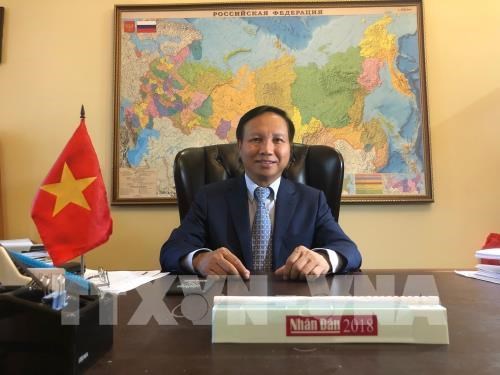 Vietnamese Ambassador to Russia Ngo Duc Manh Vietnam and Russia need to actively seek new, highly feasible cooperation methods, which are beneficial to both sides, in a bid to create breakthroughs in bilateral relations, said Vietnamese Ambassador to Russia Ngo Duc Manh. During a recent interview granted to the press ahead of the 30th Diplomatic Conference slated for August 12-17 in Hanoi, the ambassador highlighted the fruitful development in the Vietnam-Russia relationship over the last 68 years. Vietnam and Russia established diplomatic relations in 1950 and decided to elevate the relationship to strategic partnership in 2001 and then to comprehensive strategic partnership 11 years later. The bilateral cooperation between the two countries has been tested over time, becoming a valuable asset of the Vietnamese and Russia people, with many great achievements in all areas, Manh said. Vietnam-Russia political ties with a high level of trust have been enhanced through the regular exchange of delegations and bilateral meetings at all levels, and via the mechanism of consultation and strategic dialogue. The two nations have always cooperated and supported each other in multilateral forums such as the United Nations, the Asia-Pacific Economic Cooperation (APEC) forum, the Asia-Europe Meeting (ASEM), the ASEAN - Russia cooperation mechanism. Vietnamese President Tran Dai Quang’s official visit to Russia in June 2017, and Russian President Vladimir Putin’s attendance at the APEC Economic Leaders Meeting in Vietnam’s central Da Nang city in November 2017 created new impetus to effectively promote and deepen the comprehensive strategic partnership, Manh stressed. Vietnam-Russia economic, trade and investment ties have enjoyed dynamic development, he said, noting that after the free trade agreement between Vietnam and the Eurasian Economic Union officially came into effect in October 2016, the trade value between the two countries has grown by over 30 percent a year. In terms of investment, besides the cooperation in the field of oil and gas, as of June 2018, Russia has 117 direct investment projects in Vietnam with total registered capital of nearly 1 billion USD. Meanwhile, Vietnam is operating 22 investment projects worth nearly 3 billion USD in Russia. Security and defence cooperation between the two nations has also witnessed practical and effective development, especially in personnel training and weapon-equipment transfer. Vietnamese and Russian localities have also strengthened their collaboration in the recent time, focusing on the spheres of economy, trade and investment, culture, and education. Tourism and culture cooperation, and people-to-people exchanges have been also fostered, Manh said. Regarding measures to fully tap the potential to further expand bilateral economic ties, the diplomat stressed that relevant agencies and enterprises of the two countries, including the embassy, have to make every effort to fulfill commitments made by their senior leaders, towards realising the 10-billion-USD target in two-way trade by 2020. It is necessary to implement synchronously and effectively cooperation agreements signed between the two countries, and enhance the role of the intergovernmental committee; as well as the consultation and supervision of the two legislative bodies over the implementation, the ambassador said. Administrative reform should be also promoted, thus facilitating Vietnamese and Russian enterprises’ travel and work in their respective territories, thus fostering economic ties between the two nations. Manh, however, also mentioned obstacles hindering the Vietnam-Russia economic and trade cooperation, saying that there are no effective mechanisms to promote the potential and strength of each country. Vietnamese businesses are facing difficulties in selling their goods in the Russian market because of certain barriers related to quarantine, Manh noted, adding that both countries’ firms do not have enough information about each other so they do not have adequate trust in trading. Trade promotion activities should be increased to solve these issues, he said. The ambassador also highlighted the significance of the Vietnam Year in Russia and the Russia Year in Vietnam in 2019, saying that it will be a meaningful event to strengthen cooperative ties between the two countries. Vietnam-France defence ties enhanced: Deputy Defence Minister 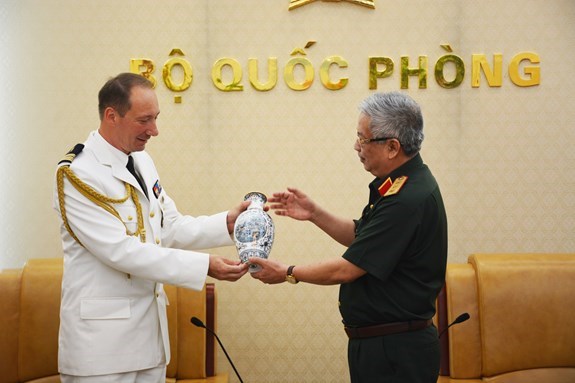 Deputy Defence Minister Sen. Lt. Gen. Nguyen Chi Vinh (R) presents a gift to outgoing French Defence Attaché in Vietnam Maj. Christophe Talon (Source: qdnd.vn) Deputy Defence Minister Sen. Lt. Gen. Nguyen Chi Vinh on August 7 received the outgoing French Defence Attaché in Vietnam Maj. Christophe Talon and his successor Lt. Maj. Marc Razafindranaly. At the reception, Vinh expressed his satisfaction at the Vietnam-France defence ties over the past three years, as both sides have maintained close cooperation in peacekeeping missions, military medicine and training. He acknowledged and appreciated the contributions made by Maj. Christophe Talon to the ties, and hoped that in his new position, the officer will continue contributing to the relations between the two countries in general and the two armies in particular. Welcoming Lt. Maj. Marc Razafindranaly, Vinh asked him to maintain and promote the results that his predecessor had made during his tenure, and have new initiatives to further boost the bilateral defence ties in a more practical and effective manner. The Vietnamese deputy defence minister affirmed the Defence Ministry will create all favourable conditions for Marc Razafindranaly to fulfil his tasks. HCM City celebrates 45 years of Vietnam-Malaysia relations 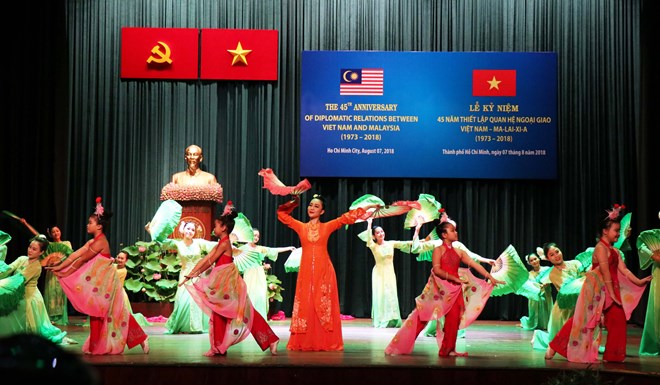 A performance at the ceremony marking 45 years of Vietnam-Malaysia diplomatic ties in HCM City on August 7 Ho Chi Minh City wants to further boost cooperation in multiple spheres with Malaysia, especially in the prioritised fields of trade, investment, technology, education, culture and tourism, said a local official. Speaking at a ceremony marking 45 years of Vietnam-Malaysia diplomatic relations on August 7, Vice Chairman of the municipal People’s Committee Le Thanh Liem noted that Vietnam and Malaysia share many cultural similarities and their people began to exchange and learn from each other a long time ago. The relationship has been further reinforced since the two countries set up diplomatic ties on March 30, 1973 and, especially, after they lifted the relations to the level of strategic partnership in 2015, Liem said. With 562 projects worth over 12 billion USD, Malaysia currently ranks seventh among countries and territories directly investing in Vietnam, he adding that bilateral trade reached 6.67 billion USD in the first half of 2018, up 19.2 percent year on year, and is expected to hit 15 billion USD by 2020. Liem went on to say that Malaysia has invested 4.6 billion USD in nearly 250 projects in HCM City, ranking third among 98 foreign investors here. Aside from political and economic partnerships, bilateral collaboration in security-defence, culture, education and labour have also resulted in positive outcomes, thereby contributing to the bilateral comprehensive cooperation as well as peace, stability, cooperation and development in the region, the official added. For his part, Malaysian Consul General in HCM City Sofian Akmal Abd. Karim affirmed that the sound relationship between Malaysia and Vietnam is the outcome of unceasing efforts by leaders and people of both nations, especially since the establishment of the strategic partnership in 2015. According to the diplomat, over the four decades, bilateral trade and investment ties have grown considerably, driven by the favourable economic environment. Meanwhile, encouraging outcomes have also been seen in people-to-people diplomacy when about 248,000 Vietnamese visited Malaysia and 480,000 Malaysians came to Vietnam in 2017. Educational cooperation programmes and youth exchanges have also taken place regularly, helping to foster mutual understanding, solidarity and friendship. He said although HCM City has attracted one-third of Malaysian investments in Vietnam, the two sides’ cooperation potential remains huge, particularly in education and tourism. The official asked HCM City’s leaders to continue to support activities that are aimed at promoting bilateral ties so as to help intensify strategic partnership between Malaysia and Vietnam. The ceremony featured singing and dancing performances by Vietnamese artists. The Malaysian Consulate General and partners also introduced a Batik flower-themed fashion collection symbolising the friendship between the two nations.–VNA HCM City leader pledges optimal conditions for Japanese investors Ho Chi Minh City will create optimal conditions for Japanese firms to do long-term business in the city, said Vice Chairman of the municipal People’s Committee Le Thanh Liem. Receiving a delegation of the Japan Chamber of Commerce and Industry (JCCI)’s Youth Commission led by its head Uchida Shigenobu on August 7, Liem lauded the visit, which, he believed, will strengthen the all-round cooperation between Ho Chi Minh City and Japan, especially in trade and investment. Over the past years, the traditional relationship between Ho Chi Minh City and localities of Japan has been fostered through collaboration programmes in culture, economy, education and tourism, he said, adding that Japan is now the fifth largest foreign investor in the city. Liem said that HCM City has many export processing zones, industrial parks and high-tech parks which are always ready to welcome Japanese investors. For his part, Shigenobu said that the delegation, comprising of more than 100 delegates from more than 100 businesses, representing 34,000 JCCI member companies, aims to study the investment environment and seek partnership and investment opportunities in the city. While appreciating the municipal authorities’ support and assistance to Japanese investors, Shigenobu stressed that Japanese firms are confident in the city’s economic development potential. He expressed his hope to continue receiving support from HCM City to Japanese enterprises that are seeking investment and business opportunities in the city. The JCCI’s Youth Commission will work hard to contribute to fostering economic, trade and investment between Japan and Ho Chi Minh City, thus strengthening the sound friendship and partnership between Japan and Vietnam, he promised.-VNA Diplomats seek to improve consular affairs, citizen protection 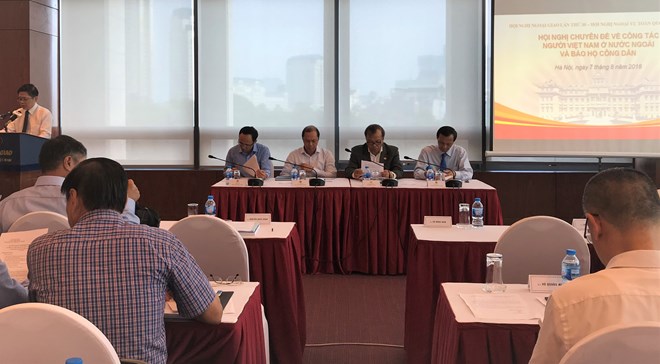 The conference in Hanoi on August 7 discussed measures to enhance the effectiveness of activities related to overseas Vietnamese and citizen protection (Phôt: dangcongsan.vn) More than 150 heads of Vietnamese representative agencies abroad and leaders of the Ministry of Foreign Affairs (MOFA) gathered at a conference in Hanoi on August 7 to discuss measures to enhance the effectiveness of activities related to overseas Vietnamese (OV) and citizen protection. At the event, jointly held by the MOFA’s Department of Consular Affairs and the State Committee for Overseas Vietnamese Affairs, the participants focused on outcomes and shortcomings in the work and orientations for the 2018-2020 period. Heads of the Vietnamese representative agencies abroad shared their real experiences and pointed out challenges and difficulties as well as factors affecting the effectiveness of OV-related affairs and citizen protection, thus seeking solutions to improve the efficiency of the work. In the past two years, the amount of remittances sent home by OVs exceeded 25 billion USD. In 2017, the flow of investment poured into the domestic market by OVs hit about 4 billion USD. Alongside, many OV intellectuals and enterprises have made remarkable contributions to the development of various sectors at home, while OV youngsters have showed their interest in developing the motherland. Meanwhile, despite unprecedented and difficult cases of citizen protection happening currently, authorized agencies have shown timely response and ensured interests of Vietnamese individuals and organisations abroad. Specifically, in the recent two years after the 29th Diplomatic Conference, authorized agencies carried out citizen protection for more than 16,000 Vietnamese citizens and over 600 vessels with 5,000 fishermen seized by foreign forces or faced difficulties abroad. Addressing the event, Deputy Foreign Ministers Vu Hong Nam and Nguyen Quoc Dung asked for drastic measures to attract more resources from OVs to serve national development as well as to provide timely and accurate response in consular affairs and citizen protection, especially in the context that the world situation has seen rapid and unexpected developments. Nam stressed that in the coming time, it is necessary to increase the role of overseas Vietnamese representative agencies in acquiring aspirations of Vietnamese communities abroad, thus rolling out measures to support the communities in reinforcing their legal status, settlement and social integration, while maintaining the Vietnamese language and national cultural identity. He stressed the need to lure more OV resources for national growth, with focus on youngsters. It is also crucial to update the communities with accurate information about policies of the Party and State, Nam stressed. Meanwhile, Dung proposed relevant agencies actively carry out consular affairs in line with law to reduce complaints and denunciations, while speeding up the formation of a sustainable inter-sectoral mechanism on citizen protection and seeking more speedy methods to share information between MOFA units and other agencies. He underscored the necessity to strengthen international cooperation in the field, as well as bilateral and multilateral dialogues, creating a legal foundation for the protection of rights and interests of Vietnamese legal entities and citizens in other countries. Dung also pointed to the need to mobilise social resources and efforts of international organisations in citizen protection, while applying more effective communication measures to guide Vietnamese citizens travelling abroad and provide them with updated information through various channels such as websites and hotlines of Vietnamese representative agencies.-VNA Sympathies to Indonesia over losses caused by earthquake President Tran Dai Quang and Prime Minister Nguyen Xuan Phuc on August 7 expressed their sympathies to Indonesian President Joko Widodo over the great losses in human and property caused by the earthquakes on July 29 and August 5 in northeastern Lombok Utara in Nusa Tenggara Barat province. The same day, Chairwoman of the National Assembly Nguyen Thi Kim Ngan sent her sympathies to Speaker of the Indonesian People’s Representative Council Bambang Soesatyo. Deputy Prime Minister and Foreign Minister Pham Binh Minh also offered his sympathies to Indonesia’s Foreign Minister Retno Marsudi. A 7-magnitude earthquake struck the tourist island of Lombok on August 5, killing at least 105 people, seriously injuring nearly 240 others and rendering over 20,000 locals homeless. Up to 230 aftershocks were recorded following the quake. More aftershocks are forecast to occur in the next few weeks. PM: Public security force must effectively implement plans 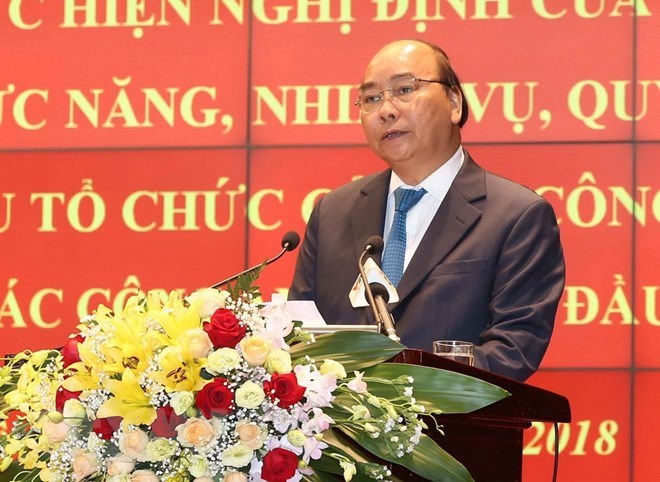 Prime Minister Nguyen Xuan Phuc speaks at the conference. Prime Minister Nguyen Xuan Phuc on August 7 asked the public security force to effectively implement plans in order to protect the absolute safety of the country’s major events as well as activities of Party and State leaders, and build a society of order and safety. Speaking at a conference held by the Ministry of Public Security in Hanoi, the Government leader also urged the force to focus on fighting crimes and promoting the law-abiding spirit during the work. He tasked the sector with developing personnel and preventing the degradation in political ideology, morality and lifestyle, and the phenomena of “self-evolution” and “self-transformation” to build a pure and strong public security force. Over the past time, the ministry has fulfilled its role as an advisor to the Party and the State in developing strategic guidelines and policies regarding national security, foreign affairs, and national sovereignty and interests, he noted. “The public security force has upheld the strength of the entire political system and society in detecting and preventing sabotage plots and destructive activities of hostile forces, and fighting crimes,” the leader said. He lauded the sector’s efforts in Party building and personnel development, saying many officials who had violated laws were punished. Meanwhile, many others fell down for national security, he said, noting that five officers and soldiers died, 90 were injured and 30 were exposed to HIV while performing their duties. Their efforts have contributed to safeguarding national security and safety, and creating a peaceful and stable environment for socio-economic development, PM Phuc stressed. However, he said, there remain shortcomings in the sector like the complex development of crimes like gambling, murders and drug, environment and high-tech crimes, along with limited results of the firefighting work and violations of laws committed by a number of officers and soldiers.-VNA Vice President visits Soc Trang province  At the working session (Source: http://baosoctrang.org.vn) Vice President Dang Thi Ngoc Thinh on August 7 asked the Mekong Delta province of Soc Trang to pay attention to promoting Party and administration building and administrative reform, and ensuring security and order. During a working session with provincial officials, the Vice President also urged the local authorities to do well the work related religions, the promotion of great national unity, and social welfare in the coming time. Chairman of the provincial People’s Committee Tran Van Chuyen briefed Thinh on Soc Trang’s socio-economic development achievements in the first six months of 2018. The locality’s economic growth hit 6.11 percent in the period, with the industrial production value reaching 12.3 trillion VND (nearly 527.7 million USSD), up 7 percent year-on-year. Export turnover was 390 million USD, 23 percent higher than that of the same period last year. The province’s State budget collection stood at over 2 trillion VND and about over 19,000 jobs were generated for local labourers. Soc Trang has attracted nearly 50 domestic and foreign investors with total registered capital hitting 123 trillion VND in the period, while over 60 other investors have registered to implement 72 projects in the locality. The province also successfully held an investment promotion and startup conference in 2018, he added. Chuyen asked for support from the State to the locality in adapting to climate change, building transport infrastructure and seaports, and in education-training development. Speaking highly of the local authorities’ efforts and achievements, Vice President Thinh said she will recommend the Government, ministries and sectord to prioritize investment capital for Soc Trang in the above-mentioned fields. During her visit, Thinh and a number of donors presented three houses, 200 sholarships and gifts totaling over 400 million VND to disadvantaged households and students in the locality. Vietnamese in Mexico raises funds for Lao victims in dam collapse 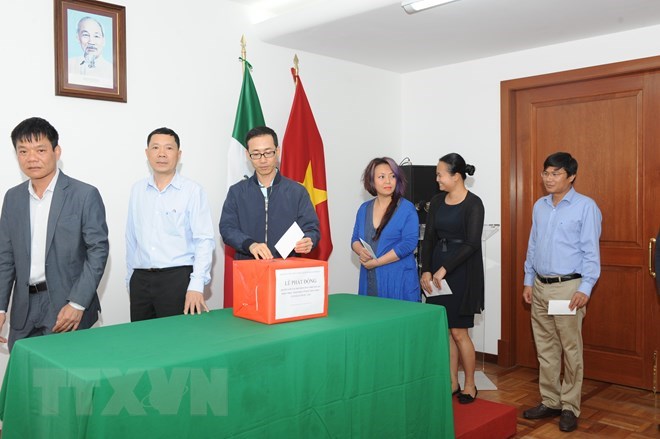 Staff from the Vietnamese Embassy in Mexico and Vietnamese representative agencies donate money to support Lao people affected by the dam collapse The Vietnamese Embassy in Mexico held a fund-raising ceremony on August 7 to collect money for Lao people affected by the collapse of the Sepien-Senamnoi hydropower dam in the southern province of Attapeu. Speaking at the event, Charge d'affaires of the embassy Doan Anh Tuan highlighted the traditional friendship, special solidarity and comprehensive cooperation between Vietnam and Laos. He called on the staff of the embassy and Vietnamese representative agencies to donate money to support the affected people. At the ceremony, over 8.3 million VND (365 USD) was raised for the targeted people. The money will be transferred to them via relevant agencies. Earlier, the Vietnamese government granted 200,000 USD as relief aid to local residents hit by the incident. Vietnam’s ministries, sectors and localities also launched activities to assist the victims. The Sepien-Senamnoi hydropower dam collapsed on July 23, causing massive floods which submerged 10 villages downstream and completely isolated Sanamxay district. The incident affected over 1,300 households with 6,600 people. So far, the rescue forces have found the bodies of 31 victims. At an international press conference held in Vientiane on August 7, Lao Foreign Minister Saleumxay Kommasith said 100 people remain unaccounted for and it would take many years for Laos to address the serious consequences. Therefore, the Lao government still needs assistance and sharing from other countries and non-governmental organisations, especially in searching and rescuing the missing, restoring and building infrastructure in affected villages, providing food and necessities for the victims, and preparing health equipment, medicines and ambulances, he said. In the short term, the government will focus on arranging temporary accommodations for more than 6,000 people who were seriously affected by the incident, then resettlement. Minister of Energy and Mines Khammany Inthirath said the government is setting up an investigation committee to coordinate with international organisations to look into the dam collapse. The committee will examine the quality of nearly 50 hydropower dams which have been completed as well as the design of those under construction, he said, adding that Laos will also establish a water management board to keep track of the volume of water in lakes. The Lao Government had also decided to halt the signing of new Memorandum of Understanding (MoU) and Project Development Assistance (PDA) contracts on hydropower nationwide to conduct further assessment and revision, he added.-VNA PM lauds AO/Dioxin victim association’s efforts 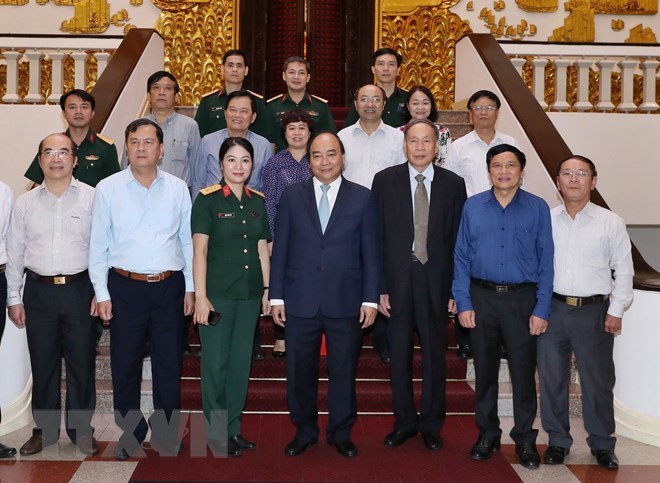 Prime Minister Nguyen Xuan Phuc and representatives of the Vietnam Association of Victims of Agent Orange/Dioxin. Prime Minister Nguyen Xuan Phuc on August 7 spoke highly of the Vietnam Association of Victims of Agent Orange/Dioxin (VAVA)’s efforts in recent years to protect the rights of the victims and raise fund for them. During a meeting with a VAVA delegation led by its president, Sen. Lt. Gen. Nguyen Van Rinh, in Hanoi on the occasion of the 57th anniversary of the Day for AO/Dioxin Victims (August 10, 1961), the Government leader also noted that the association has made active efforts in demanding justice for those affected by AO/Dioxin. The efforts have drawn public attention both at home and overseas calling on the US Government to recognize their responsibility and take concrete acts, he stressed, adding that VAVA has also advised Party and governmental leaders on formulating special policies for victims and raising public awareness of the effects of the toxic chemical on human health. The PM said he wants local Party committees and authorities to work alongside with businesses to provide aid for the victims and help them integrate into the society in the time ahead. He also voiced hope that VAVA will continue keeping their good work to overcome difficulties and fulfill their tasks. Rinh, for his part, thanked the Party, State and Government for the support given to the AO/Dioxin victims over the past years. It was estimated that about 4.8 million Vietnamese people were exposed to AO/Dioxin and there have been fourth-generation victims, many of who have to struggle every day to make ends meet. Some 350,000 victims and their children are receiving financial support monthly. As of March 2018, the association had raised more than 1.7 trillion VND (73.1 million USD) to build 25 support centres and houses for them and award their children with scholarships. PM lauds efforts to tackle post-war bomb, mine consequences 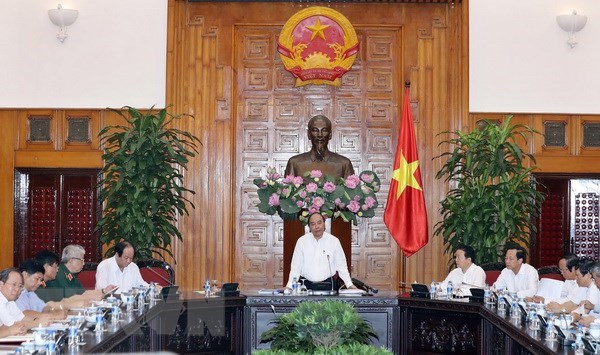 Prime Minister Nguyen Xuan Phuc (standing) speaks at the meeting Prime Minister Nguyen Xuan Phuc lauded bomb and mine consequence recovery efforts over the past years while chairing a meeting of the National Steering Committee on the Settlement of Post-War Unexploded Ordnance and Toxic Chemical Consequences (Steering Committee 701) in Hanoi on August 7. It was the first meeting since the committee made debut in April 2018. In his speech, the PM said ministries, agencies, localities and socio-political organisations have devised their own action plans to deal with bombs, mines and toxic chemicals, facilitated international cooperation, scientific research and technological development in the field, as well as provided support for victims. Describing bomb and mine recovery as an urgent task, the leader said the committee needs to fix existing shortcomings to protect the environment and people’s health in service of socio-economic development, towards mitigating public exposure to dioxin. According to him, a roadmap is needed to devise a map of dioxin, bomb and mine contaminated hotspots in Vietnam, adding that the committee should consider amending policies on State allowances for those who joined resistance wars and became exposed to dioxin and chemical toxics and their children, and offer better medical care to them. Ministries, agencies and localities were urged to rally domestic and foreign resources in the effort. The PM said the implementation of a Vietnam – Hungary project on overcoming the aftermath of bombs and mines in Ha Giang, Lao Cai, Cao Bang, Quang Nam and Quang Tri provinces, which uses State budget and Hungary’s official development assistance, is necessary. He assigned the committee to collect feedback at the event to refine the report, especially those regarding social and health care issues for Agent Orange/dioxin victims, international and technical cooperation, environment and projects jointly conducted by ministries and agencies. Last year, the standing board of the committee worked with ministries and agencies to build its operating regulation, offered advice to Party and State leaders about adding the settlement of post-war bombs and mines into joint statements with the US, Japan, Australia and Israel. During the first stage of a project on outlining maps of areas contaminated with bombs, mines and explosives, up to 9,116 areas were found, accounting for 81.87 percent of the total. All communes and towns in 19 provinces were affected, including Hai Duong, Quang Binh and Quang Tri. Over 6.1 million ha of land are contaminated with bombs and mines while about 30,000 – 50,000ha are subject to bomb and mine clearance. The Defence Ministry also partnered with the US Agency for International Development (USAID) to deal with dioxin at Da Nang international airport. The project has been basically completed with 160,000 sq.m of treated land meeting technical standards on environment. The Ministry of Labour, Invalids and Social Affairs piloted a model to improve livelihoods of victims hurt by bombs and mines in several localities. HCM City builds sustainable relations with ASEAN members Right after Vietnam became a member of the Association of Southeast Asian Nations (ASEAN) in 1995, Ho Chi Minh City has carried out a line-up of activities to bolster trade, investment, culture and people diplomacy cooperation with ASEAN member states, playing an important role in the Vietnam-ASEAN relations. The southern economic hub was a pioneer in trade promotion activities in ASEAN countries, holding annual trade fairs in Cambodia, Myanmar, and investment-tourism events in Thailand and Malaysia. The city has become important trade partners of Thailand, Malaysia and Singapore, with two-way trade with those nations enjoying stable growth through years. Last month, an expo was held in the city, bringing chances to ASEAN businesses and Ho Chi Minh City to seek trade and investment opportunities and introduce products in each other’s market. HCM City also attracted a large amount of investment capital from ASEAN countries. As of the end of 2017, ASEAN members registered nearly 16 billion USD in 1,500 projects in the city, with Singapore and Malaysia among the leading foreign investors. As the largest city in southern Vietnam and a cultural centre of the country, HCM City is also active in promoting social and cultural ties with ASEAN members, contributing to building the ASEAN Socio-Cultural Community. The city has established friendship ties with six localities in ASEAN countries, which are Manila (the Philippines), Phnom Penh (Cambodia), Vientiane (Laos), Champasak (Laos), Yangon (Myanmar), and Bangkok (Thailand). Diplomatic and cultural activities have help popularise the city and the country’s images to international friends, thus, tightening the friendship and creating opportunities to attract investment in various sectors. Such notable events as the festival “Ho Chi Minh City- Integration and Development” organised since 2013, and the annual International Travel Expo have helped enhance mutual understanding, solidarity and collaboration between the city and ASEAN localities. Furthermore, a vibrant Ho Chi Minh City has been illustrated through many other cultural events on occasions such as anniversaries of diplomatic ties between Vietnam and ASEAN member states. The city has also hosted many major events of ASEAN like 4th ASEAN Chief Justices’ Meeting, and ASEAN Law Association’s 38th Governing Council Meeting. In mid-April, the city hosted the 2018 Culture and Trade Exchange Programme among ASEAN member countries themed “for an ASEAN Economic Community’s development and prosperity”, showing the city’s commitment to building a competitive, innovative and active community. Together with the other two big cities of Hanoi and Da Nang, Ho Chi Minh City is a founding member of the ASEAN Smart Cities Network Initiative, reflecting the city’s determination to build a common ecosystem in ASEAN in which digital technology is deployed to improve livelihoods of urban residents. Regarding people-to-people diplomacy, the city has carried out an array of programmes to tighten friendly ties with ASEAN countries, according to Phan Thi Hong Xuan, Chairwoman of the Vietnam-Southeast Asia Friendship Association in Ho Chi Minh City. Most of the cooperative activities have focused on connecting young people in ASEAN through cultural conferences, youth contests, and friendship activities between universities. With such activities, the city has contributed to building dynamic, effectively and strong linkages among ASEAN nations that benefit all concerned parties as well as to a prosperous ASEAN Community in the future. 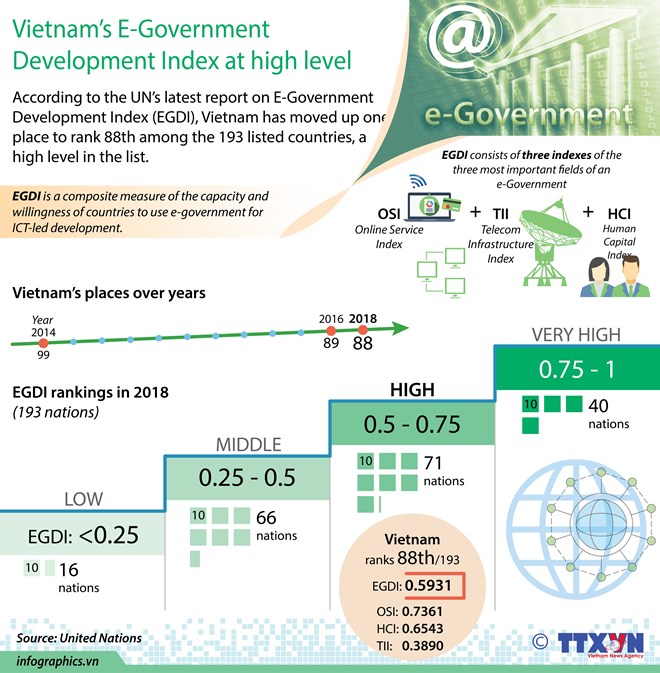 VNN |
↧
Article 1
↧
Article 0
Social News 8/8 CAAV asks Lao Cai to reconsider airport project In response to a proposal by the Lao Cai provincial government for building the VND5.8-trillion Sapa Airport, the Civil Aviation Authority of Vietnam (CAAV) has requested the locality to thoroughly study the necessity and efficiency of the project, reported the local media. According to CAAV deputy head Vo Huy Cuong, the local authorities should carefully weigh the impact of other means of transport, along with the province’s economic development orientation and tourism prior to preparing a plan for building the airport. Cuong stressed that building an airport is a legitimate aspiration for any locality; however, its feasibility must be mulled seriously, regardless of whether the project is backed by private or state funding. Cuong cited the examples of South Korea and Taiwan, noting that the two have fewer airports than Vietnam but their operations still lack efficiency. This is compensated by other transport systems there, such as expressways and high-speed railways, which boast robust growth. He added their airports are facing difficulties in operating international flights, so all their carriers are trying to introduce air routes to Vietnam. A traffic expert said that investors only inject money into potential air carriers. For provincial airports, the number of passengers and the profits usually remain modest, failing to attract enough investment. Earlier, the provincial People’s Committee had proposed building Sapa Airport in Cam Con Commune in Bao Yen District, with total investment capital of nearly VND5.8 trillion. The project comprises two phases. The first phase will cost VND4.75 trillion (including the site clearance costs), serving 560,000 passengers and transporting 600 tons of goods per year, with two aprons. The second phase is projected to raise the airport’s capacity to 1,585,000 passengers and 2,880 tons of commodities per year. Dong Thap: 6,000 households living in landslide-prone areas 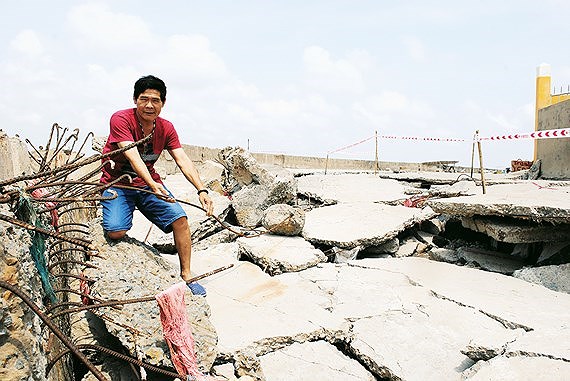 Chairman Nguyen Thanh Hung from the Mekong Delta province of Dong Thap said up to August, of 5,975 households in the province have been living in landslide-prone areas. Of these, 900 households are living in landslide-prone areas in urgent need to relocation and 5,075 others are living in dangerous zones Flooding season is coming the region, therefore Dong Thap province People’s Committee proposed the government to support to move local residents from dangerous zones to safer areas. Accordingly, the government should support the province in building 12 residential blocks in seven districts, cities to relocate about 2,440 households to stable places with total capital of up to VND 657billion. Health authority ensures continuous ARV treatment for HIV/AIDS-positive people 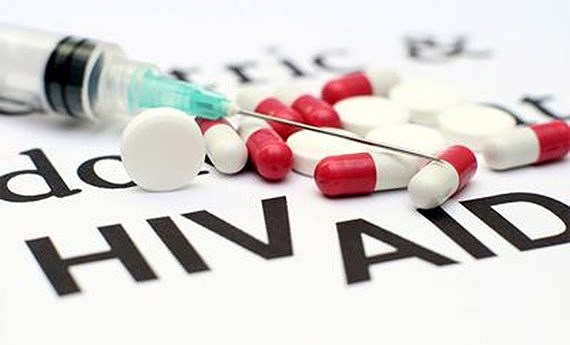 In the past year, the health authority in Ho Chi Minh City tried its best to ensure continuous ARV treatment for people living with HIV/AIDS. In the first six months of the year, HCMC has detected 2,430 fresh cases of HIV/AIDS, a year-on-year rise of 732. At present, 33,500 outpatients including people from neighboring provinces are being treated in 21 clinics. The Tropical Disease Hospital , Pham Ngoc Thach Hospital, Children Hospital No.1 and 2, and Nguyen Trai, medical center in Go Vap District and 17 infirmaries in districts are providing treatment on insured HIV/AIDS people who are covered by insurance agency except for ART drug. In the first six months, the city health sector has issued 2,934 insurance cards to people living with HIV/AIDS. In the next time, it will liaise with the southern provinces of Binh Duong, Ba Ria - Vung Tau, Dong Nai, Long An, Tay Ninh and Tien Giang on transfer special patients from hospitals to hospitals to ensure continuous treatment and enhance coverage of insurance on them. HCMC undertakes activities in response to World Cleanup Day 2018  In response to the World Cleanup Day 2018 as well as contribute to the program “ Reducing environment pollution for the period 2016-2020”, the Ho Chi Minh City Department of Natural Resources and Environment has launched a campaign to tackle environmental issues eliminating pollution hotspots. Deputy director of the Department Ms. Nguyen Thi Thanh My said that the campaign starts nationwide from September 15 to 21. In Ho Chi Minh City, activities will center around protecting residential quarters and public places. It will include increasing information of environment to raise city dwellers’ awareness changing their acts and eliminating pollution hotspots. Participants who spread the information of environment to residents in will take part in training courses organized by the Department. Alongside increasing information in public media and displaying models of environment protection, posters will be put up in visible public places to change people’s behaviors to environmental protection. Specifically, the Department will run environment protection models in Thanh An Commune in Can Gio District and Binh Chanh District. As per the plan, on Sundays, residents in the two districts will participate in “Green Sunday” campaign to tidy the environment preventing risks of diseases due to pollution. Moreover, it will eliminate two pollution hotspots in the two districts. Local administrations were asked to review pollution hotspots in the localities and plan to eliminate them. Each locality will choose at least three pollution hotspots. Additionally, districts will carry out cleanup activities at the same time including collecting wastes in roads and rivers, dredging canals and enhance control of pollution in factories. HCMC seeks funds for improving traffic infrastructure 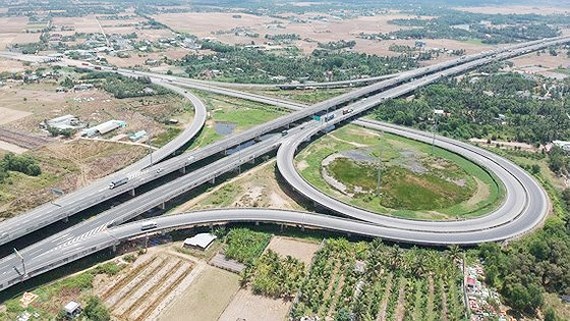 Ring roads No.3 links HCMC, Binh Duong Province and Long An Province One of the reasons of city's traffic infrastructure projects is lack of funds, therefore, the city is seeking funds for improving traffic infrastructure, said Director of the Ho Chi Minh City Department of Transport Bui Xuan Cuong said at the meeting presided by Chairman of People’s Committee and Transport Minister Nguyen Van The on August 3. The Ministry is seeking funds for expressways connecting HCMC and provinces in the major economic zones such as HCMC- Moc Bai of the southern province of Tay Ninh; HCMC - Chon Thanh in BInh Phuoc province as well as build traffic intersection Tan Tao – Cho Dem in Binh Chanh District. Moreover, the Ministry will improve Binh Trieu – Hoa Hung railway and build a small railway from Thu Thiem to Long Thanh Airport; ports along rivers Dong Nai, Sai Gon and Vam Co to remove ports in inner city helping to develop the southern economic zone. Director Cuong petitioned the Ministry to urge the Airports Corporation of Vietnam to build a special lane for buses in Tan Son Nhat premises and the Civil Aviation Authority of Vietnam to adjust the landing and takeoff time in peak season. Also, the Ministry should work with the Ministry of Public Security to work out the plan of inter-department inspection on overloading vehicles. The Ministry should consider to allow HCMC authority to control river traffic in the city in order to improve management, Director Cuong suggested Additionally, the Ring Belt No.3 should be built as per the city’s mechanism and the Ring Belt No.4 through Ben Luc – Hiep Phuoc should be completed soon. The Ministry was urged to approve the railway project between HCMC- Can Tho City in the Mekong delta. Implementation of the National Highway 1A, 1K, 13, 22, 50 is waiting for the Ministry’s support The city urged the Ministry to finish formalities to include An Phu Traffic Projects into the HCMC-Long Thanh – Dau Giay projects and submit to the Prime Minister. Chairman Phong said that there has been good cooperation between the Ministry and HCMC in improving traffic infrastructure for past year. Notwithstanding, limited budget for traffic infrastructure impeded the plan. He proposed the People’ Council to approve an amount from state budget and other sources for building roads through HCMC so as to speed up expansion of ring belts. The city authorities requested competent agencies to work with the Ministry to quickly expand Tan Son Nhat Aiport, said Mr. Phong. He stressed that HCMC- Can Tho railway project must be run soon to connect the city and the Mekong delta. Minister Nguyen Van The said that these projects will be completed soon. In the comming time, Tan Son Nhat Airport must be upgraded to meet demands and furthermore, ring roads must link each other to help reduce traffic. North-South express railway project and HCMC-Can Tho City railway project must be carried out to ensure the synchronous connection of roads between the city and other provinces, he said. Also, Long Thanh Airport work must be carried out with traffic infrastructure of roads, railway and other types of transport between HCMC and other provinces. Detailed plan is needed for construction of ring roads No. 3 and 4, said Minister The. He emphasized traffic plan must be considered carefully or there will be worse traffic snarls in the next time especially in the National Highway 22 and 50. Sci-tech programme for new-style rural areas construction reviewed 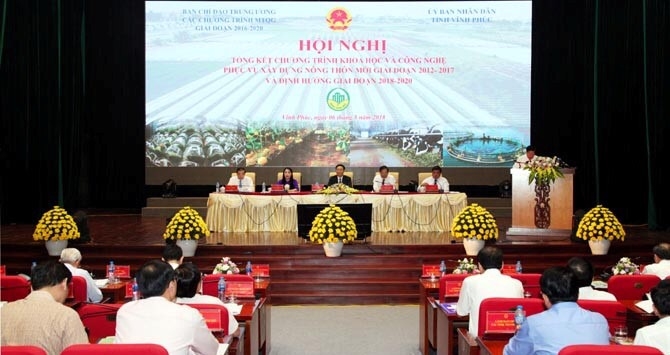 At the conference (Photo: kinhtedothi.vn) A national conference was held in the northern province of Vinh Phuc on August 6, to review the scientific and technological programme on the construction of new style rural areas for the 2011-2015 period and to deploy the tasks for the 2016-2020 period. The conference was chaired by Deputy Prime Minister and Head of the Steering Committee for National Target Programmes, Vuong Dinh Hue. In early 2012, the Prime Minister approved the scientific and technological programme on the construction of new-style rural areas, with a total budget of VND221 billionsourced from the State budget. The programme also mobilised VND165 billion from a number of enterprises, accounting for 43% of the total budget towards implementing the programme (VND386 billion VND). According to the Ministry of Agriculture and Rural Development (MARD), roughly 150 models in such areas as agricultural production, the application of renewable energy, irrigation, and mitigating the impacts of climate change, etc., were implemented and transferred in localities nationwide. In order to effectively implement the programme for the 2016-2020 period, the MARD proposed that legal documents for the implementaion of the programmeshould be completed. It is also necessary to strengthen the links and promote the role and participation of enterprises, cooperatives and farmers in the programme. Furthermore, there should also be a mechanism in place to integrate the resources of science and technology, and scientific and technological programmes, at all levels to serve the goal of building new-style rural areas. Honeymoon and Wedding Perfect expo returns in August  The Honeymoon and Wedding Perfect (HWP) exhibition will return to Hanoi and Ho Chi Minh City this August. (Photo: trienlamcuoihwp2018.vn) The Honeymoon and Wedding Perfect (HWP) exhibition will return to Hanoi and Ho Chi Minh City this August, celebrating its 10th anniversary under the theme “The Elite.” It will first take place at Gala Centre, 415 Hoang Van Thu street, HCM City from August 11-12 and Lotte Hotel Hanoi, 54 Lieu Giai street from August 24 – 26. Soon-to-weds visiting the fair will have an opportunity to get special gifts and exclusive offers from leading wedding and honeymoon service providers. Black, white and yellow are the theme colours of the 10th edition and this year’s trends of Vietnamese wedding season. It is scheduled to host various activities, such as a lucky draw, run for love, wedding workshop, bride makeover and more. Ha Nam: 3,800 houses of revolutionary contributors upgraded 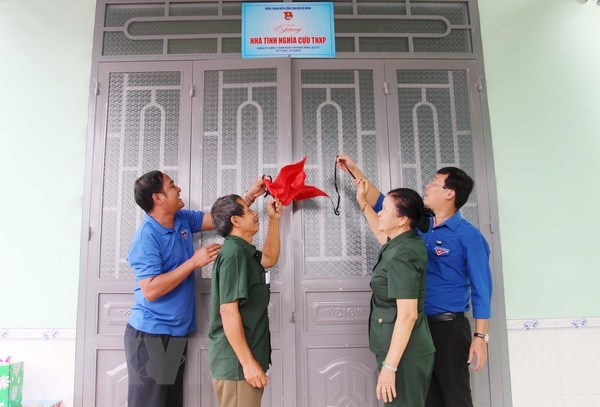 A ribbon-cutting ceremony held to hand over a house for revolutionary contributor Up to 3,794 houses have been built or upgraded for people who rendered services to the revolution in the northern province of Ha Nam. Of the number, nearly 1,980 new houses were built while the houses of 1,816 others were improved, with all of them meeting safety and hygiene standards. The houses were built with funding from social sources in addition to State budget. Under the provincial project to build houses for people who rendered service to the nation, 7,171 households in Ha Nam are eligible for the support. This means 3,377 families are waiting for assistance, with 1,160 need new houses and 2,217 others need repairs. The provincial Department of Labour, Invalids and Social Affairs has worked with relevant agencies to monitor the implementation of the project and address difficulties. Local authorities have also stepped up communication work to call for organisations, businesses and people’s engagement in the project. According to the Ministry of Labour, Invalids and Social Affairs, as of the end of 2017, a total of 9 million people were recognised as revolutionary contributors nationwide, including 1.2 million fallen soldiers, 127,000 heroic mothers and 800,000 wounded or sick soldiers. Vietnam has promulgated various policies to support those revolutionary contributors who are living in disadvantaged conditions, one of which is housing aid. New transport facilities to bring more tourists to Quang Ninh 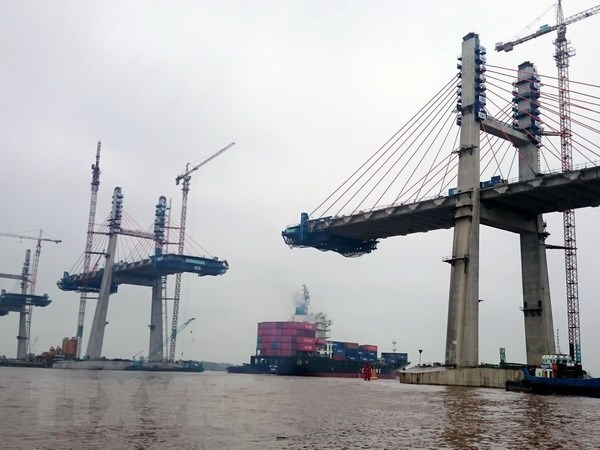 Bach Dang Bridge under construction Northern Quang Ninh province expects to welcome more tourists after new transport facilities are put into use later this year. Chairman of the provincial People’s Committee Nguyen Duc Long has decided that Bach Dang Bridge, linking Quang Ninh and Hai Phong city, will be inaugurated on September 2 this year to fully put into use the Ha Long – Hai Phong Expressway. The 5.4km-long bridge, spanning over the Bach Dang River, will help shorten the distance from Hai Phong to Quang Ninh’s Ha Long city from 75 km to 25 km, and from Hanoi to Ha Long from 180 km to 130 km. As a result, it will take travellers less time to reach Ha Long and Mong Cai cities and Van Don district – three popular destinations in the province. Additionally, Van Don International Airport has successfully handled test flights and will begin serving commercial flights in late 2018, a move expected to attract more foreign holidaymakers to the province. The airport is set to cater for nine air routes and be capable of serving some 7,000 passengers per day. It is hoped to have annual capacity of 2 – 2.5 million passengers by 2020 and 5 million by 2030. Despite poor weather in July, Quang Ninh recorded 916,000 tourist arrivals and more than 1.7 trillion VND (73 million USD) in tourism revenue. More than 8.4 million vacationers, including more than 2.8 million foreigners, visited the province in the first seven months of this year, respectively up 26 percent and 17 percent year on year. Total tourism revenue during the period surpassed 14 trillion VND (602 million USD), up 30 percent from a year earlier. The sharp rise in the figures was attributable to diverse activities as part of the National Tourism Year 2018 hosted by Quang Ninh. The province is also taking action to improve the tourism business environment and its image in visitors’ eyes. It aims to welcome 12 million visitors in 2018. Quang Ninh is home to a coastline of more than 250 kilometres and some 2,000 islets, two-thirds of the total in Vietnam. The spectacular stretch of coast connects the UNESCO-recognised World Heritage Site of Ha Long Bay with majestic natural scenery, Bai Tu Long Bay, Van Don and Co To islands and Tra Co beach with Cat Ba National Park in Hai Phong city. Bodhisattva in holy matrimony  A young woman depicting the role of Bodhisattva in a Buddhist procession in Thừa Thiên - Huế can be seen wearing a Western-style bridal gown, which many said to be a serious wardrobe oversight. — Photo danviet.com.vn Earlier last week, social media had a field day over a young woman who was wearing an unmistakably Western-style wedding dress while she was supposed to play the role of Bodhisattva of Compassion, a highly revered Buddhist deity figure in Việt Nam, in a Buddhist festival in the central province of Thừa Thiên – Huế. Granted, the Goddess of Mercy in modern representations is usually depicted in pure white attire while meditating on top of a lotus petal throne, but a bridal gown might be too loose an interpretation in a festival that is not known for its shock value. The Bodhisattva surely was not blameless, but the lion’s share of the blame must be put on the costume designers who thought it was an acceptable idea. Many expressed indignation at the disrespectful incident. Later, Hương Thuỷ Town authorities said that the festival to honour the Goddess was organised by the Huế Province branch of Việt Nam Buddhist Sangha on July 31 (18-19th day of the sixth Lunar month), but the procession of Bodhisattva was sorted by the local Buddhists. The organisers apologised for the oversight and pledged better preparations in the following years’ celebrations. Dong Nai Province chosen as leader of Cat Lai Bridge project 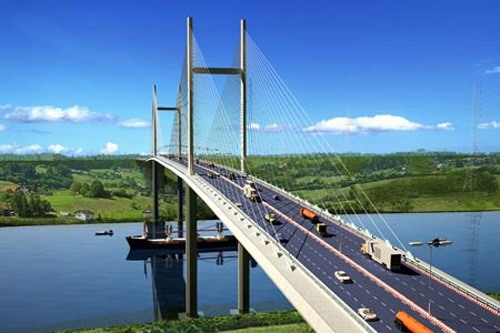 Đồng Nai Province will be responsible for Cát Lái Bridge project.— Photo vietnamnet.vn The authorities of HCM City and Đồng Nai Province agreed to select Đồng Nai Province as the leader in the Cát Lái Bridge project. The bridge will cross Đồng Nai River and link the city’s District 2 with Nhơn Trạch District in Đồng Nai Province. Approved by Prime Minister Nguyễn Xuân Phúc, the project has been delayed because of a lack of funds. The 4-km long and 55m high Cát Lái Bridge, with six lanes for motor vehicles and three mixed lanes, is expected to ease crowding on Cát Lái Ferry, which is a key link from HCM City to Đồng Nai and Bà Rịa- Vũng Tàu provinces. The Cát Lái Ferry carries an average 40,000 to 45,000 vehicles per day and up to 100,000 vehicles on peak days, according to the city’s Department of Transport. The bridge is expected to create favourable traffic conditions for socio-economic development in HCM City and Đồng Nai Province. Trần Văn Vĩnh, deputy chairman of Đồng Nai Province’s People’s Committee, said the province would complete the project as soon as possible Total investment is VNĐ7.2 trillion (US$308 million). Construction is expected to start by 2020. A dumpster fire 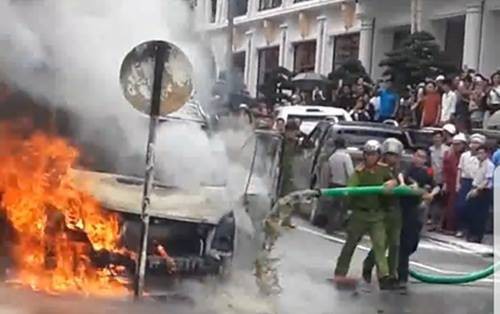 Firefighters putting out a car fire that broke out in Sa Pa town on August 4, using septic tank truck. — Photo soha.vn On August 4, a Ford van carrying a Hà Nội license plate caught fire in a crossroad of Sa Pa town, a popular tourist destination of the northern province Lào Cai. The fire raged for several minutes and threatened to consume other cars in the area. Onlookers were visibly bemused when suddenly, a septic tank truck joined in on the firefighting efforts, and instead of white foam and water, a particularly stinking and dense liquid was doused on the fire. The smelly method proved effective as the flaming car was reduced to a smoke-billowing metal skeleton quickly. Later, Lê Mạnh Hảo, vice chairman of Sa Pa District People’s Committee, told the media that the locality has no fleet of firefighting trucks and deploying the trucks from Lào Cai City would take 30-40 minutes at least. “This was quick thinking on the part of the firefighters, otherwise the fire could have spread to other cars and even houses. The water used was drawn from the lake, but it’s unavoidable that some excrement might still be in the pipe and the tank,” Hảo said. “We are asking the province’s authorities as well as the public security ministry about organising a proper firefighting team here in the township but the request has not been approved,” he added. Slapping lipsticks on…turtles?  A screen grab Facebook post of a ’mini turtle’ vendor, with many saying that they are actually the red-eared sliders, an exotic and highly invasive species. ‘Mini turtles’, or miniscule creatures that are barely double the size of a thumbnail with painted-on shells, are the latest fad amongst Vietnamese youngsters in search of cute pets. The drawings on the shells vary from simple flowers and ordinary sceneries to more sophisticated drawings of popular anime characters. Advertised as a low-maintenance pet that can live up to one month without drinking or eating with the additional benefit of eating mosquitoes and flies, inputting the keyword in Facebook search tool yields hundreds of results from makeshift vendors, who sell the turtles for VNĐ 40-60,000 (US$ 1.71-2.57). However, the selling and buying of these painted-on turtles is stirring controversy. Some suggest that the painting might be toxic for the reptiles, as several vendors have even gone so far as to paint the head of the turtle to make them more attractive. The vendors also often fail to provide information as regards to the species. Several social media users have also raised their suspicions that these might be the latest “reincarnation” of Trachemys scripta elegans, a North American native semi-aquatic turtle that appeared in Việt Nam a decade ago (commonly referred to as ‘red-eared turtles’). The red-eared turtles used to be a popular pet in Việt Nam and caused a headache for the agriculture sector, as experts have repeatedly warned over its aggressive and invasive nature. But it seems the species is making a comeback via duplicitous traders, armed with a coat of paint to mask the threats it poses for the ecosystem. Hà Đình Đức a ‘turtle professor’ who earned the nickname for his studies on the famous turtle in the Hoàn Kiếm Lake of Hà Nội, affirmed that the new mini turtles are indeed the red-eared turtles, which are still banned. Beer binges a health problem, WHO warns Vietnam The World Health Organization has called on Vietnam to tackle excessive drinking with strong measures. In a letter delivered to Prime Minister Nguyen Xuan Phuc recently, WHO experts said the high consumption of beer and alcohol in Vietnam was imposing a heavy burden on the country in the form of non-contagious diseases. It expressed WHO’s support for a draft law on preventing adverse impacts of alcohol consumption that will be reviewed by lawmakers this October. Shin Young-soo, WHO’s regional director for the Western Pacific region, said beer consumption among Vietnamese had reached an alarming rate. He said a Vietnamese adult above 15 years drinks 8.3 alcohol liters per year on average, much higher than in China (7.2 liters), Cambodia (6.7), the Philippines (6.6) and Singapore (two liters). A study jointly conducted by Vietnam's Ministry of Health and WHO in 2016 showed that 77% of Vietnamese men drink liquor and beer, and nearly half of them drink at hazardous levels. Nguyen Phuong Nam, a WHO official, said nearly 67% of the 1,840 traffic accident victims covered in the study had high concentrations of alcohol in their blood, and 45% had driven after drinking for two hours or more. The letter asked the Vietnamese government to tighten controls over the production, sales and advertising of beer and alcoholic beverage to discourage drinking and protect consumers’ health. The government should adopt tough measures to curb drinking by raising the prices of liquor and beer, restricting selling points, limiting the sale of alcoholic drinks at night and narrowing the legal drinking age, the letter said. It said beer promotions and advertisements had negative impacts on young people. Recently, Vietnam's Health Ministry proposed an advertisement ban on beer on TV and social networks as part of the draft law, as also restricting the sale of alcohol at night, specifically after 10 p.m. Vietnam is famous for its beer drinking culture. It is widely believed that business deals in Vietnam tend to go more smoothly over a few drinks at the negotiating table. Vietnam is the biggest beer market in Southeast Asia, consuming nearly four billion liters last year. The country spends on average US$3.4 billion on alcohol each year, or 3 percent of the government’s budget revenue, according to official data. The figure translates to US$300 per capita, while spending on health averages US$113 per person, according to the Health Ministry. As many as 40% of traffic accidents in Vietnam are linked to excessive drinking, according to the WHO, which it says is an alarming rate for a country where road crashes kill a person every hour, on average. Vietjet Air offers 200,000 promotion tickets on flights to Japan, RoK, Taiwan Low-cost airline Vietjet Air will offer 200,000 flight tickets at low prices from zero VND on routes from Vietnam to Japan, the Republic of Korea and Taiwan from August 8-10. The offer is applied for flights to Osaka in Japan; Seoul, Busan, Daegu of the Republic of Korea; Hong Kong and Kao Hsiung, Taipei, Taichung and Tainan in Taiwan (China) between September 1, 2018 to March 31, 2019. The promotion is part of activities to celebrate the airline’s new routes of Hanoi-Osaka, which will be launched on November 8, 2018 and Ho Chi Minh City-Osaka from December 14, 2018. The Hanoi-Osaka route will take more than four hours, with daily return flights. The flights will take off from Hanoi at 1:40 and land in Osaka at 7:50 (local time). In the return leg, the flights will leave Osaka at 9:20 (local time) and reach Hanoi at 13:05. Meanwhile, the five-hour Ho Chi Minh City-Osaka flights will operate every day, taking off from Ho Chi Minh City at 1:40 and landing in Osaka at 8:30 (local time). The return flights will depart from Osaka at 9:30 (local time) and arrive in Ho Chi Minh City at 13:30. Promotion tickets are available between 12:00 and 14:00 at Vietjet Air websites and Facebook. Chinese rabies vaccine circulated in Vietnam safe  The Drug Administration of Vietnam under the Ministry of Health yesterday announced Chinese rabies vaccine circulated in the country is not involved with vaccine scandal in China. Chinese-made registered and circulated vaccine Speeda is made by Liaoning Cheng Da Biotecnology not sub-standard vaccine produced by Chinese vaccine maker Changsheng Bio-technology. Vaccine Speeda is being produced and provided to several countries including Vietnam. Therefore, to calm down people’s worry, the Administration requested the departments of health in cities and provinces and infirmaries spread information of the vaccine. The Ministry of Health will continue using vaccine Speeda to meet demand and avoid a halt. At the same time, medical facilities including the National Institute of Hygiene and Epidemiology, Pasteur Institutes in Ho Chi Minh City and Nha Trang Town of the central province of Khanh Hoa which inject the vaccine have to place a poster about the vaccine at the institutes. According to the Administration, media in the world recently reported the shocking vaccine scandal in China. National Chinese chess champs starts 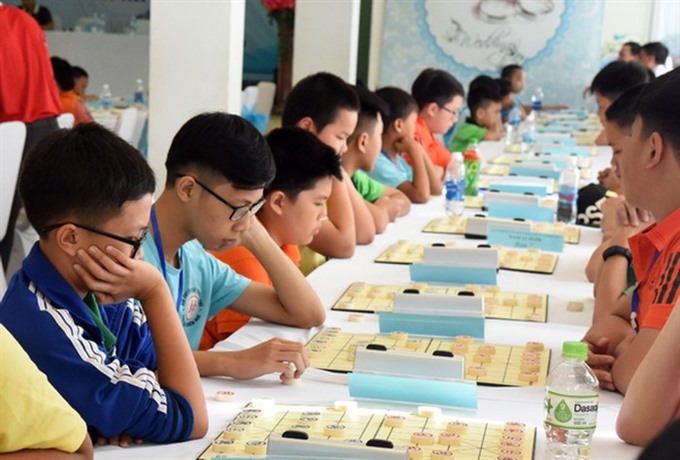 Players perform at the National Chinese Chess Championship in Thừa Thiên Huế. The National Chinese Chess Championship began in Thừa Thiên Huế on August 6. The event will see the participation of nearly 270 players from 11 teams across the country, including Hà Nội, Quảng Ninh, HCM City and Thanh Hóa. Participants are competing in the men’s and women’s standard, rapid and blitz categories in various age groups. Last year, HCM City triumphed at the event with 27 golds, 25 silvers and 22 bronzes, followed by Hà Nội and Bắc Kạn. The event, which was co-organised by the Department of Culture, Sports and Tourism of Thừa Thiên Huế and Việt Nam Chinese Chess Federation, will run until August 15. Justin Young and Jaywuan Hill collected points to Thang Long Warriors at VBA 2018  Quinton Doggett (4) competes with Jaywuan Hill (20). — Photo courtesy of organisers Defending champions Thang Long Warriors took a step towards retaining their title by beating Hochiminh City Wings in the Việt Nam Basketball Association (VBA) League on Sunday. The match was held at Hà Nội National University of Education Gymnasium. The Warriors came out of the blocks fast, taking a 20-16 first quarter lead, led by Justin Young and Jaywuan Hill’s jump shots. Despite the southern team’s efforts to shorten the gap, the dangerous pair helped the capital team end the half leading 39-33. In the third period, Thang Long’s class showed and they took a commanding 64-42 advantage, before closing the game out with a dominant 92-69 final score. Hill and young contriburted 21 points, 14 rebounds and 23 points, 19 rebounds, respectively, while Đặng Thái Hưng notched 21 points, 10 rebounds for the Warriors. The away side were led by Quinton Doggett with 21 points and 18 rebounds and Henry Nguyễn and Corey Cilia each with 14 points. Thang Long Warriors will next meet Cantho Catfish on August 2 and Hochiminh City Wings will face Saigon Heat the same day. VNN |
↧
↧
Article 2
Government News 9/8 Vietnam, RoK legislatures boost cooperation 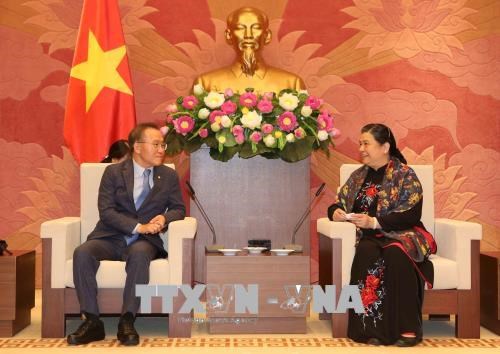 NA Vice Chairwoman Tong Thi Phong (R) and deputy head of the Executive Committee of the RoK NA Yun Jae-ok The National Assembly (NA) of Vietnam supports and attaches importance to strengthening the friendship and cooperation with the NA of the Republic of Korea (RoK), said NA Vice Chairwoman Tong Thi Phong. Receiving a delegation from the Executive Committee of the RoK NA led by its deputy head Yun Jae-ok in Hanoi on August 8, Phong stressed that the Vietnam-RoK strategic cooperative partnership has seen strong and comprehensive development with practical achievements in the recent past. She suggested the two legislatures work closely in implementing cooperation agreements, as well as sharing experience in law-making and supervision of the NAs and their subordinate agencies. Legislators of Vietnam and the RoK should urge the two governments to carry out already signed cooperation deals, and coordinate and mutually support in regional and international inter-parliament forums, thus contributing to peace, security and stability in the region and the world, she said. Phong went on to say that the two legislative agencies should maintain regular high-level meetings, and facilitate the exchange and cooperation between the two nations’ sectors and localities, towards enhancing mutual understanding and political trust, and expanding multi-faceted cooperation. The two sides also need work to step up cooperation in the fields of culture, education and tourism and people-to-people exchanges, she added. For his part, Yun underlined the importance of parliamentary cooperation in promoting bilateral relations between the RoK and Vietnam. Right after the reception, Chairman of the NA's Committee for External Affairs Nguyen Van Giau had a working session with the RoK delegation. Giau said along with the development of the Vietnam-RoK strategic cooperative partnership, the friendship and collaboration between the two legislatures have been incessantly strengthened and developed both bilaterally and multilaterally. He asked the two sides to continue coordinating in supervising the implementation of cooperation agreements signed between the two countries; listen to opinions of their business communities; monitor the building of policies and laws; and create conditions for citizens of the two countries to have a stable legal environment to live and do business stably in each country. Meanwhile, Yun said the delegation’s visit will contribute to deepening the relationship between the two legislatures. He expressed his hope that the two sides will maintain the exchange of delegations at all levels and facilitating the operation of the Vietnamese and RoK friendship parliamentarian groups. Vietnamese, Chinese provinces cooperate in humanitarian activities 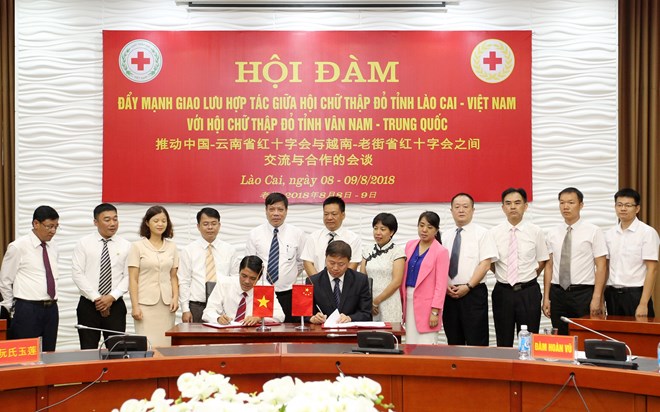 The Red Cross Societies of Vietnam’s Lao Cai province and China’s Yunnan province signed a memorandum of understanding (MoU) on cooperation The Red Cross Societies of Vietnam’s Lao Cai province and China’s Yunnan province signed a memorandum of understanding (MoU) on cooperation in implementing friendship and humanitarian programmes, marking a new development step in the two sides’ relations. Tian Huabing, Vice President of Yunnan’s Red Cross Society, said that the MoU aims to strengthen the two associations’ common perceptions on humanitarian cooperation issues. They will take measures to support each other in case of natural disasters or emergencies, while organising exchange activities in turn, and considering the establishment of an emergency rescue team. Both sides will share experience in carrying out humanitarian rescue, and training personnel, Tian added. Do Thanh Cong, President of the Red Cross Society of Lao Cai province, said that the two associations and their chapters will well implement the MoU, maintain people-to-people exchange, and support each other in humanitarian and charitable activities, and health care, as well as at local and national forums. Over the past years, Lao Cai has intensified cooperation with other localities, regions, foreign representative offices in Vietnam, international organisations and financial institutions to rally their help for development. The province has stepped up its comprehensive cooperation with Yunnan to serve socio-economic development, ensure defence-security, and increase its position. Vietnamese leaders congratulate Singapore on National Day President Tran Dai Quang has sent a message of congratulations to President of Singapore Halimah Yacob on the occasion of the 53rd anniversary of the National Day of Singapore (August 9). On the occasion, Prime Minister Nguyen Xuan Phuc cabled a congratulatory message to his Singaporean counterpart Lee Hsien Loong. Deputy Prime Minister and Foreign Minister Pham Binh Minh also extended congratulations to Singaporean Foreign Minister Vivian Balakrishnan. President lauds war veterans for contributions to socio-economic development 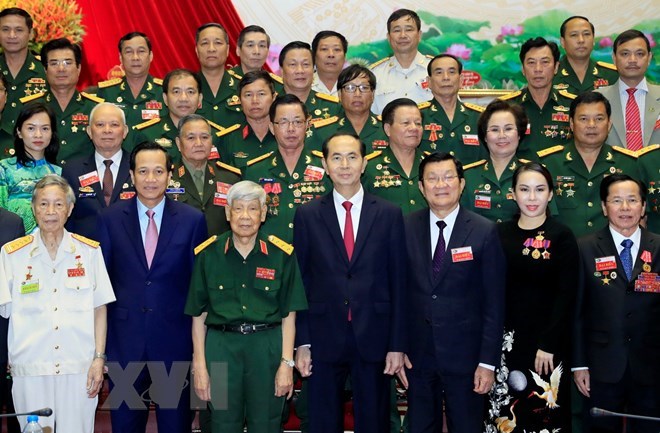 President Tran Dai Quang (first line, middle), former Party General Secretary Le Kha Phieu (first line, third, left), former President Truong Tan Sang (first line, third, right) and delegates to the congress pose for a group photo. President Tran Dai Quang has applauded the contributions of businesses run by war veterans to socio-economic development of localities and the country as well. Speaking at the second congress of the Vietnam Veterans’ Business Association (VVBA) in Hanoi on August 8, the President said the association should help its members develop commercial production, intensify scientific-technological applications in production and promote high value added services, thus helping with poverty reduction. The association was also requested to help remove difficulties facing the enterprises, replicate outstanding models and join hands in charity activities, especially drives to help war invalids and families of fallen soldiers.. The VVBA was established in April 2013, aiming to encourage war veterans to carry forward the spirit of self-reliance; support each other in economic development and poverty reduction; and step up charity activities. The association now has 38 chapters with 7,728 businesses and 82,791 farms run by war veterans, with total revenue of nearly 200 trillion VND (8.6 billion USD), generating jobs for more than 800,000 labourers. It has financed the construction of nearly 450 houses for social policy beneficiaries and contributed 524 billion VND (22.5 million USD) to charity activities and poverty reduction. On this occasion, President Quang presented the Labour Order, third class, to the association; and the Labour Order, first class, to its President - Labour Hero Le Van Kiem. Prime Minister urges measures to enhance dam safety  Water is being discharged from a hydroelectric reservoir. Prime Minister Nguyen Xuan Phuc has signed a directive calling for increased efforts to ensure the safety of dams and reservoirs. He asked the Ministry of Agriculture and Rural Development and the Ministry of Industry and Trade to form working groups to inspect large dams and reservoirs and those at risk in order to take preventive measures. The government leader also urged the two ministries to make response plans to deal with any scenario to guarantee safety for structures and the lower reaches. He called for a continued review of the planned dams and reservoirs and resolute cancellation of any inefficient projects that could exert great impacts on the environment and the lives of nearby residents. PM Phuc also asked the parties concerned to install monitoring devices and information systems to provide early warnings. According to the Directorate of Water Resources, currently 80 out of 286 large reservoirs in the northern region are now full, while the number of full large reservoirs in the north central region is at 22 out of 132. A significant number of smaller reservoirs are also full, while others have a water level at 65-85% of their capacities. Heavy rain has damaged 39 houses and flooded 20 hectares of rice paddies in the northern mountainous province of Yen Bai and caused a landslide that disrupted part of the road connecting Ha Giang province’s Meo Vac district to National Highway 34. Meanwhile in Hanoi’s southern suburban district of Chuong My, efforts are being made to reduce the floodwater levels, and prevent the spread of diseases when the water recedes and electrical incidents when the power is restored. PM: forestry exports to reach US$18-20 bln by 2025  PM Nguyen Xuan Phuc attends a meeting on wood processing and forestry exports in Ho Chi Minh City, August 8, 2018 PM Nguyen Xuan Phuc put a goal of earning US$9 billion in 2018, US$10-11 billion by 2019, US$12-13 billion by 2020 and US$18-20 billion by 2025 for the wood processing industry and forestry exports at the meeting on August 8 in Ho Chi Minh City. This is the first large-scale meeting on the wood industry, which aims to review the exploitation and use of wood and propose measures to uphold the nation’s potentials in this field. Speaking at the event, the PM said that while the agricultural sector contributes 16% of the GDP, the exports of wood and wooden products make up 21% of the agricultural exports, reaching nearly US$8 billion in 2017. The annual growth of the wood industry attained 15% over the recent 18 years, five times higher than the growth of the agricultural sector. As many as 4,500 businesses operating in the sector have created 350,000 jobs and the average value of US$23,000 per laborer. The Government leader supposed that the wood processing industry and forestry exports must become one of the nation’s production and export sectors and Viet Nam is expected to be listed among the world’s leading and prestigious forestry production and export hubs. He asked the ministries, agencies, localities and businesses to focus on effectively implementing the Law on Forestry 2017, regarding the forestry sector as one of the special economic and technical sectors in the value chain of forestry products from management, protection and development to forest utilization, processing and trade of forest products. PM Phuc encouraged investing in planting material forests and renewing science and technology in forest planting, wood processing and forestry exports especially in the context of the fourth industrial revolution, requesting to communicate among people and businesses to exploit timber legally. Highlighting the role of associations and the business community, he suggested enterprises respect international laws, use materials legally and do research in international markets carefully to prevent trade conflicts. The PM stressed the need to establish a trade mark for Viet Nam’s wood, announcing that after the meeting, a Directive on facilitation to the fast and sustainable development of the wood processing industry and forestry exports will be issued. Singapore’s 53rd National Day observed in HCM City 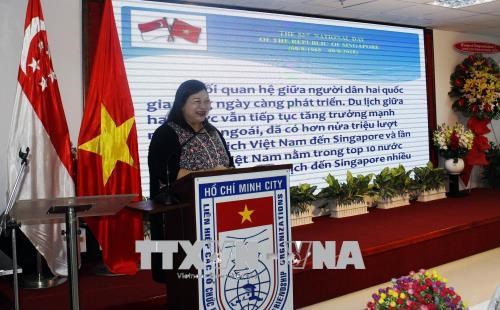 Singaporean Consul General Leow Siu Lin speaks at the event. A get-together to mark the 53rd anniversary of Singapore’s National Day (August 9) was jointly held by the Ho Chi Minh City Union of Friendship Organisations (HUFO) and the city’s Vietnam-Singapore Friendship Association (VSFA) on August 8. Congratulating Singapore on the day, Chairman of HCM City’s VSFA Nguyen Ngoc Hoa expressed his delight over the fruitful Vietnam-Singapore cooperative relations in various fields, which have been consolidated through regular visits of both sides’ high-level leaders, and meetings on the sidelines of multilateral forums. Two-way trade rose nearly 9 percent year on year to 21.6 billion USD in 2017. Singapore is the third largest investor in Vietnam with over 1,800 projects registered at 43 billion USD. Meanwhile, seven Vietnam-Singapore Industrial Parks nationwide have attracted some 10.9 billion USD, and created over 170,000 jobs for local labourers. On the occasion, Hoa called for further support from the Singaporean General Consulate, the Singaporean business association, and the Singaporean community in the city to enhance people-to-people exchange as well as collaboration in culture, sports, and tourism. Singaporean Consul General Leow Siu Lin expressed her respect for the cooperation from the HUFO and the VSFA in Ho Chi Minh City, which she said contributed significantly to fortifying the close relations between Singaporean people and Ho Chi Minh City’s locals. Regarding the bilateral ties in the past years, she stressed that both countries have gained positive results in cooperation across the fields of economy, trade, investment, tourism, and education and training. Since 1992, over 18,000 Vietnamese officials, including many from Ho Chi Minh City, have joined training courses in Singapore under the Singapore Cooperation Programme (SCP). Such cooperative activities have helped nurture the sound relations and friendship between the two peoples, she said. Vice President visits poor families in Vinh Long province 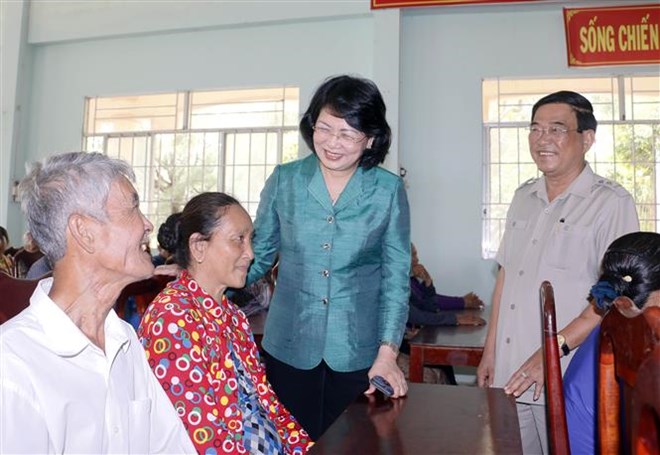 Vice President Dang Thi Ngoc Thinh visits policy beneficiaries in Vinh Long province Vice President Dang Thi Ngoc Thinh visited and presented 150 gift sets for policy beneficiaries, poor families and Agent Orange/dioxin victims in Nguyen Van Thanh and Tan Thanh communes of the Mekong Delta province of Vinh Long on August 8. After being briefed on socio-economic conditions by local authorities, the Vice President spoke highly of the recent achievements of the two communes, especially in poverty alleviation, national target programme on building new-style rural areas and economic structure shifting, which help raised locals’ income. She voiced her hope that the communes will continue to spare no efforts to ensure sustainable socio-economic development and effectively implement policies for those who rendered services to the nation, as well as reduce poverty and fulfil targets to receive the new-style rural area recognition. Thinh also expressed her gratitude to policy beneficiaries who made contributions to the country’s revolutionary cause. Vinh Long province is home to more than 64,000 revolutionary contributors, including over 16,400 martyrs, 4,500 war invalids, 50 people with the “Hero of the People’s Armed Forces” title, along with about 2,850 Heroic Mothers. There were around 10,355 poor households in the province, accounting for 3.71 percent of the local population. In the first six months of this year, the province raised over 106.7 billion VND (4.57 million USD) from social sources to support needy families and implement social welfare programmes. On the occasion, the Vice President visited students of the Ho Chi Minh City Banking University who are joining a summer voluntary campaign in Tan Thanh commune. VNN |
↧
Article 1
Vietnam's Phan Thi Mo crowned as World Miss Tourism Ambassador Vietnamese contestant Phan Thi Mo has defeated 50 contestants from many countries to be crowned as the World Miss Tourism Ambassador 2018 in Thailand on August 8.  Phan Thi Mo is crowned as the World Miss Tourism Ambassador 2018 in Thailand on August 8. Mo is in the top 18 of Best Body Category and won the Best Costume for Tourism Promotion. She was highly regarded by both the judges and the audience throughout the competition. Mo was born in 1990 in Tien Giang Province. She is 172cm tall, weighs 46 kg, and measures 90-57-100. She finished in the top 5 at Miss Vietnam World 2010. During the question and answer session, when being asked what is her biggest fear in her life, Mo said because health was the most important thing, her biggest fear was illnesses.  The World Miss Tourism Ambassador pageant was held in Thailand Before participating, Mo said this would be the last time she participated in international beauty pageants and expressed strong desire to win. Mo said she was extremely happy when her name was announced. "I was among the best contestants in many sub-contests and given praises from both the judges and other contestants. That's why I set the bar quite high for myself and everything exploded when my effort was rewarded. I want to thank my family, friends and fans, those who have always supported me since the first day. I'll work better to complete myself," she said. Beauty queens from Hong Kong and Chile won the World Tourism Queen and World Miss Couture titles respectively. The representatives of Thailand, Bolivia and Mongolia are the first, second and third runner-ups. Dtinews |
↧
Article 0
BUSINESS NEWS IN BRIEF 9/8 VinaCapital terminates investment in Ba Huan VinaCapital Group on August 7 announced plans to suspend its investment in Vietnam’s leading poultry egg and meat producer Ba Huan, following the producer’s recent request to the Prime Minister to help with the termination of the deal. According to a press release from VinaCapital, the two sides are now working together to revoke the deal while complying with the relevant laws and ensuring mutual benefits. VinaCapital claimed the agreement was signed in line with market practices and Vietnamese law and was similar to previous successful agreements between VinaCapital and other partners. The agreement also included articles to protect VinaCapital’s benefits, in line with current market practices. These articles would only be applicable if the poultry egg producer failed to reach its business targets. In addition, the agreed-upon investment amount was much higher than the market valuation based on the price-to-earnings ratio. According to VinaCapital, the contract was drafted in English and was signed in February. The contract and other important documents were later translated accurately into Vietnamese. In October last year, the two sides inked the term sheet, listed in both Vietnamese and English. The negotiation and signing process lasted over six months. During the period, Ba Huan consulted with some professional consulting firms to clearly understand its obligations. VinaCapital also stressed that it has no intention to acquire Ba Huan, as this is not part of its business strategy. Ba Huan was expected to use the investment funds to achieve its future production and business targets, according to the press release. Ba Huan and VinaCapital Vietnam Opportunity Fund (VOF) of VinaCapital Group announced their partnership on February 27, acknowledging that VOF would invest US$32.5 million in Ba Huan. The money was supposed to be used within three to five years to expand Ba Huan’s factories and farms in its closed system, ranging from farming to processing to ensure food safety and hygiene, which Ba Huan had developed over the past few years. The investment was expected to be disbursed within a year, following which VOF planned to invest further. With the investment, VOF was likely to own a stake in Ba Huan, but the specific percentage remains unknown. After the deal was signed, the ownership of the shareholders changed. The foreign shareholder, Hawke Investment Pte., Ltd, which is VOF’s subsidiary, owned more than 9.47 million shares, or 33.77% of the company’s charter capital, double the rate on February 13 when Hawke Investment Pte., Ltd. joined Ba Huan and held a 16.39% stake in the company. VOF also appointed its representative as a member of Ba Huan’s board. However, early last month, Ba Huan wrote to the Prime Minister asking for help to terminate its agreement with VOF as Ba Huan claimed that some articles in the agreement stated in Vietnamese were different from those in the English version that was initially signed, which might put it at a disadvantage. Under the deal, Ba Huan is required to ensure an internal rate of return of 22%. The partnership also restricted the poultry egg processor from engaging in business operations other than chicken and eggs. If the firm could not meet its targets within three years of signing the agreement, it would have to return the investment capital, along with the 22% interest, or transfer a stake of at least 51% to VOF. SCG inks $3.2 bn loan agreement for petrochemical complex On August 6, SCG announced that it has pushed forward Long Son Petrochemicals Company Limited (LSP), Vietnam’s first fully integrated petrochemical complex project, by recently signing loan agreements worth over $3.2 billion with six leading financial institutions. The project will begin construction in Q3/2018 and is expected to start commercial operations in the first half of 2023 to meet Vietnam’s soaring demand which can be as high as 2.3 million tons per year. This demand is projected to expand continuously thanks to Vietnam’s strong economic growth. “Long Son Petrochemicals project or LSP is a world-scale petrochemical complex with an investment of approximately $5.4 billion,” said Mr. Roongrote Rangsiyopash, President and CEO of SCG. “It's currently SCG’s flagship investment. This venture will increase the competitive advantages of SCG’s Chemicals Business in Southeast Asia. The project is equipped with world-class advanced technology that's flexible enough to utilize raw materials resulting in an increased competitive advantage. The project also leverages digital technology to create innovations for better products, services, and solutions for its customers.” The loan agreements were made in U.S. dollars and were signed with six leading financial institutions: Sumitomo Mitsui Banking Corporation, Mizuho Bank, Bangkok Bank, Krungthai Bank, Siam Commercial Bank, and Export-Import Bank of Thailand. The total credit facilities are worth over $3.2 billion with a tenor of approximately 14 years. Sumitomo Mitsui Banking Corporation is the project's financial advisor. LSP is located in Ba Ria – Vung Tau province which is 100 km from Ho Chi Minh City. Its olefins production capacity is 1.6 million tons per year for manufacturing High-Density Polyethylene (HDPE), Linear Low-Density Polyethylene (LLDPE), and Polypropylene (PP). The project has been maintained and operated with strict procedures to achieve world-class safety standards and environmentally-friendly practices to sustain activities and support a peaceful coexistence with Vietnam’s communities and society. Early this year, Thailand’s largest cement maker held a breaking ground ceremony for its flagship project, Long Son Petrochemicals, in southern Ba Ria - Vung Tau province. It's expected that the project will advance the local industry and provide better living conditions for people by creating competitiveness in the petrochemicals value chain. Conference to discuss breakthrough measures to boost forestry exports A conference seeking solutions to boost rapid and sustainable growth of the wood and forestry processing and export industries will be held in Ho Chi Minh City on August 8. Over the past years, the wood processing and export industries have expanded significantly, making Vietnam the fifth largest wood exporter in the world, the second in Asia and the biggest in Southeast Asia. In the 2013-2017 period, wood exports grew 10.6 percent per year with average revenue of 6.6 billion USD per year, becoming a major product in agro-forestry-fisheries group. Exports of wooden products and processed wood expanded 11 percent per year with average revenue of 4.7 billion USD per year. According to the Vietnam Administration of Forestry under the Ministry of Agriculture and Rural Development, in the first seven months of 2018, forestry products’ export value increased 14 percent year on year to 5.025 billion USD, 56 percent of the yearly target and 22.6 percent of total export revenue of the agricultural sector. Trade surplus of wood and wooden products in the period hit 3.52 billion USD. Wood imports in the first seven months hit 1.24 billion USD, up 0.4 percent year on year. At the same time, export markets of Vietnamese forestry products have changed significantly. Instead of shipping the products to Asian countries such as China’s Taiwan, Singapore and the Republic of Korea for export on to a third country, Vietnam now directly exports products to 120 countries and territories. The US, China, Japan and the Republic of Korea combined consumed 78.5 percent of products. Growth was also seen in the Malaysian, French and Australian markets. Recently, Vietnam has exported machinery for wood processing rather than importing it as three years ago. At the same time, the wood and wooden furniture sector of Vietnam has improved in terms of quality and quantity. Experts forecast that the domestic wood market will continue to rise for the rest of the year due to consumers’ habit, while orders are often finished at the end of the year, bringing bright prospects for the industry for the whole year. The US’s application of high taxes on Chinese wooden products is also an opportunity for Vietnamese firms. In the upcoming conference, representative of more than 500 wood processing enterprises, State agencies as well as domestic and international organisations will work together to find solutions to problems and plan for the development of the sector. At the event, the Ministry of Industry and Trade will put forth measures to boost wood processing and export sector, with a focus on expanding markets and increasing trade promotion to take advantage of free trade agreements. The ministry will suggest solutions to ensure materials for the industry. Particularly, amidst stricter regulations of importing countries on the legacy of wood origin, the ministry will continue tightening the management over imported wood, ensuring the implementation of Vietnam’s international commitments. Measures to foster links between businesses and forest planters in major material regions for more stable material supply will also be discussed. Meanwhile, the ministry will give recommendations to enterprises on activities to cooperate with each other to form production chains, strengthen the application of advanced technology to reduce cost, optimise advantages from free trade agreements with major markets and seek new promising ones. Firms seek support from Vietnamese diplomats abroad Enterprises and business associations have called on Vietnamese ambassadors and trade counsellors abroad to help them promote exports. According to Tran Viet Anh, deputy chairman of the HCM City Union of Business Associations, the city has 320,000 companies, which account for a large share of the country’s exports. The city’s business community needs regular support in promoting trade. Besides, in the era of Industry 4.0, businesses have faced trade disputes. Many businesses buy goods from foreign suppliers outside Cambodia but are asked to transfer money to accounts in Cambodia, and need the Vietnamese embassy to verify the companies’ antecedents. Besides exports, firms also invest abroad, and need support in carrying out the formalities, verifying information and other. Anh was speaking at a meeting on August 6 between businesses and 19 ambassadors and consuls general who will soon be stationed in Japan, India, Germany, Rumania, Denmark, Russia, China, Laos, and Bulgaria, among other countries. The meeting was meant to help the diplomats understand businesses’ requirements and how they can help promote Vietnamese investment and trade abroad. Nguyen Van Tuan from the Vietnam Cotton and Spinning Association said the country’s garment and textile products were exported mainly to the US, EU, Japan, and the Republic of Korea, with sales to other markets being modest. So the industry needed greater support from Vietnamese trade offices in other markets, he said. Many businesses have been buying cotton from foreign companies, but when cotton prices rose sharply, many suppliers did not make delivery or delivered goods of inferior quality, causing difficulties, he said. A 400ha textile and garment zone was being built, and trade counsellors and ambassadors should apprise foreign investors so that they could invest in it, he said. Nguyen Van Khanh, General Secretary of the Leather and Footwear Association of HCM City, wanted diplomatic agencies to help find outlets for crocodile leather-based products to boost crocodile breeding in the city. Pham Sanh Chau, Vietnamese Ambassador Designate to India, said trade counsellors and ambassadors understand businesses’ requirements and promised support, but said diplomatic missions could not meet all their requirements. Many businesses emailed embassies asking for information they themselves could easily find on the internet, delegates explained. According to Pham Truong Giang, Vietnamese Consul General in Germany, embassies have very few people but a lot of tasks, and so businesses should ask for specific information and not general information. But ambassadors and trade counsellors would always assist businesses, he promised. Vietnamese commodities enter foreign distribution networks The direct exports to foreign distribution systems are considered to be an efficient and sustainable method, which many Vietnamese exporters are pursuing. This year, the Ministry of Industry and Trade has implemented a project to help Vietnamese enterprises join foreign distribution system until 2020. The project aims to promote trade, advertise Vietnamese brands, and expand market for Vietnamese goods. In early 2000, foreign investors began to show interest in Vietnam’s distribution market. First were European companies such as Metro supermarket of Germany and then Bourdon Group’s Big C of France. Since then, Vietnamese exporters could directly access foreign distributors in Vietnam. In the past, Vietnamese goods were sold worldwide, mainly via mediators or importers. Dang Hoang Hai, Director of the European Department of the Ministry of Industry and Trade, said, "Vietnamese enterprises will face many disadvantages when they have to export through intermediary agents. The first drawback is that Vietnamese exporters will not know consumers’ demands. Secondly they will not understand the management capacity of major distribution chains around the world. Third is when exporting products through the third parties, Vietnam cannot develop its brands. Vietnamese goods will be packed in the names of foreign companies. Even the “Made in Vietnam” printed on products will be lost.” During the first Vietnam Goods Week held at the Big C supermarket chain in 2011, Vietnamese businesses received direct training from procurement personnel of the distribution system. With the initial results, from 2012 to 2014, the Ministry continued to organize Vietnamese Goods Weeks in Metro supermarkets and BigC stores. In June 2016, the model was expanded to supermarkets of the Republic of Korea and Japan. During the Vietnamese Goods Week in Japan’s Aeon shopping mall, seminars, forums, and training programs were held through which Vietnamese enterprises could connect with foreign distributors. Nguyen The Tan, Director of Tam Lan Tea Company, said, “Thanks to the introduction of the European Market Department, we have easily accessed the market there and our products have entered France through the Thanh Binh supermarket system.” There are approximately 170 foreign retailers in Vietnam. The dominant names included Big C, Lotte Mart, and Aeon Mall, which mainly sell Vietnamese products. But it requires stronger measures to have Vietnamese goods sold in major shopping malls outside Vietnam. The Prime Minister has approved a project entitled “Developing Direct Participation of Vietnamese Enterprises in Foreign Distribution System until 2020”. Under the project, the Ministry of Industry and Trade will organize Vietnamese goods weeks abroad and seminars involving major foreign distributors in Vietnam, who will help sell Vietnamese products in their respective distribution chains. The project aims that by 2020 Vietnamese goods will be available in big shopping malls in Europe, North America, Southeast Asia, Northeast Asia, and in the countries Vietnam has signed FTAs. Exports set for a challenging run into year’s end Many countries are intensifying their safeguard measures and imposing new food safety regulations and environmental protection criteria, creating difficulties for Vietnam’s exports of domestic products. Looking at the export situation in the first half of this year, Duong Duy Hung, head of the Planning Department under the Ministry of Industry and Trade, pointed to positive signs behind the domestic sector’s higher growth than the foreign direct investment (FDI) sector. Mr Hung said that from now to the end of the year exports will continue to encounter numerous obstacles and challenges as countries have stepped up the application of safeguard measures and stringent regulations on food hygiene and safety and environmental protection criteria. The EU’s issuance of a yellow card warning on Vietnam’s seafood, the US’ anti-dumping duties on tra fish, and issuance of new regulations on certificates of origin are a typical case in point. There is also the case of some countries using smear campaigns to cast Vietnamese export products in a bad light, such as with tra fish in the EU and cashew nuts in India. Monthly exports reached US$19.5 billion during the first half of 2018. To achieve the set target for the year, the second half export value is required to rise to US$20.45 billion, posing a great challenge to Vietnam, especially in the context of unpredictable fluctuations in the world market, said Mr Hung. Vietnam Textile and Apparel Association (VITAS) Vice President and Secretary General Truong Van Cam said the garment and textile sector is already facing a lot of challenges from both inside and outside the industry. One challenge from within the industry is that Vietnam still has to imports a huge amount of fibre while its annual fibre output hit more than 1.4 million tons of fibre. In addition, more than 80% of imported fabric is used to produce garments for export. Most of external challenges presented by free trade agreements (FTAs), are requirements for certificates of origin, which is problematic when Vietnamese garment manufacturers have to import 80% of their materials, Cam noted. In other industries, seafood has also encountered certain difficulties in its processing and export. According to the Vietnam Association of Seafood Exporters and Producers (VASEP), factors which have had a negative impact on seafood exports this year include the US inspection of tra fish and their levying of anti-dumping duties on shrimp and tra fish, and the EC’s issuance of a “yellow card” warning on seafood. Meanwhile, some internal problems are still being resolved, such as material shortages, residual antibiotics, and production costs. Truong Dinh Hoe, VASEP Vice President cum Secretary General , said if appropriate solutions to these problems are not found, all efforts to implement the bilateral and multilateral FTAs, build reputation and quality of products, promote trade, develop added value products and improve the business environment will be in vain. Tran Thanh Hai, Deputy Head of the Import-Export Department under the Ministry of Industry and Trade, said there have not been necessary improvements to the food hygiene and safety of agricultural products and seafood, resulting in rejected export products such as seafood, pepper and rice, which has adversely affected the image and brand name of Vietnamese goods. Regarding its market development work, import tariffs have been cut as a result of negotiating, signing and implementing bilateral and multilateral FTAs, however, negotiations on mutual recognition of quality management system and food hygiene and safety are limited. Consequently, many agricultural and aquatic products with highly advantageous import duties of zero have been unable to access overseas markets as they fail to meet the required standards. In order to boost exports in later months of the year, Phan Van Chinh, Head of the MOIT’s Import-Export Department, proposed three key tasks of developing products, ensuring supplies for export, developing markets and organizing exports for efficient performance. At a time when ever more jobs are being handed over to more sophisticated robotic machinery, it is increasingly necessary to improve the quality of workforce, said Vu Duc Giang, Vitas President, adding that in the robot era, there will be no place for low cost labour force but now is time for smart labour. Additionally, businesses need to restructure their production based on domestic material sources, and develop their own design so as to take full advantage of FTAs. It is imperative for enterprises to establish cooperative networks, effectively implement projects and adopt advanced technologies in order to meet the strict requirements of demanding markets. According to Le Quoc Phuong, former director of the MOIT’s Industry and Trade Information Centre, industrial products have been the dominant export products over recent years. With its products making up roughly 80% of the country’s total export value, the processing and manufacturing sector represent a dramatic shift to industry. Following this trend, the current export structure is likely to remain stable from now to the end of the year, he said. T&T Group to import raw cashews from Guinea Bissau T&T Group of Vietnam pledged to import raw cashew nuts from Guinea Bissau with an annual volume of 150,000-200,000 tons in 2018 and the following years under a memorandum of understanding on agribusiness signed in Hanoi on August 6. The Guinea-Bissau government is committed to ensuring output, quality, delivery deadlines and payment channels. Guinea Bissau is currently the fifth largest raw cashew nut producer in the world. During the working session the same day, the two sides also discussed the possibility of exporting Vietnamese rice to this African nation’s market in the years to come. T&T Group vowed to provide training in the field of agriculture, and technology transfer to Guinea Bissau. Addressing the signing ceremony, Minister Vicente Fernandes said that Guinea Bissau and Vietnam have many similarities as they are both agricultural countries. Guinea Bissau has a relatively high demand or rice imports while Vietnam is one of the world's top rice exporters. In the opposite direction, Vietnam has a great demand for imported raw cashew nuts while Guinea Bissau is a large exporter of the farm produce, thereby affording the two countries huge opportunities for broader agricultural cooperation in future. The partnership between the Government of Guinea Bissau and the T&T Group of Vietnam marks a new step of development in bilateral cooperation. Apart from agriculture, both sides also have plentiful opportunities for stronger cooperation on other areas such as infrastructure development, seaports, and human resource training, said Minister Vicente Fernandes. The Guinea Bissau Minister said he believes that with T&T Group experience in finance-banking, investment, insurance, import-export, the cooperation between the two sides would be successful, yielding good results. In his remarks, Deputy Minister of Industry and Trade Do Thang Hai highlighted the great potential for rice and cashew exports between both sides, adding that T&T Group is a large reliable private economic group operating in multiple sectors in Vietnam. EVN to divest from five joint stock companies 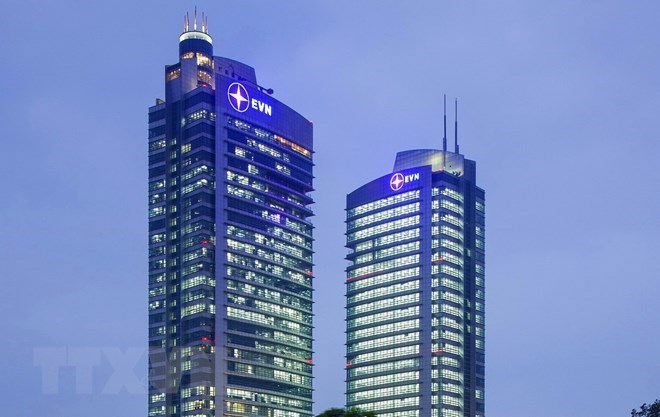 The Electricity of Vietnam (EVN) has said that the group is completing procedures to withdraw its capital from five joint stock companies. The companies are the EVNFinance JSC, the Power Engineering Consulting Joint Stock Companies 3 and 4, the Thuan Binh Wind Power JSC, and the Power Engineering JSC. This month, the EVN will step up capital divestment and complete procedures in preparation for the first congress of shareholders and the equitisation of the Power Generation Corporation 3 (EVNGENCO 3), while continuing with the equitisation of the EVNGENCO1 and 2, the group said on August 3. At the same time, it will work to put some projects into operation, including the Quang Ngai-Quy Nhon 220kV transmission lines (second phase), and Long Phu-Soc Trang line. In July, the EVN ensured electricity supply for socio-economic development and daily activities of residents, especially during the long and severe heatwave in the northern and central regions. The group produced and imported 19.57 billion kWh last month, raising the total electricity output in the first seven months of this year to 125.5 billion kWh, up 11.7 percent against the same period last year. Its commercial electricity output in the month was estimated at 17.15 billion kWh, a year-on-year rise of 13.37 percent. The amount recorded during the January-July period was around 108.92 billion kWh, up 11.02 percent over the corresponding time last year. The group and relevant units launched five projects and put into operation 15 projects of 110-500kV in July. In the first seven months, it began construction of 62 projects and put into service 96 others. The EVN is now ready for the trial run of turbines of the expanded Vinh Tan 4 thermal power plant. Complete infrastructure system crucial for e-commerce growth: experts  E-commerce and online shopping are forecast to become a key trend in the world, accounting for 25 percent of the global retail revenue, experts said, suggesting Vietnam promptly complete infrastructure system to boost the growth of trade. According to the Vietnam E-Commerce and Digital Economy Agency under the Ministry of Industry and Trade, a person spends an average of nearly 25 hours online every week, or over 3 hours per day. At the same time, nearly one third of Internet users conduct online shopping with expenditure of about 160 USD per person each year. It is estimated that in 2020, as many as 30 percent of the Vietnamese population will involve in online shopping with spending of 350 USD each per year. The most popular goods of online deals are garments, footwear (64 percent); books, music, stationeries (51 percent); cosmetics and personal caring products (40 percent), information technology and house appliances (40 percent), furniture (29 percent); and foods (20 percent). Many big retailers such as Lotte Vietnam and Aeon Vietnam have stepped up their online trading channels to compete with popular names such as Adayroi, Alibaba, The gioi di dong, Lazada, Vat gia and En bac. Nguyen Huu Tuan, head of the E-Commerce Management Office under the Vietnam E-Commerce and Digital Economy Agency, said that e-commerce has seen strong growth, which is suitable to the development of the modern economy thanks to its strength in convenience, especially for busy people. About half of the Vietnamese population have accessed the Internet, and Vietnam is now one of the leading countries in people’s spending time online, he said. Currently, a Vietnamese owns 1.3 cell phones averagely, 70 percent of which are smartphones, he noted, adding that a firm infrastructure is a foundation for e-commerce sector of Vietnam to earn 4 billion USD last year. Dang Hoang Hai, Director of the Vietnam E-Commerce and Digital Economy Agency, said that over the past years, online distribution channels have grown diversely with major forms of websites, online trading floors, social networks on both web and online base. Therefore, about 46 percent of enterprises have built and operated their own websites, while 13 percent of them have joined online trading floors, he noted. In the 2012-2016 period, the ratio of firms receiving orders and making orders through websites grew 30 percent. Notably, as many as 76 percent of the websites have national coverage, while 24 percent covers localities or regions. Meanwhile, the development of online payment methods has also effectively supported e-commerce. However, Hai admitted that infrastructure supporting e-commerce such as e-receipts, e-payment and logistics have developed at different levels without synchronization and connections. This is also a reason why 40 percent of customers complained about stagnation in e-commerce. Vu Hoang Lien, President of the Vietnam Internet Association, stressed that retailers should focus more on marketing and online sale, while enhancing the quality of delivery services as well as the online payment in their websites and keeping a close watch on new e-commerce trends to ensure their competitiveness. Lien also pointed to the need to build reputation and prestige of trademarks to improve competitiveness, initially through the choosing of a good domain name. Experts also highlighted the need to rapidly and comprehensively expand the infrastructure serving e-commerce, as well as the settlement of shortcomings in packing, designs, quality and logistics. They stressed the need for reinforcement of e-commerce safety and security as well as the formation of management and supervising system over online trading activities. Hai revealed that the Ministry of Industry and Trade has coordinated with relevant agencies to launch the Keypay e-payment system with suitable features for Vietnamese businesses. The ministry has also concentrated on building a system for managing e-receipts that is widely applicable in the market as well as solutions for e-receipt matters, thus creating a firm foundation for the growth of e-commerce in the future, added Hai. Vietnam Airlines, Vinamilk shake hands to provide 4-star service 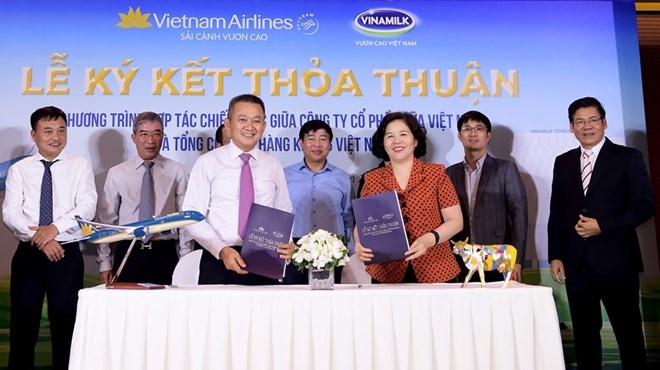 Vinamilk products, served on Vietnam Airlines flights departing from Vietnam, will have specially designed packing to promote the quality of the country’s single four-star airline. This is part of a five-year strategic deal inked between the national flag carrier and the Vietnam Dairy Products Joint Stock Company (Vinamilk) on August 6. Total value of Vinamilk’s products on board is expected to increase 10 percent every year. Under the cooperation programme, which is valid until 2023, both sides also cooperate in other sectors such as co-branding in some events, marketing campaigns, sharing experience in management and operation of supply chain, warehouse system, and relevant information on consumption market, and branding reports. Vietnam Airlines General Director Duong Tri Thanh said that the strategic agreement between the two leading firms in Vietnam will inspire the development of value chain, which connects Vietnamese brands during the global integration. “Vinamilk has been a partner of Vietnam Airlines for years. We understand each other’s strengths in the development of Vietnamese values. Clean agricultural ecosystem, nutritious products, and food safety are what we need to popularise worldwide”, he noticed. Meanwhile, Vinamilk General Director Mai Kieu Lien underlined that the co-branding will not only help the two corporations develop trade but also promote the two brands in the international arena. The cost for advertising in Vietnam is too low compared to other countries The cost of advertising in Vietnam is too low compared to other countries around the world according to Mr. Nguyen Dung, Vice President of Vietnam E-commercial Association (VECOM) at the press conference on August 1. "For example, an American brand pays $2 for an advertisement, but in Vietnam, it only pays $0.2 to $ 0.5. One of the reasons for this is that the viewer of the ad and the audience is not accurate, which leads to distrust. Currently, images of Vietnam's online advertising in the eyes of the world aren't beautiful, and the cost of advertising in the Vietnamese market is too low," Nguyen Dung said. Another remarkable piece of information that was shared by Nguyen Dung is that Vietnam was listed as one of the top three non-transparent online advertisers. “Con Cung” is a typical example of products that are not what they're advertised. In order to contribute to limiting the current status quo, the content of the solution for online marketing transparency will be addressed at the first session of the 2018 Online Marketing Forum. In addition, Online Marketing Forum 2018 will focus on exploring the latest trends as well as the potential to help expand the online marketing sector to increase the market share of Vietnamese businesses. According to Tran Van Trong, Head of VECOM's Office, the main parts of the 2018 Online Marketing Forum are four sessions: "Marketing Market Overview", discussing the trends of online marketing in the world, the experience of modern consumers; "Human or Robot," sharing information on artificial intelligence applications (AI) in online marketing and effectively exploiting the chatbox; "Data-driven Marketing" with data-driven marketing experience to retain customers and integrating voice recognition to attract customers; and finally "Marketing O2O - from strategy to planning" which discusses smart advertising and multi-channel marketing shifts. "This is an opportunity to exchange information and drive business solutions and opportunities in the field of online marketing to support e-commerce businesses and identify online marketing strategies. In addition, it helps increase the efficiency of online marketing, but also contributes to expanding the market of online marketing and improving the market share of enterprises, "said Tran Van Trong. In the afternoon of August 1, in Vietnam, VECOM held a press conference and announced that Online Marketing Forum 2018 will take place on August 15 in Ho Chi Minh City and August 17 in Hanoi with the theme "Human or Robot. Me" It's expected that each event will attract more than 1,000 participants. The growth rate of Vietnam's e-commerce in 2017 is 25 per cent higher than the previous year. This growth is expected to continue in 2018. The market also recorded impressive growth over the past year. In the online retail sector, the sales growth rate of 2017 reached 35 per cent. Some large-scale delivery enterprises even saw revenue growths of 62 to 200 per cent. Vietnam exports 1.8 million tonnes of petroleum in first seven months Vietnam shipped 200,000 tonnes of petroleum in July, raising the total volume of exported petrol in the first seven months of 2018 to 1.8 million tonnes, bringing in US$1.14 billion. The figures are an increase of 11.7% in volume and 41.1% in value compared with the same period of last year, according to the Ministry of Industry and Trade (MOIT). Data compiled by the MOIT’s Industry and Trade Information Centre shows that Vietnam’s petroleum exports to other Southeast Asian countries accounted for more than one third of its total petroleum exports. In the first half of 2018, Vietnam shipped 370,600 tonnes worth US$243.7 million to Cambodia, while the volume exported to China was 221,600 tonnes, bringing in US$153.5 million. During the same period, Vietnam exported 77,000 tonnes to Laos, 65,800 tonnes to Malaysia and 59,700 tonnes to the Republic of Korea. On the other hand, Vietnam spent US$4.66 billion on importing 7.07 million tonnes of petroleum in the first six months of 2018, up 11.5% annually. Malaysia was the largest provider of petroleum products to Vietnam with 28.5% of the total imported volume. HCM City to equitise Sai Gon Jewelry and many public service firms in 2019 HCM City People’s Committee will equitise Sai Gon Jewelry Co Ltd (SJC), Viet Nam’s largest gold and gold jewelry production and distribution company, in 2019. Together with SJC, seven public utility companies are also set to be equitised next year. The municipal committee assigned the city’s board for State-owned enterprise (SOE) management reform to perfect the plan for SOE re-organisation and reform in the 2018-20 period. SJC, formed in 1988, is a State-owned enterprise under the HCM City People’s Committee operating under the parent-subsidiary company model with production and trading gold and jewelry as its main business. It accounts for 90 per cent of the gold bullion market share in the domestic market. In May 2011, the State Bank of Viet Nam (SBV) appointed SJC as the sole entity authorised to produce gold bars in Viet Nam. In 2017, SJC recorded VND22.95 trillion (US$998 million) in revenue and VND85.4 billion in pre-tax profit. Apart from JSC, other businesses subject to equitisation next year are the public service companies of districts of 7, 8, 9, Binh Thanh, Go Vap and Nha Be, along with the Liksin Industry – Printing – Packaging Corporation. Meanwhile, the city asked the Government to exclude HCM City Irrigation Management Company from equitisation. At the proposal of the board for SOE management reform, the municipal People’s Committee also agreed to keep 100 per cent of State capital at the Sai Gon Water Corporation. The southern city is accelerating procedures and approval of plans on equitisation and divestment of State capital from 39 businesses. It added that the businesses had completed asset assessment pending approval of equitisation plans, and on receiving approval, they expected to complete equitisation within 2018 and 2019. Viet Capital Bank opens 1st branch in Bac Ninh Viet Capital Bank has opened its first branch in the northern city of Bac Ninh, and the 55th in the country, as part of its strategy to target retail customers and small and medium-sized enterprises. To mark is opening, the branch is offering attractive gifts to customers and launching promotions like free money transfer and the Happy Friday programme with incentives for customers transacting on Friday. Bac Ninh is one of eight provinces in the northern key economic region, and has modern infrastructure and business-friendly policies. In recent years it has achieved strong economic growth. Viet Capital Bank plans to open a branch each this month in Soc Trang, Binh Duong, Long An, and Vung Tau. G-bonds worth US$671 million raised in July The Ha Noi Stock Exchange organised 33 Government-bond auctions last month, raising VND15.77 trillion (US$671 million), down 6.9 per cent against the previous month. Interest rates of the bonds rose for all terms compared with June, of which five-year bonds were up 0.35 percentage points to 3.45-4.10 per cent per year, 10-year bonds were up 0.13 percentage points to 4.40-4.48 per cent, 15-year bonds were up 0.08 percentage points to 4.70-4.78 per cent and 20-year bonds were up 0.02 percentage points to 5.22 per cent. On the secondary market, the total volume of Government bonds sold by the outright method in the month reached over 554.6 million worth VND62.4 trillion, down 42.3 per cent in value from June. Of the total, foreign investors made outright purchases of over VND2.18 trillion and outright sale transactions of more than VND6.42 trillion ($176 million). Trading volume through repurchase agreements (repos) was more than 902 million bonds valued at VND92.5 trillion, decreasing 39.7 per cent in value against the previous month. Foreign investors made no repo trading during the month. According to the Ministry of Finance, the value of G-bonds issued in 2018 is estimated at some VND180 trillion ($7.93 billion), with the focus being on long term maturity and keeping the interest rate at low levels. VR launches recall campaign for Mercedes GLC More than 760 luxury Mercedes GLC vehicles are being recalled in Viet Nam over faulty airbags after reports that they may be prematurely deploying in several certain conditions. According to Vietnam Register (VR), the recall campaign applies for models GLC 250 4MATIC and GLC 300 4MATIC manufactured between June 2017 and September 2017. The affected vehicles will be checked and fixed for free at all dealers of Mercedes-Benz Company Ltd nationwide. The recall started from July 16 to December 31, 2020. This is the 10th Mercedes-Benz recall of vehicles related to airbags in Viet Nam. Most recently in May this year, the Vietnam Register issued a notice recalling 284 Mercedes-Benz vehicles due to a mass error that led to the automatic airbag activation. Int’l food-beverage, packing expos open in Ho Chi Minh City Around 22,000 domestic and foreign visitors are expected to come to the international exhibitions on food-beverage and on food processing and packing, which kicked off in Ho Chi Minh City on August 8. The 22nd International Exhibition on Food and Beverage and the 22nd International Exhibition on Food Processing, Packing Technology and Equipment (VietFood & Beverage – ProPack) draw the participation of 550 enterprises from 20 nations and territories showcasing their products in 600 pavilions, including seven national ones of India, Poland, the Republic of Korea, Thailand, China and Vietnam. Vietnam’s national booth gathers the country’s giants in the food-beverage field, such as Sabeco, Habeco, Dr. Thanh, and Sagota. Nguyen Khac Luan, General Director of the Vietnam National Trade Fair & Advertising Joint Stock Company (Vinexad), said that Made-in-Thailand consumer products, food and beverages have been long popular in Vietnam. However, Thai firms still choose to take part in the VietFood & Beverage – ProPack annually as a way to promote their products to foreign buyers, including supermarkets and leading retailers. Pham Thanh Kien, Director of Ho Chi Minh City’s Department of Industry and Trade, stressed that foreign businesses’ presence in Vietnam has opened up more cooperation opportunities for investment and production in export processing and industrial zones, creating jobs for labourers and boosting technology transfer and production and business. It has also fostered competitiveness and made domestic firms to reform to attract consumers, Kien added. The two exhibitions will run through August 11. Vietnam Manufacturing Expo 2018 underway in Hanoi The Vietnam Manufacturing Expo 2018 is taking place in Hanoi from August 8-10, displaying the latest machinery and technologies for the manufacturing and supporting industries by 200 brands from 20 countries. Hundreds of leading experts from Japan, Singapore, Thailand, and China’s Taiwan have participated in the event, providing solutions and know-how about smart factories to support Vietnamese manufacturers. Suttisak Wilanan, deputy managing director of Reed Tradex, the host of the event, said 76 percent of manufacturing plants are constructing or starting to invest in transforming themselves into smart ones. However, only 14 percent of them were satisfied with what they had achieved, he added. He suggested Vietnam take step-by-step moves to build smart factories. New robots, machinery and technologies for Vietnam’s manufacturing and supporting industries are introduced at the event, allowing small- and medium-sized enterprises to apply production automation. Business Development Manager at Creatz3D Vietnam Hoang Van Tan shared that with the 3D printing technology, businesses could create high-quality products in a short span of time. The expo includes a technology presentation on new product by TOYO Automation Co., Ltd., and a forum on developing the brand name of supporting electronics industry products held by the Vietnam Electronic Industries Association, Vietnam Industry and Trade Information Centre, and Red Tradex Co., Ltd. Special activities with a wealth of knowledge and skill trainings will be made available for Vietnamese manufacturers such as a show on creating industrial networks beyond with four international pavilions, a showcase on industrial robots, a battle amongst Vietnamese welders to find the best of the best welders, and a guided tour namely “Shows in Show” which will impress all participants with state-of-the-art technologies and machinery. Latest advertising technologies on display at VietAd 2018 The 9th Vietnam International Advertising Equipment and Technology Exhibition (VietAd) opened at Phu Tho Indoor Sports Stadium in Ho Chi Minh City on August 8. This year’s event features 350 booths of nearly 150 domestic and foreign businesses, showcasing printing machinery, advertising materials and gifts, LED technology and advertising services, according to head of the organising board Nguyen Thanh Dao. It also includes a conference themed VietAd Business Matching 2018 with a view to helping ad companies of Vietnam meet with those from other countries like Japan, the Republic of Korea, China and Myanmar to share experience and seek partnerships. As part of the exhibition, a workshop will also be held to look into Vietnam’s advertising market in the first half of this year. Nguyen Truong Son, Standing Vice Chairman and Secretary General of the Vietnam Advertising Association, said first held in 2010, VietAd has established itself in the region and become the biggest advertising equipment and technology in Vietnam. It is growing into a prestigious, practical and effective event for domestic and foreign firms to update the latest advertising equipment and technologies, thereby helping to promote the development of the advertising sector in the country. VietAd 2018, scheduled to last through August 11, expects to welcome more than 10,000 visitors, including industry insiders from other countries. The annual event is organised by the Vietnam Advertising Association, the HCM City Advertising Association and the Dong Nam Advertising and Commercial Promotion JSC. VNN |
↧
↧
Article 2
BUSINESS NEWS IN BRIEF 10/8 First national forum on e-procurement held in Hanoi The national e-procurement system (VNEPS) was the spotlight of the Vietnam E-Government Procurement Forum 2018, the first on the issue at the national scale, in Hanoi on August 8. The VNEPS, run by the national e-procurement centre, was introduced on a trial basis for six years and officially put into operation nationwide in 2016. Statistics of the centre show that the numbers of bid inviters and bidders actively using the VNEPS have increased considerably. In the first seven months of this year, nearly 9,000 bid packages were offered online, doubling that in the same period of 2017. The figure is expected to stand at about 15,000 in 2018. Deputy Minister of Planning and Investment Vu Dai Thang said despite encouraging initial outcomes, there remain many difficulties and challenges in developing e-procurement. Hence, the ministry will push ahead with fine-tuning the legal basis, improving staff’s capacity, disseminating information to participants, and perfecting technical infrastructure. Alexander Fox, Principal Procurement Specialist at the Asian Development Bank (ADB) in Vietnam, said the ADB particularly recommends the country modernise the VNEPS. It and the World Bank (WB) will also strongly assist the Vietnamese Government to improve and promote e-procurement via the VNEPS. After successfully testing some bid packages in several projects of the two banks on the VNEPS, the ADB and WB will expand e-bidding for procurement and construction packages of projects funded with their capital, he noted. Nguyen Anh Tuan, Deputy Director of the ministry’s Public Procurement Agency, said the VNEPS helps improve the transparency and fair competition in government procurement. Steps in the bidding process are conducted completely online, helping participants save time, cost and manpower for the work. Notably, e-procurement can help minimise negative acts like cheating, collusion or obstruction in the bidding process. It is also able to keep information about bid prices and bidders’ names absolutely secrete before bid packages are put out to tenders, he stressed. Tuan noted to develop the VNEPS, it is necessary to improve the awareness of leaders in each entity taking part in the bidding process. Authorised agencies also need to improve policies on the management, technologies and operation of the system in order to align domestic legal framework with international practice. Vietnamese steel exporters warned of possible 25% tax 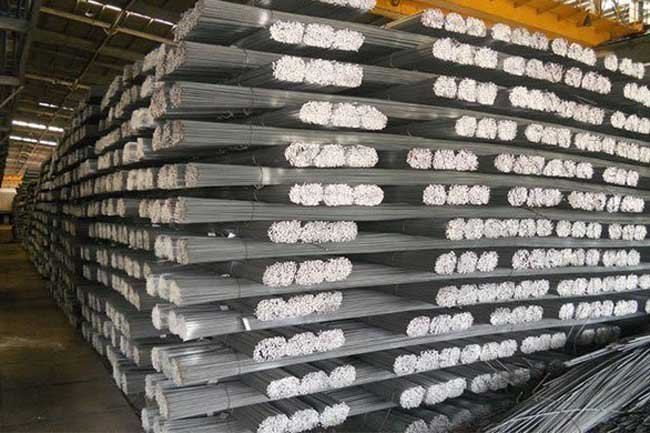 The European Commission (EC) might levy a 25% tariff on steel imports from Vietnam The Ministry of Industry and Trade has announced that a steep tariff is likely to be imposed by the European Commission (EC) on steel imports from Vietnam. The ministry made the prior announcement to help steel firms cope with tough times ahead, reported Sai Gon Giai Phong newspaper. As the EC has issued a regulation to apply temporary safeguard measures, imposing quotas on 23 of 28 types of imported steel products, those firms whose steel exports exceed the allowed quota will have to pay an additional 25% tariff. Three of Vietnam’s 23 steel products---non-alloy and other alloy cold-rolled sheets, metallic coated sheets and stainless cold-rolled sheets and strips---are subject to export quotas, while 20 other types of products shipped to the European Union are temporarily exempted from the quota regime, meaning they are not subject to the 25% tariff. However, Vietnam will face protectionist charges after February 3, 2019, if the country’s steel exports exceed quotas by 3% following the EC’s temporary protective measures. The Trade Defense Department at the Ministry of Industry and Trade will announce the quantity of steel bound for the European Union so that Vietnam’s steel enterprises and the relevant agencies can control and limit exports appropriately to avoid additional duties. Real estate inventories drop 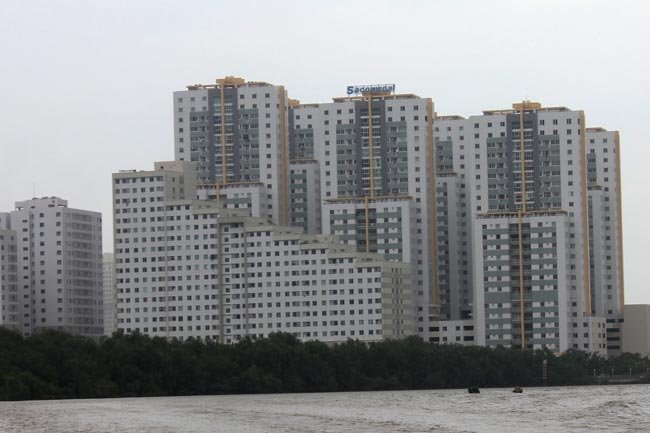 Condo buildings are seen in HCMC. According to a report by the Department of Housing and Real Estate Market Management, the local property market maintained stable development over the first six months of 2018, rising by 4.12% year-on-year The total value of property inventories had plummeted to a little more than VND24 trillion as of June 20, down by VND700 billion compared with the first quarter of this year, according to a report by the Department of Housing and Real Estate Market Management under the Ministry of Construction. Nguoi Lao Dong newspaper cited the report as saying that the property market maintained steady growth in the first six months of 2018, rising by 4.12% year-on-year. The real estate sector recorded the registration of some 3,300 new firms, up by a staggering 44.2% year-on-year. The sector saw new foreign direct investment approvals totaling some US$4.9 billion. The total capital of property projects now underway is estimated at VND3,500-4,000 trillion. The total value of property inventories as of June 20 slipped to VND24,072 billion. Real estate loans account for 6-8% of total outstanding loans, remaining under control. According to the Department of Housing and Real Estate Market Management, medium- and high-end properties have faced a slowdown, but low-cost condo buildings and houses have risen slightly due to high demand and limited supply. Nguyen Trong Ninh, head of the department, noted that the real estate market will not see major changes in the rest of the year, insisting that stable development was more likely. He, however, warned property firms of the fever for vacant land in some localities as several individuals have been taking advantage of the plan to establish special economic zones and large traffic projects, such as Long Thanh International Airport, metro lines in HCMC and expressways, to spread rumors of land price rises. No agency responsible for imported scrap backlog at ports  Scrap containers are piled up at a local port. The backlog of imported waste at ports is not currently under the purview of any particular agency The large backlog of imported waste at ports is not currently under the purview of any particular agency, Nguoi Lao Dong newspaper reported, citing delegates at a meeting on improving the control and handling of scrap containers abandoned at local ports. At the meeting held by the Vietnam Maritime Administration under the Ministry of Transport on August 2, participants said that enterprises, port operators, shipping firms and customs agencies have yet to cooperate to control the import of secondhand products, especially plastic. As a result, procedures continue to overlap, thus slowing down the handling of these containers. Phan Trong Lam, deputy general director of Vietnam International Container Terminals, said that the handling of imported plastic waste is regulated in six laws and falls under the jurisdiction of 10 agencies. However, no single agency has taken the lead, causing difficulties for enterprises. According to Nguyen Phuong Nam, director of the operating center of Saigon Newport Corporation, ports have stopped accepting plastic scrap containers since early last month. Paper and steel shipments have been mainly sent to Cat Lai and Cai Mep ports, respectively. Some 4,500 containers, storing scrap such as paper and plastic, have been abandoned at Vietnamese ports as the identity of the owners and transport firms remains unknown. Bui Viet Anh, a representative of shipping firm Cosco, told the participants of the meeting that the Ministry of Natural Resources and Environment has issued certificates only to importers of small-sized scrap. He proposed the Government swiftly establish a working group that includes the representatives of various agencies to deal with the backlog of imported waste. Shipping companies claimed they are not allowed to check the containers before loading them onto ships. They have suggested directly contacting the owners of the abandoned containers instead of publicizing the information in newspapers. Nhu Dinh Thien of the Vietnam Ship Agents and Brokers Association argued that shipping firms need to know what they have transported and should carry the ineligible scrap imports out of the ports. He further suggested that certificates of eligibility for environmental protection on scrap imports should be granted only to those who are able to process the waste. Bui Thien Thu, deputy head of the Vietnam Maritime Administration, said the administration will propose the Prime Minister offer a mechanism to build links between enterprises, port operators and shipping firms to cope with the backlog of scrap containers. Meanwhile, the Ministry of Natural Resources and Environment needs to publicize the list of enterprises that are eligible to import waste and amend regulations to speed up the handling of the large volume of imported scrap at ports. Fake products on ecommerce platforms raise concerns  The sale of counterfeit products over ecommerce platforms at much lower prices than genuine goods seems to be becoming more complicated, reported news website Vietnamplus, citing participants at a conference on the tasks required of the market surveillance force in the remaining months of the year, held in Hanoi on August 2. Chu Xuan Kien, head of the Hanoi Market Surveillance Agency, said the sale of fake and low-quality products on ecommerce platforms will damage the confidence of consumers, and that most of the traders of counterfeit, smuggled and banned goods are students and graduates. They tend to store goods in different places, including their houses, making it difficult for the competent agencies to detect and address the violations. In addition, most of the online sellers neither have specific outlets nor issue invoices, he noted. An official of the Lang Son Market Surveillance Agency said that some online vendors have taken advantage of social networks, including Facebook, Zalo, YouTube, Twitter and Instagram, to sell fake products bearing Vietnamese labels. The online traders purchase the counterfeit goods and labels separately to deceive the competent agencies. At the conference, Trinh Van Ngoc, general director of the Market Surveillance Agency, remarked that in the first half of the year, the agency had detected and addressed more than 52,000 cases of fake products, collecting a total fine of VND282.4 billion for the State budget. The sale of smuggled, banned and fake products remains a complex issue, mainly in the border provinces, such as Long An, An Giang, Quang Tri, Ha Tinh, Nghe An, Quang Ninh and Lang Son, he added. Some of the smuggled products are alcohol, beer, confectionery goods, sugar, fuel, tobacco, fabric, clothes, cosmetic products, food and electronic products. As for hi-tech goods, smugglers often produce or outsource them abroad and supply them to the local market. Low-cost fake products are sometimes mixed with authentic ones, made in local industrial parks and traditional craft villages, and are then transported to remote areas for sale. However, the lack of equipment and financial resources has hindered anti-smuggling activities, Ngoc said. Therefore, he proposed the Ministry of Justice coordinate with the relevant ministries and agencies to promptly review the execution of the Law on Handling Administrative Violations and, if need be, amend the law to remove any shortcomings. He also suggested stricter inspections to prevent smuggled goods from entering Vietnam. According to Deputy Minister of Industry and Trade Do Thang Hai, the Market Surveillance Agency’s achievements have yet to satisfy the expectations of the Government and local consumers, as smuggled, fake and low-quality products and those with unclear origins continue to flood the domestic market. Therefore, the agency needs to present solutions to better fulfill its duties, contributing to stabilizing the domestic market and protecting local products, Hai added. Retail space supply remains stable: Cushman & Wakefield 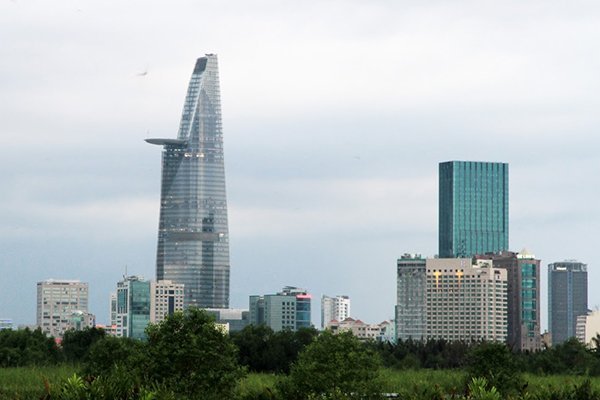 The retail space markets in HCMC and Hanoi City had stable supplies in the second quarter of this year, according to a recent report by leading global real estate services firm Cushman & Wakefield. A well-controlled consumer price index, sustained foreign direct investment, global economic integration and an improved business environment were the important factors driving the economic growth of Vietnam, according to the firm. The recent signing of the Comprehensive and Progressive Agreement for Trans-Pacific Partnership is expected to bring many economic benefits to the country by strengthening investment and promoting exports. In the second quarter of this year, the supply of retail space in the HCMC realty market remained stable but reflected a significant increase of 8.2% year-on-year, standing at roughly 1.24 million square meters. Performance improved slightly, up by 1.7% quarter-on-quarter and 1.1% year-on-year. In addition, the overall average rent remained stable in both quarters of the year, reaching more than VND1.19 million (US$51) per square meter per month. The central business district (CBD) remained the most expensive location, triple the rate of other districts and double the average rent. Meanwhile, in Hanoi City, the opening of two new shopping centers and retail podiums in the second quarter resulted in a significant increase in the total retail stock by 4.8% quarter-on-quarter and 7.3% year-on-year. The overall occupancy rate still trended upward, with high absorption, mainly due to new projects demonstrating solid performance. The average rent showed a marginal decrease by 2% quarter-on-quarter and 0.3% year-on-year, mainly due to low rents being offered by new projects in non-CBD areas. The retail space in the CBD was priced at more than double the average rent in the secondary submarket, and four to five times those in the western and suburban submarkets of Hanoi. Jan-July rice exports near US$2 billion 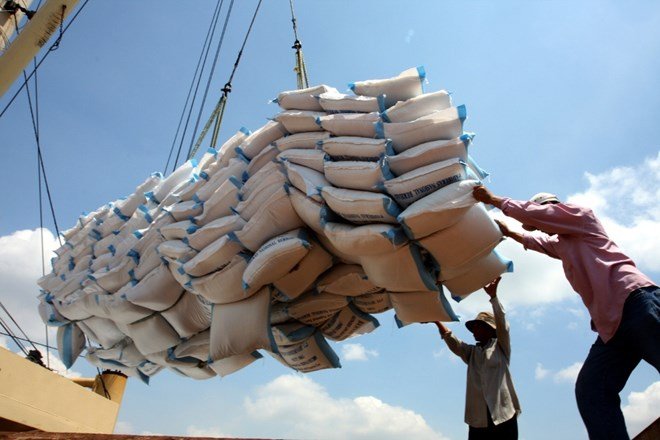 Vietnam’s rice exports in the January-July period amounted to 3.865 million tons worth nearly US$2 billion, up 12.8% in volume and 32% in value year-on-year. Last month saw an export volume of 382,000 tons of rice and a turnover of US$196 million. These good results are attributed to the high export price of Vietnam, at US$30-40 per ton higher than that of Thailand. According to the Vietnam Food Association, dried paddy in the Mekong Delta region is priced at VND5,650-5,750 per kilogram. Meanwhile, the prices of long-grain paddy, grade-one rice material for 5% broken rice and rice material for 25% broken rice are VND6,100-6,200, VND7,250-7,350 and VND7,150-7,200 per kilogram, respectively. Supplies are increasing amid harvest time in the Mekong Delta region, while demand is low now. Demand for rice is expected to pick up in the fourth quarter. Cuba, Iraq, Indonesia, the Philippines and Malaysia -- Vietnam’s five traditional markets -- may import 3-4 million tons of rice. China and Africa may also have demands for more rice in the rest of the year. However, rice shipment to Malaysia will decline against early this year, and the Philippines will mostly import via the minimum access volume scheme. Bangladesh may buy some 700,000 tons of rice this month, with 400,000 tons potentially sourced from Vietnam. Vietnamese firms deliver 60,000 tons of rice to Cuba and 30,000 tons to Iraq each month. China remained the top importer of Vietnam’s rice in the year’s first half, at 1.133 million tons, 1.115 million tons of which were exported through official channels. The shipments were also strong to Africa, at 537,000 tons; the Philippines, 429,000 tons; Indonesia, 776,000 tons; and Malaysia, 305,000 tons. According to Nguyen Trung Kien, board chairman and general director of Gentraco, though China accounts for a large volume of Vietnam’s rice exports, there are technical barriers against exports to this market. Vietnamese firms thus need support to produce quality products that meet high market requirements. US$470m needed for 25 traffic infrastructure projects 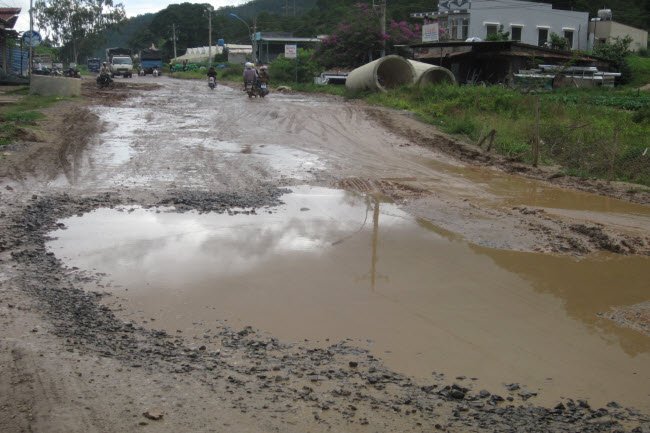 Twenty-five traffic infrastructure projects across the country have come to a standstill due to financial hardship. They need an additional VND11 trillion, or more than US$470 million, to resume construction, according to the Ministry of Transport. The projects include a section of National Highway 37, running from Vinh Bao in Haiphong City to Gia Loc in Hai Duong Province; National Highway 4A connecting Lang Son Province to Cao Bang Province; National Highway 12 in Dien Bien Province; and a section of National Highway 91 passing through Tien Giang Province. Data from the Planning and Investment Department under the ministry show that among the 25 projects, some fall short of VND1 trillion each. Nguyen Duy Lam, head of the department, noted that the demand for traffic infrastructure projects, at some VND952 trillion, has risen sharply in the 2016-2020 period, while the available financial resources only meet some 30% of the demand. According to the medium-term public investment plan of the Government, some VND120.7 trillion of the State budget, which was allocated to the ministry, only partially meets the demand to pay off liabilities. In the coming days, the ministry will receive backup funding of VND15 trillion from the Government for the 2016-2020 period, but this capital volume is earmarked for 14 key road and railway projects, Lam added. The transport ministry has assigned the department to evaluate the financial needs of the projects, so that it can propose the Government to raise the backup funding to facilitate the 25 suspended projects. Vina Chuoi receives funding of more than VND2 billion Vina Chuoi, a startup specializing in foods and beverages made from bananas, received funding of VND2.3 billion (US$98,900) from two investors on reality TV show Shark Tank, which was broadcast on the evening of August 1 on the VTV3 channel. Shark Dung Nguyen, investment director and head of the Vietnam and Thailand offices of CyberAgent Ventures, Inc., and Shark Viet, chairman and general director of Infrastructure Investment and Transportation Construction JSC (Intracom), jointly invested in Vina Chuoi in exchange for a 51% stake in the startup, offering to solve its financial crunch. The investors will consider putting in an additional VND1.3 billion based on the startup’s business performance. In addition, Shark Nguyen will assign supervisors to follow up on the operations and expenses of Vina Chuoi. Once the business becomes successful, Shark Dung will hand over complete ownership to founder Pham Nhu Can. Vina Chuoi has two selling points in central District 1 in HCMC and simultaneously operates an online business by cooperating with the online food sales channel of Foody. Its revenue in the first half of the year exceeded VND950 million, of which the profit accounted for 47.5%. The company sells some 450 bananas every day. Can has high hopes for his thriving business, stating that the additional funding will help the company open more stores and optimize its food-processing systems, such as frying banana cakes or making banana smoothies. The startup reportedly has its own secrets regarding flour-mixing technique. Its black Siamese bananas are imported from Tien Giang, while the frying machinery was bought overseas. In the same episode of the show, another project, named Tokai, received VND12 billion from Shark Viet in exchange for a 51% stake. The startup will offer houses on lease and exploit abandoned houses, also known as “ghost houses,” in Japan. Tokai founder Ha Canh targeted VND15 billion in revenue in the first year of operations, VND28 billion in the second year and VND46 billion in the third. She noted that in the first four years of business, Tokai will offer 70 rental houses to Vietnamese people traveling to Japan, adding that she expected the annual profit to reach 25%. Long An weighs building thermal power plant Power Engineering Consulting JSC 2 (PECC2) has recommended that Long An Province build a coal-fired power plant, as it is considered more cost-effective. Meanwhile, local authorities want to construct a liquefied petroleum gas (LPG) plant for power generation, according to Le Minh Duc, director of the provincial Department of Industry and Trade. Though the province wants to build a diesel-fired or LPG power plant to generate electricity, which will become a big-ticket project, the consulting firm PECC2 prefers the option of using coal, said Duc. He also cited statements from the Ministry of Industry and Trade as saying that if the province does not build a power plant running on coal, the ministry will order a halt to this project, as its planning has consumed much time. The local government will announce final results of a meeting on the thermal power plant project in Long An, held on the morning of August 2, and then submit them to the provincial Party Standing Committee for further discussion before reaching a conclusion, Duc noted. The province was permitted to build a thermal power center in Can Giuoc District, comprising two plants, Long An I and Long An II, with a total capacity of 2,800 megawatts and total funding of up to US$5 billion, according to Le Anh Tuan, deputy head of the Institute of Climate Change Research at Can Tho University. However, none of the projects have yet to begin construction due to strong objections from local residents in the province, as well as in neighboring HCMC, as once a thermal power plant is put into operation, it could cause severe impacts on human health and their livelihoods, along with the environment and other economic sectors, said Tuan. Additionally, a coal-fired power plant will cause invisible damages to society in the long run, including environmental pollution, which will diminish agricultural production, tourism revenues, and other fields. Tuan cited other major consequences, saying that if those drawbacks are included when evaluating the plant’s total investment capital, the funding will no longer be as low as estimated by PECC2. Property market in coastal areas slows down  The coastal property market is experiencing a sharp decline in both supply and liquidity in most localities known for tourism and seaside resort properties, such as Danang, Nha Trang, Quang Ninh and Phu Quoc, according to a report by the Vietnam Association of Realtors. Sai Gon Giai Phong newspaper cited a report by the Ministry of Construction at a forum on the property market in Hanoi on August 4 as saying that tourism properties have been developed in both coastal and non-coastal localities. These properties are diverse and available in different forms, such as hotels, condotels, shophouses and resorts. Since 2015, the Ministry of Construction has conducted preliminary evaluations of many projects with some 25,000 condotel and officetel units, in addition to thousands of units assessed by localities. According to experts, the influx of nearly 13 million foreign tourists last year is a good driving force for the development of the coastal tourism property market. More than 12,000 resort apartments were built in Nha Trang City in three years, with an absorption rate of 80-85%. However, transactions in the new market dropped significantly in the first half of this year, and there were very few condotel transactions in the second quarter. Nguyen Manh Khoi, deputy head of the ministry’s Real Estate Market and Housing Management Agency, warned that investors should be cautious of fluctuations in the market. One of the factors blamed for the market’s decline is profit commitments. A pledged rate of return at 12-15% is difficult as room rates are not always high, making it hard for project developers to fulfill their commitments to their clients. Besides this, regulations that protect the rights of customers are not clear enough. Some localities have halted investments in condotel projects to wait for a legal framework, according to Khoi. The vice chairman of the Vietnam Real Estate Association, Nguyen Manh Ha, stressed that property developers and individual investors need to be more professional and should understand investment models and efficiency. Business associations and management authorities should seek accurate analyses and evaluations to ensure the sustainable development of the coastal tourism property market, he added. However, the ministry representative revealed that regulations on seaside tourism investments in the future will be clearer so that the growth potential of the market can be exploited in the long term. State to collect over VND500 billion from Petimex IPO The State will collect an estimated VND509 billion from the transfer of a 35.4% stake in Dong Thap Petroleum Trading Import Export Co. Ltd. (Petimex), whose initial public offering is scheduled for September 7, the Hochiminh Stock Exchange (HOSE) said. Local media cites an announcement from HOSE as saying over 48.04 million shares, equivalent to a 35.4% stake, in the oil trader will be auctioned on the southern bourse, with the reserve price set at VND10,600 a share. With such an expected share price, the Dong Thap-based State-owned company has been valued at VND1,437 billion. Under the company’s equitization plan approved by Dong Thap government, the State will still hold the majority stake of 64%, while 747,600 shares, equivalent to 0.55%, will be sold to the company’s employees. Of the remainder, 15% will be offered to strategic investors, while 20.45% to outsiders. Interested bidders will have to place a deposit from August 13, and the auction will take place at 9 a.m. on September 7. Petimex, established in 1992, mainly trades in oil products, ranking fifth among 30 key oil traders of the country, according to VnEconomy. The company operates a network of over 1,500 filling stations. In 2017, the company gained an after-tax profit of VND72.4 billion on revenue of nearly VND11,500 billion. The return on equity ratio was 9.1%. Under its equitization plan, the company expects this year’s revenue to ebb slightly to VND11,300 billion, but its net profit is estimated to rise to VND80 billion. Vietnam’s import-export turnover hits $264bln in first seven months According to the Vietnam Customs, import- export revenue in the first seven months of this year reached $264.3 billion, a year-on-year rise of 12.7 percent. In July alone, export turnover hit $39.3 billion, up 1.1 percent from June. Specifically, value of export was estimated to reach $19.5 billion, a decrease of 1.7 percent against the month before while import value was $19.8 billion, an increase of 4 percent compared to June. In the first seven months, export and import values were estimated to be $133.7 billion and $130 billion respectively, posting a year-on-year hike of 15 percent and 10 percent respectively. Generally, the country’s trade deficit in July was $300 million while trade surplus was $3.1 billion. Ben Tre: First-ever safe farm product cooperative put into service The Mekong Province of Ben Tre yesterday put into service its first-ever safe farm product cooperative with an aim to supply clean agricultural products to consumers. The cooperative covers an area of 1,000 sq. meters at Chau Thanh town, Chau Thanh district with total investment capital of up to VND 1.6billion contributed by 100 members. The cooperative has linked with other cooperatives, local farmers to buy about 7 tons of clean agricultural products per month to provide to consumers in the province and neighboring provinces. Chairman Truong Duy Hai of Ben Tre Province People’s Committee said the cooperative will help link between clean producers, farmers and consumers. The province targets to develop this model in the hope of ensuring safety for consumer health. Hanoi exempts fees for household businesses being converted into enterprises Household businesses in Hanoi that are filing to become enterprises will be exempt from registration fees from August 1 to December 31, 2018, according to the city’s Department of Planning and Investment. Under the support programme, new enterprises established from household businesses will not have to pay the fees to announce their registration, in line with a government decree guiding the implementation of the Law on Support for Small and Medium-sized Enterprises. The waived fee is VND300,000 for each enterprise. Household businesses-turned-enterprises will also be provided with other support, including the fees to make their seals and deliver their registration certificates. The government is encouraging household businesses to switch to enterprises in order to realise the goal of having one million enterprises by 2020. Last year the Law on Support for Small and Medium-sized Enterprises was approved by the National Assembly and came into force on January 1 this year. Green asparagus offers high profits for Ninh Thuan farmers 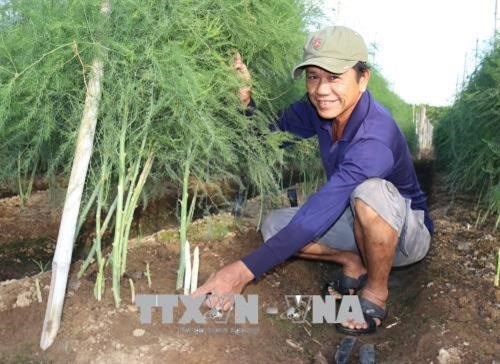 Farmers in the south central province of Ninh Thuan are growing more green asparagus as the vegetable is offering higher profits compared to other crops. Diep Bao Thu, who shifted from growing grapes to asparagus on his 2,000 sq.m farm in Ninh Hai district’s Xuan Hai commune last year, now harvests about 18 - 22 kilo of asparagus shoots a day. He sell the vegetable for 50,000 – 90,000 VND (2-4 USD) a kilo and earns a profit of more than 1 million VND (44 USD) a day during the harvest. Vu Van Thuan, who has grown asparagus on his 4,000sq.m land plot in Xuan Hai for four years, said the cost for 1,000 sq.m of asparagus was about 15 million VND. The asparagus plants are harvested for five to seven years, he said. “Green asparagus can be harvested continuously for three months, and then is stopped for one month to help the plant recover,” he said. Previously Thuan planted grape, jujube and spring onion on his 4,000sq.m land plot but the profit was not high. The province’s dry, hot weather and loamy sand are suitable for growing green asparagus, according to local farmers. Ninh Thuan has the least rainfall compared to other provinces and cities in the country. Nguyen Dinh Thi, Vice Chairman of the Xuan Hai Commune People’s Committee, said that green asparagus had provided high profits for farmers for a number of years. The profit is five to seven times higher than that of other crops, he said. The commune has 110 households planting a total of 21.5 ha of green asparagus, but supply has not met demand, he said. Ninh Thuan authorities have encouraged farmers to expand the area under asparagus in drought-prone areas. Local authorities also provided advanced farming techniques to asparagus farmers in recent years. In 2016, the province’s Farmers Association started a project to grow green asparagus under Vietnamese Good Agricultural Practices (VietGAP) standards in Ninh Phuoc district. The quality and yield under the project was 10-20 percent higher than from traditional farming. Early this year, the province’s Department of Science and Technology transferred the technique of using drip irrigation to asparagus farmers. The technique was first used by four farmers at the Tuan Tu Agricultural Services Cooperative to plant 1.4 ha of green asparagus in An Hai commune. Hung Ky, director of the Tuan Tu Agricultural Services Cooperative, said previously asparagus shoots were often infected with fungus when spray irrigation methods were used. The use of drip irrigation has helped solve the problem, he said, adding that farmers in other areas have visited the cooperative to learn about the technique. The province has more than 100ha of green asparagus, mostly in Ninh Hai and Ninh Phuoc districts. The province will develop asparagus areas with advanced farming techniques in a zone of 200ha in Ninh Phuoc and Bac Ai districts. The province’s asparagus shoots are sold in the province and to HCM City, Hanoi and Da Lat city and other provinces. The vegetable was first planted in the province’s Ninh Phuoc district eight years ago. Thaco sets foot in agriculture 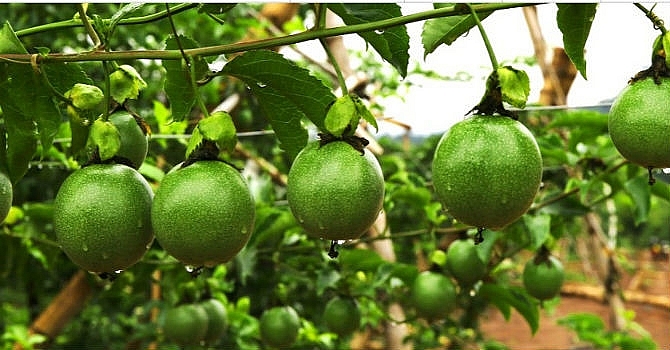 Spending approximately VND2.2 trillion ($97.3 million) buying convertible bonds from Hoang Anh Gia Lai Agricultural JSC (HAGL Agrico) will help Truong Hai Auto Corporation (Thaco) set a solid foothold in the agricultural sector. According to information published by HAGL Agrico, the company issued a decision to sell 221,688 convertible bonds worth VND10 million ($428) each to Thaco for VND2.2 trillion ($97.3 million). With the ratio of 1:1,000, Thaco can convert these bonds into 221.688 million shares after one year. HAGL Agrico will use VND1.137 trillion ($50.3 million) of the capital acquired to invest in growing banana and chili, and the remaining VND1.08 trillion ($47.78 million) to restructure its operations. Thaco teamed up with Loc Troi Group to develop the “Industrialisation of agriculture and operation of enclosed chain of manufacturing, harvesting, processing, transporting, and distributing." The total investment is about VND7.8 trillion ($345.1 million) and will include developing agriculture (about 310 hectares), construction of ports and specialised transportation system by waterway and the construction of a farm system (large sample field) on about 340 ha in the first phase. In January 2017, Thaco held a signing ceremony to cooperate in producing and distributing agricultural machinery with LS Mtron Company, the largest agricultural machinery manufacturer in South Korea with 40 per cent of the market share. The factory, located in the Chu Lai-Truong Hai Automobile Mechanical Complex at Chu Lai-Truong Hai Open Economic Zone in Quang Nam province, has a total investment capital of VND500 billion ($22.1 million) and will manufacture 18-120HP agricultural tractors and harvesters, and has a designed capacity of 2,000 tractors a year in the first phase, 3,000 cultivators, and 1,000 combine harvesters. According to the agreement, LS Mtron has been transferring tractor manufacturing technology and training Thaco’s engineers to localise tractor component production to reach a regional value content (RVC) of 50 per cent. Machinery and equipment will be produced by Thaco with advice from LS Mtron and some test equipment imported from South Korea that cannot be produced in Vietnam, such as speed test equipment, lift test equipment, and power take off (PTO) equipment. In this February, the factory officially came into operation after one year of construction. Reed Tradex launches new alliance to promote supporting industries Reed Tradex, the organiser of METALEX Vietnam, has announced a new alliance aimed at driving the development of the Vietnamese supporting industries. Reed Tradex has recently unveiled its alliance with Japan External Trade Organisation (JETRO) in Ho Chi Minh City, Investment & Trade Promotion Centre (ITPC), as well as Ho Chi Minh City Centre of Supporting Industries Development (CSID) to co-organise the "Supporting Industry Show 2018” in Vietnam in October. Suttisak Wilanan, deputy managing director of Reed Tradex, expressed his optimism about the exciting rebound of the automotive industry in Vietnam, citing the Vinfast “Made in Vietnam” automobiles, which has decided to cooperate with Italy’s leading design firm Pininfarina and German luxury car company BMW. At the same time, Thaco also inaugurated the biggest and most modern automobile manufacturing factory in Southeast Asia last March, with a view to dominate the automobile industry. “More than ever, car firms need to support and call on supporting industry businesses to supply the necessary components," he insisted. "There are over 30,000 parts in a vehicle, it is almost impossible to manufacture all components in the same country. That is why investors tend to establish factories in neighboring countries, surrounding their manufacturing base. Vietnam is in a strategic location, located in the centre of ASEAN, with many major seaports. Therefore, Vietnam can coordinate with key players like Thai and Indonesian car makers to set up a sustainable development cluster for the automobile industry." According to data from the Ministry of Industry and Trade, the total number of enterprises currently involved in the supporting industry sector is 661. However, only a few domestic enterprises are capable of joining the supply chains of foreign companies. Therefore, the new alliance is expected to empower the transfer of new technologies and the expansion of business networks between Japanese and Vietnamese businesses, which are vital to sharpen the competitive edge of the supporting industry. Takimoto Koji, chief representative of JETRO in Ho Chi Minh City, shared that, “Vietnam’s local procurement ratio was 33.2 per cent in 2017. It is the lowest among the six countries in the survey. With the “Supporting Industry Show 2018,” we aim to raise the local procurement rate by connecting companies at the exhibition.” To create “win-win relationships” between Japan and Vietnam at "Supporting Industry Show 2018,” there will be 18 Japanese major companies joining as buyers. Another 30 Vietnamese companies will exhibit as suppliers, lead by ITPC and CSID. The "Supporting Industry Show 2018” will be organised on October 11-13 at Saigon Exhibition and Convention Centre. At the same time, “METALEX Vietnam 2018" will gather and introduce 500 brands of the latest machine tools and metalworking solutions from over 25 countries. The exhibition is expected to be more comprehensive with the co-location of “NEPCON Vietnam 2018” which will be a platform for electronics manufacturers to meet with providers of technologies and solutions from 200 brands of 20 countries. Technological application crucial to agriculture Technological application and improved management are necessary to ensure high economic efficiency and sustainable development of agriculture amidst widespread global integration and changing climate. Experts have said automatic and semi-automatic technologies used in agriculture have contributed to increasing output and ensuring food safety. Information technology is instrumental in overseeing, directing and forecasting agro-forestry-fisheries production while biotechnology helps choose high-yield varieties and breeding animals. Technological advances are being adopted to grow flowers, vegetables and raise fowl, cattle and aquatic products in Lam Dong, Kien Giang, Bac Ninh, Vinh Phuc, Ha Nam and Nghe An. Vietnam is now home to 35 high-tech agricultural areas and five high-tech intensive farming areas for shrimp, flowers and rice which have been recognised in Kien Giang, Lam Dong, Phu Yen and An Giang provinces. There are 12 high-tech cultivation enterprises, 19 others in aquaculture and nine in animal husbandry that use modern technology nationwide. The Vietnam Young Entrepreneurs Association’s Digital Agriculture Association (DAA) called for building a sustainable, stable and effective master plan for key agricultural products, from planning to policies, incentives and trade promotion. Luong Van Tu, Chairman of the Vietnam Coffee - Cocoa Association, said to increase the value of coffee beans, firms must invest in roasted, ground and instant coffee and other processed products, so they need mid and long-term credits at reasonable rates. Minister of Agriculture and Rural Development Nguyen Xuan Cuong suggested offering incentives for imported technologies, improving technological expertise at home and facilitating the transfer and purchase of patents. He urged facilitating agricultural firms’ access to loans, developing start-ups and building high-tech incubators, targeting young people and individual business households to inspire their start-up spirit. To master technological advances, he stressed the need to improve skills of technical and governance staff, tertiary education and vocational training quality. VNN |
↧
Article 1
Social News 10/8 Hanoi advised to replan urban zoning to ease traffic pressure 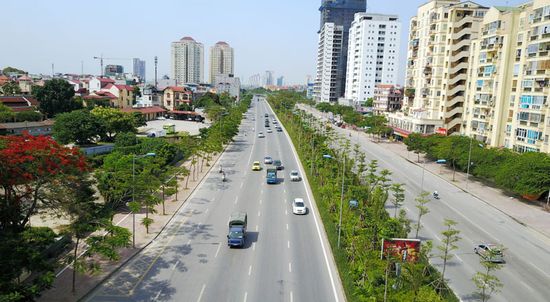 Ring road 2 will reduce traffic load in the center of the capital. Traffic congestion is one of the biggest challenges facing Hanoi, especially in the inner city. Hanoi should focus on strategic planning, including redesigning urban zoning to give more space available for traffic which has become much heavier since the city's administrative boundary expansion ten years ago, experts have said. Transport expert Nguyen Manh Thang analyzed that when the boundaries were expanded, Hanoi’s land fund becomes larger, but the population and means of transport also swell. Ten years after the expansion of administrative boundaries, Hanoi's area has increased more than three times, its population has exceeded seven million and there are nearly six million means of transport in circulation in the city. Besides, a large number of migrants and vehicles from neighboring provinces add pressure on the city's road network. Land, human resources, economy are the conditions to rearrange the space, urban architecture, traffic development, but the results are still limited. Meanwhile, the impact of population growth and transportation growth has become a headache in Hanoi, said Thang. Given narrower land fund, Hanoi needs to aim to develop underground space and stretch the traffic density outside the city’s center to reduce traffic pressure, Phan Truong Thanh, an expert in urban management, suggested. To radically solve the traffic jam problem, Hanoi should combine the two groups of "hard" and "soft" solutions, Thanh said. "Soft" solution is to use both administrative and economic measures to curb the rise and gradually reduce the use of personal vehicles, while encouraging dwellers to use public transport, Thanh added. Restriction of personal vehicles not only helps increase the traffic space, but also limits traffic congestion and protects the environment, Thanh emphasized. In addition, there should be solutions to redesign the overall architecture, expand the traffic space through the reduction of urban density by encouraging people to move to the suburds, Thanh said. Thanh identified that Hanoi can exploit urban land fund for transport in two directions. Firstly, for the inner areas, the city should focus on exploiting underground space with investment, construction of subway lines, underground parking lots. Secondly, Hanoi should quickly complete the relocation of some headquarters of agencies, departments, schools, hospitals out of the city center. Many experts also noted that the city needs to quickly establish satellite towns with technical and transport infrastructure that is capable of meeting trade, internal and inter-regional connectivity. These satellite towns play important role in both even distribution of population density and transport load reduction. They also have stimulated synchronism and parallel development between the inner and outskirts of Hanoi, according to experts. After the ten-year expansion, Hanoi has made strong breakthroughs, reaching the scale of a civilized and modern city. However, to sustainably develop, it is necessary to inevitably solve the issue of traffic jam, expand the traffic space, connect well from inside to outside, contribute to boosting socio-economic efficiency, experts stressed. US helps Vietnam strengthen readiness to tackle nuclear incidents  The US experts instruct practitioners to use radioactive detectors. Guided by US experts, the response forces for nuclear incidents in Vietnam’s central provinces have been trained in knowledge and skills to deal with nuclear radiation incidents. Vietnam’s Department of Radiation and Nuclear Safety under the Ministry of Science and Technology, the US’s Department of Energy in collaboration with Da Nang city’s Department of Science and Technology on August 6 organized a training course to help forces in Da Nang and other central provinces better cop with nuclear incidents. The training course on radiation treatment solutions and emergency radiological assessment focused on lost radioactive sources or uncontrolled radioactive sources and materials, according to the government portal. Uncontrolled nuclear material is a particular concern in causing irradiation to the public or used for bad intentions, criminal actions, even terrorism. The training course includes lectures, demonstrations, practical training and field work with radioactive detectors and low radioactive sources. During the training session from August 6 to 10, trainees from the Steering Committee for responding to nuclear radiation nuclear accidents, large-scale radiation facilities in Vietnam’s central provinces will be equipped with basic knowledge of radiation, nuclear and radiation security threats, control and direction, personal protective equipment, radioactive contamination detectors and methods of radioactive source recovery. A team of experts from the US Department of Energy has provided the training course with more than 40 radionuclide detection and response systems, including personal devices, equipment on automobiles, radioisotope identification equipment and health physiological equipment. Jaipur Foot Artificial Limb Fitment Camp opened in Phu Tho 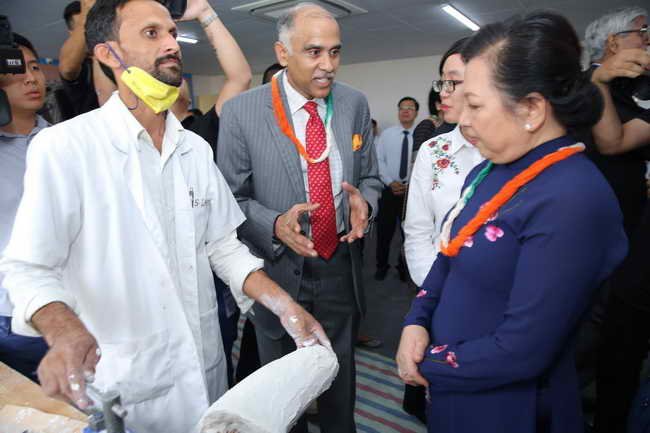 Representatives of the Embassy of India in Vietnam, BMVSS and Phu Tho Province visit the Jaipur Foot Artificial Limb Fitment Camp after the opening ceremony The Embassy of India in Vietnam and the Jaipur-based non-profit organization Bhagwan Mahaveer Viklang Sahayata Samiti (BMVSS) have launched the second phase of the Jaipur Foot Artificial Limb Fitment Camp in Phu Tho Province. The opening ceremony was attended by Indian Ambassador to Vietnam Parvathaneni Harish, Vice President of Phu Tho Province People’s Council Duong Hoang Huong, and representatives of the provincial departments of Health, Foreign Affairs, and Labor-War Invalids-Social Affairs. According to Duong Hoang Huong, the project is implemented under the India-Vietnam Joint Statement issued during Vietnamese President Tran Dai Quang’s visit to India in March 2018. He asked the provincial Department of Labors, Invalids and Social Affairs, the Department of Foreign Affairs, Phu Tho Province General Hospital and related departments and units in the province to closely coordinate with the Embassy of India and the sponsors to successfully organize the artificial limb fitment camp. Speaking at the opening ceremony, Indian Ambassador Parvathaneni Harish said the idea of organizing those fitment camps for the disabled was raised up and supported by Vietnamese first lady Nguyen Thi Hien when she visited the Jaipur Foot Center of the BMVSS and expressed her desire to have the same camp in Vietnam. Parvathaneni Harish said the Indian Government is very happy when Vietnam becomes the first foreign country to have the Jaipur Foot Artificial Limb Fitment Camp under an agreement signed by the Ministry of Foreign Affairs of India and BMVSS in November 2017. In the first phase, 267 people with disability had benefited from the project. In this second phase, over 500 people with disability will be provided with artificial limbs, and Phu Tho Province General Hospital has been selected as the field site for the fitment camp. In addition to providing equipment, technicians, doctors and medical staff during the 20-day camp, the hospital will be responsible for organizing and monitoring periodic health check-ups for the people who get prosthesis in the camp. Founded in 1975, BMVSS is now the world's largest organization for the handicapped in terms of fitment of artificial limbs and calipers. BMVSS has rehabilitated more than 1.55 million amputees and polio patients by fitting and providing artificial limbs, calipers, and other appliances, mostly in India and also in 27 countries across the world. Australia donates water treatment systems to rural areas  From now on, students at My Hoa 1 Primary School in Dong Thap Province can drink water right from the tap The Australian Government has donated water treatment systems to schools in several remote areas in Dong Thap, Khanh Hoa and Son La provinces to provide safe drinking water to rural communities. The provision of safe water contributes significantly to the realization of the right to education. Children that drink unsafe water are at high risk of getting ill and, therefore, leaving school, according to the Australian Embassy in Vietnam. Specifically, Australia has supported the installation and handover of a water kiosk that will provide clean tap water to teachers and school children at My Hoa 1 Primary School in Thap Muoi District, Dong Thap Province. The system features low-cost technology from Australian companies and the private sector’s participation to deliver clean water to rural communities. The project was facilitated by the Australian Water Association in partnership with the Dong Thap provincial government. The launch ceremony on August 2, 2018 also had an Australian-supported water delegation from Cambodia coming to learn about new technologies that can be applied in the neighboring country. The Australian Government also plays a supporting role in facilitating the exchange of expertise between the Australian, Vietnamese and Cambodian water sectors. The Australian Water Association, with funding from the Australian Government, had earlier piloted the use of SkyJuice ultrafiltration membrane technology in Chieng Mai Commune, Son La Province. Water kiosks which can provide up to 10,000 liters per day have been installed at Chieng Mai Primary School and Chieng Mai People’s Committee community hall to provide safe drinking water to the Chieng Mai population (around 4,700 people). Due to the high construction costs involved with piping water long distances to a small number of customers, it is not easy to provide piped water to rural population in the remote mountainous areas. Rural people usually use non-treated stream water in gravity systems or buy bottled water for drinking. However, water from local streams often doesn’t meet the standard of quality for drinking set by the Ministry of Health. The SkyJuice technology is capable of solving these problems as it is low cost and easy to operate and maintain. Australian technology has also helped improve the lives of teachers and students at Le Van Tam Primary School in Khanh Vinh District of Khanh Hoa Province, where teachers and students at the school had never had access to safe drinking water directly from their taps. This is now made possible thanks to an Australian produced SkyHydrant unit that can treat ground water using chemical-free filtration. International conference held to celebrate 25th anniversary of Rencontres du VN 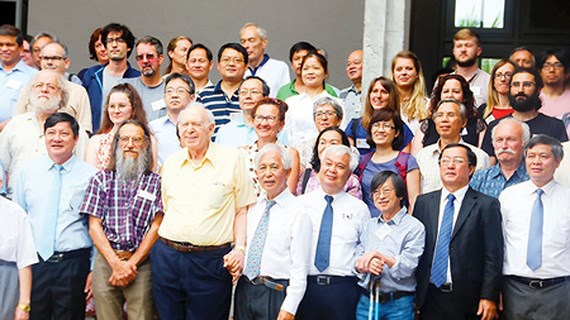 Scientists and young people taking part in an international conference in the ICISE, located in Quy Hoa Valley The international conference ‘Windows on the Universe: 25th Anniversary of the Rencontres du Vietnam’ was held yesterday in Quy Nhon City of the central province of Binh Dinh. The conference was organized by the Rencontres du Vietnam in the International Center for Interdisciplinary Science and Education (ICISE), located in Quy Hoa Valley of the city. On behalf of the Rencontres du Vietnam, Professor Tran Thanh Van reported that in the last 25 years, the organization has held 5 scientific conferences in Hanoi and one in Ho Chi Minh City. Since 2011, it has continuously hosted many more international conferences in Quy Nhon City, welcoming over 4,000 international professors, doctors, and scientists. The main aim of the ICISE is to offer opportunities for scientific exchanges between local scientists and their foreign counterparts. According to Prof. Jacques Dumarchez, representative of the organization board of Rencontres du Vietnam, thanks to the Rencontres de Moriond, he had a great chance to meet Prof. Tran Thanh Van and his wife. Admiring the devotion of the couple for international science and for Vietnamese one in particular, he agreed to contribute to the building of a similar model in Vietnam. Prof. Dumarchez also shared that to help the ICISE reach new heights, they will need to organize more scientific conferences and to welcome more international scientists so that the domestic counterparts can keep in touch with latest knowledge and broaden their horizons. Despite expected difficulties, he insisted that he wholeheartedly supported Prof. Van’s work since it was such a meaningful project. As said by Prof. Dam Thanh Son from Chicago University of the USA, representative of scientists in the field of Particle Physics, since 1993, there have been positive changes in the position of Vietnam in the international ranking chart, signaling a great improvement of physics knowledge in Vietnam. Our country now possesses a fast growing economy, providing more chances for physics students to study abroad. Prof. Son commented that despite the good news, Vietnam still needs more research institutes and universities of international level. The ICISE is an excellent model that offers hopes for a brilliant future for scientific development in Vietnam. Mr. Pham Cong Tac, Deputy Minister of Science and Technology affirmed that in the last 25 years, the Rencontres du Vietnam has enormously contributed to the scientific development in Vietnam. 10 years ago, the nation created a special fund for this development. Recently, the Prime Minister has also approved many research projects on physics, mathematics, and other basic science subjects like chemistry, earth science, ocean science. This means that the Vietnamese government always pays great attention to scientific research and development. Taking part in the event were 180 scientists from 30 nations in the world, including Professor Jerome Friendman from the Massachusetts Institute of Technology, Nobel winner of Physics in 1990. In a related event, the groundbreaking ceremony of the Proscience Hotel was held yesterday in Area 2, located in Ghenh Rang Ward of Quy Nhon City, next to the ICISE. The hotel, invested by Proscience Ltd. Co. with Tieu Nhu Phuong as its representative, will have a surface area of 1.36ha, with 124 rooms. It is designed and consulted by architect Milou from France. The hotel is supposed to be in use in 2020. According to Professor Tran Thanh Van, this is a non-profit hotel to support scientific activities in the ICISE. Binh Dinh Province aims at building scientific –educational urban area 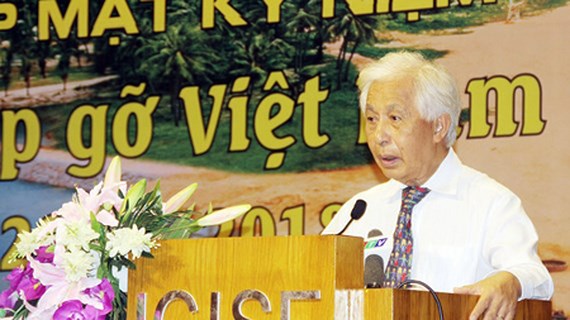 Professor Tran Thanh Van, Chairman of the Rencontres du Vietnam, is delivering his speech at the anniversary The Rencontres du Vietnam cooperated with the central province of Binh Dinh to organize the 10th anniversary of Rencontres du Vietnam in the province. The event was held on August 5 in the International Center for Interdisciplinary Science and Education (ICISE), located in Quy Hoa Valley of Ghenh Rang Ward in Quy Nhon City of Binh Dinh Province. All participants, consisting of domestic leaders, professors, and scientists, reviewed past activities of the organization as well as showed appreciation to Professor Tran Thanh Van and his wife, who have ignited the passion of science in the area. According to Prof. Tran Thanh Van, the ICISE has held 40 supreme international conferences and managed 16 scientific schools. It has welcomed more than 3,500 scientists globally, including 12 Nomel winners, 2 Fields winners, 2 Kavli winners (a high-leveled award in the field of astronomy), 1 Shaw winner, and 1 Kalinga winner. Besides the series of conferences, thanks to its close collaboration with the International Institute of Science, the ICISE has begun constructing the Institute of Scientific Research and Interdisciplinary Education. At the moment, the center has two young research teams on astrophysics, theoretical physics, and neutrino physics. In the upcoming time, the center is going to establish more research groups for other fields. “We have already had stable scientist teams who have strong connections with domestic as well as international networks. It is these people who will feed the fire for a sustainable development of the ICISE”, affirmed Prof. Van. Expressing his special thanks to his spouse, Prof. Le Kim Ngoc, and showing his appreciation to the support from the government and the local authorities in Binh Dinh Province, Prof. Van promised that he and his team will try their best to transform Quy Hoa Valley into one of the most attractive areas for scientific activities in the nation and to make Quy Nhon City the scientific pearl of Vietnam. Mr. Phan Thanh Binh, Chairman of the Culture, Education, Youth and Children Committee, commented that after 10 years, the ICISE has achieved many positive results. He also announced that there was much to do to turn Quy Nhon City into a scientific center of Vietnam where there would be high-quality researches and high-level scientists. He hoped that the area would become a place to professionally train scientists and create a team that can win a Nobel Prize. Chairman of the Binh Dinh Province People’s Committee Ho Quoc Dung showed his appreciation to what Prof. Tran Thanh Van and his wife have done for Vietnamese scientific development. In the near future, the province is planning to transform Quy Hoa Valley into the first scientific – educational urban area of Vietnam. In this 242-ha area, besides the current ICISE, there will be TMA Innovation Park, a software park of FPT Software Ltd. Co., a startup village, an innovative area, a scientific complex with a center for the universe miniature, a center for scientific discoveries, a public astronomical observatory, many scientific research institutes, and a school to train high-quality engineers. Bac Kan province works to digitalise ancient documents of local minority groups 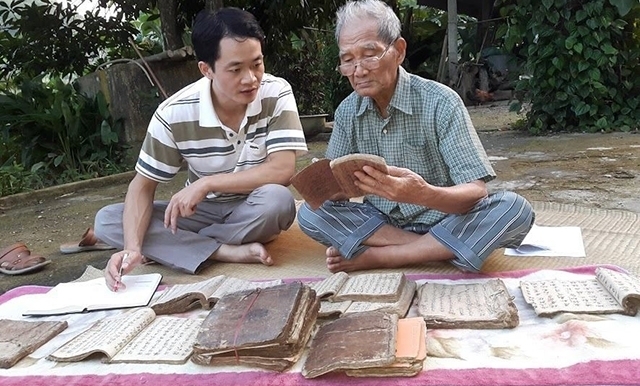 Writer Nong Viet Toai (R) is among few men who can read and thoroughly grasp the contents of ancient documents in Bac Kan province The northern mountainous province of Bac Kan is home to seven ethnic groups, most of them being minority tribes, communities of which have preserved cultural heritages for generations, particularly ancient documents, bibliographies, antiques and relics. Over recent years, the local authorities have taken proper measures to collect and digitise the documents for preservation and promotion. The ancient bibliographies in Bac Kan has been handed down from generations to generations, many of them being hundreds of years old. The documents record the traditional rites of passage, such as the ‘cap sac’ rite, which is held to declare the coming-of-age of Dao men within the community, ceremonies to pray for peace and bumper crops, and funerals. Each ethnic group in Bac Kan has their own bibliography, which are kept in different families as one handwritten copy. The guardians of the ancient documents are elders and patriarchs of the families in the village, who are masters of ancient languages and transcripts and experienced in traditional ceremonies. A majority of the documents were written in Han (Chinese script) and Nom (Vietnamese ideographic script); however, the number of those who are fluent in the scripts is becoming fewer in the village as many of the guardians have grown old and passed away. For example, there is now nobody in Vi Huong commune, Bach Thong district who can read and understand the ancient transcript engraved in the local bell. The family of Be Dinh Giai, an old Tay ethnic man in Bann Nhi hamlet, Bang Lang commune, Cho Don district, now possesses three bibliographies, including a collection of 80 wedding poems, a collection of 100 Then folk songs for ceremonies to dispel bad luck, and Tong Tran – Cuc Hoa and Pham Tai – Ngoc Hoa folk stories, which have been preserved since 1913. According to Giai, his family consider the books a valuable treasure, which reflect the ritual practices of Tay ethnic people, but only the elders can thoroughly understand the contents. Many other ancient documents with a high degree of erudition written in Han and Nom scripts are being preserved by families at remote areas. Trieu Xuan Hoa, a Dao ethnic man in Vi Huong commune, Bach Thong district, is the seventh generation of guardians of ‘Cho Shong’, a book of the Dao people’s ethical lessons. The book teaches the moral standards and code of conduct that Dao people should be equipped with in life, from simple gestures of walking, speaking, and standing to the acts of supporting elders and children. However, as the book was written in Nom script, few people can read it, thus youngsters in the community are less in favour of studying the book, which is now kept for display. Trieu Quang Phuc from Quang Bach commune, Cho Don district worried that most of the men who can read and understand the ancestors’ ancient documents are becoming older, thus the collection and preservation of the documents is necessary to help younger generations learn more about the traditional rituals and practices. Being fully aware of the situation, Bac Kan provincial People’s Committee recently invested VND250 million for the provincial library to collect and digitise the ancient documents in the locality. With sponsorship from the Bill and Melinda Gates Fund, the provincial library has been facilitated with a server, projector, scanners, cameras, 40 computers and peripheral devices to help in taking photos, scanning and digitising the documents. So far, the library staff members have collected 88 objects, and 64 ancient bibliographies with nearly 3,500 pages. The collected documents are of varied materials of cloth, wood, do (poonah) paper, and metal, and are transcribed in assorted languages, patterns and symbols. According to Deputy Director of the provincial library, Mai Thi Nga, further research has been carried out on the origins, practice and development of the customs of ethnic groups in Bac Kan as well as their spiritual and cultural life. The data is formatted and backups are regularly created with digital library software, creating a source of information and communication for future research. The library leaders have also take measures to translate the collected documents to popularise the content of the documents among the public, helping to raise their awareness of the treasured tangible heritages of the ancestors. Waste Land documentary to be screened at The Learning Hub In its fifth Meaningful Movie Night program, The Learning Hub in Hanoi’s Hoan Kiem District will present Waste Land documentary on August 13, from 7:30 p.m. to 10 p.m. Co-directed by Lucy Walker, Karen Harley, the documentary takes viewers to the outskirts of Rio de Janeiro where the biggest landfill site in the world is located. This really looks like an alien landscape, and certainly not a place where anyone would want to visit in any period of time. However, many people have seen an opportunity in the garbage and make a living by sifting through it and finding things which may be of value. The 2010 Waste Land film follows a number of women and men who make a living of the landfill to get a picture of their lives and learn who they are. The star and writer of the documentary, Vik Muniz, wanted to highlight the beauty of the human spirit in times of extreme hardship. Filmed over nearly three years, Waste Land shows how renowned artist Vik Muniz journeys from his home in Brooklyn to his native Brazil and the world’s largest garbage dump, Jardim Gramacho, located on the outskirts of Rio de Janeiro. There he photographs an eclectic band of “catadores” -- self-designated pickers of recyclable materials. Muniz’s initial objective was to “paint” the catadores with garbage. However, his collaboration with these inspiring characters as they recreate photographic images of themselves out of garbage reveals both the dignity and despair of the catadores as they begin to re-imagine their lives. Ticket price for the screening is VND20,000, including some snacks, The Learning Hub announces on its Facebook fan page. Photo contest on Vietnam – Japan friendship kicks off 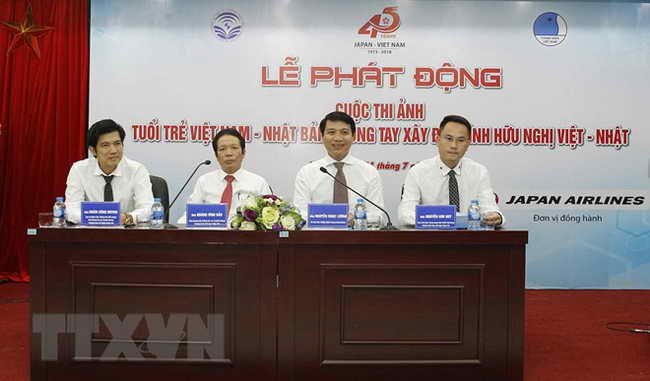 A ceremony is held on July 31 to announce the photo contest On the occasion of the 45th anniversary of diplomatic ties between Vietnam and Japan, the Ministry of Information and Communications and the Central Committee of Vietnam Communist Youth Federation launched a photo contest themed “Vietnamese and Japanese Youths Join Hands in Fostering Friendship” on July 31, 2018. The contest is open to all youths, amateur and professional photographers and reporters from Vietnam and Japan, with an aim to promote young people’s understanding of the bilateral ties and friendship between the two countries as well as give Japanese people a deeper insight into Vietnam’s land and people in the integration process. The photos should capture the solidarity, friendship and cooperation between Vietnam and Japan, diplomatic activities, cultural exchanges, economic and political events taking place in both countries, beautiful images of the land, peoples, customs, and the special cultural characteristics and socio-economic achievements of the two nations. Each photo must have a caption written in Vietnamese and Japanese or English to describe the featured event and characters. Criteria to pick out the best photos include the photo’s content which represents the relationship between Vietnam and Japan, originality, humanistic sense, emotional connection and significant impacts on the society. The contest offers one first, two second, five third and five consolidation prizes with total prize money of VND90 million, according to the Vietnam News Agency. Photos should be sent to the Central Committee of Vietnam Communist Youth Federation office at 64 Ba Trieu Street, Hoan Kiem District, Hanoi and to cuocthianh45namvietnamnhatban@gmail.com no later than September 30, 2018. First plogging event takes place in Hanoi 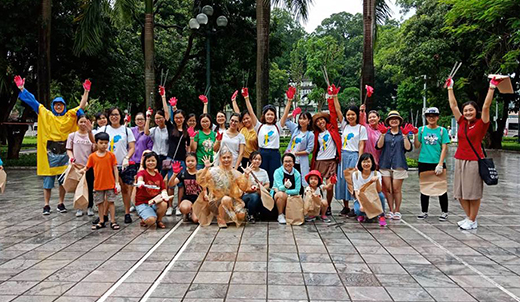 Participants in the first plogging activity in Hanoi. Photo: Swedish Embassy in Hanoi Plogging (jog and pick litter) - a fresh Scandinavian fitness trend - has made its way to Hanoi for the first time. The Sweden Alumni Network Vietnam (SANV) on August 5, 2018 proceeded with the first plogging event in Hanoi despite heavy rain, helping raise awareness of locals in environmental protection. The ploggers passed by a number of streets such as Thanh Nien, Hoang Dieu and Quan Thanh. After that they joined a fika – the Swedish traditional tea-break - at The Bluebird’s Nest café in Dang Dung street, which is one of the first plastic straw free coffee shops in Hanoi, to share their first time plogging experience, talk about plastics and hear some tips to live with zero waste as well as figure out the best way for plastics use. In his message to the participants of the event, Swedish Ambassador Pereric Högberg stressed that it is a brilliant idea to organize the first plogging in Hanoi. “As a committed runner, I have always picked up trash along my running path for about 30 years. What a nice action to keep the sidewalks and public areas clean and tidy for your children, your neighbors or the ones who jog or walk after you and to make Hanoi a better living place for all". Plogging is a combination of “jogging” and “picking” popularly practiced by Swedish exercisers who feel not right seeing trash on their route but not picking up while jogging. Unlike previous garbage picking events, this “rubbish way to get fit” has spread out to other countries in Europe and making its way to U.S and Thailand thanks to social media. Besides the encouragement for fitness activities, this event is to raise awareness of citizens about plastics usage. “We aim to convince people that we must reduce the consumption of plastic bags, single use plastic containers which are excessively disposed into our environment. We can also clean our street, campus by exercising,” said Hao Le, a Sweden alumnus. In April 2018, the first fika discussing organic food was held along with the campaign “7 Day Challenge” launched by the Embassy of Sweden in Hanoi with the United Nations and Live&Learn as partners. SANV wanted to deliver a message to its members to promote organic habit, acknowledge the massiveness of classification around us, in the lake, the river, in the ocean effecting marine life underneath. VNN |
↧
Article 0
Uncontrolled ecotourism threatens sanctuaries, national parks Unreasonable development of ecotourism is threatening the environment, experts say.  Son Tra peninsula, Da Nang Great potential A report from the Department for Special-use Protective Forest Management in 2017 shows that national parks and nature reserves received more than 2 million visitors in 2016, an increase of 178 percent compared with the year before, and total revenue from tourism reached VND114 billion, up by 48 percent. Le Van Lanh, Vice President of the Vietnam National Parks and Nature Reserves Association, cited a report of WWF as saying that Vietnam has great potential for ecotourism because of its biodiversity, rare and endemic species of wildlife, many ecosystems and beautiful landscapes. The report also said that ecotourism products typical of national parks/nature reserves could be developed. These include bird watching tourism (Xuan Thuy, Tram Chim, Ca Mau Cape) and animal watching (Cat Tien, Phong Nha-Ke Bang). Vietnam can also design tours for travelers to see turtles laying eggs, to dive to admire corals (Con Dao Island, Nui Chua, Nha Trang Bay), to watch butterflies and insects, and travel to see frogs and amphibians.
Tourists can also visit the caves at the Phong Nha-Ke Bang National Park, and wetland ecosystems and mangrove ecosystems (Xuan Thuy National Park, U Minh Thuong, U Minh Ha). Lanh said the national parks/nature reserves where ethnic minority people live, together with their cultural characteristics, give opportunities to develop tourism products discovering local cultures in Sa Pa (Hoang Lien), Pac Ngoi hamlet (Ba Be) and Khanh hamlet (Cuc Phuong). Unprofessionalism However, with unprofessionalism, local authorities still cannot take full advantage of the potential, while unreasonable mass tourism projects have threatened ecosystems, which are the foundation for tourism development. The General Directorate of Forestry, which inspected ecotourism activities in national parks/nature reserves in 2017, found that 56 of 61 national parks/nature reserves developed ecotourism businesses though they did not have ecotourism development plans, and 60 of 61 national parks/nature reserves did not have investment projects approved by appropriate agencies. According to Huynh Phuoc, deputy chair of the Da Nang Union of Science & Technology Association, the way of organizing business activities has caused many problems. “The principles of ecotourism are not strictly observed, which destroys the integrity in national parks/nature reserves, and the rights of the next generations to inherit intact assets,” he commented. Meanwhile, Du Van Toan from the Institute of Marine and Island Research, pointed out that the building of roads and cable cars, together with the construction of modern facilities, have divided the national parks/nature reserves into small pieces, thus damaging the habitats of animals. VNN |
↧
Article 2
BUSINESS NEWS IN BRIEF 12/8 Tra fish exports surge in seven months The export turnover of tra fish soared 19.5 percent to 1.18 billion USD in the first seven months of 2018, according to the Vietnam Association of Seafood Exporters and Producers (VASEP). In July alone, the country exported 182 million USD worth of tra fish, representing a year-on-year rise of 13.5 percent. Major consumers of Vietnamese tra fish include China, the US, the European Union (EU), the Association of Southeast Asian Nations (ASEAN), Mexico, Brazil, Colombia, and the United Arab Emirates (UAE). High export growth was seen in the UAE (up 133.5 percent), China (up 45.2 percent) and ASEAN (up 36.5 percent). China remained the biggest importer of Vietnamese tra fish with 290 million USD, up 45.2 percent year-on-year, making up 24.7 percent of the total export turnover for this product. The US came second with 250 million USD (up 11.5 percent) followed by the EU with 137.5 million USD (up 15.3 percent), accounting for 20.4 percent and 11.7 percent of the total figure, respectively. Notably, the UAE surpassed Saudi Arabia to be among top 8 importers of Vietnamese tra fish with 32.5 million USD, recording a considerable growth of 133.5 percent. In 2017, the UAE was the third largest importer of Vietnamese tra fish in the Middle East market with a value of 23 million USD, down 13.2 percent compared to the previous year. However, Vietnam’s tra fish exports to the UAE reversed with a sharp upturn in export value in the first months of this year, with increases shooting up by between 117-221 percent a month since March. The strong growth was attributed to the Saudi Food & Drug Authority (SFDA)’s decision to suspend imports of fish, crustacean and other aquatic products from Vietnam. The temporary suspension was based on the World Organization for Animal Health (OIE)’s "Quarterly Aquatic Animal Disease Report (Asia-Pacific Region) April - June 2017", and the outcomes of the working visit to Vietnam by SFDA in late 2017. Vietnam is the world’s largest exporter of tra fish, making up more than half of the global tra fish output. There is increasing demand for Vietnamese tra fish in Russia, the Middle East, and Asian countries. HAGL Group, THACO ink strategic deal The Hoang Anh Gia Lai (HAGL) Group and Truong Hai Auto Corporation (THACO) inked a strategic cooperation agreement in Ho Chi Minh City on August 8 in the presence of Prime Minister Nguyen Xuan Phuc. Under the deal, THACO will be responsible for the overall restructuring of the HAGL Agricultural JSC with a total investment of approximately 12 trillion VND (514.7 million USD). In addition, THACO and Dai Quang Minh Real Estate Investment JSC, where THACO holds 90 percent of charter capital, will be responsible for the development of Phase 2 of the HAGL Myanmar project in the Southeast Asian nation, with total investment of 320 million USD. The project will be completed by 2020. In his remarks at the event, Prime Minister Nguyen Xuan Phuc said he is delight to see a leading industrial enterprise and a large scale agricultural model of Vietnam shaking hands in a large-scale hi-tech agricultural project. He expected that the cooperation between ambitious leaders of the two companies would help boost the development of agriculture and industry in Vietnam, Laos and Cambodia. He described the collaboration as a new inspiration for domestic companies to innovate, merge and cooperate for development. The PM said he hopes that the agreement will set the model for the application of advanced technology in agriculture, and also the tendency to shift investment flows in agriculture and call on big businesses to invest in agricultural development. Also at the event, Chairman of HAGL Group Doan Nguyen Duc and THACO Chairman Tran Ba Duong presented financial aid to Lao people affected by the Sepien-Senamnoi hydropower dam break last month. – VNA Developing product chains helps boost sustainable export growth 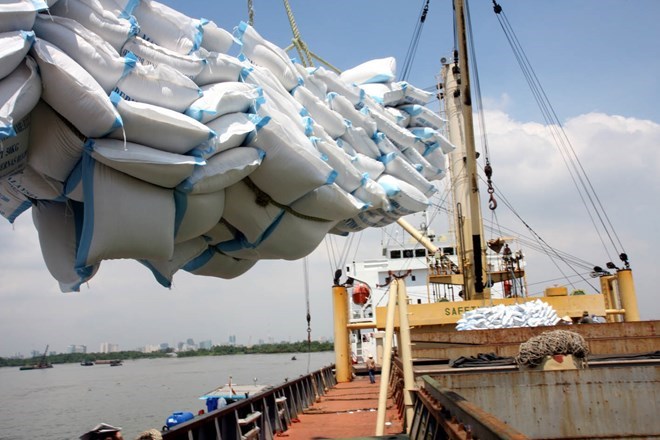 Developing product chains is an important solution to sustainable export growth, heard a conference in Hanoi on August 8. Tran Thanh Hai, Deputy Director of the Import-Export Department under the Ministry of Industry and Trade, said that product chains will help cut out intermediary, reduce goods’ prices, raise the added value, and improve competitiveness. Hai noted that Vietnam’s exports have seen strong growth in both scale and production ability. Total export value recorded a year-on-year rise of 21.2 percent to 214 billion USD last year. Notably, the export situation this year is forecast to have many opportunities for higher growth as commitments for international integration have been implemented, helping reduce import-export tariffs. The efforts of the Government and ministries in administrative reform to provide a favourable business environment have aided export activities, he said. In the first seven months of this year, total import-export turnover reached 264.3 billion USD, up 12.7 percent year-on-year, of which exports were valued at 133.6 billion USD, up 15.3 percent against the same period last year, equal to 56.5 percent of the year’s target. “This has been a bright point in the economy with high export turnover. However, there are shortcomings that pose challenges for the country’s exports,” he added. He noted that protectionism became more common in the first months of the year. In addition, the country’s exports have depended on foreign directed investment (FDI) enterprises, which accounted for 70 percent of total turnover. This was because Vietnam has not had an export value chain, he said. As an example, a representative from the Vietnam Textile and Apparel Association said the country’s garment export value rose from 15.8 billion USD in 2011 to 31 billion USD in 2017, accounting for 4 percent of the world’s total turnover. However, the sector has mainly performed cutting and sewing in the global garment and textile supply chain. Vietnamese garment and textile firms have participated in simple outsourcing and lack the ability to provide packaging, resulting in low added value. The garment and textile industry has also relied on imported materials. The local companies have to import up to 86 percent of cloth for production and exports. A similar situation has been seen in the agricultural sector. Vietnam has high agricultural output. However, most of its products have not been exported widely due to limited processing capacity. Agricultural and seafood products have been mainly exported as raw materials. Statistics from the Ministry of Agriculture and Rural Development showed that the country has 700 agricultural chains certified as safe chains. However, only half of the total operates effectively. Doan Anh Tuan, Chairman of The He Moi Tea Company Ltd, said most Vietnamese firms are small-scale and can not afford to invest in material areas and modern processing and packaging equipment. "Moreover, local firms have not built their own brand names. The Government should have programmes to invest into technologies to create competitive products and take a firm foothold in the international market," said Tuan. Participants proposed the country build agricultural chains through consumption contracts between farmers, co-operatives and businesses to have stable material areas. In addition, it should develop breeds with high output and use science and technologies in farming, harvesting, preserving, processing and consumption. Experts said the support industry could be the foundation for sustainable exports, so the Government should prioritise support industry development for sectors of mechanics, spare pare production, garment and textile and leather shoes. The solutions could be effective if the business community participated, they said. Previously, Prime Minister Nguyen Xuan Phuc approved a plan to improve the competitiveness of exported products in Vietnam to create a legal framework for sustainable exports. The plan aims to increase value of key export staples by 20 percent by 2020. It hopes to gradually increase exports of agricultural and seafood products to the EU, Japan and the Republic of Korea markets in 2016-20 with average growth rate of 8 percent a year. HCM City seeks to improve traceability of agricultural products Ho Chi Minh City is seeking to improve the traceability of agricultural produce sold through both modern and traditional retail channels to improve food safety. By the end of this year, it aims to have all goods sold through modern distribution channels meet VietGap standards, have proper packaging and brands and be traceable through mobile phones, according to the municipal Department of Industry and Trade. The city has been piloting ways to improve traceability of the products since January last year. Cu Chi district’s Phu Loc Agricultural Cooperative has for instance been using QR code stamps, which allow customers to see the entire farming and transportation process. The Department of Agriculture and Rural Development has been organising training classes for farmers and providing them with equipment to upload data about product origin. Binh Chanh district’s Phuoc An Agricultural Cooperative said ever since it began to affix the QR stamps the reputation of its products had been rising. However, Phu Loc has to cope with many challenges: The wide variety of its produce means it requires skilled and meticulous supervisors, while maintaining the systems and restocking stamps are costly. Data entry is not too efficient, with officials having to meet each farmer to collect data while traceable produce is not a priority for many retailers and distributors. The Ministry of Industry and Trade said most traditional markets, which account for most of the food distributed in the country, sell goods whose origins are not traceable and do not keep records or receipts. Phuoc An said many farmers were still struggling to enter data using modern technology, and unstable internet connections in remote areas meant that uploading data could take a long time. Dao Ha Trung, Chairman of the HCM City High Technology Association, said developing a comprehensive database for various vegetables and medicinal herbs and contacting all the provinces that supply produce to HCM City were extremely difficult tasks. The association was working on using affordable technologies to help co-operatives improve their products’ traceability. A representative of GS1 Vietnam, a barcode organisation, said many businesses in HCM City’s wholesale markets used barcodes to keep track of goods sold. However, they did not have a consistent standard for product tracing and it planned to create one, it said. According to a survey by the association, the city’s wholesale markets receive around 2.5 million tonnes of vegetables and fruits from other provinces. After agricultural goods, the city will shift its focus to other foods. Connectivity gives boost to Hanoi's neighboring real estate 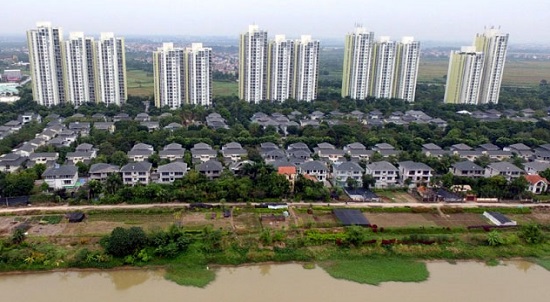 Hanoi real estate market is witnessing a strong shift from the inner city to the outskirts and beyond. Many areas on the outskirts of Hanoi have awaken up and emerged as new real estate spots thanks to the advantage of large land funds and more synchronized connectivity with the inner city. The Ecopark urban area, located in Hung Yen province adjacent to Hanoi, has attracted buyers becasue it spans on a large area and is well connected to the center of Hanoi through new brigdes across the Red river. Ecopark's real estate products are ussualy highly demanded, even at the time the local real estate market was in the doldrums. Representatives of Viet Hung Urban Development and Investment JSC, the investor of Ecopark, said that the attraction of Ecopark stems from not only the green design and synchronous infrastructure, but also from the varierty of products that range from low-cost to high-end and luxury. The success of Ecopark is expected to attract more large developers and create a driving force for the whole region, as the Phu My Hung high-end project in District 7 Ho Chi Minh City did, said the representative. Like Ecopark in Hung Yen province, the real estate market in Vinh Phuc province to the north of Hanoi has become increasingly bustling with a strong increase in both supply and demand. the capital town of Vinh Yen is becoming the center of the real estate market in Vinh Phuc, and holds strong potential for development in the future. According to industry insiders, real estate in Hanoi's neighboring provinces still has large room for development. Besides Hung Yen and Vinh Phuc, Thai Nguyen and Bac Ninh have also caught investors' attention thanks to the presence of hi-tech industrial clusters and giants from South Korea and Japan. In Thai Nguyen, by the end of the second quarter of 2018, up to 3,000 apartments, more than 400 villas, and a large number of land plots were sold. In Bac Ninh province, more than 10,000 landed houses have been developed in new industrial zones and administrative areas such as Bac Ninh, Tu Son, Thuan Thanh, Tien Du, Que Vo, Yen Phong, with the absorption rate reaching 60%. Connectivity in the northern region has become stronger with the government's master plans. The prime minister in 2015 approved the plan for transport development in the northern key economic region until 2020 with a vision to 2030. In May 2016, the prime minister approved the revised zoning plan of Hanoi and its surroundings until 2030 with a vision to 2050. One of the most important goals of the new planning is to provide a basis for the elaboration and adjustment of provincial and regional construction planning along the belt roads, inter-provincial highways, special areas and functional areas, general planning of urban areas, and technical infrastructure planning. Those plans also serve as the basis for the development of urban centers and specialized urban areas that can be a driving force in the region by strengthening the linkage and effective utilization of the ring road system and economic corridors connecting and passing by Hanoi. Vu Dang Dung from the Hanoi Real Estate Club, a member of the Vietnam Real Estate Association, said that the real estate market in the provinces surrounding Hanoi, especially those to the east and south, are benefiting from the infrastructure projects that are well designed and synchronous. “Strategic decisions by the government have facilitated the infrastructure system in general, especially the transport infrastructure that connects Hanoi's crowded center with areas previously thought to be remote. But the most important point is that the regional connectivity strategy has provided an opportunity for the real estate market in the provinces around Hanoi to boom,” Dung stressed. HCMC tightens BT infrastructure investments Following the land fund scarcity in HCMC and a lack of transparency in build-transfer (BT) investment projects, the city government is striving to ensure transparency in these projects and compliance with laws, according to a news report by Dau Tu Tai Chinh. At a meeting on the city’s socioeconomic performance last month, HCMC Chairman Nguyen Thanh Phong noted that the conversion of more than 26,000 hectares of agricultural land into non-farming land will follow a specific roadmap for each year. Phong added that all the information will be made public so that people can monitor the developments. In the past, HCMC has executed several large-scale infrastructure projects under the BT and build-operate-transfer investment formats, such as Phu My Bridge, Pham Van Dong Street, Saigon 2 Bridge, the expansion of the Hanoi Highway and the Tham Luong-Ben Cat wastewater treatment plant. There are now 18 BT projects in the city, with combined investments of VND59.2 trillion, and 130 investors have expressed their interest in cooperating with the State to execute BT projects, with total capital of more than VND350 trillion. According to the HCMC chairman, land sites at prime locations will be auctioned to pool capital for infrastructure projects, even though investors want those sites in exchange for BT investments. Le Hoang Chau, chairman of the HCMC Real Estate Association, stressed that partnerships with the private sector for infrastructure investments help mobilize large sums of capital. However, Chau proposed public and transparent auctions and a restriction on contractor appointments in the case of public-private partnership and BT investments. Under the law on management and the use of public assets, payments in terms of land for BT investors are no longer applicable this year, but many localities have failed to comply. The Ministry of Finance recently ordered localities to stop using public assets to pay BT investors until the Government’s decree on this matter takes effect. According to Phong, HCMC needs significant investments of roughly VND850 trillion during the 2016-2020 period for infrastructure development, while the municipal budget can meet only 20% of the requirement. Private firms hesitant to invest in wastewater treatment projects  The number of private enterprises involved in wastewater treatment projects in HCMC is small, while the city needs at least 12 sewage treatment plants. According to the city’s wastewater treatment plan, approved by the prime minister in 2010, the city aims to develop 12 wastewater treatment facilities: Tau Hu-Ben Nghe, Tay Saigon, Tan Hoa-Lo Gom, Nam Saigon, Dong Saigon, Bac Saigon 1 and 2, Tham Luong-Ben Cat, Nhieu Loc-Thi Nghe, Binh Tan, Rach Cau Dua and Tay Bac. However, only a few plants have been developed and put into operation, mainly using State capital and official development assistance loans. This includes a plant in Binh Chanh District and another in Binh Hung Hoa, with a daily treatment capacity of 141,000 and 30,000 cubic meters of wastewater, respectively. In other parts of the city, untreated wastewater is still pumped straight into canals and rivers. Sewage from districts 1, 3 and 10 as well as from Phu Nhuan, Go Vap and Tan Binh is still pumped into the Saigon River due to the lack of a wastewater treatment plant in the Nhieu Loc-Thi Nghe basin, although a drainage system has been developed there. A consortium of Phu Dien Construction Trading and Investment JSC and Royal International Securities completed the construction of a wastewater treatment plant in the Tham Luong-Ben Cat area in District 12 last year. However, the plant, which has a daily capacity of treating more than 130,000 cubic meters of wastewater, has yet to operate as designed owing to the lack of a drainage system for wastewater collection. Due to the city’s tight budget, the municipal government has called on private firms to invest in five wastewater treatment projects, which will be rolled out under the public-private partnership model. The average investment required for a plant to treat 100,000 cubic meters of wastewater per day is nearly US$200 million. Many investors, including Saigon Real Estate Infrastructure Investment JSC, Saigon Water Infrastructure Corporation, BPA Group and the United States’ Wontert Capital Fund, have expressed interest in the Tay Saigon wastewater treatment project, which is expected to have a daily capacity of treating some 150,000 cubic meters of wastewater and will require funding of VND7.7 trillion (US$331.1 million). A consortium of Hoa Phong Company and Terran Projects Limited and another of Phu Dien and SFC Vietnam, as well as Samsung, have registered to execute the Binh Tan wastewater treatment project with a capacity of 180,000 cubic meters of wastewater per day. According to the HCMC Steering Center of the Urban Flood Control Program, which is in charge of managing wastewater treatment plants, the city has sought investments in these projects since 2012, but many projects have stalled due to complicated administrative procedures and investors’ concern over capital recovery. Some environmental experts noted that investors also pay attention to the time needed for site clearance and resettlement work as these could greatly affect the progress of the projects. Meanwhile, investors proposed the city government promptly publicize the prices of sewage, drainage and treatment services in line with the Government’s Decree 80/2014/ND-CP on the drainage and treatment of wastewater. The agencies advising the city government to approve wastewater treatment projects must have experience in this field of work. In addition, the standards for these projects as well as regulations on the handover of land and on compensation should be clarified, according to interested private firms. The HCMC government plans to hold a conference on August 9 to call for investment in flood control and wastewater treatment projects in the city in the coming years. Diesel up, gasoline unchanged in new price adjustment The Ministry of Industry and Trade and the Ministry of Finance issued a joint decision on fuel price adjustment, which came into effect at 3 p.m. August 7. The retail prices of diesel oil, kerosene and heavy fuel oil went up by VND205-296 per liter or kilogram, while gasoline prices remained unchanged, said local news reports. The prices of RON95-III and bio-gasoline E5 RON 92 did not change. The price of the bio-fuel was maintained at the ceiling price of VND19,611 per liter, while the maximum price of RON95-III petrol reached VND21,177 per liter. Meanwhile, diesel oil 0.05S added VND296 per liter, hitting a new high of VND17,539. The kerosene price picked up by VND205 per liter to reach VND16,379, and the price of heavy fuel oil 3.5S rose by VND257 per kilogram at VND15,013. During this period of price adjustment, local fuel traders are allowed to tap the fuel price stabilization fund at the rate of VND1,194 for every liter of bio-fuel sold, VND554 for every liter of RON95 petrol and VND70 for every kilogram of heavy fuel oil. Petrol prices have remained stable for the second consecutive period this year. On July 23, the prices of the bio-fuel, RON95-III and heavy fuel oil were subsidized by the fund to keep them from changing, while the prices of diesel 0.05S and kerosene had dropped by VND213 and VND69 per liter, respectively. The ministries stated that the fuel price stabilization fund has been continually tapped to minimize the effects of global fuel price hikes on local fuel prices, as well as to help control inflation. Dien Quang Lamp partners with US Qualcomm Dien Quang Lamp JSC on August 7 inked a strategic cooperation agreement with American multinational semiconductor and telecommunications equipment company Qualcomm to provide the local market with lighting solutions and equipment through their smartphone application. Under the deal, Qualcomm acts as a strategic consulting firm that will transfer its technology to Dien Quang and is also a provider of processors, modules and new software, in line with the production orientation of the Vietnamese firm. The two companies will work together to research and produce a central controller for the DQHome solution of Dien Quang. The controller will be equipped with the most advanced processors and modules. It can integrate new technologies such as voice control, image analysis and electronic device adjustment, aligned with users’ habits and environmental conditions. The development of DQHome is based on the needs and habits of the Vietnamese. This solution enables users to connect with and manage their home environment at any time and place through their smartphones, according to Dien Quang. DQHome helps them to control household devices such as lighting systems, TVs, air conditioners and water heaters, individually, in groups or under setup scenarios. Besides this, Dien Quang will employ Qualcomm’s latest technologies, such as Bluetooth 5.0, Mesh Network and Chipset to develop the Dien Quang Apollo solution for smart lighting. This solution helps users to connect with, control and change the colors of their lighting clusters using their smartphones, creating new experiences for context-sensitive and family atmosphere lighting. At the event, Dien Quang also struck an agreement with Amazon Web Services, a subsidiary of Amazon.com that provides on-demand cloud computing platforms on a paid subscription basis. However, they did not disclose the details of the deal. Japan becomes top investor in Vietnam In the first six months, Japanese investor poured US$6.5 billion into projects, accounting for 32 percent of the total FDI in the country. The country sees 1,600 Japanese firms that are operating in Vietnam. Nearly 70 percent of Japanese enterprises plan to expand their business and investment in Vietnam, especially in the fields of trade, high value-added product and consumer goods. Printing and packaging exhibition to be held in HCM City The 18th annual Viet Nam International Printing & Packaging Industry Exhibition (VietnamPrintPack) will be held concurrently with the Food Processing Industry Exhibition from August 20 to September 1 in HCM City. The exhibition features a number of seminars, including a discussion on “Developing 2D and 3D printing applications in the printing industry in Viet Nam” hosted by the Viet Nam Printing Association (VPA). The event will feature 380 exhibitors from 11 countries and territories from Viet Nam, Hong Kong, India, Malaysia, Singapore, Germany, Japan and China, among others. They will include renowned companies such as Riekermann, ACE machinery, J&V Wonder Printing Viet Nam Co., Ltd, Sansin and Uchida The companies will showcase their latest products and technologies, including printing machines and accessories, inks, printing materials, cutting disks, packaging machinery, raw materials, auxiliaries and coding and marking systems. The exhibition is expected to attract more than 15,000 businesses from neighboring countries such as Thailand, Taiwan, South Korea, Singapore, Japan, Malaysia, Indonesia, China and Bangladesh. The show is supported by the Viet Nam Printing Association, Viet Nam Association of Mechanical Industry, Korean Packaging Trade Association, Printing and Printing Equipment Industries Association of China, and others. It will be held at the Saigon Exhibition & Convention Center in District 7. Database on enterprises help prevent commercial fraud, fake goods The Department of Planning and Investment of Đồng Nai Province has created a database of information about enterprises in an attempt to prevent commercial fraud and sale of fake goods. Nguyễn Hữu Nguyên, deputy head of the province’s Department of Planning and Investment, said the database would include information on enterprises’ business licences, activities and violations of regulations. The database is expected to help local agencies quickly find information about enterprises that violate regulations. The province has been struggling to prevent smuggling and fake goods, according to the steering committee on combating smuggling, trade fraud and counterfeit goods. Nguyễn Ngọc Liên, vice chairman of Biên Hoà City in the southern province, said that most enterprises charged with violations were small scale and hard to control. In addition, the procedures to apply for business registration certificates are too easy, and enterprises take advantage of this by changing their legal entity so they can continue to operate after being fined. The province has detected more than 2,100 violations and handled 2,085 of them since the beginning of the year, according to the steering committee. The total amount of penalties imposed on violating enterprises during that period was VNĐ350 billion (US$15 million). Smooth waters for seaside porperty market 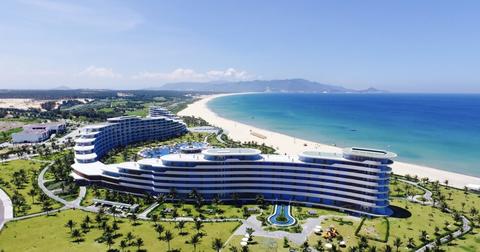 Viet Nam’s seaside real estate market holds great potential for strong growth thanks to its development of tourism industry, impressive economic growth, and the efforts of Viet Nam in improving infrastructures. Han Manh Tien, chairman of Viet Nam Association of Corporate Directors told the Viet Nam Seaside Tourism Real Estate Forum 2018 in Ha Noi on Saturday that Viet Nam had many catalysts for tourism growth. The country has macroeconomic indicators favouring development growth; infrastructure improvements, especially with Phu Quoc and Van Don connected to the national grid; airport upgrades, relaxation of visa requirements, and the rise of the middle class which is becoming a main momentum for growth in the domestic tourism market. “In addition, Viet Nam has a lot of market opportunities, especially when new developers want a piece of the “cake”. The biggest developers are also working directly with the Government to expedite large infrastructure projects, such as metro lines in Ha Noi and HCM City,” he said. Michael Piro, chief operating officer of Indochina Capital said there were nearly 13 million international tourist arrivals last year, 29 per cent higher than 2016 with a five-year compounded annual growth rate (CAGR) of 14 per cent per annum. The highest number of visitors was from China and South Korea with the amount growing. But, he added, Viet Nam should not rely on this too much. The number of domestic tourist arrivals in Viet Nam last year was 73.2 million people, 18 per cent higher than in 2016, with a five-year CAGR of 16 per cent per annum. Viet Nam’s air passenger traffic growth is highest in Southeast Asia, with a five-year CAGR of 17.4 per cent. He said that those factors would greatly contribute to the development of Viet Nam seaside real estate, especially in young Vietnamese markets like Nha Trang, Da Nang and Phu Quoc beach resort markets. In Nha Trang, the average daily rate (ADR) in both four-and five-star properties has remained flat. While demand has continued to increase, the lack of supply of branded properties has hurt the market’s performance. However, occupancy has remained extremely high, reinforcing the potential. However, Viet Nam tourism must also face a number of challenges as overdevelopment is damaging Việt Nam’s pristine beaches. Low-quality resort developments have started to flood the market. Good short-term results do not mean long-term success; therefore, developers need to continually adapt to avoid an outdated resort and create a timeless property. Michael Piro also said that guaranteed returns in Viet Nam are unparalleled; certain developers are offering 8-12 per cent returns over a period of 8-10 years. “No one in the world is offering this level of returns,” he said. This could also suggest poor cash flow management as it is extremely difficult to generate these types of returns organically and cash management is an important aspect of real estate development. Guaranteed returns can be used, but its use should be restrained. Sharing the ideas, Duong Thuy Dung, senior director of CBRE Viet Nam said while Thailand is a giant tourist hub in the region, seaside tourism here still has much room for development. Viet Nam is estimated to attract the most significant amount of cross-border investment for the next 12 months among APEC economies. According to CBRE statistics, real estate products of Viet Nam’s coastal provinces are improving in both quantity and quality, especially in the four famous destinations, namely Ha Long, Da Nang, Nha Trang and Phu Quoc. By 2020, the room stock of hotels, condotels and villas was expected to sharply increase by half to more than 34,000 rooms as in Nha Trang, and even double in Phu Quoc and Da Nang. The hotel segment has shown excellent performance with the occupancy rate all above 60 per cent for four-star and five-star hotels. Resort products, including condotels and villas, also experience a high absorption rate of above 90 per cent. It is estimated that by 2035, half of the Vietnamese population will be middle class, who are both potential investors and major customers for the tourism industry. However, Dung also warns investors about chronic problems of the market. The legality of condotels still lacks consensus, and investors have to cope with such investment risks as profit commitments. Environmental issues are also hard to ignore. Viet Nam’s tourism industry heavily depends on natural landscapes and elements, so environmental degradation like the garbage mountains in Phu Quoc or coastal erosion in Da Nang may put a grim future on these famous destinations. The forum is by Theleader magazine each year aiming to contribute to planning, investment, management and sustainable developments. Tax collection in Can Tho rises nearly 10 percent in six months The Mekong Delta city of Can Tho collected about 5.13 trillion VND (220.3 million USD) of tax in the first half of 2018, up 9.9 percent year-on-year and meeting 51.08 percent of the projected target. As of June 2018, nine among 14 sources of the city’s tax revenues hit at least 50 percent of the year’s estimate. Meanwhile, tax collections from foreign-invested and non-State firms were the lowest at 30.99 percent and 40.61 percent, respectively. The sector will strengthen administration reforms this year to support tax-payers, said head of the city’s Tax Department Vo Kim Hoang. Vice Chairman of the municipal People’s Committee Nguyen Thanh Dung noted that since the beginning of this year, the city has held meetings and dialogues with local businesses to address their difficulties. Local authorities have paid attention to building a clear, transparent and attractive business environment which in turn creates optimal conditions for investors and firms’ operation, as well as improve investment climate and competitiveness, he added. Can Tho has seen robust growth in many areas. Notably, by the end of July, retail sales and services revenue of the city increased 11 percent against the same period last year, Dung said. Can Tho to have more firms to export rice to China The Mekong Delta city of Can Tho will further support local businesses to increase the number of firms eligible to export rice to China, whose demand for the grain is still growing. The remark was made by Director of the municipal Department of Industry and Trade Nguyen Minh Toai at a working session between Can Tho leaders and a delegation from the Chinese food association on August 8. Wang Zhi Xi, Chairman of a food company based in Dongguan city of Guangdong province, said the rice demand in China is very big and tends to be on the rise. Sales at his business could reach up to 800 tonnes per day, or 300,000 tonnes per year. The market is also shifting from cheap to high-quality and organic rice. Therefore, through local leaders, he hopes to seek suitable suppliers in the Mekong Delta. Dao Viet Anh, Commercial Counsellor of the Vietnamese Embassy in China, said trade between the two countries has been developing in recent years, reaching 121.3 billion USD in 2017, up 23.4 percent year on year. China is the biggest trade partner of Vietnam, which also respectively ranks first and eighth among ASEAN and global trade partners of China. China imported 3.99 million tonnes of rice in 2017, up 12.96 percent from the previous year. That included 2.26 million tonnes from Vietnamese, making up 56.72 percent of China’s total import volume. In the first half of this year, it purchased 1.78 million tonnes of the grain and cereal, including 850,000 tonnes of rice from Vietnam. However, Vietnam’s rice export to its neighbor is forecast to encounter difficulties in maintaining the growth trend seen in the past years, Anh noted, attributing the problem to China’s hike of rice import tariff since July 1, 2018, and fierce competition from other exporters. Director Toai said at present, Can Tho has only four businesses eligible and licensed to directly ship rice to China. To increase the number of those companies, local authorities will help them professionalise the production process to ensure export rice will meet the two countries’ standards. Local enterprises will also be assisted to seek partners through trade promotion and business-to-business events and build and register rice trademarks in China, he added. Ba Ria-Vung Tau ranks third in FDI attraction in seven months The southern province of Ba Ria-Vung Tau ranked third among cities and provinces nationwide in FDI attraction with about 2.15 billion USD landing into local projects since the beginning of 2018. The amount presented an increase of 30.6 percent against the same period last year. It included over 320 million USD added into 30 operational projects, such as a brewery with an annual capacity of 610 million litres of beer of the Heineken Vietnam Brewery at the My Xuan A Industrial Park, a steel manufacturing project of the Nippon Steel and Sumikin Pipe Vietnam and a kitchen appliance project of Kasmain Vietnam. The province is currently home to 360 FDI projects with a total registered capital of more than 28 billion USD. The province has attracted a number of large FDI projects suitable to its strategy to develop key industries like food processing, mineral processing, textile and garment and solar power. To facilitate foreign investors in the province, local authorities pledged to continue improving business climate and intensify public administration reforms by streamlining unnecessary procedures. Ba Ria-Vung Tau has set up an inter-sectoral working group to support investors in investment procedures while the provincial leaders have held regular meetings with local departments to promptly help enterprises resolve difficulties. According to Director of the provincial Department of Planning and Investment Le Hoang Hai, the southern locality aims to lure 80 FDI projects worth an estimated 40 billion USD, and 90 domestic ones with a combined registered capital of about 100 trillion VND (4.29 billion USD) from 2017 – 2020. Vietcombank to sell OCB shares next month Vietcombank will sell all of its remaining 1.48 million Orient Commercial Bank (OCB) shares at an auction on September 6. According to Vietcombank, at a starting price of VND18,876 (80 US cents) per share, the bank is estimated to earn nearly VND27.9 billion (US$1.19 million) if the auction succeeds. The shares are bonus shares that Vietcombank received from OCB before its first auction to sell 13.2 million OCB shares held in December last year. Earlier, in April, Vietcombank also succeeded in its second auction to sell 6.67 million OCB shares to 128 investors, including one institution. At this auction, the highest winning price was VND28,500 per share and the lowest was VND25,000, compared with the starting price of VND13,000 set by Vietcombank, helping the bank earn VND171.96 billion. Offloading holdings at OCB is one of Vietcombank’s moves to comply with the central bank’s Circular 36, which allows commercial banks to hold shares in a maximum of two other credit institutions, with the stake in each not exceeding 5 per cent of the total equity of that institution. Apart from OCB, Vietcombank also plans to divest from Eximbank and Military Bank as it currently still holds shares in these banks. OCB reported impressive business performance in the first half of this year with pre-tax profit of more than VND1.3 trillion, rising 163.5 per cent year-on-year and meeting 65 per cent of the bank’s target set for 2018. OCB plans to list 750 million shares on the HCM Stock Exchange during the late third quarter or early fourth quarter to increase in the bank’s market capitalisation to $1 billion. BVSC honoured as Best Securities Advisory Firm Bao Viet Securities Joint Stock Company (BVSC) has been named Best Securities Advisory Firm – Vietnam by the UK’s International Finance Magazine. The award is among many others included in the magazine’s International Finance Awards, which was launched in 2013 to recognise and honour the achievements and contributions of international financial-banking firms. The latest edition of the awards credited BVSC’s achievements and efforts as a financial advisor, contributing to the development of the Vietnamese merger and acquisition (M&A) market, BVSC said in a statement. In 2017, BVSC performed well and was one of the leading financial advisory firms in Viet Nam’s deals such as the VND9.87 trillion (US$438.8 million) merger between Thanh Thanh Cong Tay Ninh Sugar JSC and Bien Hoa Sugar JSC, and the divestment of State capital at Sai Gon Beer-Alcohol-Beverage Corporation (Sabeco), in which the Government sold a $5 billion stake to foreign investors. “That deal (for Sabeco) was not only a big one for Viet Nam but also for other regional markets, and it made a big contribution to the development of the Vietnamese financial market and raise the creditability of BVSC,” BVSC said. BVSC was founded in 1999 and has emerged as one of the country’s top brokerage firms. It provides professional finance and investment products and services for all domestic and foreign investors. International Finance is a premium financial and business analysis magazine, published by UK’s International Finance Publications Ltd. With a discerning focus on emerging markets, International Finance provides news, analysis and commentary from a range of industry experts, contributors and writers. VNN |
↧
↧
Article 1
Social News 11/8 Vietnam launches portal on dental tourism 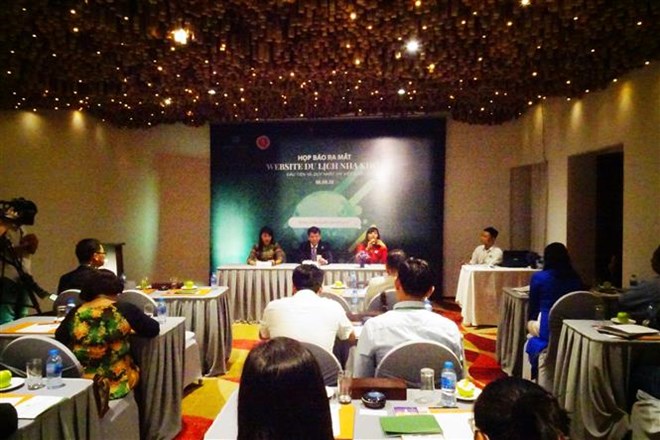 At the ceremony to launch the official portal on Vietnam's dental tourism The Vietnam Tourism Dentistry JSC has launched the country’s official portal on dental tourism, https://dentaltourism.vn, in a bid to build Vietnam into the world’s dental care tourism destination in the future. The new website will provide users with various services, including dental implants, porcelain veneer, teeth whitening and deep cleaning, among others. It also links with tourism companies to introduce services and packages that are suitable with travel tours in Vietnam with budget-friendly prices and high quality. Customers using services on the website may receive maintenance and care services in countries having dental cooperation with Vietnam, particularly the US and Australia. At the launching ceremony, Director of Ho Chi Minh City Odonto–Stomatology Hospital Nguyen Duc Minh said the website will enhance connection between dental clinics and travel agencies across the country, which helps to attract more foreign tourists to Vietnam. Dental tourism is part of medical tourism, which involves individuals seeking dental care while travelling. Nearly 100,000 foreign tourists travel to Vietnam each year for dental treatment, providing revenue of about 150 million USD. Those from Australia, the US and New Zealand topped the list.-VNA First commune-level clinic with 17 specialist doctors in HCM City 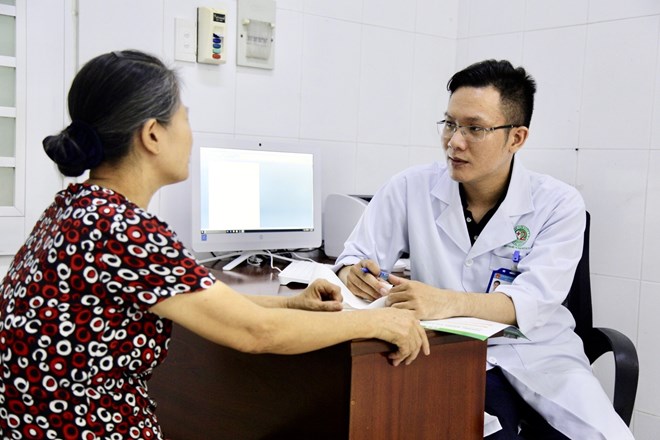 A doctor gives advice to an elderly women at the medical centre of Thao Dien ward The medical centre of Thao Dien ward in District 2, Ho Chi Minh City, has become the first of its kind in Vietnam to have 17 specialist doctors when a satellite consulting room of the district’s hospital was opened there on August 8. The facility is able to give check-up to more than 300 patients each day. Its doctors specialise in emergency aid, internal medicine, surgery, paediatrics, odonto-stomatology, otolaryngology, ophthalmology, obstetrics and gynecology, dermatology, and traditional medicine. Aside from the high-quality staff, the consulting room is also equipped with modern equipment, Director of the District 2 Hospital Tran Van Khanh said, adding that people who come to the clinic will receive similar examinations as at his hospital. The District 2 Hospital has invested 10 billion VND (over 430,300 USD) in developing the satellite consulting room, which initially focuses on basic examination and treatment activities and epidemic prevention. In the future, the hospital will develop it into a specialist consulting room with high techniques and low cost. Tang Chi Thuong, Deputy Director of the HCM City Health Department, said opening satellite consulting rooms at local medical centres is one of the solutions to reduce the overload at higher-level hospitals while making use of the clinics’ facilities and staff. It will also help improve people’s trust in the grassroots healthcare network. Before the District 2 Hospital, the hospitals of Thu Duc and Tan Phu districts also opened consulting rooms at local clinics, but these facilities are on a small scale and do not have as many specialist doctors as the Thao Dien ward medical centre.-VNA Hotel investor found discharging wastewater onto Danang beach  The hotel complex project on Vo Nguyen Giap invested by Kim Long Nam Company The investor in a real estate project in the central city of Danang was recently found to have directly discharged wastewater onto a local beach. The information was given by the municipal Director of Natural Resources and Environment Le Quang Nam. According to Nam, an inspection jointly carried by the departments of Natural Resources and Environment and Construction along with environment police detected Kim Long Nam Company as the violator. The firm is the investor in a hotel project on Vo Nguyen Giap Street. The company discharged wastewater directly into the beach in Son Tra District through four pipes and it would face the fine of VND700 million (USD31.81 million). On the evening of August 5, visitors saw a huge amount of noxious wastewater poured into the Son Tra beach. The problem was firstly thought to be caused by a leaking pipe system which might be resulted from the big amount of wastewater from swimming pools of hotels along Vo Nguyen Giap Street. Meanwhile, according to some local residents, they often see such wastewater discharged into the Son Tra beach. Many beaches in Danang are facing pollution due to the direct discharge of wastewater. My Khe Beach, which used to be ranked among the world’s most beautiful beaches, is among those. Wastewater has been discharged from the city’s 41 wastewater discharge outlets directly into the sea, resulting in not only water pollution but also erosion of hundreds of cubic metres of sand. Danang plans to build a VND211 billion (USD9.45 million) drain system for coastal wastewater in Ngu Hanh Son District. VND7trn bridge connecting Quang Ninh and Hai Phong races toward completion 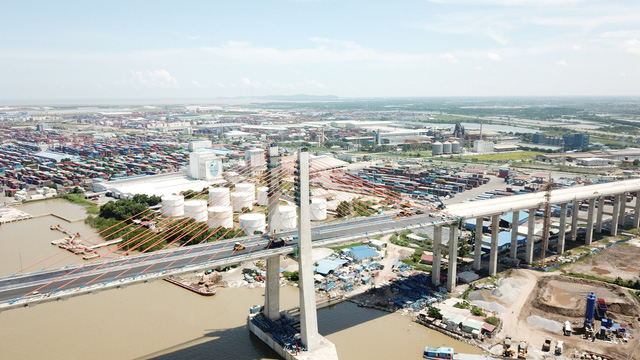 The nearly-completed Bach Dang Bridge which connects Quang Ninh Province and Hai Phong City will help reduce travel time from Hanoi to Quang Ninh. The construction of VND7trn (USD280m) Bach Dang Bridge was started on January 25, 2015, under a build-operate-transfer contract. The bridge starts from Dong Hai 2 Ward, Hai Phong City and ends in Lien Vi Commune, Quang Ninh Province. The bridge is 5.4km long with four lanes and 100km/h limit speed. It was designed with three H-shaped towers, indicating the close connection among Hanoi-Hai Phong and Ha Long. The bridge will help boost the economy in the north, complete the coastal highway and help to reduce the travel time by car from Hanoi to Hai Phong from 3.5 hours to 1.5 hours. The total distance from Ha Long to Hai Phong will be reduced from 75km to 25km. Nguyen Van Doc, party secretary of Quang Ninh, said this was a breakthrough in receiving and implementing road and bridge construction technology as the bridge is built and designed by local firms. The bridge had been trial opened on April 28 with 90 percent done. However, the final process hasn't been as quick as expected as some parts are behind schedule due to complications. Facility concerns over Hanoi Children's Palace raised 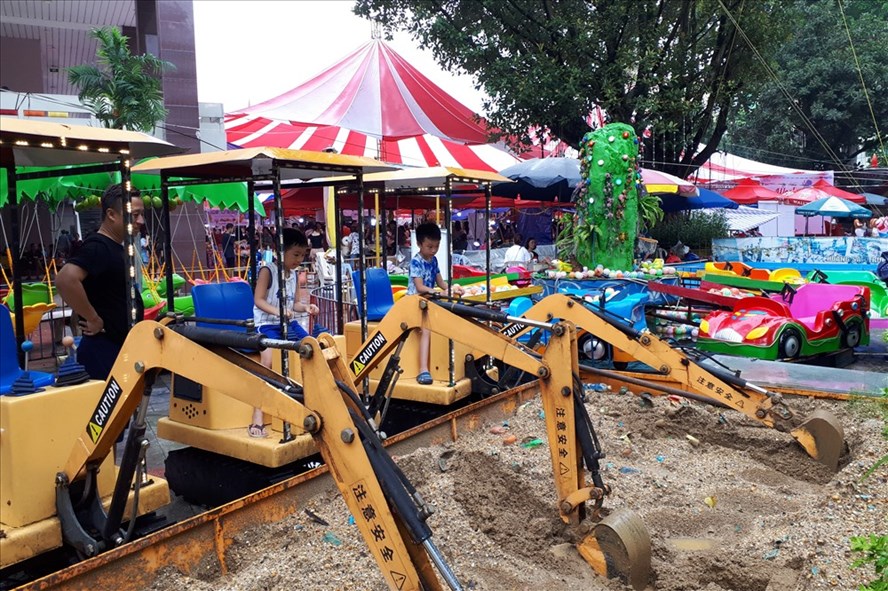 Children play at the Children's Palace Many people are worried that the Children's Palace in Hanoi will suffer after it was announced that the French sector on the site will be transferred to the Hanoi People's Committee's management for other uses. The Children's Palace is located in the city's centre, near Ly Thai To Statue and the Hoan Kiem Lake. It is especially crowded during the summer when children flock to the palace to participate in various kinds of art classes and other activities. It is estimated that about 20,000 children study more than 70 subjects there every year. A summer camp is being held at the palace this month and attracted hundreds of children and parents. Teachers, children and parents are worried when it was announced that the palace's land planning will be changed and the Department of Finance has been asked to make a report to the city people's committee. Chu Hong Minh, director of the Children's Palace, said, "We have many memories here. The city Youth Union is also working with the staff in order to gain a better understanding of their needs." An employee said they hoped to keep the block and the Uncle Ho with Children Hall because it's where generations of children had learned. Many people also hope that the grounds would not be made smaller since Hanoi already lacked space for children. Bui Thi An, former NA deputy in Hanoi said the Children's Palace had been the entertainment and studying area for children and she believed that the city would not take it away. Nguyen Xuan Dat, deputy head of Vietnam Urban Environment and Industry Zone Association agreed and said they should make better use of the palace while building more playing grounds for children. "The Children's Palace is one of the rare places in the middle of a busy city that provides both playing and training areas for children's development. We should keep it, not make it smaller," he said. The Children's Palace consists of a five-storey building, the Red Scarf Theatre and the French sector. The French sector covers 1,200 square metres with gardens. The Ho–Sainteny agreement was made on March 6, 1946, at the French building. To this day, 15 rooms are still being used as classrooms for children and six others are offices for teachers. Experts raise concerns over Yên Sở bus station 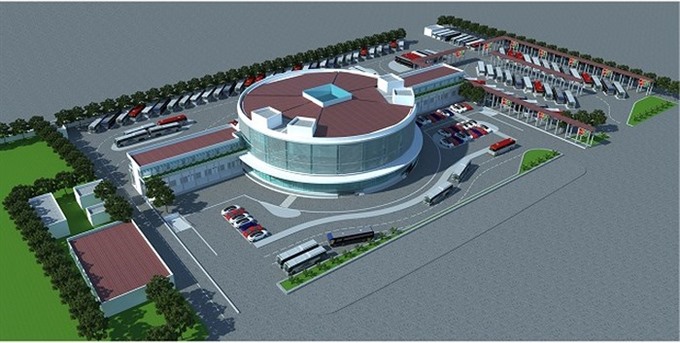 The image of Yên Sở Bus Station when construction is completed. Experts have raised concerns over the construction of Yên Sở bus station, which will be located inside the city instead of the suburbs, saying that the construction would cause waste and would not suit the city’s planning. According to Hà Nội’s planning on bus stations and parking lots to 2030 with a view to 2050, which was approved by the Government in 2016, Yên Sơn bus station would be a medium-term inter-provincial facility to reduce overloading on Giáp Bát, Nước Ngầm and Gia Lâm bus stations. The station would be located near Yên Sở Park south of Ring Road 3. It was expected to serve passenger buses and trucks with capacity to accommodate between 800 and 1,000 buses and 200 trucks per day. The construction of the bus station has proved controversial among transport experts. Dr Đào Ngọc Nghiêm, vice chairman of the Hà Nội Urban Planning and Development Association said that in the past, the city had rejected the construction of two bus stations in the inner city, which were about 2km from Yên Sở station. The planning of bus stations and parking lots until 2030 included details on moving existing bus stations to Belt Road 4, so it was unnecessary to build Yên Sở bus station in the inner city. Vice Chairman of the Hà Nội Transport Association Bùi Danh Liên said the construction project would be a waste because the bus station would operate for a few years and then be moved. In reply to concerns over the planning of the bus station, deputy director of the Department of Transport Ngô Mạnh Tuấn said the construction project was part of the city’s planning of bus stations and parking lots until 2030, and was suitable with the city’s planning, which was approved by the Government in 2016. Tuấn said after the building of the southern bus station on Ring Road 4 was completed, Yên Sở bus station would be transformed into a public transit hub and car park. Currently, the project for the southern bus station is still in the research phase. Bùi River dyke upgrade mooted 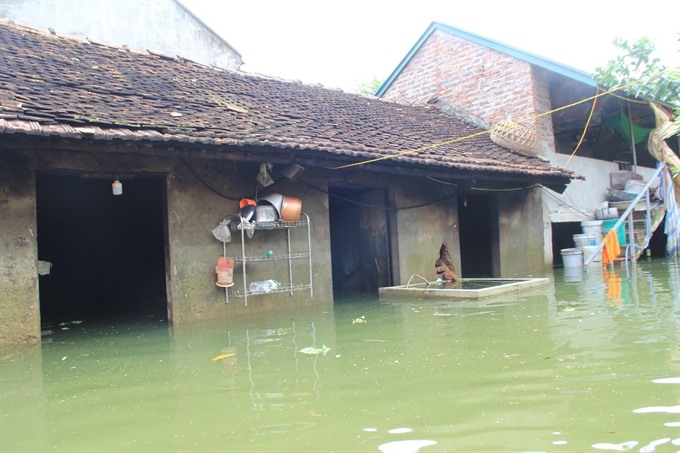 Houses inundated in floodwater in Chương Mỹ District, Hà Nội. Authorities of Hà Nội’s Chương Mỹ District are studying a plan to repair and upgrade the Bùi River dyke using pre-stressed concrete to ensure safety for residents when floodwater overflows, said Ðinh Mạnh Hùng, chairman of the district’s People’s Committee. Next year, the capital will trial upgrading a weak dyke section covering 1.km, he told press at a meeting on Tuesday on floods in outlying districts of Hà Nội. Due to prolonged torrential rain that started late last month in the north, the water level of the Bùi River rose to the third warning level (the highest) and overflowed. Residents of Tân Tiến, Nam Phương Tiến, Tốt Ðộng, Hoàng Văn Thụ, Mỹ Lương and Hữu Văn communes of Chương Mỹ District, together with others in Quốc Oai Mỹ Ðức districts were submerged in water. The floods affected more than 4,600 households with more than 22,400 people. Chương Mỹ District, the hardest hit one, suffered losses of more than VNĐ264 billion (US$11.5 million). According to the chairman, the water has receded and there are less than 1,000 households still submerged. Hùng said that along with dyke renovations, transport and clean water supply systems must be ensured. Production activities of local people must be re-organised so their lives are less affected by floods. For a long-term strategy, Hùng said residents living along the right side of the Bùi River dyke must be evacuated to safer places. The area on the right of the dyke will serve manufacturing purposes. He added that Chương Mỹ District needs more than VNĐ447 billion ($19.5 million) to repair 11 broken or eroded dykes, to build the headquarters of Nam Phương Tiến Commune’s People’s Committee and to renovate five downgraded historical and cultural structures. At the meeting, Đỗ Đức Thịnh, chief of the secretariat of Hà Nội’s Steering Committee for Natural Disaster Prevention and Control, warned that the water levels of the Tích and Bùi rivers are high. Authorities must make plans to evacuate residents out of low lying and risk-prone areas. Measures sought to ensure reservoirs’ safety in Central, Central Highlands 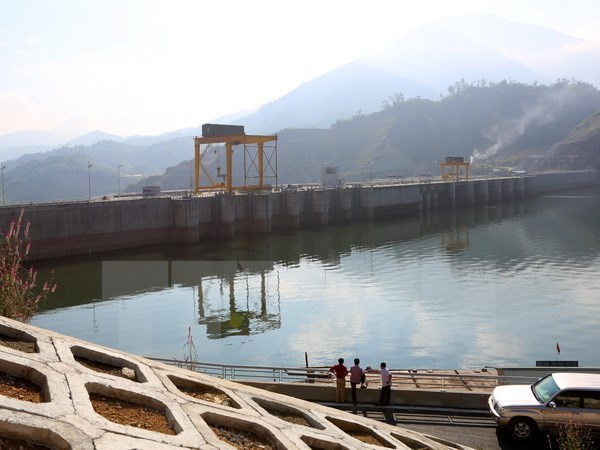 It is necessary to build dedicated hydro-meteorological networks in large reservoirs and install systems for monitoring reservoirs’ operation in order to better ensure dam safety, said Le Van Duong from the General Department of Irrigation under the Ministry of Agriculture and Rural Development (MARD). Speaking at a recent conference on natural disaster prevention in the Central and Central Highlands regions held in the central city of Da Nang, Duong underlined the urgent need to construct monitoring stations for forecasting the real-time operation of reservoirs in steep rivers where floods usually rise suddenly. He noted that guidelines for the development of reservoir operation procedures have not yet met the actual operation of reservoirs. The assessment of dam safety, the making of plans on flood prevention for downstream areas, and the setting up of corridors to protect reservoirs require substantial funding, beyond the affordability of dam and reservoir management units, he added. Attention should also be paid to personal training in this field, promoting dissemination of legal regulations on dam safety, and raising public awareness and response, Duong said. According to the General Department of Irrigation, around 12 trillion VND (516.3 million USD) has been spent on upgrading and repairing 633 reservoirs nationwide. However, there are still 1,200 seriously damaged others that need repair. The department recommended more investment in improving the flood resistance of large reservoirs in line with international standards. Priority should be given to repairing seriously degraded small reservoirs which have low capacity to discharge floodwater by using official development assistance (ODA) capital resources, and the central and local budgets, the department said. As many as 450 reservoirs have been included in the list of those which will be repaired under a project to improve dam safety (WB8) with a total investment of 433 million USD. The MARD has also proposed the Prime Minister support 19 provinces in the Central and Central Highlands in repairing and upgrading 47 reservoirs at a total cost of 287 billion VND. According to statistics from the General Department of Irrigation, the Central and Central Highlands regions have 3,551 irrigation reservoirs, accounting for 53.4 percent of the country’s total number. Localities having the most reservoirs are Thanh Hoa with 610; Nghe An, 629 and Dak Lak, 543. The regions have 693 degraded reservoirs, or 58 percent of the country’s figure. Many of them, especially small ones, are not capable of resisting floods in line with current standards. They witnessed 38 dam and reservoir-related incidents out of 50 cases nationwide in the last decade, accounting for 76 percent. In 2017, heavy rains caused 16 dam and reservoir breakdowns in the regions. Quang Tri strives to minimise child drowning 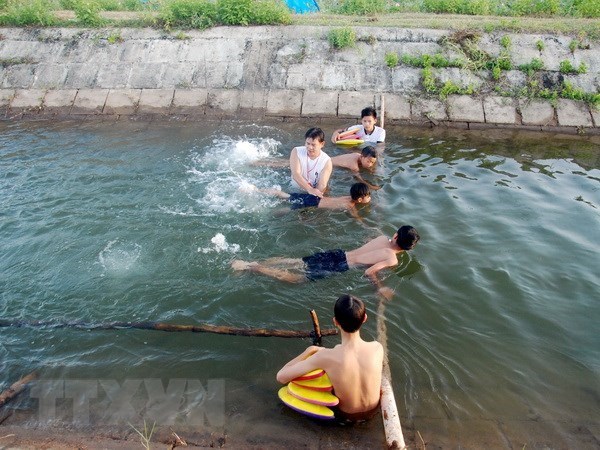 Authorities in the central province of Quang Tri have coordinated with local organisations to open free swimming courses for local children in the hope of minimizing child drowning, especially in rural and remote areas. The courses are designed to equip children with necessary skills to avoid drowning and accidents, while raising children and parents’ awareness of protecting their health and life. As part of activities to prevent child drowning in 2018 launched by the provincial Ho Chi Minh Communist Youth Union, the union’s chapters in Hai Lang, Trieu Phong, Vinh Linh, Cam Lo districts and Quang Tri and Gio Linh towns as well as the provincial Children’s Cultural House have organized 45 swimming courses for nearly 1,200 children. The courses, held from June 30 to August 30, also provide life skills to the children. Nguyen Thi Phuong Lieu, Vice Secretary of Hai Lang district’s Ho Chi Minh Communist Youth Union said that Hai Lang is a low area with high number of drowning cases. The district’s youth union first launched swimming courses for children in 2015, which have become an annual activity of the district in summer, she said, adding that 106 courses have been opened so far, drawing 2,650 local children. In 2018 alone, the union has offered 34 free courses to 850 children in the locality. Since early June 2018, the World Vision International in Vietnam have coordinated with seven communes in Hai Lang – Hai Duong, Hai Xuan, Hai Truong, Hai Thanh, Hai Thien, Hai Hoa and and Hai Quy – to organise 14 courses for 420 children aging from 12-18, during which the children are taught swimming skills and the process of giving first aids to victims of accidents. According to Vice Director of the Vietnam Sports and Physical Training Administration Pham Van Tuan, drowning is the leading cause of death in children and adolescents in Vietnam, especially in the summer and storm season. He noted that an initial report showed that the ratio of children who can swim in Vietnam remains under 30 percent. A report by the Ministry of Labour, Invalids and Social Affairs showed that about 2,000 children lost their lives to water in Vietnam each year between 2015 and 2017. Photo exhibition marks 100th birth anniversary of UAE leader 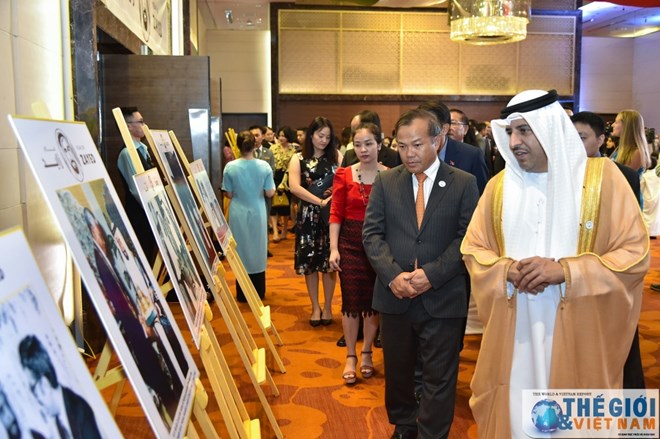 At the event The Embassy of the United Arab Emirates (UAE) held a photo exhibition in Hanoi on August 8 marking the 100th birth anniversary of UAE founding father, late President Sheikh Zayed Bin Sultan Al Nahyan. Speaking at the opening ceremony, Ambassador Obaid Saeed Bintaresh Al Dhaheri said in order to mark the historic national event, the incumbent UAE President has declared 2018 as the Year of Zayed, during which a series of events and initiatives will be launched at home and abroad in memory of the late leader, his life, career and humanitarian values. He said the late President was one of the eminent and respected leaders of the country. In his life, he always respected all people irrespective of nationality, gender, religion and position, paid attention to promoting women’s rights and highly appreciated foreigners’ contributions to national development. The President led the country from 1971 till his death in 2004. The ambassador said the leader’s vision brought about a dynamic and balanced diplomatic policy without interference into internal affairs of other countries, contributing to building a better future for the mankind. Visitors had a chance to watch a film featuring the life of the late President, enjoy the country’s cuisine, photos and pictures featuring his life and career. Cà Mau to speed up urban area upgrades 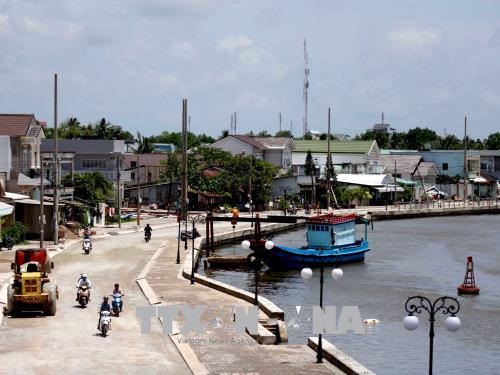 Cà Mau Province has built resettlement areas for residents, and has upgraded urban areas and drainage systems in Cà Mau City. The authority of Cà Mau Province is taking measures to speed up the upgrading project for the urban area of Cà Mau City. Phan Hoàng Vũ, chairman of Cà Mau Province’s People Committee, said that 23 Official Development Assistance-funded (ODA) projects in the first stage and 13 projects in the second stage were currently underway. Seventeen projects in the first stage have been completed. In the first stage of the upgrading project, Cà Mau used ODA to build resettlement areas for residents, and upgraded urban areas and drainage systems. Cà Mau has disbursed VNĐ665 trillion (US$28 trillion) from ODA and VNĐ452 trillion (US$19 trillion) of reciprocal capital from the Government, including VNĐ130 billion for site clearance and compensation. To speed up the projects, Cà Mau’s urban upgrading management board is working with authorities and related units to disseminate information to households to encourage them to relinquish land for the upgrading project. As many as 2,403 households out of 2,433 households have agreed to hand over land to the project management board. The province has asked the Government to invest more than VNĐ190 billion (US$8 million) to speed up implementation of the second stage of the projects. Mekong Delta Cycling Tournament to start 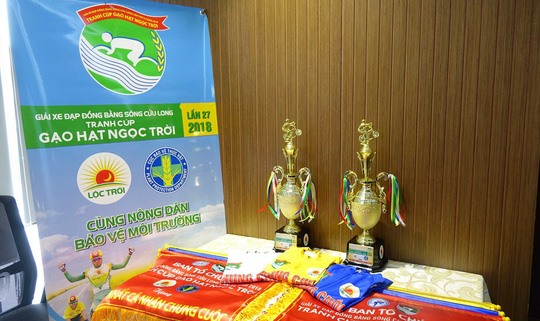 Hạt Ngọc Trời Rice Cup. — Photo nld.com.vn The Mekong Delta Cycling Tournament, the Hạt Ngọc Trời Rice Cup is scheduled to start on August 11 and last until August 19. The event will attract 102 cyclists from 17 teams such as Lộc Trời Group, Hà Nội, VUS-HCM City, and Domesco Pharmacy Đồng Tháp. They will compete in 10 stages lasting 965km via 13 provinces to finish in An Giang City. The event will offer a record prize total of VNĐ666 million (US$28,900). The overall yellow jersey winner will walk away with VNĐ50 million. Smart water management helps promote sustainable development 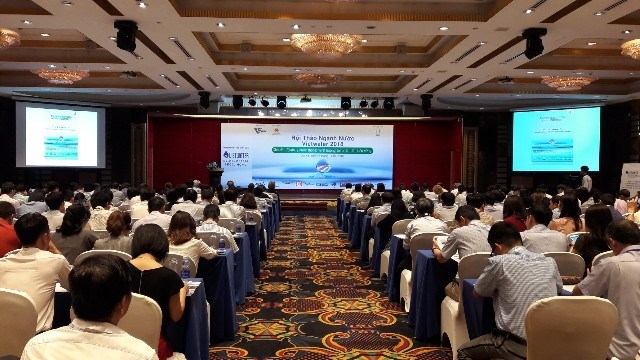 At the workshop (Photo: VOV) Experts shared information on smart water management policies and technologies for sustainable development during a workshop in Hanoi on August 8. President of the Vietnam Water Supply and Sewerage Association (VWSA) Cao Lai Quang said Vietnam is facing a number of challenges in this field such as urban population growth, limited budget, poor management capacity, water pollution, climate change impacts, including droughts, floods, and saltwater intrusion. Given these difficulties, the country is focusing on policies reforms to attract more investment in new science and technology, he said, adding that some leading businesses have applied many smart water management solutions to catch up with the fourth industrial revolution (Industry 4.0). He stressed the necessity to promote the adoption of such solutions in order to secure sustainable development. Head of the Ministry of Construction’s Department of Technology Infrastructure Mai Thi Lien Huong said the country has over 500 urban water supply systems with a total capacity of 8.7 million cubic metres per day. Seventy percent of which are able to supply water around-the-clock while the remaining could provide water for 8-20 hours per day. Notably, the rate of water loss in Vietnam remains high, averagely at 22.5 percent. It requires a large amount of investment in water supply and drainage, she said, referring to the limited budget in the field. To address the financial problem, Paul Smith, director of international cooperation from the Australia Water Association, said partners in the private sector could bring improvements to the water sector. He shared that governments in many countries have adopted the public-private partnership (PPP) model over the past 20 years as it can save financial resources and promote effective provision of services. Each country will select the most suitable model according to their situation but with the common goal of sustainable development, he said. The workshop was held by the UBM Asia Limited under the chair of VWSA as part of the activities in the Vietnam's International Water Supply, Sanitation, Water Resources, and Purification Event (Vietwater 2018) to be held in Ho Chi Minh City from September 7-9 with the participation of 500 businesses from 41 countries and territories. The event created a good chance for enterprises to seek partners and introduce their latest products and technologies in the water industry. VNN |
↧
Article 0
Cryptocurrency scams offer false promises The common characteristic of all the scams was that the heads of the cryptocurrency mining firms’ all promised sky-high interest rates for short-term investments. 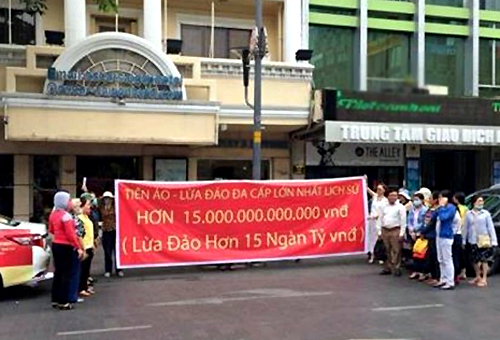 Investors denounce Modern Tech of appropriating VND15 trillion Alos Coin (AOC) became a hot topic of discussion in Bac Giang Province in late 2017. The cryptocurrency caught the attention of people in the poor rural area because it was believed to help them escape poverty quickly. The promised interest rate of 180 percent per annum, or 20 times higher than the bank deposit interest rate, prompted thousands of locals to sell their assets and houses to invest in AOC. Only when the leaders of the system disappeared were their true faces exposed.
The police discovered that the cryptocurrency ring had networks in 10 provinces/cities and attracted 1,400 investors who had poured tens of billion of dong into it. In April, tens of investors came to the head office of Modern Tech Company, holding a banner denouncing the company for appropriating VND15 trillion by calling for investments in Ifan, or Pincoin cryptocurrency. With more sophisticated tricks than AOC, iFan, or Pincoin, defrauded investors who have IT knowledge. The cryptocurrency was introduced as an ‘international currency’ established in Singapore and used for showbiz-related services. Some investors revealed that Modern Tech had an interest rate of 48 percent a month at minimum. It also promised at events organized in 2017 to give capital back within four months. If investors could bring new investors to the system, they would get a bonus equal to 8 percent of the total value of the new investments. Like other cryptocurrencies set up on the lending platform, iFan collapsed a short time later. Sky Mining is also on the list of discovered cryptocurrency fraud cases. On July 23, investors pouring money into Sky Mining reported the case to agencies after they failed to contact the cooperative’s director Le Minh Tam. According to Le Minh Hieu, vice director of Sky Mining, Tamleft for the US with assets worth tens of million of dollars, and Hieu was just a nominal manager and did not have information about investors and invested money. On its website, Sky Mining says it is Vietnam’s largest cryptocurrency mining company. Sky Mining asked investors to choose packages of either $100 or $5,000 used to buy mining machines. It promised to give back principal and interest, worth up to 300 percent of the investment capital, after 12 months. After paying money, investors would receive mining machines from Sky Mining and leave them at the company for mining. After 15-18 months, when the 300 percent profit cycle finished, investors return the miners to the company. VNN |
↧
Article 1
Social News 14/8 Draft decree on spending $3.4m for 91,000 retired female employees 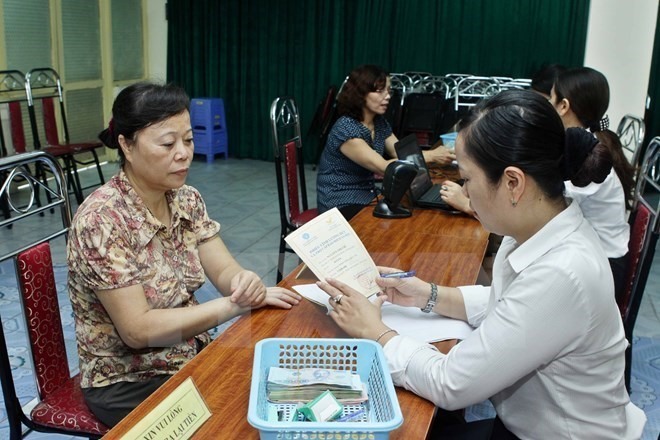 As many as 91,000 female employees who retire between 2018 and 2021 will be able to receive between 0.2 and 12 per cent of their pensions as a bonus as well as their current pensions. This is part of the draft decree on the adjustment of pensions for retired female employees from 2018 to 2021 by the Ministry of Labour, Invalids and Social Affairs (MOLISA). The pension adjustment would apply to female employees starting to receive pensions from 2018-21. Due to the different time periods of paying social insurance premiums by female employees, the rates of pension deduction is also different, leading to the adjustment calculated based on the amount of time of paying social insurance premiums and the year of retirement. As a result, MOLISA has proposed increasing pensions by between 0.27 per cent and 12.31 per cent depending on the period of social insurance contribution. Female employees retiring between January 1, 2018 and June 30, 2018, will be eligible for the pension adjustment after their pensions are adjusted. Female employees retiring between January 1, 2018 and the date of adjustment of their pension as prescribed above will be entitled to receive the adjusted pension from previous months after the first month of retirement. The Vietnam Social Security forecasts that the number of female employees starting to receive pensions from 2018 to 2021 with 20 years or more of social insurance contribution will be 91,000. Of that, 20,500 people will retire in 2018; 22,000 people in 2019; 23,500 people in 2020 and 25,100 in 2021. The labour ministry estimates that the budget for the pension adjustment for the period from 2018 to 2021 is about VNĐ80 billion (US$3.4 million). Of that, 2018 needs VNĐ27.8 billion ($1.19 million), 2019 needs VNĐ23.7 billion ($1 million); 2020 needs VNĐ18.1 billion ($778,000) and 2021 needs VNĐ10 billion ($443,000). – VNS People nationwide support floods victims 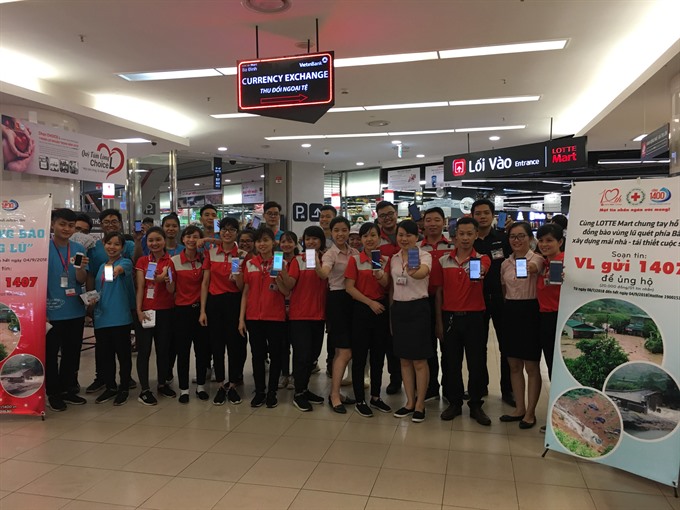 Lotte Mart staff in Hà Nội text to support the Việt Nam Red Cross programme for people in flooded areas. A programme to raise funds for flood victims via text message has received VNĐ429.8 million (US$19,100), according to Việt Nam Red Cross Society. The programme, launched on July 8 by the society and the national humanitarian information portal, will last until September 4 and aims to raise at least VNĐ1.5 billion to buy necessities, build and repair houses for the households hard hit by the recent floods and landslides in the northern mountainous areas, as well as help victims find ways to earn their living. So far 21,490 text messages have been sent to the programme so far, each with a donation worth VNĐ20,000. People can text ’VL’ to the number 1407 to donate to the SMS programme. They can also send donations in cash or in kind should be addressed to the Việt Nam Red Cross offices in Hà Nội and HCM City. Money can be transferred to the account of the Việt Nam Red Cross, account No. 124 0202 005348 at the Việt Nam Bank for Agriculture and Rural Development, Hoàng Mai branch. Lotte Mart Việt Nam JSC called on its staff and customers to respond to the campaign to help people in flooded areas at a ceremony on Saturday in Hà Nội. More than 2,000 staff members of Lotte Mart Việt Nam at 13 Lotte commercial centres nationwide will take part in the campaign as well as carry out communication activities to encourage customers to support the Việt Nam Red Cross programme for people in flooded areas. Seven PV Coating leaders prosecuted for corruption  Trần Đức Minh, former director of PV Coating. file photo The Supreme People’s Procuracy has prosecuted seven former leaders of PetroVietnam Coating Joint Stock Company (PV Coating) for alleged embezzlement and violation of State regulations on economic management causing serious consequences. The People’s Court of Bà Rịa-Vũng Tàu Province has received the cases’ indictment from the Supreme People’s Procuracy. On August 1, Trần Đức Minh, former director of PV Coating; Phạm Ngọc Minh, former deputy director; Bùi Nhật Vinh, former head of Technical Economics Department; Nguyễn Thị Hà Nhung, former chief accountant also head of Finance and Accounting Department, were prosecuted for embezzlement of State property. Defendants Nguyễn Phước Toàn, former deputy director of PV Coating’s Pipe Plant; Nguyễn Công Chương, former deputy head of finance and accounting office, and Kim Văn Anh, former director of PV Coating’s Pipe Plant, were prosecuted for intentionally violating the State’s regulations on economic management, causing serious consequences. PV Coating was set up in 2007 with headquarters in Bà Rịa-Vũng Tàu Province under PetroVietnam. Trần Đức Minh was PV Coating’s director from June 2013 to October 2016. He was accused of embezzlement of VNĐ48.3 billion (US$2 million) in the implementation of the Nam Côn Sơn 2 gas pipeline project. Health minister urges hospitals to reduce patient overload  Minister of Health Nguyễn Thị Kim Tiến talks with patients at Chợ Rẫy Hospital. Minister of Health Nguyễn Thị Kim Tiến has asked large hospitals in HCM City to take drastic measures to reduce patient overload by focusing on satellite clinics at district-level hospitals and applying information technology. Major city-level hospitals should transfer patients with non-serious ailments to district- and provincial-level hospitals, Tiến said during her visit yesterday to Chợ Rẫy Hospital and HCM City University Medical Centre. Tiến spoke with a patient, Nguyễn Thị Phượng, 42, from Nha Trang in the central province of Khánh Hoà, who was waiting in the HCM City University Medical Centre’s digestive department. Phượng told the minister that she arrived at 6am and then had to wait for four hours to see her doctor again. On her first visit a day earlier, Phượng spent an entire day at the hospital for gastroscopy, and was diagnosed with gastroesophageal reflux disease. After examining her tests and drug prescriptions, the minister said that her disease could be treated at Khánh Hoà General Hospital in her native province. But Phượng said that her sister had advised her to visit doctors at the HCM City University Medical Centre. Her neighbours in Nha Trang also visited large hospitals in HCM City for medical treatment, she said. Every day, an average of 7,000 outpatients visit the HCM City University Medical Centre for health check-ups and treatment, resulting in long waiting lines of patients at most departments. Many patients at Chợ Rẫy Hospital, which provides check-ups and treatment to 6,000 outpatients a day, said they did not trust hospitals in their provinces. Nguyễn Hoàng Bắc, director of the HCM City University Medical Centre, said the hospital had adopted electronic patient records and IT to improve the quality of patient care and efficiency of patient record management and hospital administration. However, patient overloading still continued, she said, adding that the hospital planned to build a new facility to meet demand. The hospital has asked the Health Minister to either set aside state funds for investment in IT or allow hospitals to add some of their IT costs to check-up and treatment fees. Besides building new facilities, Tiến proposed that the two hospitals expand their satellites at district- hospitals and provincial-level hospitals to reduce patient overload as many patients from other cities and provinces visited these two hospitals for treatment of common diseases. During her visit, Tiến also spoke with the two hospitals about the quality of health check-ups and treatments, health insurance payments, and salaries and bonuses for health workers. Thanh Hoa holds flood preparation, response drills 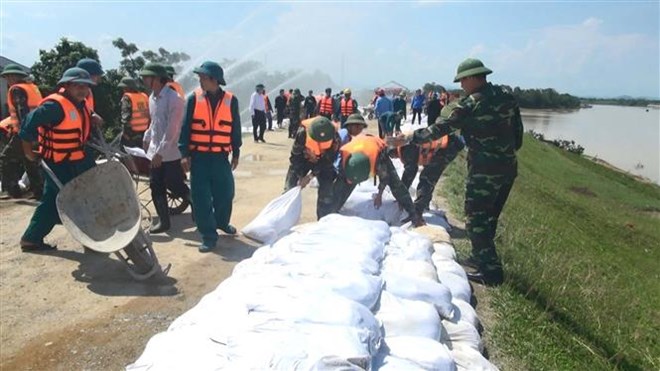 At the event Flood preparation and simulated response drills took place in Tho Xuan district in the central province of Thanh Hoa on August 13. In the first scenario, officers and soldiers of Military Region 4 were required to work with local authorities to evacuate 50 households with 150 people in Van Lo hamlet, Tho Nguyen commune, to a local secondary school as heavy rain drenched the locality while a section of the nearby dyke was at risk of collapsing. After local residents were relocated, they were also given food, water, and other necessities. In the second scenario, a dyke collapsed in Tho Nguyen commune, Tho Xuan district. The drill involved 150 officers and soldiers from Military Region 4, relevant units, and 90 local residents using trucks and other materials at hand to promptly shore up and stabilise the dyke, which they managed to do within 30 minutes. Meanwhile in the third scenario, relevant forces searched and rescued 26 households with 96 persons located on loose-soil ground in Tho Nguyen commune, using canoes and boats to save humans and assets. The drills were successful in helping to improve the capacity of relevant units and their coordination in case of potential future disasters. Fatherland Front leader receives Singaporean official 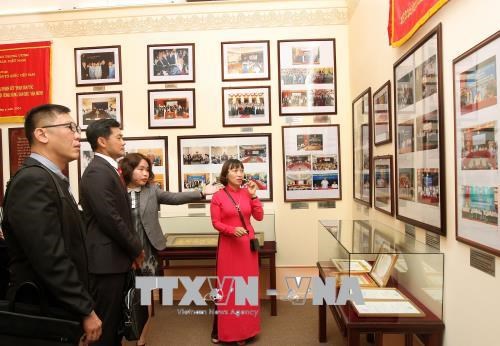 PA Chief Executive Director Desmond Tan visits a VFF traditional display house President of the Vietnam Fatherland Front (VFF) Central Committee Tran Thanh Man hosted a reception in Hanoi on August 13 for Chief Executive Director of the People’s Association (PA) of Singapore Desmond Tan. Man welcomed the Singaporean delegation’s visit which is concurrent with the 45th founding anniversary of diplomatic ties and the fifth anniversary of the strategic partnership between the two nations. He said the bilateral strategic partnership is growing steadily and effectively across many fields, evidenced by increased mutual understanding, visits at all levels and channels, as well as new strides in economic cooperation. As many as 12,000 Vietnamese people are currently living, studying and working in Singapore, while over 18,000 Vietnamese officials joined training courses as a result of the cooperation agreement with Singapore. More and more Singaporean people are also investing in Vietnam, serving as an important bridge for bilateral links. Man hoped that the PA would continue working with Singaporean authorities to create favourable conditions for Vietnamese people in the country. The VFF and other relevant Vietnamese agencies will offer all possible support to Singaporean firms and people in Vietnam in line with the law, he pledged. Man also expressed his wish that the PA would continue to assist the VFF in training, community building, and holding meetings with lawmakers. Tan, for his part, affirmed that the PA will do its best to realise signed agreements, thereby strengthening VFF-PA collaboration, as well as the strategic partnership between the two nations. Earlier, Vice President and Secretary General of the VFF Central Committee held talks with Chief Executive Director of the PA Desmond Tan. The two sides signed a memorandum of understanding on the cooperation programme for the 2018-2020 period. They agreed to share experiences in community connectivity and building, self-governance in communities, and public involvement in social management, all helping to serve as a bridge between the government and its people. During the period, the two sides will also offer mutual support in training, community connectivity and building, as well as popularising the culture and people of each country through festivals. Scholarships to be presented to poor Mekong Delta students 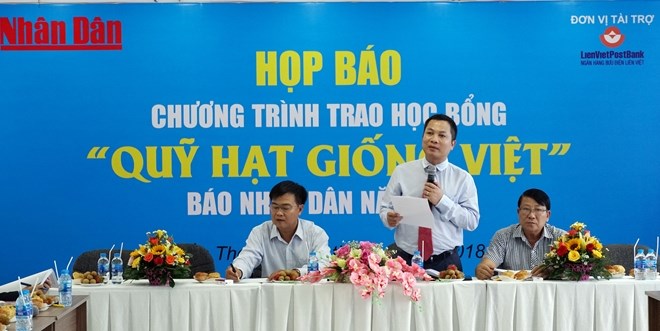 At the press conference Disadvantaged students with outstanding academic results in the 2017-2018 academic year in the Mekong Delta will receive scholarships from the “Vietnamese Seeds Fund” by the Nhan dan (People’s) newspaper for the first time this year. Nguyen Hong Sam, head of the newspaper’s bureau in Can Tho city, told a press conference in the locality on August 13 that the scholarships will be funded by the Lien Viet Post JSC Commercial Bank. Established in 2012, the fund aims to step up the campaign for building a more educated society, which involves improving the quality of learning at secondary schools located in wards and communes nationwide. The awards ceremony is due to take place at Can Tho University on August 18, honouring 1,300 students from primary, secondary, and high schools across 13 regional cities and provinces. Each scholarship will be worth 3 million VND (132 USD) which will granted to 100 students from each locality, at a total cost of 3.9 billion VND. According to the Ministry of Education and Training, the rate of school dropouts in the Mekong Delta remains high compared to that in the Central Highlands and northwest, standing at 0.45 percent in elementary schools, 3.26 percent in secondary schools, and 3.94 percent in high schools. It is largely attributed to the poor living conditions of many households, forcing children to leave school and earn a living in order to cover simple daily needs. The scholarship programme looks to encourage their studies and support tens of thousands of poor students with excellent academic performances, thereby ensuring the welfare of society and nurturing young talent. Sơn La suspension bridge out of order 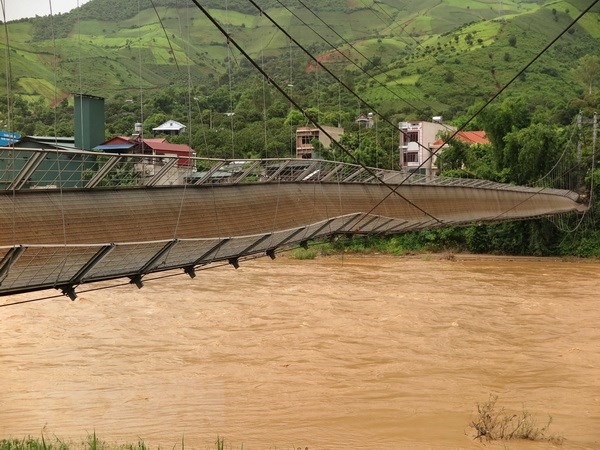 The Hải Sơn suspension bridge was damaged, seriously affecting the lives of local residents. A suspension bridge was damaged after being hit by a truck, seriously affecting the lives of residents in Chiềng Khoong Commune in the northern mountainous province of Sơn La. The Hải Sơn suspension bridge, spanning the Mã River, is the main route for thousands of residents in Chiềng Khoong Commune. This is the second time the bridge has been put out of order. Phạm Ngọc Thạch, a resident in Hoàng Mã Village, said that in 1997, a lorry hit the bridge and five people were injured. The Hải Sơn suspension bridge was completed in 1997 by the Sông Mã District authorities. The bridge last underwent periodic maintenance in December last year. However, on August 11 this year, a truck travelling to Sơn La City hit one of the cables and caused the bridge to tilt. At present, residents in Chiềng Khoong Commune are harvesting thousands of tonnes of longans. Now that the bridge is out of order, farmers are worrying about how to transport the fruit. Đặng Văn Thửa, head of Hải Sơn 1 Village, said that if the bridge was repaired, transporting longan would be easier and the prices would be more stable. Moreover, the new school year is approaching. The bridge was an important route for students and teachers. Now, thousands of residents must find alternative routes to school and work. Cầm Thị Ngọc Yến, deputy chairwoman of the Sông Mã District People’s Committee, said that the committee had assigned inspectors to check the state of the bridge and develop solutions. The committee also set up warning signs at the two ends of the bridge, and signs redirecting residents to other routes. The committee has sent reports to the Sơn La Province People’s Committee, the provincial Department of Construction and the provincial Department of Transport about the incident. Detailed plans to repair the bridge will be drawn up once relevant organisations complete their inspections. Two people die in Lào Cai landslide  A landslide kills two people who are traveling on a district-level road in Lào Cai Province.-- Photo danviet.vn A landslide killed two people who were traveling on a district-level road on Saturday evening, Dương Đức Huy, Party Secretary of Bảo Yên District in Lào Cai province, announced. The victims were a grandmother and grandchild from a family living in Nậm Cằm Village. The child, 16, was driving his grandmother, 60, on a motorcycle towards the centre of Bắc Hà District. Rescuers found the two bodies after a search lasting an hour. Local authorities provided granted the family of the victims a total of VNĐ5.4 million. Bảo Yên District’s official said that the prolonged rain in the area led to weakened soil and a high risk of landslides. Four students drown while fishing in river Chairman of Ân Hảo Đông Commune People’s Committee, in the central province of Bình Định, Nguyễn Đình Hưng confirmed that four students from the communal primary school had drowned in the An Lão River on Saturday afternoon. When the children failed to return home in the evening, their parents started to search for them. Arriving at the river, they found some of the children’s belongings on the bank. Once alerted, local authorities and residents searched for the kids and retrieved their bodies late at night. All four children were from poor local families. Overseas Vietnamese association reaches out to community 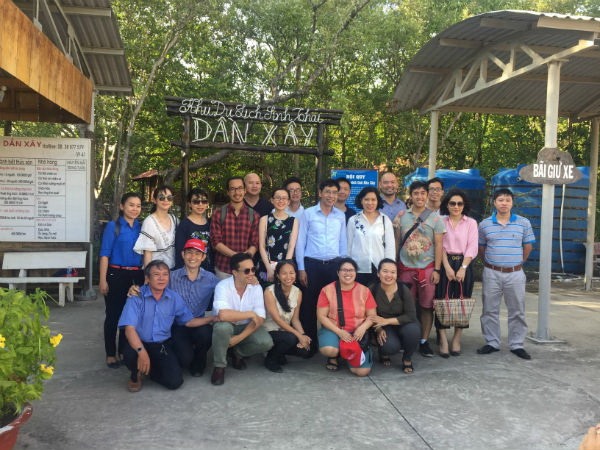 Young Overseas Vietnamese visit a mangrove swamp in Cần Giờ in March. Great efforts have been made to mobilise potential from Việt Kiều (Overseas Vietnamese) communities around the world, but few results have been achieved, according to experts speaking at a meeting with representatives of Overseas Vietnamese communities in HCM City last Thursday. Peter Hồng, deputy chairman of the Overseas Vietnamese Businesspeople Association, said talented, successful people who have studied abroad should deal with Overseas Vietnamese communities. Dr Lương Bạch Vân, chairwoman of the Overseas Vietnamese Association of HCM City, said that local agencies should care more about students of Vietnamese origin in these countries who were born abroad and do not have Vietnamese nationality. Vân said that many overseas families value and preserve Vietnamese cultural and traditional characteristics. Prof. Đặng Lương Mô, an Overseas Vietnamese from Japan, said he was ready to help the city to establish a “bank of talented Overseas Vietnamese” who would promote and exploit the potential of the Overseas Vietnamese communities in all areas of life. The chairman of HCM City Association of Overseas Vietnamese, Phùng Công Dũng, said the association had contacted young Overseas Vietnamese who have re-settled in Việt Nam in order to build a network, with an aim to better exploit the potential of the community for the development of HCM City and Việt Nam. He said the association has a plan to organise a conference to connect the intellectual circles of Overseas Vietnamese communities with universities in Việt Nam to promote research in teaching and learning. The association has been preparing a ‘startup forum’ for members of the communities from home and abroad to link young members who have ideas, projects, and models to be proposed to HCM City authorities. The deputy chairman of the Overseas Vietnamese Businesspeople Association, Peter Hồng, said the association has faced challenges trying to connect with members. Hồnd said the association’s representatives had received a list of 1,176 enterprises invested in by Overseas Vietnamese in HCM City. The association has telephoned, sent emails and faxes to all of them, but has received replies from only 13 of them. There are more than 6,100 enterprises run by members of Overseas Vietnamese communities, but the association has found it difficult to connect with them, said Hồng. He said the association should build a database for its members, including older members who have made contributions to the association and to their homeland, and young members as well. Hà Giang repairs landslide road due to heavy rain The northern mountainous province of Hà Giang is urgently repairing several roads that have been severely damaged by landslides due to many days of heavy rain. Ma Quốc Trưởng, deputy chairman of Mèo Vạc District People’s Committee, Hà Giang Province, said the highway from Mèo Vạc District centre to some communes including Tát Ngà, Nậm Ban, Niêm Sơn and Niêm Tòng has been blocked for days due to prolonged heavy rains causing soil and rock to fall down the road. The most seriously damaged section of road passes through Tát Ngà Commune, where such a large amount of rocks slid onto the road that traffic came to a standstill. Prolonged heavy rains in Xín Mần in recent days caused the national highway from Bắc Quang District to Xín Mần District, and the road from Cốc Pài Town to Xín Mần border gate to become seriously cracked due to landslides. It became nearly impossible for local people to travel along the roads. In Bắc Mê District, heavy rains lasting from the night of August 7 through the entire day of August 8 caused water levels in rivers and streams to rise, seriously damaging homes, cops and State works. According to preliminary statistics, heavy rains damaged dozens of hectares of rice in Minh Ngọc Commune. The spillway of Minh Ngọc Commune to Thượng Tân Commune, Bắc Mê District was partially washed away by the flood, causing the main road to Thượng Tân Commune to become separately blocked. According to Yên Bái Province’s Steering Committee for Natural Disaster Prevention, Search and Rescue, after the heavy floods at the end of July, the province has provided nearly VNĐ5 billion (US$215,000) to the families of dead and missing persons and people whose homes completely collapsed. The province also provided nearly 20 tonnes of rice, instant noodles and drinking water and six tonnes of dried food for flood victims. Kon Tum village isolated Dozens of houses were flooded and 10 villages still were isolated due to heavy rains in Ia H’Drai District in the Tây Nguyên (Central Highlands) province of Kon Tum. Traffic in the district has been impeded. The People’s Committee of Ia H’Drai District has instructed communal authorities and relevant offices to carry out support works, aiming to move local people to safe areas and clean the flooded areas. The authorities deployed forces around the clock at critical locations such as landslide-affected areas and spillways to warn local people not to enter when the water was rising and to prepare food for people in isolated areas. Colonel Phạm Ngọc Phú, Border Guard commander of Kon Tum Province, said army forces were coming to Ia H’Drai District’s flooded areas to co-ordinate with local authorities to rescue people. Tân Sơn Nhất Airport expansion plan needs further clarification: Deputy PM  Roads leading to Tân Sơn Nhất Airport face traffic congestion. The expansion plan for the HCM City’s Tân Sơn Nhất does not clearly define the airport’s civil, defence and security functions, and does not include plans for using the areas of land under the management of the defence ministry, said Deputy Prime Minister Trịnh Đình Dũng. The deputy PM’s statement was released by the Government office on Wednesday. The expansion plan aims to ensure the effective use of the land fund as well as defence and security functions, and meet the rising demand for air transport, according to the Government’s announcement. Deputy PM Dũng asked the Ministry of Transport (MoT) and relevant agencies to consider areas of land used for defence, security and economic purposes, and to confirm or specify the areas for construction of a terminal and other facilities for both civil and defence purposes. MoT was told to agree with the Ministry of Defence on the area of land (under the latter’s management) to be used for the expansion plan, and consider areas of land to be used for both civil and defence purposes. To ensure aviation security and safety, the management and operation of the airport should also be further clarified. The ministry was told to figure out how much investment is needed for the expansion as well as other airport needs, as instructed by Prime Minister Nguyễn Xuân Phúc. Relevant agencies were asked to map out the best plans for the terminal to ensure economically effective use of land at the airport. MoT was also told to collaborate with the ministries of Planning and Investment, and Finance and relevant agencies to identify the sources of investment, especially capital from the State, required for the expansion project. The Government asked the HCM City People’s Committee to join hands with MoT to plan for transportation infrastructure in areas around the airport and to ensure the effective operation of the road networks (around the airport) as well as environmental protection. The Civil Aviation Authority of Việt Nam sent the final adjusted plan for the expansion to the transport ministry which was then submitted to related ministries and the HCM City People’s Committee for approval in June. Under the adjusted plan, a new passenger terminal in the southern area of the airport would accommodate 20 million passengers per year, and by 2025, the airport would have a capacity for up to 50 million passengers per year. Cargo terminals, aircraft parking and technical maintenance areas will be built in the northern area of the airport. Gang of illegal loggers arrested 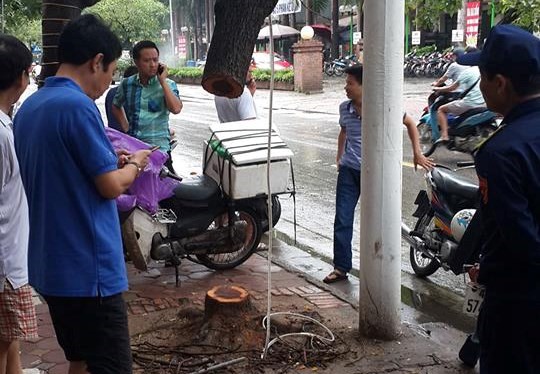 Illustrative Photo. Several public dalbergia tonkinensis trees have been illegally logged in Hà Nội. Hà Nội Police on Thursday announced that they arrested a group of six loggers for illegally chopping down public sưa (dalbergia tonkinensis) trees. According to the police report, on July 27, the city Criminal Police Department started investigating six suspects: Lê Văn Trọng from Từ Sơn District in Bắc Ninh Province, Nguyễn Văn Tư from Thanh Oai District in Hà Nội, Phạm Văn Hùng from Tiên Du District in Bắc Ninh Province, and Đỗ Văn Khương, Lê Văn Phúc and Đỗ Quốc Tuấn from Văn Lâm District in Hưng Yên Province. This six were found to have committed illegal logging activities in Hà Đông District on July 21. They cut down a sưa tree in front of Đoàn Kết High School, chopped it into pieces, transferred it to Từ Sơn District, Bắc Ninh Province and sold it for VNĐ56 million to an acquaintance of Trọng. The miscreant loggers also sawed another sưa tree at Ngũ Hiệp Commune Institute of Medicine in Thanh Trì District, Hà Nội. The force is still investigating the case. The Dalbergia tonkinensis is a type of tree commonly planted along Hà Nội’s streets. It is featured in the International Union for the Conservation of Nature’s Red List of Endangered Species and ranked as vulnerable. In Việt Nam, Dalbergia tonkinensis trees are well-known for their quality and high value. Police seize illegal mooncakes 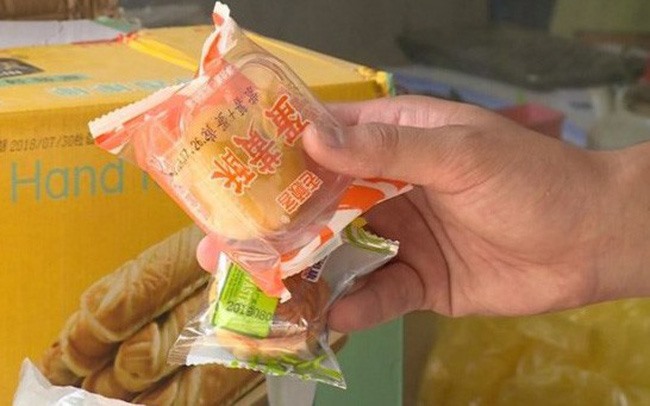 Each cake costs VNĐ2,000-3,000 (US$0.13), which is a fifth or a sixth the price of a similar cake. — Photo cafef.vn Some 10,000 illegally traded mooncakes were seized by the Hà Nội Market Watch Unit at a store selling agriculture products in Hoài Đức District on Wednesday. According to the unit, no items in the batch included production dates, receipts or certificates of origin, but the labels on the products showed that they were illegally traded. Each cake cost VNĐ2,000-3,000 (US$0.13), which is a fifth or a sixth the price of a similar cake. The owner of the batch admitted this was his third batch in the last two weeks. The cakes would be sold on Zalo, a mobile messaging application. The market watch unit said for illegal food trades, they normally apply fines based on the value of the goods, but in this case, the cost is so low that the fines would not be strict enough. National Young Informatics contest held in Bà Rịa-Vũng Tàu 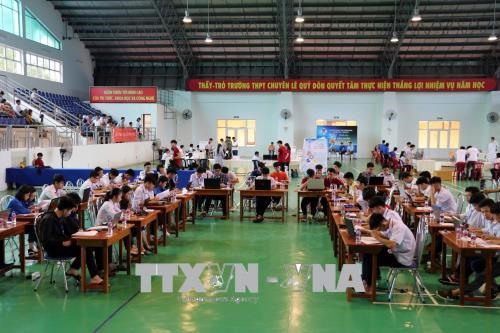 The National Young Informatics Contest aims to contribute to the development of young talent for the IT field. The annual National Young Informatics Contest for students is being held at Lê Quý Đôn High School in Bà Rịa-Vũng Tàu Province from August 9-10. The contest this year has 257 contestants in the first to 12 grades from a total of 51 cities and provinces. The contest’s organisation committee has selected 30 of 106 innovative products to join the final. The contest aims to contribute to the development of young talent for the field of information and technology. According to the organisation committee, this year the contestant’s products are diverse with many good products and high applicability. The quality of products is better than in the previous year, especially hardware. In addition, the technologies used in the products vary, which reflects the adoption of the latest technologies by many students. This year, the organisation committee added Scratch programming language so that contestants could create products for daily living, such as a smart trash bin, salt intrusion warning system, and products to support people with disabilities. The National Young Informatics Contest, which began in 1995, was held by the Ministry of Science and Technology, Ministry of Education and Training, Ministry of Information and Communication and Việt Nam Association of Information and Technology. Endangered sea turtle released in Đà Nẵng  An endangered green turtle (Chelonia mydas) was released to the sea in Đà Nẵng. — Photo courtesy Đà Nẵng Agriculture and Rural development department An endangered green sea turtle (Chelonia mydas) has been released to the sea after being captured and kept at a house in the central city, a source from the city’s sub-department of Aquatic Resource Protection said yesterday. The source said the turtle, which had been kept in an aquarium belonging to a family in Sơn Trà peninsula, was healthy when it swam back to the ocean. The sub-department said the green turtle was listed as an endangered species by International Union for Conservation of Nature (IUCN) and the Convention on International Trade in Endangered Species of Wild Fauna and Flora (CITES). The Red Book of Việt Nam also named the turtle as a threatened species in need of special protection. In July, the sub-department released another sea turtle after it was caught in a fishing net. According to Lê Xuân Ái, an expert in sea turtle conservation from the Chàm Island’s Marine Protected Area (MPA) management board, several beaches in central coastal Việt Nam, including Thừa Thiên-Huế, Đà Nẵng, Quảng Nam and Quảng Ngãi are popular destinations for turtle reproduction. But rapid urban development, the speedy construction of beach resorts and hotels, the overexploitation of seafood and extensive pollution had destroyed their habitats. Chàm Island, off the coast of Quảng Nam Province, was the first location in central Việt Nam to begin a sea turtle conservation project by hatching eggs to repopulate local turtle populations. Việt Nam has five species of sea turtles living in waters off the islands of Trường Sa (Spratly), Hoàng Sa (Paracels), Bạch Long Vỹ, Thổ Chu and Cô Tô and provinces of Quảng Ninh and Quảng Trị, and from Quảng Nam to Phú Yên. VNN |
↧
Article 0
BUSINESS NEWS IN BRIEF 14/8 Hong Kong calls for investment from Vietnam Hong Kong is currently an ideal destination for Vietnamese firms to expand operations abroad, heard a round-table seminar in Ho Chi Minh City on August 13. Vo Tan Thanh, Director of the Vietnam Chamber of Commerce and Industry (VCCI)’s Ho Chi Minh City Branch, held that Vietnam and Hong Kong are key major trade partners of each other with bilateral trade reaching 9.2 billion USD in 2017, up 22 percent from 2016. As of June 2018, Hong Kong was the sixth largest foreign investor in Vietnam with a total capital of nearly 19 billion USD, he said. With the ASEAN-Hong Kong free trade agreement, trade and investment between Vietnam and Hong Kong are both expected to grow fiercely in the near future. Vietnam is encouraging firms to expand investment abroad to popularise Vietnamese products across the world. Thanh hailed Hong Kong as a free, developed economy with a strategic location, modern infrastructure, and large capital inflows. According to him, if Vietnamese enterprises venture onto this market, they could access a massive capital source and tap into one of the world’s busiest seaports, thereby bringing goods to even further markets. Stephen Phillips, General Director of Investment Promotion at Invest Hong Kong (IK), said Hong Kong is calling for investment in the fields of financial services, consumer goods, transportation and industry, tourism-restaurant-hotels, technological innovation, and innovative industries. He lauded Hong Kong for its active international business environment, convenient business registration procedures, modern infrastructure, and low tariffs, adding that it now has a mechanism to provide support for newly-established and mature firms, from planning and opportunity evaluation to visa application and marketing. Phillips said business opportunities in Hong Kong are widespread for Vietnamese enterprises. However, other issues should be considered, including high office rent, workforce costs, and intense competition with other multinational corporations, he noted. Therefore, the IK representative suggested opening sales, marketing, and financial offices in Hong Kong to tap into existing advantages in managing supply chains, while placing logistics facilities and warehouses elsewhere in order to save costs. Vietnam’s mooncakes shipped abroad for traditional festival  A sophisticatedly designed box of mooncakes (Photo: Metropole Hanoi) A large volume of Vietnamese mooncakes will be shipped to foreign markets in the next few weeks as the traditional Mid-Autumn Festival is on the horizon. Mondelez Kinh Do, an affiliate of Mondelez International, announced on August 13 that its mooncakes are now present in the US, as well as ready to serve millions of consumers in Vietnam and other Asian countries for the upcoming festival, celebrated on the 15th day of the eighth lunar month or September 24 this year. The cakes destined for the US are favoured by many Vietnamese there, especially those made with fillings of durian, lotus seeds, green tea, red bean, and mung bean. Bui Thi Thanh Huyen, Deputy General Director for Marketing at Mondelez Kinh Do, said each year, the firm plans ahead early in order to produce mooncakes that can serve Vietnamese expatriates in the US as well as its domestic consumers. Aside from the US, it will also export Oreo branded mooncakes to the Asian markets also observing this tradition such as in China, Singapore, and Thailand, she added. Kao Sieu Luc, General Director of ABC Bakery Co. Ltd, said his company has received an order for 60,000 high-quality mooncakes from US partners. It will supply at least 2.5 million cakes in total, or 500 tonnes, for the Mid-Autumn Festival next month, he said, adding that the business had sold two million last year. Apart from foreign markets, the two producers as well as their rivals Bibica, Dong Khanh, and Nhu Lan have also enhanced efforts to meet domestic consumers’ rising demand for newer designs, flavours, and packaging. HCM City to host Vietfish expo later this month The Vietnam Fisheries International Exhibition (Vietfish) 2018 will be held at the Saigon Exhibition and Convention Centre from August 22-24, the Vietnam Association of Seafood Exporters and Producers (VASEP) has announced. Vietfish 2018 will be the largest since the event was launched 20 years ago. It will feature 374 stalls, an increase of 3.6 percent compared to last year, with firms from 14 countries and territories, 66 percent will be Vietnamese. On display will be aquaculture and services, machinery, chemicals, additives and cold storage equipment. Last year’s expo, themed “Asia’s Home of Seafood", featured over 350 booths showcasing seafood products and machinery and equipment for aquaculture by over 200 exhibitors from Vietnam and foreign countries, such as Japan, China, Thailand, Singapore, Malaysia, Germany, and Denmark. A series of activities also took place on the sidelines of the exhibition, including a cooking show, launches of new products and an aquaculture seminar. Vietnam gained its highest ever seafood export value of 8.32 billion USD in 2017, a year-on-year increase of 18 percent, according to the Ministry of Agriculture and Rural Development. The US, Japan, China and the Republic of Korea were the top four export markets for Vietnamese seafood products, accounting for 55.3 percent of the total national export value. Vietnam’s export markets with strong growth in seafood export value included China (up 64.4 percent), the Netherlands (up 48.6 percent), the UK (up 36.4 percent), the Republic of Korea (up 29.1 percent), Canada (up 22.3 percent) and Japan (up 20 percent). The country’s export of aquatic products maintained a two-digit growth in the first half of 2018 and was forecast to continue growing strongly in the rest of the year despite plunging shrimp prices across the world. Seafood exports reached a value of nearly 4 billion USD during the reviewed period, up 12.3 percent year-on-year, according to the VASEP. Hanoi’s export value up 29.2 percent in seven months Hanoi’s export turnover in July was estimated at 1.32 billion USD, up 2.3 percent against June, and 29.2 percent higher than the same period last year. In the month, export revenue of farm produce increased 108.6 percent year-on-year; oil and gas 94.9 percent; and machines and equipment 14.6 percent. Meanwhile, footwear and leather product saw their export value decrease 10.8 percent; and vehicles and spare parts, down 22.1 percent. During the first seven months of this year, the capital city’s total export turnover reached more than 7.74 billion USD, a year-on-year rise of 17.3 percent. This was mainly contributed by agricultural products, up 45.6 percent; electronic products, 17.8 percent; computer components and peripheral devices, 13.7 percent; oil and gas, 28.8 percent; and vehicles and spare parts, 13.1 percent. Only export value of footwear and leather products contracted by 2.4 percent. In July, Hanoi’s import turnover was over 2.66 billion USD, down 2.1 percent from the previous month but up 6.8 percent year-on-year. Import revenue of iron and steel rose 21.3 percent over the corresponding time last year; chemicals 46.2 percent; plastics 25.5 percent; and oil and gas 29.5 percent. During the January-July period, the city imported about 17.73 million USD worth of goods, a year-on-year rise of 7.3 percent, mainly chemicals, up 25.8 percent; plastics 24.1 percent; and oil and gas 33.1 percent. - Investors eye wind power development in Soc Trang The Mekong Delta province of Soc Trang will prioritise investors with technical and financial capacity to implement wind power projects in the province, according to local officials. To date, 69 investors have registered to carry out wind power projects in the province, including 16 joint ventures, 24 foreign and 29 domestic firms. Meanwhile, Soc Trang has planned to build an area for wind and solar energy development with total capacity of more than 3,000MW. The province has zoned off 12 locations for wind power development, mostly in the coastal localities of Vinh Chau township and Tran De and Cu Lao Dung districts. Vice Chairman of the provincial People’s Committee Le Thanh Tri said the province will ensure transparency in selecting investors for wind power projects. Vinh Chau township, which boasts a coastline of 43 kilometres, is home to 22 locations planned for wind energy development. One project was recently launched in the locality. With average wind speed measured at high levels of 6-6.4 m/s, Soc Trang holds great potential for large-scale wind power development. Projects in this sector are hoped to contribute to national energy security and shifting the economic structure of the province.- Gia Lai revokes hydropower investment licence 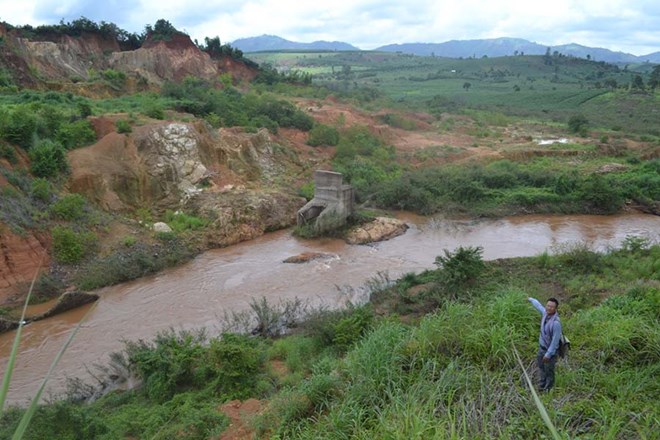 The Department of Planning and Investment of the Central Highlands province of Gia Lai has decided to withdraw the investment licence of la Krel Hydropower Plant in Duc Co district due to violations of the Investment Law. In 2008, the provincial People’s Committee granted an investment license for plant investor Bao Long Gia Lai Industries and Hydropower Joint Stock Company to implement the project, with total investment of about 120 billion VND (more than 5.1 million USD). The 5.5MW hydropower plant was built in Duc Co District in late 2009 and began storing water in early 2013. However, during the process of construction, the investor was not fully qualified to implement the project in accordance with their commitments. It did not follow regulations on design and construction for the dam. Even in 2013 and 2014, the two dam breakages occurred in the construction site, causing serious impact on the lives of locals. The company was advised to build the dam during dry months between April and June, but it ignored this advice. Local agencies were required to find out who was responsible for the breakages, in addition to estimating damage so locals could be compensated. Based on the opinions of relevant authorities, the provincial Department of Planning and Investment informed that it will revoke the investment license for the project, and asked the investor to end all activities related to the project and carry out asset liquidation. Ministries to promote GI products 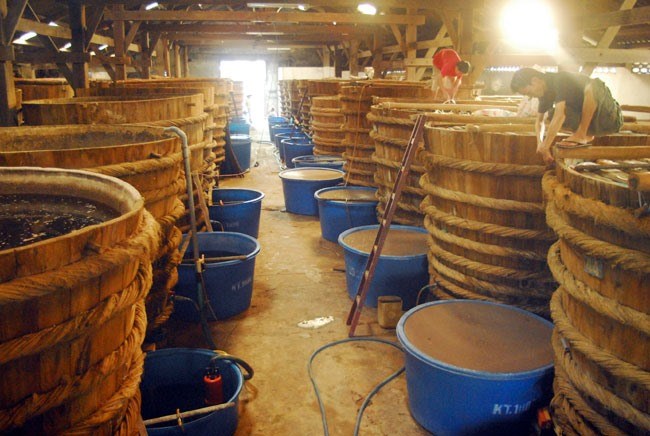 The Industry and Trade (MoIT), the Agriculture and Rural Development (MARD) and the Science and Technology (MoST) have signed a coordination agreement on construction and management of geographical indication (GI). The coordination is important as it lays the foundations for the three ministries to coordinate and improve State management, enhance efficiency in GI, as well as increase value of protected products and competitiveness of Vietnamese products in the world market, leaders of the three ministries said. According to Deputy Minister of Science and Technology Pham Cong Tac, ending July 2018, Vietnam has a total of 68 GI-registered products, of which 62 are national and six are foreign GI products. GI-registered products have expanded from fresh foods such as fruits, seafood, rice, to processed products such as fish sauce, shrimp sauce and handicraft merchandise such as Hue conical hats, Nga Son sedge mat and Cao Bang tortoise-shell bamboo. GI is a name or symbol used on products which have a specific geographical location or origin and possess qualities or a reputation that are related to that origin. GI is increasingly proving its importance in agricultural and rural development, contributing to the preservation of traditional cultural values, development of production activities and trade, as well as improving the added value of Vietnamese agricultural products, Tac said. Deputy Minister of Agriculture and Rural Development Tran Thanh Nam also emphasised the importance of GI protection, saying GI labelling will benefit consumers as the products will be ensured in terms of origin, quality and trust. At present, producers, including farmers and cooperatives, are aware of the necessity of GI registration as they understand that GI-registered products will have much higher value, Nam said. Deputy Minister of Industry and Trade Do Thang Hai said many localities, enterprises and trade associations do not have full awareness of importance of trademark, GI registration and intellectual property rights (IP). He recalled the loss of Buon Ma Thuot coffee in China’s market due to no GI registration. In the past, the State and local authorities have developed and put into practice programmes and solutions to support GI registration such as support programmes for IP development and brand development for local specialties. In the future, the three ministries will coordinate to develop a legal framework for GI registration and protection, implement GI law and policy, and collaborate to detect, prevent and handle GI infringements. An advisory council will be established to advise ministers on building and managing GI law. The coordination between the three ministries will promote the expertise, human and financial resources of each ministry and at the same time create synergy in the law construction and management, the ministries said. Vietjet partners up with Can Tho in promoting tourism Low-cost carrier Vietjet Air will partner up with Can Tho to promote tourism in the Mekong Delta city. Vietjet and the city’s People’s Committee signed a Memorandum of Understanding to this effect during an investment promotion event hosted by Can Tho on August 10. Under the deal, the two sides will work together to expand the network of aviation services between Can Tho and other destinations, especially international flights, thus helping the city develop tourism, trade and attract investment. On the occasion, the carrier was awarded an insignia by the Can Tho People’s Committee in recognition of its contributions to and investment in local development. Vietjet began to operate flights to Can Tho in 2014, and at present it is running two domestic services between Can Tho and the capital city of Hanoi and the central city of Da Nang. At peak time, there are five flights daily to Can Tho from the two cities. Vietjet Air is the first airline in Vietnam that operates a low-cost, modernized carrier model to provide a wide range of services to its customers. With 60 A320 and A321 aircraft, the carrier runs over 380 flights per day to 94 domestic and international destinations. Meanwhile, Can Tho is at the centre of the Mekong Delta, which is designed to be one of the seven key tourism regions of Vietnam under the master plan for tourism development until 2020 with a vision to 2030. The city has an international airport, which is currently underused. In the first seven months of this year, Can Tho served more than 5.2 million visitors, and the figure for the entire year is estimated to surpass 8 million. Da Nang introduces exclusive offers to woo investors 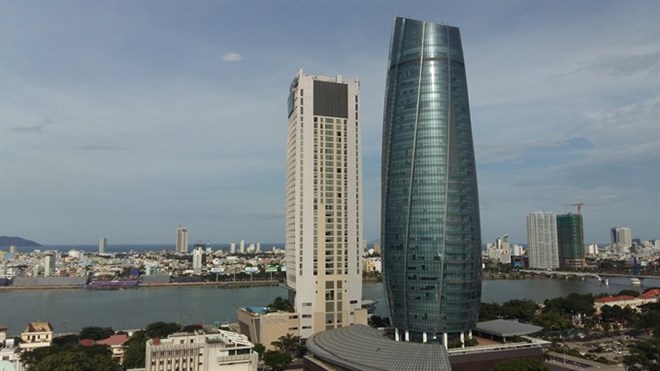 The central city of Da Nang has introduced a number of open-door policies to lure investors in 2018, which has been set by the city as a year of investment attraction. Accordingly, investors setting up new projects at Da Nang Hi-tech Park will be subject to a favourable corporate income tax (CIT) rate of 10 percent for 15 years, compared to the standard rate of 20 percent. Those investors with projects valued at 3 trillion VND (133 million USD) or more will enjoy the preferential CIT rate for 30 years. Other specialised incentives include a four-year tax exemption and a 50 percent cut in income tax for the following nine years for new projects in the high-tech park. At Da Nang IT Park, domestic investors will be offered land-use fee exemptions, with foreign investors given land-rent exemptions, for the operation of projects involving initial construction of technical infrastructure in the area. Projects in IT research and development (R&D) and human resources training will be granted land-rent exemption for two years and a 50 percent cut in rent rates for the next three years. In addition, the resort city encourages private investment in the fields of education and vocational training, healthcare, culture, sports, environment and judicial assessment. Any project in these fields established on Hoang Sa island and in Hoa Vang district will also be subject to land-rent exemption. The 1,100ha Da Nang Hi-tech Park is located in Hoa Vang district, 20km west of the city. It is envisioned as a hub for high-tech and green investors, and one of three major multi-functional high-tech parks in the country along with HCM City and Hanoi. The first phase of development, covering 300ha, has been completed. Work on the second phase, estimated to cost 363 billion VND (16 million USD), has begun. The park is situated near the Da Nang-Quang Ngai Expressway, connecting it with the Chan May Economic Zone in Thua Thien-Hue, the Chu Lai Economic Open Zone in Quang Nam, and the Dung Quat Economic Zone in Quang Ngai. The Da Nang IT Park was recognised as a centralised information technology centre, the third of its kind, last year. The 10,000sq.m park, comprised of two buildings in the city’s downtown area, is home to 75 IT businesses, including 22 foreign companies. By the end of 2017, it attracted nearly 1.8 trillion VND (80 million USD) in investment and employed 2,400 people. Da Nang aims to have a GRDP growth of 9-11 percent and a per capita GRDP ranging between 7,000 USD and 9,000 USD by 2030. It also hopes to achieve smart city status by 2020 and green city status by 2025. The city has been striving to lure more investors to aid its implementation of these goals. Automatic customs management system applied at Cai Lan Port The Customs Department of the northern province of Quang Ninh officially debuted its automatic customs monitoring and management system at Cai Lan seaport on August 10. Having operated a trial run nearly one month, the system has so-far handled customs procedures for more than 5,000 import and export containers and over 450,000 tonnes of cargo transported via Cai Lan Port. The system is reported to have brought practical effects to importers and exporters, the port operators, shipping companies, and the customs agency. In particular, it has helped to reduce paperwork, the time needed for customs clearance and goods storage at the port, and expenses for importers and exporters. It has also improved the efficiency of companies’ operations and the customs agency’s management. [Automated customs system launched at Noi Bai airport] The application of this automatic system is a move towards modernising customs management and facilitating trading activities in Quang Ninh. The provincial Customs Department also pledged to implement similar systems in the remaining ports and import-export goods storage facilities in the province during the third quarter of 2018. It reported that in 2017, the value of goods imported and exported through local seaports was 5.45 billion USD. The provincial seaports also collected 10.3 trillion VND (442.8 million USD) for the State budget. In the first seven months of the year, seaport trade turnover in Quang Ninh reached 3.34 billion USD, up 8.2 percent from the same period of 2017. More than 5.8 trillion VND (249.3 million USD) was also collected by the seaports for the State budget, accounting for 92 percent of Quang Ninh’s total budget revenue. Tra Vinh: Over 144 million USD invested in wind power plant 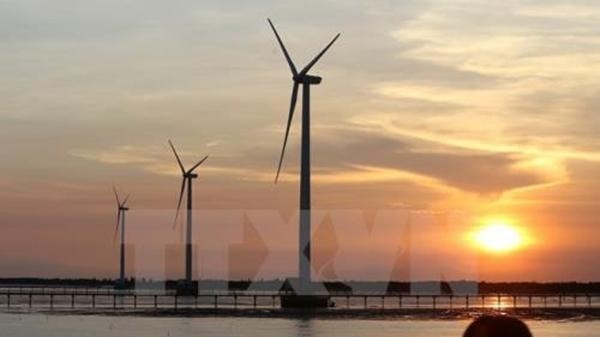 Authorities of the Mekong Delta of Tra Vinh have approved an investment of close to 3.37 trillion VND (144.3 million USD) in the Hiep Thanh wind power plant from three investors. The investors are the Hanoi-based Ecotech Vietnam company, Janakuasa Singapore Pte, Ltd, and Lam Minh – a resident in Ba Dinh district of Hanoi, who plans to set up a company in Tra Vinh to implement the project. Scheduled to become fully operational in 2020, the 2.747-ha project is located in a coastal area in Hiep Thanh commune, Duyen Hai town. Its designed capacity is at 78 MW with 18 or 19 wind poles. According to Nguyen Quynh Thien, deputy head of the Tra Vinh economic zone organising board, this is the fourth wind power projects licenced by the local authorities. Previously, Tra Vinh approved three other projects in Truong Long Hoa commune, Duyen Hai town, and Dong Hai commune, Duyen Hai district, with a combined capacity of 192 MW. All of them are under administrative verification process before construction starts. In a plan to develop the green energy by 2020, Tra Vinh mapped out the building of six projects in six coastal areas in Duyen Hai district and town. By 2020, the province expects to have an accumulated wind power capacity of 270 MW for a total productivity of 634 million kWh. Vietnam’s tea exports still in downtrend  Vietnam earned 109 million USD from exporting 67,000 tonnes of tea in the first seven months of 2018, a year-on-year decrease of 12.9 percent in volume. According to the department of farm produce processing and market development under the Ministry of Agriculture and Rural Development, in July alone, the country shipped 10,000 tonnes of tea abroad, earning 18 million USD. The fall in the volume of exported tea was attributed to low demand of main importers. Specifically, the volume of Vietnamese tea exported to Russia – a major importer of Vietnam – decreased by 1,230 tonnes or 14.3 percent of Russia’s total import, to the United Arab Emirates down 1,190 tonnes or 57 percent and Indonesia down 427 tonnes or 8.7 percent. Pakistan remained the largest importer of Vietnamese tea. The export value earned from this market accounted for 32.1 percent of Vietnam’s tea export turnover, or 29.9 million USD, in the first half of this year. It was followed by China’s Taiwan, Russia, China, Indonesia and the United States. Vietnam is now the seventh biggest tea producer in the world and the fifth biggest exporter of the product, said the department. More than 500 tea factories are operational in the country. Together they produce more than 500,000 tonnes of dried tea leaves annually. Vietnamese banking development strategy till 2025 approved 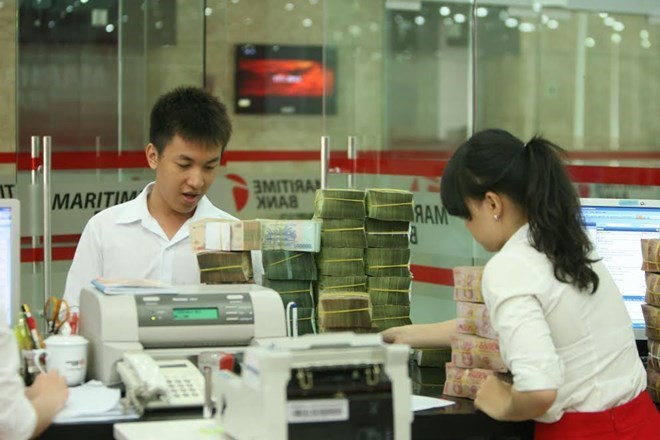 The Vietnamese banking development strategy till 2025 with vision to 2030 has been approved by the Prime Minister under Decision No.986/QD-TTg. The strategy sets the goal of improving independence, activeness and accountability of the State Bank of Vietnam (SBV) for directing monetary policy, controlling inflation, supporting macro-economic stability and fuelling sustainable economic growth. It also looks to strengthen institutional capacity and banking supervision of the SBV, expand its scope of supervision into financial corporations with parent ones. It will follow Basel banking supervision rules by late 2025. The rate of cash among all means of payment is set to be below 10 percent by late 2020 and 8 percent by late 2025. The strategy also aims to enhance public access to financial and banking services, especially in rural, mountainous and poor areas. To that end, it outlines key measures such as refining legal framework on monetary market and banking in line with international practices, renewing management of foreign currencies and gold, developing and monitoring important payment systems in the economy, improving the efficiency of banking inspection, developing modern banking services, and enhanceing access to banking services. Vinfast, Siemens sign deals for electric bus manufacturing Vinfast Manufacturing and Trading Company Limited, a subsidiary of Vingroup, has signed two contracts on the supply of technology and spare parts for electric bus manufacturing with Siemens Vietnam Company. They are key deals to begin the process of building a value chain for eco-friendly public transportation vehicles manufacturing. The first line of electric buses is expected to debut in late 2019. Vinfast is also developing other eco-friendly personal vehicles such as electric motorbikes and automobiles, and autos (sedan, SUV) that run on petrol meeting Euro 5 emission standards. Vo Quang Hue, Deputy General Director of Vingroup in charge of Vinfast project, said the deals reflect Vinfast’s commitment to churning out safe, convenient and high-quality electric buses for a green future of the Vietnamese people, adding that it will be a pioneering solution to changing public transportation in the country. Nearly one year since its establishment, Vinfast has completed a series of important agreements with international partners to materialise its vision. Earlier, Vingroup also chose Siemens as a partner for the supply of technological solutions to building digital enterprises, build a system to monitor vehicles’ life cycle and operate Vinfast factory amidst the fourth industrial revolution. Tien Giang to expand dragon fruit growing area The Mekong Delta province of Tien Giang is expanding its specialised growing zone for dragon fruit, a fruit that has helped several local farmers become rich. According to Huynh Van Buon, head of the agricultural and rural development bureau of Tan Phuoc district, the district has been growing the fruit for only a few years, but has nearly 600ha under the fruit, mainly red-flesh dragon fruit. Around 350ha of the latest crop have been harvested, yielding 7,000 tonnes, he said. The communes with the largest areas planned now are Tan Lap I with 172ha, Thanh Tan (120ha), Thanh My (60ha), and Tan Hoa Dong (40ha). Nguyen Van Ro, Chairman of the Thanh Tan People’s Committee, said the fruit has become his once sleepy commune’s key economic product thanks to its economic value and demand in foreign markets. Farmers growing the fruit can now rely on it for their main income, he added. One such farmer is Phan Van Khanh, who owns a 1.5ha red-flesh dragon fruit orchard. It produces 30 tonnes of the fruit per hectare per season. Thus, this year he has earned around 1 billion VND (44,000 USD) from selling 30 tonnes of the fruit at an average price of 30,000 VND per kilogramme. He has become rich thanks to the fruit. Vo Van Dung of Thanh Hoa commune, Tan Phuoc district, also has a 1.5ha orchard. Last year, he harvested 40 tonnes and earned 1.2 billion VND as the fruit’s price soared to 46,000 VND per kilo. He said the fruit can help locals become rich. Cat Tuong Company, an agricultural processing firm in Tan Phuoc, grows red-flesh dragon fruit to global good agricultural practices (GAP) standards on 100ha due to the high yields and export demand. Buon said the soil of the Plain of Reeds region (which spans Long An, Tien Giang and Dong Thap provinces) is extremely suitable for growing dragon fruit. He said to increase productivity and quality for export, the district would send technical staff to train farmers in the application of global GAP standards. Besides, the district has helped farmers establish cooperatives and farmers groups to build a value chain for dragon fruit, he said. The fruit has dominated Vietnamese fruit exports this year with shipments being worth 427 million USD in the first four months, a year-on-year increase of 9 percent and accounting for 32 per cent of all vegetable and fruit exports. The value was nearly four times that of the next two below it – longan (121 million USD) and mango (104 million USD). Vietnam Airlines team up with Can Tho to develop aviation logistics The People’s Committee of Can Tho city and national flag carrier Vietnam Airlines on August 10 signed an agreement to implement an aviation logistics centre project in the Mekong Delta city. The centre is set to cover about 27ha near Can Tho International Airport. The project aims to improve transportation and trading activities, and promote logistics services in Can Tho and the wider Mekong Delta region. Under the deal, the municipal People’s Committee will create favourable conditions in terms of information and relevant procedures for Vietnam Airlines to carry out the project. Meanwhile, Vietnam Airlines will be swift in processing the necessary studies and surveys to prepare for the project’s takeoff. It has been cooperating with Japan’s Konoike group to assess the feasibility of the logistics centre. Vice Chairman of the municipal People’s Committee Dao Anh Dung said Can Tho is ready to provide information about industrial parks, export processing zones, and goods and material supply areas to help the project’s smooth implementation. Deputy General Director of Vietnam Airlines Trinh Hong Quang said that being tasked with implementing the first in a series of aviation logistics projects proves his firm’s pivotal role in realising the Government’s policy of boosting the development of logistics infrastructure nationwide. He added that amidst the strong annual growth rate of 15-20 percent of the domestic logistics industry, operating logistics centres will become a significant source of revenue for Vietnam Airlines in the coming years. For Can Tho, the new aviation logistics centre will be a critical facility helping to connect the city and the Mekong Delta with other localities in Vietnam and foreign countries. Vietnam Airlines reported that the demand for goods transportation, especially by air, in the country has risen sharply in recent years. In 2017, over 700,000 passengers and 4,000 tonnes of cargo were transported via Can Tho International Airport. Solution promotes e-contracts between businesses The Vietnam e-Commerce and Digital Economy Agency (iDEA) under the Ministry of Industry and Trade on August 8 launched the ERP Store solution with the aim of helping businesses reach the goal of a paperless office. The solution allows enterprises to digitise contract signing — the most important aspect of their trade activities — as well as widely applying e-documents. These could help firms better deploy the advantages of digital technology in their management. The ERP Store which was developed by iDEA allows companies to implement e-contract signing. Accordingly, they only need the tax code and USB token containing a digital signature to implement the signing. Each firm will have four accounts with different roles including drafter, approver, stamper, and director. Dang Hoang Hai, iDEA Director, said previously many businesses used office software. Digitalisation is not new for many firms. However, forging digital connections between companies has been difficult, especially when it comes to signing contracts and documents. Meanwhile, enterprises have been using paper documents, costing time and money as well as creating security issues. The ERP solution would help firms quickly connect with each other and sign contracts while ensuring security as all information is encoded. Legally, the regulations for electronic signatures are now complete. Specifically, the Government promulgated the Law on Electronic Transactions on November 29, 2005; Decree No 26/2007 / ND-CP of February 15, 2007, detailing the implementation of the Electronic Transaction Law on digital signatures and digital signature certification services. In addition, e-contract signing was also confirmed by the master plan on development of the national e-commerce in 2016-20 period dated on August 8, 2016. The regulations ensure firm legality for e-contracts. Notably, businesses will enjoy the services free of charge for their first two years using the programme. Hanoi has over 14,000 new businesses in seven months As many as 14,657 businesses were established in the capital city of Hanoi in the first seven months of 2018 with a total registered capital of over 16 trillion VND (687 million USD), down 1 percent in number but up 42 percent in capital year-on-year. Director of the municipal Department of Planning and Investment Nguyen Manh Quyen revealed the information at a recent meeting of the Hanoi People’s Committee. The city attracted nearly 6 billion USD in foreign direct investment (FDI) in January-July, 4.38 times higher than the same period last year. In July alone, Hanoi drew 80 million USD in FDI. The capital granted new investment licences to 55 FDI projects worth 21.1 million USD and allowed 15 existing ones to increase capital of 9.8 million USD. Among the newly licensed are the 4.1 billion USD smart urban area project, two projects of Japanese Nidec Corporation at Hoa Lac hi-tech park with combined investment of 400 million USD, the 92 million USD OPC drum production project of Japan’s Mitsubishi Chemical also at the park, the SYM Catavil Complex project worth 105 million USD, and the 90 million USD Xuan Son waste treatment plant. The Hanoi Lotte Mall project was allowed to add 300 million USD to its capital, and the beer production plant of Heineken Hanoi Brewery, 43 million USD. Quyen reported that Hanoi continued maintaining growth in the seven-month period. Specifically, the city moved up one place to 13th among the 63 cities and provinces in Provincial Competitiveness Index (PCI) and second in Public Administration Reform (PAR) index, he said. The outcomes were attributed to the city’s efforts to lure investment, remove difficulties for businesses and improve business environment. Additionally, the city focused on calling for investment in new projects and asking specialised agencies to support investors in removing bottlenecks during the implementation of projects, he added. Local authorities paid due attention to encouraging the establishment of new businesses and development of the private economic sector. The city also conducted online business registration and ensured the settlement of administrative procedures for businesses, excluding dissolved ones, within three days. Prices of tra fish continue to drop in July Prices of Tra fish in the Mekong Delta continued the downward trend of the previous month to drop in July, according to the Ministry of Agriculture and Rural Development. The highest prices, ranging from 25,000 – 27,000 VND per kg for first-class tra fish, were recorded in the provinces of An Giang, Vinh Long and Dong Thap, a decrease of 3,000 VND from June. However, the prices are forecast to maintain at a level that still generates profit for farmers until the end of this year. Meanwhile, prices of Tra fish fingerlings slightly rose from the previous month, fetching at around 25,000 – 30,000 VND per kg. The Mekong Delta produced about 782,000 tonnes of Tra fish in the first seven months of 2018, a year-on-year increase of 12.1 percent. The biggest contributors included Dong Thap which posted an output of 274,500 tonnes, up 9.4 percent year on year; An Giang, 190,400 tonnes and 17.4 percent; and Can Tho, 95,700 tonnes and 18.6 percent. Vietnam is the world’s largest exporter of tra fish, making up more than half of the global output. From January – July, the country saw a surge of 19.5 percent to 1.18 billion USD in exports of the fish, according to the Vietnam Association of Seafood Exporters and Producers (VASEP). Major buyers of Vietnamese tra fish include China, the US, the European Union (EU), the Association of Southeast Asian Nations (ASEAN), Mexico, Brazil, Colombia, and the United Arab Emirates (UAE). China remained the largest importer of Vietnamese Tra fish with 290 million USD, making up 24.7 percent of the total export turnover. It was followed by the US (250 million USD) and the EU (137.5 million USD). Also in the Mekong Delta, prices of giant tiger prawn were on a rise while those of king prawn remained flat in July. The country’s output of brackish-water prawn was estimated at 345,500 tonnes in the first seven months of 2018, up 11 percent year on year. The amount included 162,200 tonnes of giant tiger prawn and 183,300 tonnes of king prawn. The Mekong Delta contributed 271,300 tonnes, or 78.5 percent of the total output, during the reviewed period. Dong Nai speeds up FDI disbursement The southern province of Dong Nai lured more than 980 million USD in 120 foreign direct investment (FDI) projects in the first seven months of 2018, equivalent to 98 percent of its annual plan. However, FDI disbursement reached only 20 percent of the yearly estimate. Disbursement of major projects registered in 2017 was completed. Meanwhile, that of projects which were newly-approved or registered additional capital in early of this year remains slow. The provincial Department of Planning and Investment and the Management Boards of Dong Nai Industrial Parks are tasked with the review and supervision of project implementation and disbursement. Statistics released by the management board showed that in the period, the province collected 397 million USD of tax and other sources from FDI firms, recording a year-on-year rise by 80 million USD. According to the provincial Department of Planning and Investment, as of July 18, the province recorded 1,820 FDI projects worth 32.8 billion USD, 1,339 of which were valid with a total capital of 27.73 billion USD. The foreign investors were from 45 countries and territories worldwide, with the RoK, Taiwan, and Japan taking the lead. Soc Trang strives to improve business climate Authorities of the Mekong Delta province of Soc Trang have strived to attract investments and organise the prompt handling of administrative procedures, which have yielded significant results. Several major projects have proven themselves particularly effective, such as the Superdong high-speed boat from Tran De to Con Dao; the Nha Be garment factory; as well as the Broadpeak apparel, handbags, and leather shoes factory. Other projects underway include wind power mills in Vinh Chau township and a shrimp breeding factory by Viet-Uc Seafood Corporation. Major corporations such as Vingroup, FLC, and Alphanam are currently seeking opportunities in the locality. The province recently held a conference on investment promotion and launched a startup campaign in 2018, attracting 50 projects with a total registered capital of nearly 123 trillion VND (5.5 billion USD), mostly in the fields of wind power, high-tech agriculture, and tourism. Tran Van Chuyen, Chairman of the provincial People’s Committee, said that in order to further improve the business climate, the province will adopt synchronous measures, including improving the provincial competitiveness index for 2018 and the following years, as well as being flexible in handling administrative procedures and dealing with barriers facing businesses. Soc Trang is working to put a public administration centre into operation, he said, adding that the province will also accelerate the progress of key projects so as to attract more investment. Further attention will also be paid towards protecting the environment and ensuring the livelihoods of locals, he said. He affirmed that the province will not sacrifice the environment and stability of local lives in order to attract investment at any cost. VNN |
↧
↧
Article 3
Chinese investors flock to Vietnam to develop coal-fired thermopower plants Many coal-fired thermopower projects have been proposed recently despite environmentalists’ call to stop developing thermal power. Most of them are Chinese invested. 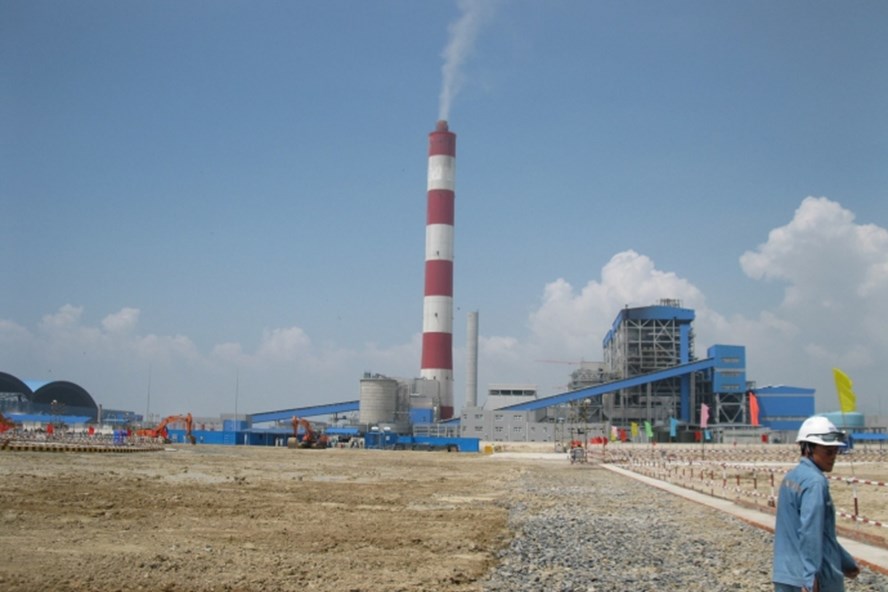 There are 19 BOT thermopower projects developed by foreign investors A report of the Ministry of Industry and Trade (MOIT) said there are 19 BOT thermopower projects developed by investors from all over the world, including the US, Japan, South Korea, Malaysia, Singapore, Thailand and China. Of these, Chinese hold the controlling stake in three projects, namely Vinh Tan 1, Vung Ang 2 and Vinh Tan 3. The Vinh Tan 1 – Binh Thuan was developed by China Southern Power Grid (CSG) which holds 55 percent of capital, China Power International Holding (CPIH) and Vietnam’s Vinacomin. The project kicked off in June 2015. It is expected that the power generator unit No 1 would be put into commercial operation on December 16, 2018 and No 2 in June 2019.
In Vung Ang 2 project, Hong Kong’s One Energy holds 48.45 percent of capital. The other two investors are Vietnam’s Lilama and REE. However, they are seeking MOIT’s permission to let One Energy become the only investor of the project. In January 2017, MOIT and investors signed the investment agreement for the project. However, the agreement still has not taken effect as some problems remain unsolved. The electricity buy/sell contract has been initialed by the Electricity of Vietnam (EVN) and investors. One Energy also contributes 55 percent of the Vinh Tan 3 – Binh Thuan’s capital, with EVN 29 percent and IPP 16 percent. The plant is expected to become operational by the third quarter of 2023. The electricity generator unit No 2 would be put into operation in the first quarter of 2024. Chinese also make investment in other thermopower projects, where they do not hold the controlling stake. These include Mong Duong 2, developed by Americans, the biggest capital contributor, and South Korean and Chinese. In Mong Duong 2, CIC from China only holds 19 percent of shares. The plant became operational in April 2015. Most recently, MOIT consulted with ministries about the plan to transfer Long Phu III project from PetroVietnam to Chinese investors. The ministry revealed that one investor and one group of investors have expressed their willingness to develop Long Phu III. The Chinese investor is a familiar name – CSG, one of two Chinese state-owned power corporations, providing electricity to five southern provinces in China. By September 2017, it had provided 33.4 billion kwh of electricity to Vietnam. MOIT has recently suggested the Prime Minister to assign the Quynh Lap 1 project to Geleximco (Vietnam) and Hong Kong United Ltd (HUI) instead of Vinacomin. Sources said that this is just one of many projects the joint name targets to. VNN |
↧
Article 2
BUSINESS NEWS IN BRIEF 15/8 Over VND96 trillion of G-bonds mobilised The State Treasury of Viet Nam has raised a total of VND96.251 trillion (US$4.13 billion) via auctions of Government bonds at the Ha Noi Stock Exchange (HNX) since the beginning of the year. At an auction this week, the State Treasury mobilised VND3.95 trillion from five-year and seven-year bonds worth VND500 billion each and 10-year bonds and 15-year bonds worth VND2 trillion each. The interest rate of bonds increased slightly. Bonds with 10-year maturity raised VND1.55 trillion with an annual interest rate of 4.53 per cent, up 0.03 percentage points from the previous auction on August 1. A sub-session auction of 10-year bonds drew VND600 billion with the yearly interest rate of 4.53 percent. Those with a 15-year term attracted VND1.2 trillion with an annual interest rate of 4.81 per cent, up 0.03 percentage points in comparison with the rate of the previous auction on July 25, 2018. As much as VND600 million was mobilised from 15-year bonds at the sub-session auction with an interest rate of 4.81 per cent per year. No bonds of five-year and seven-year terms were sold. BIDV succeeds in $18 million bond issue The Bank for Investment and Development of Việt Nam (BIDV) has recently issued 10-year and 12 year-bonds worth a total of VNĐ430 billion (US$18.29 million). The interest rate on 10-year bonds, which totalled VNĐ300 billion, is floating and determined by the reference interest rate (the 12-month saving deposit rate of Agribank, Vietcombank, BIDV and VietinBank) plus 1 per cent. 12-year bonds have a fixed interest rate of 7.7 per cent in the first seven years. After that time, the rate rises to 8.2 per cent providing BIDV doesn’t repurchase the bonds. These are all non-convertible bonds unsecured by property. The proceeds will be used to supplement BIDV’s capital and improve its financial capacity. Increasing capital is one of the most urgent tasks for banks at the moment, especially State-owned banks, because if they cannot do so before 2020, their capital adequacy ratio (CAR) will fall below the minimum level stipulated by the State Bank of Việt Nam (SBV) and under Basel II norms – a set of banking laws and regulations issued by the Basel Committee on banking supervision to enhance competition and transparency in the banking system and make banks more resistant to market changes. However, raising capital has not been easy as banks are struggling to find foreign investors while they are not allowed to hold on to dividends to increase capital, so some banks have decided to issue bonds. In July, the Việt Nam Bank for Industry and Trade (VietinBank) also announced that it had successfully issued bonds worth more than VNĐ2.43 trillion, bringing the bank’s total issued bonds to some VNĐ30.92 trillion. VietinBank’s bond interest rate is floating and determined by the reference interest rate plus 0.8 per cent. These are also non-convertible bonds unsecured by property. VPBank plans to issue 33.7 million ESOP shares Vietnam Prosperity Joint Stock Commercial Bank (VPBank) plans to issue nearly 33.7 million shares for its employees in the form of an employee stock ownership plan (ESOP) at the price of VND10,000 per share. VPBank said in its statement that the bonus shares will be unavailable for trading for three years from the issuance date. VPBank has not decided on its issuance date but the bank expects to gain the approval of the State Securities Commission to issue the bonus shares in 2018. After the issuance, if its employees cannot absorb all the bonus shares, VPBank will sell the remainder at a rate above VND10,000 (US$0.44) per share or terminate the remaining amount of shares and only record the number of shares sold to employees. VPBank is trading a total of 2.42 billion shares on the equity market, equal to VND24.2 trillion in charter capital. The figure includes 1.82 billion shares being listed on the HCM Stock Exchange with code VPB and 73.2 million treasury shares. The coming ESOP share issuance is expected to raise the bank’s charter capital by VND337 billion to VND24.56 trillion. In the first six months of the year, VPBank recorded VND293 trillion worth of total assets, an increase of 6 per cent from the beginning of the year. Its net revenue rose 28 per cent year on year to VND14.5 trillion in the first half of the year, accounting for 43 per cent of its full-year target. The bank estimates its combined pre-tax profit in the first six months may be up 34 per cent year on year to VND4.37 trillion, equal to 40 per cent of its full-year target. VPBank shares ended Monday at VND27,150 per share, up 1.3 per cent from last week’s end level. Decree on State Capital Management Committee to be issued next month The Government will issue a decree regulating the functions, duties, rights, and organisational structure of the State Capital Management Committee next month, said Deputy Prime Minister Vuong Dinh Hue. The committee will manage State capital and assets at 20 corporations and groups. The corporations and groups have a total State capital of VND821 trillion (US$36 billion) and total value of assets at over VND1.5 quadrillion, equal to 50 per cent of the total State capital and assets at the country’s State-owned enterprises (SOEs). According to the draft decree released in May, the committee will have a chairman and at most four vice chairmen who are appointed and dismissed by the Prime Minister, in accordance with the law. It will have nine departments, including the Department of Agriculture; Department of Industry; Department of Energy; Department of Technology and Infrastructure; Department of General Affairs; Department of Legislation and Internal Control; Department of Staff Organisation; Administration Office; and the Information Centre. The committee will be responsible to the Government for effectiveness in the use of State capital and assets in SOEs. It will be supervised by the Government, the National Assembly and law-protecting agencies. The establishment of the committee will free up a number of specialised ministries from performing the function of being a managing body of SOEs. As such, these ministries will be able to do a better job in exercising the function of State management across all types of enterprises – such as SOEs, domestic private enterprises, and foreign ones – by creating the best business or investment policies and climate for enterprises to grow. Binh Son Refining’s profit exceeds target Binh Son Refining and Petrochemical Company (BSR) reported post-tax profits of nearly VND3.6 trillion (US$1.5 million) in the first seven months of 2018, meeting 172 per cent of its seven-month target and 103 per cent of the annual target. BSR is a subsidiary of Viet Nam National Oil and Gas Group (PetroVietnam, PVN) and operator of the $3 billion Dung Quat Oil Refinery in the central province of Quang Ngai, the first oil refinery in the country. The company earned VND66.5 trillion in revenue during the reviewed period, equivalent to 113 per cent of the seven-month target and 85 per cent of the annual target. Production output was estimated at 4.139 million tonnes, accounting for 113 per cent of the seven-month plan and 66 per cent of the yearly plan. BSR consumed over 4.114 million tonnes of products, accounting for 113 per cent of the seven-month and 66 per cent of the yearly plan. The company paid special attention to scientific research to increase cost savings for production activities. In the first 7 months of 2018, thanks to these efforts, BSR saved VND560 billion, exceeding the projected value by 16.8 per cent. Of the estimate, the reduction in processing cost was VND495 billion. BSR also researched increasing the capacity of its plant to 118 per cent. Dung Quat oil refinery expansion project is currently underway. The company has completed some main work such as choosing overall front-end engineering design (FEED), payment of compensation for site clearance, the selection of procurement and construction (EPC) contractors as well as the capital arrangement for the project. Foreign investment into Ba Ria-Vung Tau soars 30% The southern province of Ba Ria - Vung Tau has attracted US$2.15 billion of foreign direct investment (FDI) since the beginning of this year, up 30.6 per cent over the same period last year. The province ranks third in FDI attraction in the country. To date, FDI enterprises have invested in 360 projects in the province with a total registered capital of more than $28 billion, according to a report from the provincial Department of Planning and Investment. In addition to attracting new projects, the province has created favourable conditions for existing projects to increase capital. This year, 30 FDI projects have increased capital of more than $320 million. These include projects such as a brewery with a capacity of 610 million litres per year of Heineken Viet Nam Brewery Vung Tau JSC and the Heineken Viet Nam Brewery Limited Company in My Xuan A Industrial Zone in Phu My Town, with a registered capital increase of $96.8 million. The steel pipe project of Nippon Steel & Sumikin Pipe Viet Nam Co., Ltd. increased capital by $4 million, while a plant to produce cooking utensils of Kasmain Viet Nam Co., Ltd. increased capital by $3 million. The province has attracted many large projects in line with its local industrial development planning, including mineral exploitation and processing, textiles and garments, and solar power, according to the province’s Management Board of Industrial Zones. The province is now giving guidance to a number of large investors to complete investment procedures in the province. Le Hoang Hai, director of the province’s Department of Planning and Investment, said the province had set up a working group to support enterprises with investment procedures. In the 2017-2020 period, the province targets attracting 80 FDI projects with a total of registered capital of about $4 billion as well as 90 domestic investment projects with a total registered capital of VND100 trillion ($4.3 billion). The province will continue organising regular meetings between provincial leaders and enterprises to assist enterprises in accessing capital as well as science and technology, and in trade promotion and labour. With its goal of becoming a facilitator and partner to businesses, Ba Ria-Vung Tau Province government has reformed and built a transparent institution to create favourable conditions for investors and a level playing field for businesses. Located in the southern key economic zone and nearly 100km from the country’s largest economic hub, HCM City, Ba Ria - Vung Tau boasts many strengths. The province’s maritime economy, including tourism, ports, oil and gas, and seafood exploitation and processing, has great potential. It is the largest steel, gas, electricity and nitrogen producer in the country, ensuring uninterrupted supply of input and fuel for large projects of strategic investors. In the last few years, the province has gradually transformed its growth model from exploiting natural resources to services, tourism, ports and hi-tech agriculture. PVN plans stake cut to 36% in PVD 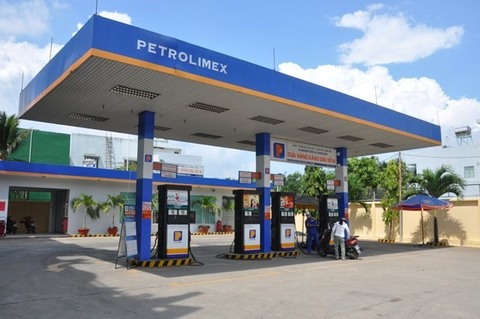 PetroVietnam (PVN) has proposed the Ministry of Industry and Trade approve the reduction of its ownership in PetroVietnam Drilling and Well Services Corporation (PVD) from 50.4 per cent to 36 per cent. The proposal was included in a document PVN sent to the Ministry of Industry and Trade to supplement its restructuring plan, reported cafef.vn. According to PVN, the oil and gas market has been volatile since 2014 due to the ups and downs of the global oil prices, surplus oil supply and protectionist policies overseas. The US benchmark West Texas Intermediate (WTI) between 2014 and 2018 dropped from US$107.26 a barrel recorded in mid-June 2014 to a 12-year low of about $29.40 a barrel in mid-January 2016, then has gained steadily to close last week at $67.63 a barrel. This cut PVD’s earnings in the last few years. Data on cafef.vn showed audited post-tax profit of the company dropped from VND2.54 trillion (nearly $112.9 million) in 2014 to VND1.75 trillion in 2015, VND185.6 billion in 2016 and VND35.5 billion in 2017. In the first half of 2018, PVD posted accumulated losses of VND307 billion. In the second quarter, the company lost VND67 billion. In late February, PVN proposed the Government approve a sale of State capital in PVD to reduce its ownership from 50.4 per cent to 25 per cent so the company would be able to attract private investors. However, as PVD is a business with activities closely watched for national defence and security issues, PVN re-issued the proposal to cut its ownership in the subsidiary from 50.4 per cent to 36 per cent in 2018-20 so PVN will remain on PVD’s management board. Under the plan, PVN will also sell all of its ownership in three other subsidiaries, namely PetroVietnam General Services Corporation (Petrosetco), PetroVietnam Mud Drilling Corp (PVDMC) and PetroVietnam Engineering Corporation (PVE). The State-owned energy conglomerate holds 22.24 per cent of Petrosetco, 29 per cent of PVE and 36 per cent of PVDMC. In addition, PVN hoped to divest from PetroVietnam Gas Corporation (PV Gas) and PetroVietnam Construction Corporation (PVC) after 2020. Seven-month plan exceeded PVN reported its seven-month post-tax profit surpassed the seven-month plan by 32 per cent to VND17.8 trillion. The figure also accomplished 94 per cent of the full-year target. Total oil equivalent production in the period was 14.48 million tonnes, exceeding the plan by 4.6 per cent and accounted for 63.4 per cent of this year’s plan. The figure includes 8.32 million tonnes of oil and 6.17 billion cubic metres of gas. The group paid VND61.8 trillion of tax to the State budget in the first seven months, 83 per cent of its full-year plan. Vietnam Airlines includes fresh longan on flights Fresh longan from Hung Yen Province will be served to business-class passengers on Vietnam Airlines’ domestic and international flights departing from Ha Noi and HCM City to destinations in Asia, Australia and Europe. This is part of co-operation between Vietnam Airlines and Hung Yen Province in a bid to introduce and promote the provincial specialty to local and international friends at the provincial trade promotion conference for longan on August 12. Hung Yen Province is a large longan farming hub in northern Viet Nam with over 3,800ha of longan at harvest time. Hung Yen longan is famous for its thick pulp and sweet taste. Longan served on Vietnam Airlines’ flights is cultivated in line with Good Agriculture Practice (VietGAP). This dessert fruit will be available on flights for one month, from August 15 to September 15. Le Hong Ha, Vietnam Airlines deputy general director, said as the national flag carrier, Vietnam Airlines has actively promoted “Vietnamese prefer Vietnamese goods” campaign, giving special priority to Vietnamese goods. “Hung Yen longan is one of the country’s typical agricultural products that Vietnam Airlines wishes to introduce to international passengers on its flights,” Ha said. Apart from improving the service quality and diversifying the food experience, Ha said serving longan on flights would be a chance to promote Vietnamese agricultural products to the world, helping solve the output problems for farmers. In June, Vietnam Airlines also included fresh litchi of Bac Giang Provice in the meal service for business class and special economic class on flights departing from Ha Noi. Hung Yen Province is expected to harvest over 41,000 tonnes of longan this year. Organic produce does not meet rising demand: experts 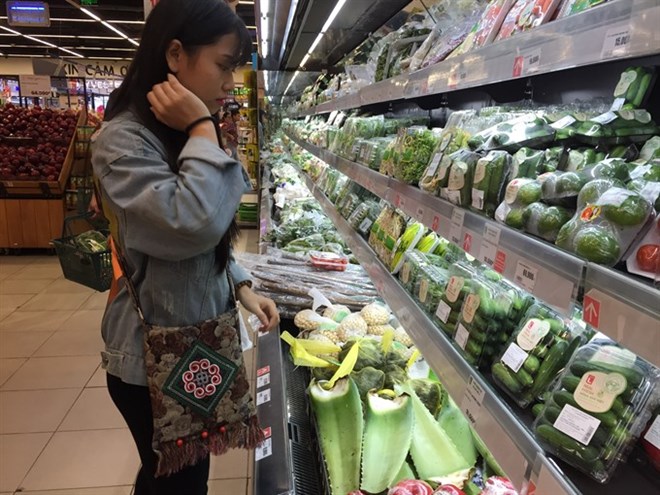 The rapidly growing demand for organic agricultural produce offers huge potential for businesses to invest in production and develop retail networks, experts said at a recent workshop in Ho Chi Minh City. Stable economic growth has led to a boom in the food and beverage industry, which accounts for 15 percent of GDP, said Dinh Thi My Loan, chairwoman of the Association of Vietnam Retailers. Local consumers now consider health and safety as their biggest concerns, Loan said at the workshop, which was held as part of the VietFood & Beverage – ProPack international exhibition in HCM City. Nielsen Vietnam estimated that the organic market revenue in HCM City and Hanoi is valued at 400 billion VND (17.3 million USD) a year, she said. “Despite great demand for organic agricultural produce, local consumers do not have easy access to supply. The total farming area and retail networks for organic produce are still modest,” she added. “The supply of organic produce is also unstable and prices fluctuate due to limited organic farming.” Around 40 businesses apply international organic standards, but most of their products are exported. Businesses should take advantage of the great potential for organic farming and invest in production and develop retail networks to meet the rising demand domestically as well as internationally, she said. Hoang Son Cong, an official at the Vietnam Organic Agriculture Association, said organic produce is being sold at most supermarkets, but the prices are still high and there is often a shortage. Most fresh food and vegetables at traditional markets have no labels identifying their origin, Cong said. The shortage of local organic products offers an opportunity for foreign producers to expand businesses in Vietnam. Kindergartens and primary schools which have a high demand for safe and nutritious food are also potential markets for organic food and produce, as is the online trading network for the apartment community in HCM City and Hanoi. The country is home to 33 facilities that have adopted the organic farming model, with more than 1,100 hectares set aside for rice farming, 90 hectares for vegetables, and 284 hectares for grapes and 79 hectares for apples. The central province of Ninh Thuan leads the country in organic farming area, with a total of 448 hectares. Bac Giang province facilitates Australian investment The northern province of Bac Giang will create favourable conditions for Australian firms who want to land investments in local agriculture. Hosting a business delegation from Australia on August 13, Chairman of the provincial People’s Committee Nguyen Van Linh pledged to prioritise investment licensing and ensure legal procedures so that Australian companies can enjoy smooth operation here. Linh briefed the Australian guests, including representatives from HunterNet and Green Agri Groups, on the local economy and agriculture, saying that the province has 17 million head of poultry, with an output of 26,000 tonnes per year, offering great opportunities for companies who are interested in the province’s poultry processing sector. Also, he stressed that before investment, the corporations should meticulously study the market, material sources and prices to assure sustainable development. Seeing Bac Giang province’s strengths, HunterNet, with over 200 companies active in various sectors, including clean agriculture, wants to build poultry and farm produce processing plants in the locality as well as form strategic cooperation for its long-term goals. HunterNet Managing Director Cade Anthony James hoped to receive the local authority’s support in introducing suppliers and farm produce businesses in the province. He said this will help his corporation have precise evaluation on the province’s capacity in the sector. After the working session, the Australian delegation conducted a fact-finding tour of Yen The district’s husbandry and poultry consumption. VN consumers yet to warm to chilled meat While chilled meat has grown in popularity among consumers in developed markets, Vietnamese consumers still hesitate to add it to their shopping carts. Small surveys conducted at traditional markets show an astonishing lack of awareness regarding chilled meat, with most shoppers unable to tell the difference between chilled meat and frozen meat. Worse still, many of them remained convinced that they were not fresh and therefore were frozen to hide the bad taste. Chilled meat is meat preserved by chilling to and maintaining at no more than 7oC, 3oC for offal, immediately after Slaughter. It is not only considered safer to consume but also offers a fresher taste due to a process called ageing, which allows the meat to age in its own juice refrigerated near zero temperature (wet ageing). Even those who occasionally pick up chilled meat from supermarket shelves only did so because it was convenient and possibly safer to consume than meat offered at traditional markets. The misunderstanding stems from a deeply rooted habit of Vietnamese consumers, who for a long time consider raw meat from animals butchered at early morning markets as the freshest meat. “Việt Nam, with its hot and humid weather, is the perfect condition for the growth of microorganisms, many of which make the meat turn bad faster on top of the enzymes found in meat,” said Trần Thị Mai Phương, a researcher from the Vietnam Livestock Association. “Raw meat found in traditional markets is not necessarily contaminated if it was processed in accordance with safety standards but it cannot produce that fresh taste without the process of meat ageing. As a matter of fact, Việt Nam is among a handful of countries where consumers still have a habit of buying raw meat.” Phương, however, said consumers are not to blame. “There is an urgent need to raise awareness and provide Vietnamese consumers with information to help change their shopping habits. There is an important part for national standards on chilled meat to play, which is expected to be implemented in 2018,” she said. There have been positive signs that the market is warming up to adopt chilled meat as a mainstream product. Hà Nội was one of the country’s trendsetters in establishing a number of brands that supply the market with chilled and frozen meat products such as Bảo Châu Pork, Xuka, Lan Vinh and Harpo since 2016. Breaking into the market and changing consumers’ habits, however, has proven to be challenging. To make matters worse, domestic brands often have to fend off fierce competition from imported products. A quick browse through a number of the capital city’s supermarkets showed that domestic products were priced higher than their imported direct competition. Notably, imported frozen chicken legs were priced at VNĐ35,000 (US$1.5) while domestic products were priced at nearly $3. Lại Mạnh Toàn, department head of food processing and preservation under the National Institute of Animal Sciences said the national standard for chilled meat is imperative should the country hope to export meat products. Toàn said he believed such standards would also greatly improve quality and safety standards for the domestic meat market. Forum talks high-tech farming A forum focusing on the development and connections of local start-ups and the agricultural sector in the Fourth Industrial Revolution was held on Thursday in the southern province of Dong Thap’s Cao Lanh City. Chairman of Dong Thap Province People’s Committee Nguyen Van Duong told the forum that the province had carried out many activities to support the development of local start-up companies. There had been some projects that focus on exploration and exploitation of local resources and key products, however, the province was still short of high-tech start-up projects to further develop its agricultural sector, he said. Initiating a start-up business was actually much harder than it looked so local authorities hoped that specialists and experts would share their ideas and experiences to help the province develop its community of high-tech start-ups, he added. As the demand among provincial companies for high-tech agriculture applications has risen, some projects have been initiated to provide high-tech apps for the province’s agricultural sector, namely the environmentally-friendly water treatment process MET, the sensor system Farm Tech and the automotive mushroom farm. According to Tony Wheeler, chairman of the Australian Redland Enterprise Renovation Council, applying advanced technologies in agricultural production has been essential to Australians because his country has a larger area but much smaller population size compared to Viet Nam. Agriculture is the key industry of Australia and only science and technologies could reduce production costs, prevent the use of chemical substances and limit environmental impacts caused by the expansion of population and economy, he said. Wheeler added that artificial intelligence and automation were key to boosting every industry as the two technologies were able to identify and process data to make accurate decisions for companies, thus cutting labour costs. It’s positive that start-up companies in the southern province of Dong Thap have paid more attention to the use of biological technologies to drive their business and production toward an organic and clean agriculture industry, he said. Producers should develop their smart farms that are automotive in all activities such as transportation, management and harvesting to create added value for their products, Wheeler said. In order to do that, producers and agricultural firms must connect with each other, plus the local government should provide more incentives so that technologies can be applied to raise product quality, he said. Forum boosts VN-Laos tech links The Viet Nam - Laos technology transfer forum (Viet Nam - Laos TechConnect 2018) kicked off in Vientiane, Laos, on Thursday. The forum attracted about 300 delegates from the two countries’ Ministries of Science and Technology, associations, businesses, universities and research institutions. In his opening speech, Vietnamese Deputy Minister of Science and Technology Tran Van Tung said the forum aimed to bolster co-operation in technology transfer among organisations and enterprises of the two countries. It helps connect technology researchers and developers of Viet Nam with governmental agencies and business communities of Laos, towards promoting commercialisation, application and the investment in technology in key fields of Laos such as agricultural product process and preservation, renewable energy, environment protection and information and technology, he added. According to Tung, the event features 142 technologies and technological products from 23 units. The forum contributed to deepening co-operation between the two Ministries of Science and Technology and research co-ordination among scientists of the two countries, he noted. While highlighting the significance of the event, Lao Minister of Science and Technology Boviengkham Vongdara stressed that as the first edition of this kind, the forum could well bolster the science and technology development strategy in Viet Nam and Laos. It offered a good chance for the two sides to discuss the development of relevant projects in the field, he said. The two-day event also contributes to tighten solidarity, traditional friendship and strategic co-operation between the two countries, Boviengkham added. Viet Nam - Laos TechConnect 2018 includes discussion sessions on measures to promote technology transfer between the two nations; sustainable agricultural development, environmental issues and information and technology. Technology exhibition activities and the presentation of technological research results are also arranged within the framework of the event. Six technology co-operation and transfer contracts were signed between universities and enterprises of the two countries after the opening ceremony. Through the Lao Ministry of Science and Technology, Vietnamese units attending the forum handed over VND150 million (US$6,608) as relief aid for Lao people affected by the recent collapse of the Sepien Senamnoy hydropower dam in Attapeu Province. ERP Store to promote e-contract Viet Nam eCommerce and Digital Economy Agency (iDEA) under the Ministry of Industry and Trade on Wednesday launched the ERP Store solution with the aim of helping businesses reach the goal of a paperless office. The solution allows enterprises to digitise contract signing — the most important aspect of their trade activities — as well as widely applying e-documents. These could help firms better deploy the advantages of digital technology in their management. The ERP Store which was developed by iDEA allows companies to implement e-contract signing. Accordingly, they only need the tax code and USB token containing a digital signature to implement the signing. Each firm will have four accounts with different roles including drafter, approver, stamper, and director. Dang Hoang Hai, iDEA’s director said previously many businesses used office software. Digitalisation is not new for many firms. However, forging digital connections between companies has been difficult, especially when it comes to signing contracts and documents. Meanwhile, enterprises have been using paper documents, costing time and money as well as creating security issues. The ERP solution would help firms quickly connect with each other and sign contracts while ensuring security as all information is encoded. Legally, the regulations for electronic signatures are now complete. Specifically, the Government promulgated the Law on Electronic Transactions on November 29, 2005; Decree No 26/2007 / ND-CP of February 15, 2007, detailing the implementation of the Electronic Transaction Law on digital signatures and digital signature certification services. In addition, e-contract signing was also confirmed by the master plan on development of the national e-commerce in 2016-20 period dated on August 8, 2016. The regulations ensure firm legality for e-contracts. Notably, businesses will enjoy the services free of charge for their first two years using the programme. Can Tho eyes rice exports to China Can Tho hopes to increase rice exports to China, city officials said at a meeting with the China Food Association on August 8. China’s demand for Vietnamese rice remains high, Wang Zhi Xi, head of the visiting Chinese delegation, said, revealing his company sells around 800 tonnes of Vietnamese rice daily. China is Viet Nam’s largest trading partner, while Viet Nam is China’s largest ASEAN partner and eighth largest overall. Last year their trade was worth US$93.69 billion, a 30.3 per cent rise from 2016. China imported 3.99 million tonnes of rice, 13 per cent more than in the previous year, with Viet Nam supplying more than 2.2 million tonnes. In the first six months Viet Nam has sold 850,000 tonnes. But Dao Viet Anh, commercial counsellor at Viet Nam’s embassy in Beijing, said Vietnamese rice exports to China could face difficulties in future and are unlikely to increase as rapidly again as in the last few years due to changes to China’s import tax in July and competition from other countries. Nguyen Minh Toai, director of the Can Tho Department of Industry and Trade, said the city has only four businesses that meet China’s quality standards for direct rice exports. The city would assist firms in improving quality to help them export to China, networking and promoting their brands, he promised. United Overseas Bank in deal to foster foreign investment United Overseas Bank Vietnam Ltd on Thursday signed a memorandum of understanding with the Viet Nam – Singapore Industrial Park to encourage and facilitate foreign direct investment in Viet Nam. The Singapore lender had launched its Vietnamese subsidiary only this week. With this collaboration, UOB and VSIP are committed to organising business seminars together to help companies explore business and investment opportunities in Viet Nam. The bank yesterday invited more than 40 business leaders from across Asia to visit the VSIP in Binh Duong Province. It connected them with strategic business partners and key government agencies in the local business eco-system, including the Foreign Investment Agency, to help them navigate the requirements when doing business in Viet Nam. The tie-up with VSIP complements UOB’s other partnerships to accelerate cross-border trade and investments in Việt Nam as well as in other ASEAN markets. UOB is the first Singapore bank to open a foreign-owned subsidiary in Viet Nam. UOB has a global network of more than 500 branches in 19 countries and territories in the Asia Pacific, Europe and North America. It first came to Viet Nam in 1993 with the opening of a representative office, and in 1995 became the first Singaporean bank to open a branch in the country. Phu Cuong, Lotte Engineering tie up for housing, other developments Phu Cuong Investment Corporation and Lotte Engineering and Construction Company Ltd have announced plans to jointly develop housing, shopping and service projects in Viet Nam. A joint venture contract they signed last week in HCM City envisages development of their first project, an apartment in Thanh My Loi Ward in the city’s District 2. To come up around 500m from the District 2 administrative centre, the project will cost over VND1.5 trillion (US$65 million). It will have two buildings of 25 floors each with 751 high-end condos, amenities like an infinity swimming pool, gym and shop-houses. The two companies hoped their co-operation would particularly assist the Government’s policy of attracting foreign investment. Phu Cuong Investment Corporation, a member of the Phu Cuong Group, has invested in projects to develop urban areas and recycle energy in HCM City and the Mekong Delta. Phuong Nam Cultural to sell remaining stakes in CGV Phuong Nam Cultural Joint Stock Corporation has proposed a plan to shareholders to sell its remaining 7.5 per cent stake in CJ CGV Vietnam Co Ltd. CJ CGV Vietnam operates Viet Nam’s largest multiplex cinema, CGV. On Wednesday, Phuong Nam Cultural Corporation (PNC) sent a written notice to the General Meeting of Shareholders to consult them about the sale of its capital in CJ CGV Vietnam. The decision to sell comes in the wake of financial distress faced by the corporation. PNC will announce consultation results on August 27, tinnhanhchungkhoan.vn reports. As of June 31, PNC owned a 20 per cent stake in CGV. However, on June 28th, PNC shareholders approved the sale of 12.5 per cent of CGV Vietnam shares to Black Diamond Investment Joint Stock Company, reducing Phuong Nam’s holding to 7.5 per cent. The sales aim to help PNC pay off its debt. By the end of the second quarter of this year, PNC’s liabilities amounted to VND 548.7 billion, 93 per cent of its total capital, of which the short-term loans borrowed from Cross Junction Investment was VND161 billion. PNC has suffered accumulated losses of more than VND98.3 billion. ASG Corp files for HOSE listing The Airport Services Joint Stock Corporation (ASG Corp) has filed to list 34.5 million shares on the HCM Stock Exchange (HOSE). With the listing, the company’s charter capital will reach VND345 million (US$15.3 million). ASG Corp was transformed into a public company after it obtained approval of the State Securities Commission on May 4, 2018. The company had planned to list its shares on HOSE in July. Logistics firm ASG Corp was founded in October 2010 and its core businesses include ground and freight transportation and warehouses. The company currently holds full control of three sub-units, which are the Sai Gon Airport Services JSC, ALS Thai Nguyen Co Ltd and ALS HCM City Co Ltd. ASG Corp also has stakes in two firms – Cam Ranh International Airport Services JSC and Sai Gon Aviation Services JSC. The company recorded net revenue of VND255.2 billion in the first half of 2018, a year-on-year increase of 4 per cent. Its post-tax profit in the first six months rose 8 per cent year on year to VND85 billion, raising total undistributed post-tax profit in the first half of the year to VND256 billion. The company’s total assets reached VND1.2 trillion as of June 30, 2018, rising by VND326 billion compared to the beginning of the year. Its payables were VND447 billion, including VND50 billion worth of short-term loans and VND143 billion worth of long-term loans. The company’s equity was VND767 billion. ASG Corp has two major shareholders: the Aviation Logistics JSC (ALS) with a 5.8 per cent stake and the International Logistics JSC with a 9.2 per cent stake. A number of aviation and airport services are trading and listing on the Vietnamese stock market such as the Cam Ranh International Airport Services JSC (CIA), Vietnam Airlines JSC (HVN), budget carrier Vietjet Air (VJC), Airports Corporation of Viet Nam (ACV), Da Nang Airports Services JSC (MAS), Noi Bai Airport Services JSC (NAS) and Southern Airports Services JSC (SAS). 15 listed firms honoured for investor relations Fifteen listed companies on the HCM City Stock Exchange on Thursday were honoured with an IR Award for having the best investor relations in 2018. The awards, voted for by investors and financial institutions, were divided into three groups based on market capitalisation (large, medium and small and micro). The winners of IR Awards voted by investors were Saigon Thuong Tin Commercial Joint Stock Bank, Khang Dien House Trading and Investment JSC, Vietnam Dairy Products JSC (large capital), An Phat Plastic and Green Environment JSC, Hoa Sen Group, Phat Dat Real Estate Development Corporation (mid cap), and DRH Holdings JSC, Digiworld Corporation and Hang Xanh Motors Service JSC (small and micro cap). Awardees for IR activities voted by financial institutions were Hoa Phat Group, VinGroup, Vietnam Dairy Products JSC (large capital), Dat Xanh Group, HCM City Securities Corporation, Nam Long Investment Corporation (mid cap), and Digiworld Corporation, Hang Xanh Motors Service JSC and Ba Ria-Vung Tau House Development JSC (small and micro cap). Organised by the online newspaper Vietstock and the Financial and Life online magazine FiLi.vn of the Viet Nam Association of Financial Executives, the annual awards seek to raise awareness among listed companies of the need to comply with information disclosure requirements and to have good relations with investors in general and shareholders in particular, in order to have an open, transparent and effective stock market. Nguyen Nhu Hung, editor-in-chief of Fili.vn, said the award was based on a survey of compliance with information disclosure obligations of the Vietnamese stock market of 686 listed companies. As many as 266 of them have met the requirements. To win an award, listed companies must have full and timely compliance with regulations about information disclosure, pass rigorous checks on liquidity conditions and foreign ownership ratio, and pass an evaluation round on investor relations by financial institutions, as well as receive the highest number of votes from investors. After a check of liquidity conditions and foreign ownership ratio, 45 out of 266 listed firms were included on the list of nominees for the awards, he said. Hung said this year’s survey found that listed companies have been better at complying with information disclosure requirements, with 38.8 per cent of surveyed companies fully complied with disclosure requirements compared to nearly 17 per cent last year. This showed a dramatic improvement in the relationship between businesses and investors, he said, adding that more executives care about the investor community and appreciate the role of IR activities in optimising corporate value. VNN |
↧
Article 1
Social News 15/8 Liêm loses to host player at UAE 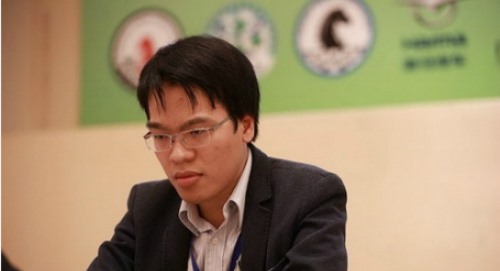 Lê Quang Liêm lost to host chess grandmaster Salem Saleh in the seventh set of the 25th Abu Dhabi International Chess Festival. — Photo i-thethao.vnecdn.net Top Vietnamese chess player Lê Quang Liêm lost to grandmaster Salem Saleh in the seventh set of the 25th Abu Dhabi International Chess Festival on Tuesday (August 14). Liêm (Elo 2,727) took black but his unstable style caused him weakness in defending and he accepted the loss after 39 moves. The victory helped Salem reach the first group with six points, along with Daniil Dubov (2,691) and Anton Korobov (2,664). Young talent Nguyễn Anh Khôi caught up with Liêm after beating Dushyant Sharma from India (2,221). Liêm will meet Aryan Chopra from India (2,536) while Khôi will face Ahmed Adly of Egypt (2,634) in the eighth set on August 15. Lê Văn Duẩn wins fourth stage of Gạo Hạt Ngọc Trời An Giang Cup 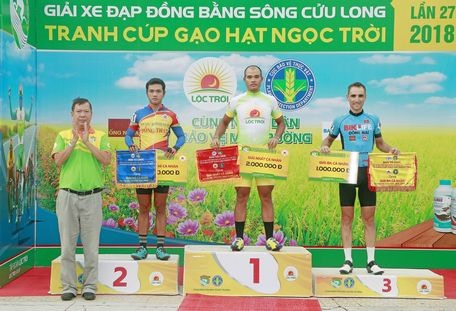 Lê Văn Duẩn won the fourth stage of the 27th National Cycling Open – Gạo Hạt Ngọc Trời An Giang Cup. — Photo baovinhlong.com.vn Vietnamese cyclist Lê Văn Duẩn from VUS Hồ Chí Minh City won the fourth stage of the 27th National Cycling Open – Gạo Hạt Ngọc Trời An Giang Cup yesterday (August 14). Duẩn triumphed in the 107km race from Bến Tre City to Cao Lãnh City of Đồng Tháp Province with a time of 2:46.03, followed by Nguyệt Minh and Đỗ Tuấn Anh from Domesco Đồng Tháp. Trịnh Đức Tâm (ranked 21) still retains the yellow jersey with an overall time of 10:21.36, followed by Mai Nguyễn Hưng, who holds the green jersey, and Nguyễn Trường Tài from VUS Hồ Chí Minh City, Sarda Perz Javier from Tập đoàn Lộc Trời and Ali Khademi from Gạo Hạt Ngọc Trời An Giang. In the team rankings, VUS Hồ Chí Minh City leads with the best overall time of 31:06.38, followed by Tập đoàn Lộc Trời and Domesco Đồng Tháp. Today, cyclists will compete in the fifth stage from Cao Lãnh City to Sa Đéc City of Đồng Tháp – Vĩnh Long – Cần Thơ City, a distance of 95km. Medical programme provides free digestion checkup and surgery in Đức Giang Hospital 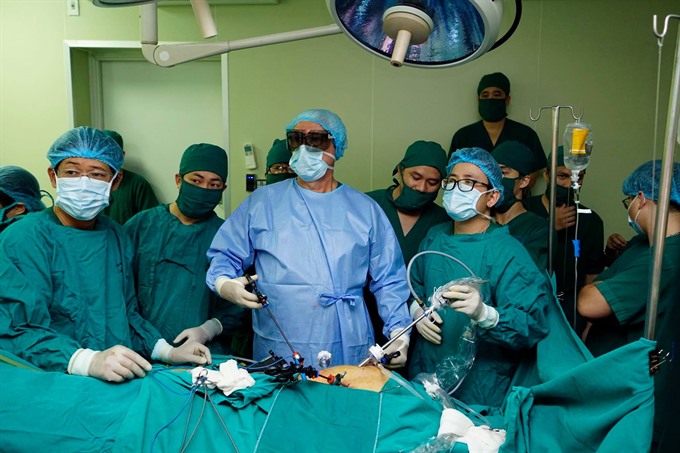 Prof. Leroy (centre) trains doctors of Đức Giang General Hospital on minimally invasive surgery. Đức Giang General Hospital launched a medical programme to provide free checkups, consultation and endoscopy surgery to patients with digestion diseases on Monday in Hà Nội. Prof. Joel Leroy, a leading French expert in digestion endoscopy, is participating in the programme. He was the first surgeon to perform colorectal surgery without scarring the patient’s abdominal wall. Prof. Leroy will examine and perform surgeries on patients with dangerous digestion cancers, with all medical service expenses supported by the Hà Nội People’s Committee and Đức Giang Hospital with technical support of medical firm Olympus Company. The Frenchman also taught the latest techniques in digestion endoscopy, especially minimally invasive surgery, to Đức Giang hospital surgeons to help the hospital master new surgery techniques and improve service quality. “I will be here to train Đức Giang Hospital’s doctors step by step and I think they will be updated with the new knowledge that I will teach,” said Prof. Leroy. “The techniques I teach are very new, even in France and the world. So, doctors here need time to master new techniques and to use new facilities, especially minimally invasive surgery,” said Leroy. Leroy said that training on endoscopic surgery, especially minimally invasive surgery, was a new surgical trend in the world. In France, 89 per cent of digestion patients have had minimally invasive surgeries. “I witnessed many patients suffering colorectal cancer in hospitals of Việt Nam. Therefore, I think the technique is necessary especially in Việt Nam,” added Prof. Leroy. “This is the first time our doctors have performed this complicated technique of digestion endoscopy surgery. We sent doctors to the Saint Paul Hospital for training new digestion endoscopy techniques over the past two years in preparation for the surgery today,” said Đức Giang General Hospital deputy director Lê Anh Tuấn. Tuấn said his hospital received about 20 colorectal cancer cases each month. Previously, Đức Giang Hospital had to send many serious cases to higher-level hospitals for treatment due to a lack of medical facilities and human resources. "The advanced technique of digestion endoscopy means a lot for local hospital like Đức Giang. From now on, our patients will have chance to receive high-tech medical services instead of going to higher-level hospitals or oveseas medical facilities for treatment," said Tuấn. Leroy will support the Đức Giang Hospital’s digestion examination and surgery programme for two years. Leroy currently teaches at the Civil Hospital of the University of Strasbourg, France. He has trained more than 10,000 endoscopy surgeons in the world, including many Vietnamese doctors. Last year, he was presented the Friendship Order of the State President for his contribution to the health sector in Việt Nam. BBQ duck never cost so much Enjoying an outdoor BBQ grilled duck in the middle of beautiful blooming yellow paddy field might be a picnic to dream of for anyone, but it turned into a nightmare for one poor farmer. Police in the Tân Thành B Commune in the southern province of Đồng Tháp last week reported a fire that burnt down the whole 25,000 sq m of rice field that was ready for harvest. Local farmer Phạm Văn Nu was the arsonist, though unintentionally. According to the police’s investigation, Nu took a rest and started preparing his lunch after harvesting his rice field in the morning of August 3. His selected menu was a grilled duck which was cooked right in his field. The grilling was perfect, except for the fire. The flames silently spread into the paddy fields of two of his neighbours: Nguyễn Đức Huy and Nguyễn Văn Tâm. Noticing the fire, Nu called out for help in panic but it was already too late in such a windy day. Everything was reduced to black ashes. He had to pay compensation to his neighbours, and although the amount wasn’t disclosed, it was bound to be a large sum given the amount of destruction. BBQ duck can be a very nice dish, especially if it’s cooked to perfection. The problem for Nu wasn’t the food, but the bill. How to solve traffic accident in a civilised manner There are different paths people can take after a crash on the streets. Sadly the most common tend to be arguments and in some cases, fighting. Best bet is sit down there and then and sort it out during a quick chit chat. That was what happened in the central city of Đà Nẵng last week. A clip posted on Facebook shows two middle-age men sitting in the middle of the road at the Nguyễn Hữu Thọ roundabout. Next to each of them was a fallen motorbike which apparently had just been involved in a head-on collision. The men sat face-to-face, with helmets still on, and were having a small talk - possibly trying to reason who was at fault here with all the bikes and cars still flowing around them. This may have looked a little odd to those around them at the time, but facebookers seemed happy with the way the matter was resolved. The user who posted the clip said the men sat there for around 15 minutes to calmly resolve the crash, which was “way too cute”. Many netizens reacted to the clip with a laugh and said that if only everyone could handle unwanted accidents as much civilised as the two men. They should be praised for civilised manner but anyone who wants to try the same way should reconsider the place for the chit chat - perhaps on a nearby pavement - if they don’t want to appear on the newspapers because of some tragic accident caused by dangerous sitting. Rise in number of kids suspected of having measles  A doctor at E Hospital examines a child suspected of having measles. Doctors in Hà Nội has raised concerns about the high number of children hospitalised with high fevers and rashes, suspecting that measles is to blame because many kids have not been vaccinated. Trương Văn Quý, head of the Pediatric Department at Hà Nội–based E Hospital, told vietnamplus.vn online newspaper on Monday morning that the number of children recently admitted to the department suffering from high fevers and rashes was increasing. Among those hospitalised, two cases were diagnosed as having the measles virus. The cases were mainly concentrated in districts of Đống Đa, Hà Đông, Hoàng Mai and Bắc Từ Liêm. The majority of children suspected of having measles were under 5 years old. However, until now, there have been no severe complications, according to the hospital. Quý warned that most cases of measles were due to children not being vaccinated or not being vaccinated. Children who weren’t vaccinated or fully vaccinated were likely to get the disease when exposed to the source of infection, according to the doctor. “Therefore, the best preventive measure is vaccinations for children following the expanded immunisation programme,” he said The current supply of vaccines was abundant, Quý confirmed. Hospital E was organising counselling and vaccinations for children as part of the expanded vaccination programme, ensuring children were fully vaccinated in accordance with State regulations. — VNS Bình Phước Province to inspect cashew farm support  Cashew nuts are attacked by stinkbugs in the southern province of Bình Phước. Chairman of the Bình Phước Province People’s Committee Nguyễn Văn Trăm on Sunday asked for an inspection on the work of supporting cashew nut farmers who suffered losses in the period 2016-17. Under chairman Trăm’s request, inspectors will check farms in all 16 communes in Bù Đăng District, and then propose proper punishments for violators to the chairman. Earlier, farmers in Bình Phước suffered losses due to insects. The provincial People’s Committee decided to support the farmers with an amount of VNĐ2 million (US$80) per hectare. Total funding for the work reached more than VNĐ44.7 billion ($1.97 million) and was delivered to 10 districts and towns. The supporting programme started on January 30 this year. All funds were used to buy pesticide for the farmers. Bù Đăng District received the highest support, at more than VNĐ17.7 billion ($786,600) because it had the highest number of farmers suffering losses. However, dozens of households in Thống Nhất Commune sent letters to the provincial Party Committee Secretary Nguyễn Văn Lợi and other leaders saying that after they used the pesticide on their cashew nut plants, the gardens’ capacity decreased sharply and thus they suffered serious losses. They said that after spraying the pesticide over five to seven days, all of the cashew nuts dried out and small fruits turned black. Each hectare of cashew nuts brought production of about 200kg, whereas the households not using the pesticide earned about one tonne per hectare. One more problem was that the gardens which used the pesticide are unable to grow new buds with dried branches, and will suffer more on the next crop. HCM City eyes making District 2 a central district 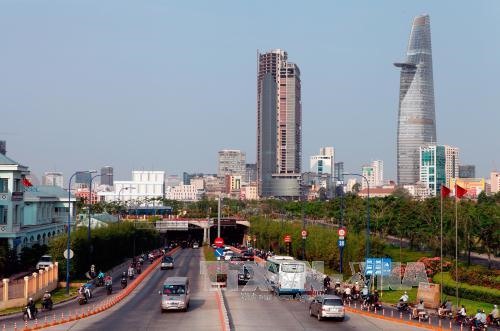 The People’s Committee of HCM City plans to make District 2 a central district of the city. The committee has asked District 2 authorities to work with Thủ Đức District and District 9 to build an innovative urban area in the eastern part of the city. Nguyễn Thiện Nhân, the city’s Party Committee Secretary, said the urban area would be based on the advantages of each of the three districts. According to the plan, District 2 would become a financial centre along with the Thủ Thiêm New Urban Area, while District 9 would be responsible for the development of technology. Thủ Đức District would have many high-quality universities. The 22,000-ha innovative urban area would also be a centre for scientific research and administration, and would aim to attract domestic and foreign investment. Start-up ideas would receive support from district authorities, especially projects in the field of environment and traffic. District 2 has also been chosen as a pilot district for a smart-city project. The project includes a smart-city administration centre, synchronised lightning system, socio-economic forecasting, an intelligent educational system, and an emergency operation centre, among others. In addition, District 2 would have commercial services and financial functions. Soc Trang province upgrades schools in Khmer communities 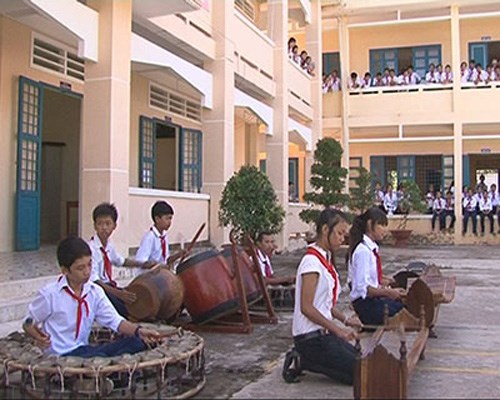 Khmer students play traditional musical instruments at a boarding school The Mekong Delta province of Soc Trang has been upgrading infrastructure for schools in remote areas and Khmer communities as the new school year is only two weeks ahead. Chairman of the provincial People’s Committee Tran Van Chuyen said in the 2017-2018 school year, the administration had approved funding for building and repairing nearly 940 classrooms and 150 other function rooms at local schools, and procuring new educational equipment. More than 60 percent of the finance had been provided for schools in ethnic minority areas. Notably, Soc Trang has finished the construction of the Tran De boarding school for ethnic minority students. The school, built at total cost of over 30 billion VND (1.3 million USD), will be put into use in the coming academic year. Infrastructure building and upgrade have helped improve the educational quality. This also aims to help more schools meet national standards when 244 or 44.4 percent of 549 schools in the province have been recognised as national-standard schools at present. However, Chuyen also admitted that investments in school infrastructure in ethnic minority areas are modest compared to the set target. From 2018 to 2020, Soc Trang will spend more than 72 billion VND (3.1 million USD) on building 10 classrooms and 122 dorm rooms to improve the learning and living conditions for ethnic students at boarding schools, he added. Soc Trang has the largest number of Khmer people in Vietnam with more than 400,000, making up 31 percent of local population. The province has nine boarding schools for ethnic minorities and 159 Vietnamese-Khmer bilingual schools with nearly 146,800 students. HCM City revives Bình Qưới -Thanh Đa urban project, yet again  The planning of Bình Qưới – Thanh Đa Urban Area mapped out by Bitexco. The HCM City government has instructed its Department of Planning and Investment to invite bids for the long-delayed Bình Qưới – Thanh Đa urban area project in Bình Thạnh District. It had left thousands of households in the area uncertain of their future for the last 26 years after authorities made plans and solicited investment and investors signed up but later pulled out. The city also instructed the department to allow residents to repair their houses after the long ban on construction works has caused many of them to deteriorate. The 427-hectare Bình Quới-Thanh Đa ecological urban area project was approved by the People’s Committee in 1992. The Sài Gòn Construction Corporation was awarded the work in 2004, but the firm was unable to execute it. A joint venture comprising Bitexco and Emaar Properties PJSC, a Dubai property developer, was awarded the project in 2015 at a cost of over VNĐ30 trillion (US$1.28 billion). However, the Dubai company pulled out after a long and fruitless wait for the land to be transferred. Bitexco remains the investor of the project, which is located just five kilometres from the city centre. There are currently some 2,000 houses with 13,000 people living on the Bình Qưới - Thanh Đa Peninsula. Nguyễn Văn Hạnh, who lives on Bình Quới Street, Ward 28, Bình Thạnh District, said that local residents have waited too long. With all construction work banned since it is a designated public works site, houses have deteriorated and roads are in bad shape. Hạnh said living conditions in the area are even worse than in the countryside. Locals want reasonable land compensation rates or resettlement in that area, he said. If that is not possible, they want the project scrapped so that they can decide what to do with their land, he added. Firms flout obligation to protect forest  Pine trees in a protected forest are illegally chopped down in Đà Lạt City, the Central Highland provinces of Lâm Đồng. The province has seen deforestation occur in dozens of projects using forest land. Up to 1,157 ha of forest in the Central Highlands Province of Lâm Đồng was lost in the last 10 years after companies rented forest land to carry out projects, the province’s agriculture department announced early this week. According to the department, since 2008, the province leased over 57,200 ha of forest land to 321 companies to carry out 386 projects. These include 116 eco-tourism projects, 113 forestation projects, 59 rubber-growing projects, 41 agriculture-forestry projects and 13 fishery projects. Many project investors reportedly failed to protect forests despite their obligations to manage and protect them. In some cases, the investors reportedly deforested and over-exploited forestry products or delayed implementing their projects in order to wait for opportunities to transfer the allocated land and gain profits. So far, deforestation was found at 84 forest-related projects in the province. Deputy director of the province’s agriculture department Võ Danh Tuyên said seeing the negative impacts of improper forest land management and hoping to curb deforestation, the provincial People’s Committee decided to stop 189 forest-related projects with total area of over 28,200 ha. Investors had their projects withdrawn because they delayed the projects or did not have sufficient financial capacity to continue the projects, Tuyên said. He added that the provincial People’s Committee also decided such companies must pay compensation for causing damage to forest resources. The total compensation will be over VNĐ219.4 billion (US$9.4 million). For example, Hoàng Thịnh Import-Export Trade and Manufacture Ltd Company were asked to pay compensation of nearly VNĐ70 billion ($3 million) for about 111ha of lost forest. Vĩnh Tuyên Lâm Ltd Company will pay about VNĐ23 billion ($990,700) for over 49ha forest, Sài Gòn-Đại Ninh Tourism and Investment Joint Stocks Company over VNĐ6.6 billion ($284,000) for over 139 ha of lost forest. “As of now, the province has just collected about 10 per cent of the compensation as violators have delayed paying,” Tuyên said, adding that local authorities also found difficulties in removing crops and construction works that the land renters built on the forestry land. In the last few years, at least 42 State employees in the province were disciplined for involvement in deforestation cases. Since 1983, Việt Nam has been implementing a policy in which forest and forest land are allocated to organisations, households and individuals for use and management. It is expected that when the forest and forest land are managed by identified legal entities, they will be used, managed and protected effectively. However, many were found to take advantages of this policy to gain profits through developing forest-related projects, renting forest land, logging, overexploiting forest resources or trading the land. Cát Linh – Hà Đông metro ticket to be kept affordable 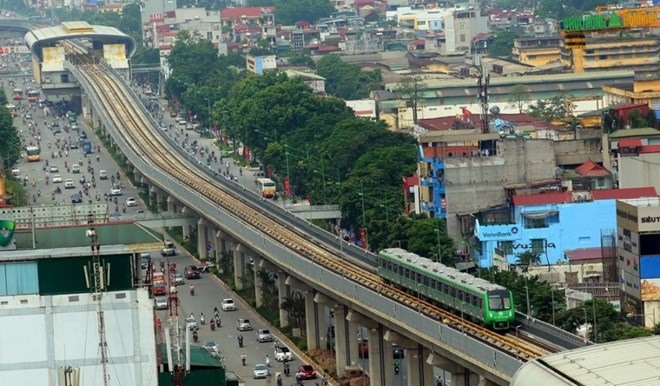 The Cát Linh - Hà Đông metro line being piloted this month. The cost of a ticket for the Cát Linh – Hà Đông elevated metro line will be subsidised. The announcement was made by Vũ Hồng Trường, director of the Metro Hà Nội Company at Friday’s online seminar on ‘How Hà Nội’s first elevated railway will operate?’ hosted by the Railway Project Management Board under the Ministry of Transport. A survey released during the seminar shows that 98 per cent of people asked knew about the project and 95 per cent wanted to try the metro. Regarding the cost of tickets, the majority of surveyed people thought it is acceptable for metro tickets to be 35 to 37 per cent higher than those for normal buses. However, most said they would prefer using a monthly pass and accept a range of 10 to 15 per cent higher than the price for a bus ticket. According to Trường, the price range will be decided by Hà Nội People’s Committee, aiming to encourage citizens to use public transportation and compete with private vehicles. However, the cost will be not too high thanks to the Government’s subsidy. Hà Nội authorities have announced a common standard for public transportation monthly passes which will allow the metro and buses to share the same technology. In the near future, these tickets are expected to be used for parking lots around the city. Chu Quang Trung, deputy head of the Transport Development and Strategy Institute said that the convenient connection between the metro and other transportation could sufficiently satisfy people’s demands. There are 34 bus routes along the Cát Linh – Hà Đông metro line, accounting for 30 per cent of Hà Nội’s bus network. When the metro line comes into operation, those bus routes will help transport metro passengers to and from other areas of the city. All metro stations will connect with the city bus system. Moreover, according to Nguyễn Hoàng Hải, director of Hà Nội Public Transport Management and Operation Centre, the metro system will be accessible for pedestrians and riders of other private vehicles as parking spaces will be offered near metro stations. Taxis and buses are not “rivals”, experts confirmed at the seminar. Hồ Quốc Phi, deputy head of Hà Nội Taxi Association, stressed the significance of connections with other means of transportation to attract more passengers to the metro. “Hà Nội is preparing for its first metro line. Once eight metro lines come into operation, traffic congestion in Hà Nội will be eased,” he said. Nguyễn Công Nhật, deputy director of Hà Nội Transportation Service Corporation (Transerco) said that metro passengers could use public buses as a mean of transiting. Approving the idea, Ngô Mạnh Tuấn, deputy director of Hà Nội Department of Transport, said that minibuses would help to gather passenger for other bus routes and the metro system. “To reduce the number of private vehicles, it is essential to have more minibuses. We are working on this plan,” he added. Ninety-six per cent of the Cát Linh – Hà Đông elevated railway project is completed, the rest is being adjusted. Since August 1, the railway has been connected to the national power grid for its trial operation this month. Vũ Hồng Phương, deputy director of the Railway Project Management Board, said that 681 workers participated in on-site training courses in order to manage and operate the project in the future. The elevated railway line will stretch over 13km, connecting Đống Đa District’s Cát Linh Street with the Yên Nghĩa Bus Station in Hà Đông District. It includes 12 stations and a depot at Phú Lương Ward in Hà Đông District. The railway will operate 13 trains with four carriages each running every two minutes at speeds of 35 to 80kmph. The railway has been constructed using Official Development Assistance from China with a total investment of US$868 million. The China Railway Sixth Group is the EPC (Engineering, Procurement and Construction) contractor for the project. More than 100 battle fire at Quy Nhon woodchip factory  A huge fire broke out on August 13 at a woodchip factory of Truong Phat Company in Phu Tai Industrial Park, Quy Nhon city in the south central province of Binh Dinh. The local authorities mobilized 13 fire engines and more than 100 people to extinguish the blaze after the alarm was raised by local residents. Witnesses said the fire spread rapidly to the office area of Truong Phat Company at Phu Tai IP in Quy Nhon city, with plumes of smoke filling the sky. After a two hour effort, the fire was brought under control. The blaze completely destroyed the 2-hectare outdoor woodchip facility and the office area of Truong Phat Company. The cause of the incident is still under investigation. Helping hands landed to Agent Orange/Dioxin victims  Activities all over Vietnam have marked the Day for AO/Dioxin Victims on August 10. Since the US army first sprayed the defoliant during the war in southern Vietnam 57 years ago, the lives of those directly exposed to Agent Orange/Dioxin have been tragically affected. Support has poured in to ease the pain of the victims. Agent Orange, which contains the poisonous chemical dioxin, was used by the US military forces during the war in Vietnam from 1961 to 1971, causing one of the most horrifying tragedies in human history. Over the course of 10 years, the US Army sprayed 80 million liters of toxic chemicals, 60% of which were Agent Orange/Dioxin, on a large area of southern Vietnam. The defoliant has had long-lasting effects on the environment, the ecosystem, and people’s health. 4.8 million Vietnamese people were exposed to Agent Orange/Dioxin and more than 3 million people were victims of the chemical. Agent Orange/Dioxin’s lingering effects have poisoned 4 generations. Nguyen Tan Dau, a resident of Quang Tri, suffers from Agent Orange/Dioxin effects. He said, “I fought in the central highlands and coastal regions from 1968 to 1971. I was directly exposed to Agent Orange/Dioxin and later contracted many diseases. I cannot function like a man. I have 10 children, 5 of them died prematurely and 1 was born with defects.” The Vietnamese Ministry of Health says 17 diseases are recognized internationally as related to Agent Orange/Dioxin. Dioxin affects the circulation, respiration, and excretion, and causes Immune Deficiency. The Vietnamese Party and State have paid special attention to addressing the consequences of Agent Orange/Dioxin. Since 1998, the National Assembly has approved 3 amendments to the Ordinance on policies for Agent Orange/Dioxin victims. Each year, the State earmarks more than US$430 million for allowances, rehabilitation, and healthcare for victims and for decontamination efforts. A campaign to hold the US government and chemical companies accountable for Vietnamese Agent Orange/Dioxin victims is making progress. In 2011, the US Congress approved the Da Nang Airport Remediation Project and health care services for Vietnamese living near dioxin hot spots. Several US NGOs have carried out environmental clean-up and healthcare projects in Vietnam. More resources are needed to ease the tragic pain of Agent Orange/Dioxin. The Vietnam Association for Victims of Agent Orange/Dioxin has raised funds and mobilized resources inside and outside Vietnam. Pham Van Toi, Chairman of the National Charity Club, said, “I have delivered gifts to unfortunate families and children. Many of them cannot walk and feed themselves. I think we should work harder to help the families of Agent Orange/Dioxin victims. I call on the entire community to help Vietnamese victims of the defoliant.” 100 foreign organizations have provided aid to Vietnamese Agent Orange/Dioxin victims through socio-economic development projects. But Vietnam needs more help to achieve its goal of overcoming the toxic chemical’s effects on the environment, human health, and social welfare by 2020. VNN |
↧
Article 0
Four defendants to stand trial for wrongdoings at PVTEX Hanoi -Four former senior members of the Petrovietnam Petrochemical and Textile Fiber JSC (PVTEX) will be tried for allegedly violating State regulations on economic management on August 28.  The Dinh Vu polyester fibre plant, which was invested by PVTEX (Photo: VNA) The Hanoi People’s Court said the defendants are Tran Trung Chi Hieu (born 1963, former Chairman of the Board of Directors of PVTEX), Do Van Hong (born 1967, Chairman of the Board of Directors and General Director of Kinh Bac Petroleum Construction and Investment JSC – PVC.KBC), Dao Ngo Hoang (born 1978, former head of the trade-contract division of PVTEX) and Vu Phuong Nam (born 1979, former chief accountant of PVTEX). All of them are accused of “deliberately violating State regulations on economic management causing serious consequences”. Tran Trung Chi Hieu also faces bribery charges. According to the indictment of the Supreme People’s Procuracy, while implementing a housing project for PVTEX employees, Tran Trung Chi Hieu and Vu Dinh Duy (former General Director of PVTEX) signed contracts with an incapable and inexperienced contractor, changed the design and organised the construction contrary to what was approved by the People’s Committee of Hai Phong city. The four defendants and Duy are accused of using the advance for the construction project illegally, leading to a loss of more than 19 billion VND (809,000 USD) for the State. The procuracy said their acts also resulted in “very big” consequences, causing the project to be suspended in 2012, which led to its current dilapidation. The Hai Phong municipal People’s Committee decided to revoke the land for the project, as it had been illegally used to build attached houses instead of the approved purpose of apartment building. When PVTEX contributed capital to establish PVTEX Kinh Bac JSC, Vu Dinh Duy and Tran Trung Chi Hieu also abused their positions and power and forced Do Van Hong to give each of them 3 billion VND (over 127,700 USD), according to the indictment. The procuracy said among the four defendants, Tran Trung Chi Hieu, who bore the main responsibility for PVTEX’s activities, deliberately violated the State’s regulations on investment and construction. He also directed his subordinates to illegally advance 20 billion VND (852,100 USD) to PVC.KBC, leading to the loss of more than 19 billion VND. After their wrongdoings were uncovered, Vu Dinh Duy fled and is being hunted by police. VNA |
↧
↧
Article 4
Co-operatives important to support farmers: Deputy PM Huệ HÀ NỘI = Deputy Prime Minister Vương Đình Huệ has stressed the importance of establishing co-operatives as a link among farmers, enterprises and economic sectors to restructure agriculture and develop new rural areas. Deputy Prime Minister Vương Đình Huệ speaks at a conference to discuss policies about linking production and consumption of agricultural products and the development of 15,000 co-operatives and unions of agricultural co-operatives until 2020. — VNA/VNS Photo Doãn Tấn Addressing a conference held by the Ministry of Agriculture and Rural Development (MARD) on Saturday to discuss policies about linking production and consumption of agricultural products and the development of 15,000 co-operatives and unions of agricultural co-operatives until 2020, Huệ said setting up co-operatives was a mandatory task with farmers as the main subject to enlarge the scale of agricultural production, promote the role of the household economy and strengthen co-operative links between farmers and scientists. Huệ, who is also head of the Steering Committee for Innovation and Collective Economy Development, stressed the need to continue raising awareness about the necessity of the project to establish 15,000 co-operatives by 2020. “Agricultural restructuring must go in two directions: reorganising production and improving the application of scientific and technological advances,” Huệ said. According to the deputy PM, the household economy had enjoyed a golden period and agricultural development had grown tremendously, but now the economic viability of the household business needed a model. Huệ said that after many efforts from all levels, the collective economy and co-operatives had began to develop, contributing 5.6 per cent to GDP. He believed the target of establishing 15,000 co-operatives by 2020 was feasible. However, the deputy PM said that the quality of co-operatives should also be emphasised, and that it was necessary to continue consolidating and increasing the quality of the current 4,400 co-operatives operating effectively, of which 1,500 co-operatives needed to apply high technology. “Weak agricultural co-operatives must move to effective operations by 2020,” Huệ said. The deputy PM also mentioned improvements in the legal framework for the restructuring of agricultural economy, which he said was the core of the co-operatives. “Localities should work on plans and measures to integrate their resources and classify co-operatives in order to find the right direction,” Huệ said. He also said that in addition to capital from the national target programme, other credit sources were very important. He asked the State Bank of Việt Nam to issue revisions to Decree 55 with more focus on agriculture, farmers and rural areas. The Ministry of Agriculture and Rural Development (MARD) and localities were asked to re-evaluate the land and assets of co-operatives so as to create conditions for them to fully meet the borrowing criteria from banks. According to a MARD report, by the end of June, the country had 39 co-operative unions and more than 12,500 co-operatives operating in the agricultural sector, and increase of 908 co-operatives from last year. Comparing between regions, the Northwest, the Red River Delta and the Mekong River Delta had a high proportion of well-operated agricultural co-operatives. According to Minister of Agriculture and Rural Development Nguyễn Xuân Cường, agricultural production was large but still suffered from the market volatility and uncertainty. According to Cường, over the past two years, the number of enterprises operating in the agricultural sector has increased from 3,600 to nearly 8,000. “There should be links between raw materials, processing and market development through co-operatives, with enterprises at the core,” he said. At the meeting, Vice Chairman of Lâm Đồng Province’s People ’s Committee Phạm S suggested focusing on deploying high-tech agriculture and smart agriculture while pushing trade promotions to enhance competitive value. “The Government should also consider accessing co-operative funds to ensure the target of 15,000 co-operatives by 2020,” he said. According to State Bank of Việt Nam Deputy Governor Nguyễn Thị Hồng, the bank has directed its local branches to remove difficulties and make it easier for co-operatives to access capital. VNS |
↧
Article 3
FDI in HCM City shrinks dramaticallyHCM City - Foreign direct investment (FDI) in HCM City is dwindling and cannot continue to drive the economy, Su Ngoc Anh, Director of the municipal Department of Planning and Investment, has said. A production line for electronic components at the Nidec Sankyo Vietnam Corporation in the Saigon Hi-Tech Park (Photo: VNA) According to figures from the department, this year, 527 FDI projects have registered but their combined capital is just 498 million USD. In the same period last year, there had been 428 FDI projects worth 743 million USD. The five biggest projects this year have capital of 25–70 million USD each, while there are several worth just 2,200-3,000 USD. “These tiny sums of money from FDI projects cannot contribute anything to the city but we cannot refuse them,” Anh was quoted as saying by Thanh Nien (Young People) newspaper. Nguyen Thanh Phong, Chairman of the city People’s Committee, has expressed concerns many times about the size of the companies. He has instructed related authorities to review the business environment and find out why the city cannot attract large FDI projects or if there are any challenges that scare away investors. Dr Dinh The Hien, Director of the Institute of Information and Economic Research, said in the past the city had attracted FDI in infrastructure and property, where the sums involved are often very large. “In recent years, it has become difficult [for the property industry] to find clear land in HCM City,” he said. “In fact, the city is facing challenges in finding lands for setting up plants and other production facilities. “There are many investors who would like to invest large amounts in production with huge plants but it is not easy to find large tracts of land in HCM City, and they have other choices in neighbouring provinces like Binh Duong, Dong Nai, Ba Ria-Vung Tau, and Long An.” The city has set its sights on the high-tech industry but has not attracted any major investors after the Intel plant, which set up a 1 billion USD facility at the Sai Gon High-tech Park. Hien said: “It is hard for HCM City to attract large foreign investments if it retains its old attraction for real estate and manufacturing instead of infrastructure and technology.” He said the city should consider the efficiency of a project rather than its investment. “We have seen many ‘huge’ projects that required a lot of land but did not work well, resulting in bad consequences for the city,” he added. Do Nhat Hoang, head of the Ministry of Planning and Investment’s Foreign Investment Department, said investors normally need three to four years to decide where they can invest. “FDI inflows into HCM City are low now but can recover in the near future. However, the limited land availability is the biggest challenge for the city in attracting investment.” Even if land is available, it is very expensive. Hoang pointed out that industrial investors would not prefer HCM City because land rentals are too high at around 160 USD per square metre per year. “They only need to move their plants five to 10km from HCM City, and the land rental is only 50-60 per USD square metre. HCM City’s strengths are trading, services and high-tech industries, which do not require too much money. “If HCM City wants to attract big investments, it must have land, infrastructure, improved human resources, research and development centres, and close links with neighbouring provinces.” It should not pay attention to the investment size and should focus on knowledge and technology instead, he suggested. “Knowledge and technology are the new requirements to compete in the industry 4.0 era.” The Government recently approved the conversion of 26,000ha of agricultural lands in HCM City for use for services, industry and urban development purposes. VNS/VNA |
↧
Article 2
BUSINESS NEWS IN BRIEF 20/8 Deutsche Bank appoints new chief country officer for Vietnam Deutsche Bank has just announced the appointment of Hans-Dieter Holtzmann (49) as chief country officer and head of Global Transaction Banking (GTB) in Vietnam, effective from August 16, 2018. In his capacity as chief country officer, Holtzmann will report to Werner Steinmueller, member of the Management Board and APAC Head of Deutsche Bank, and in his GTB capacity, to Kaushik Shaparia, head of Global Subsidiary Coverage, GTB Foreign Exchange and Corporate Cash Management for Asia. Announcing the appointment, Steinmueller said, “We are pleased to have a colleague of Hans-Dieter’s caliber in this role. As one of our key markets in Southeast Asia, our Vietnamese franchise has shown profitable growth and we are excited about the country’s outlook. This is why last year we significantly increased our capital base in this market, providing the bank with more resources to support our clients’ activities.” Kaushik Shaparia, added that “With his extensive client management experience, Hans-Dieter is well positioned to lead and grow our GTB business in Vietnam, where we are a key player in cash management, trade finance, and securities services, servicing both global and local clients.” In Vietnam, Deutsche Bank is among the largest market access providers to global institutional and retail investors, a leading M&A and ECM advisor, as well as one of the top five USD/EUR FX trading houses by volume. Deutsche Bank is present in Vietnam since 1992 and employs a staff of approximately 70. In April 2018, Deutsche Bank moved its office into the new Deutsches Haus in Ho Chi Minh City, a hub for German businesses in the country. Holtzmann has been with the bank for more than 20 years. He has worked in various senior capacities across global offices with Corporate & Investment Banking, Regional Management, and Government and Regulatory Affairs, most recently as Head of Public Sector for Germany where he was responsible for covering clients at the federal, state, and municipality level. He has also worked as economic advisor to former German Chancellor Helmut Kohl on a secondment to the German Federal Chancellery. He holds a Ph.D. in economics from the University of Erlangen-Nuremberg and a Master of Liberal Arts from Wayne State University in Detroit, Michigan. Imports of animal feed continue upward trend  Imports of animal feed and raw materials for animal feed production hit US$232 million in July, down 37.58% compared to the previous month but up 7.11% against the same period last year, according to the General Department of Vietnam Customs. Among major suppliers of animal feed and raw materials for Vietnam in July, Argentina ranked first with US$53 million, down 27.24% against the previous month and 55.76% over the same period last year, trailed by the US with more than US$48 million and China with more than US$22 million. Overall, Vietnam spent more than US$2.2 billion importing animal feed and raw materials in 7 months, a year-on-year rise of 11.11%. Export markets seeing strong growth included Brazil (up 301.31% to US$294 million), Belgium (up 155.95% to US$20 million), the US (up 111.15% to more than US$369 million) and Chile (up 79.87% to nearly US$10 million). Cement exports record strong growth Cement exports in the first seven months of the year registered impressive growth, with 17.65 million tonnes sold for 656.3 million USD, year-on-year increases of 63.2 percent in volume and 73.4 percent in value. According to the General Department of Customs, export prices of cement and clinker grew 6.3 percent to reach an average 37.2 USD per tonne. Bangladesh was the largest consumer of Vietnamese cement and clinker, spending 152.8 million USD on 4.75 million tonnes of the building materials, accounting for 23.3 percent and 26.9 percent in Vietnam’s total cement export quantity and value, respectively. Notably, export revenue earned from China was 90 times higher than that gained in the same period last year, with 158.35 million USD. The market consumed 4.52 million tonnes of Vietnamese cement and clinker, an 80-fold increase, becoming the second largest purchaser of the goods. The Philippines was the third biggest Vietnamese cement buyer at 3.49 million tonnes. Meanwhile, strong growth in cement exports was seen in Malaysia (87.9 percent), Peru (74.7 percent) and China’s Taiwan (11.9 percent). Vietnam Airlines ties up with Sacombank, Napas for discount Sacombank, the National Payment Corporation of Viet Nam (Napas) and Vietnam Airlines have announced a promotion programme for Sacombank Plus debit card holders buying tickets on the airline. People buying tickets on www.vietnamairlines.com on Tuesdays, Wednesdays and Thursdays from August 15 to September 13 will get a 15 per cent discount on all domestic routes and flights to Southeast Asia, Northeast Asia, Europe, and Australia. “Taking off easy with Napas and Vietnam Airlines” offers an additional refund of 5 per cent of the ticket value up to a the maximum of VND200,000. Plus debit cards are connected to customers’ current accounts at Sacombank. More information about the programme is available at khuyenmai.sacombank.com and the bank’s hotline. Overnight interest rate doubles to 4.42% Interest rates on the inter-bank market have surged strongly in the past week despite the central bank’s net injection of VND14.4 trillion (US$612.76 million). According to a report from the Saigon Securities Incorporation (SSI), the rate of overnight loans last week doubled from the previous week to reach 4.42 per cent, nearly equal to the 4.75 per cent rate in the open market operation (OMO). The rise has also contributed to reducing the interest rate gap between overnight and three-month loans to only 27 basis points. Interest rates for one-week and two-week loans also surged 1.9 and 1.7 times against the previous week. SSI analysts attributed the interest rate hike to a net withdrawal of VND60 trillion for the week ending August 3, which has reduced the liquidity in the banking system. SSI’s report also showed that the yield of the central bank’s five-year bills has kept steady at 4.3 per cent in the past week. During the week, the transaction volume of the bills increased by 27 per cent against the previous week. Foreign investors net bought VND113 billion after they net sold in the last five weeks. India investigates countervailing duties on VN’s steel The Directorate General of Anti-Dumping and Allied Duties (DGAD) under India’s Ministry of Commerce and Industry has recently announced the initiation of an investigation into countervailing duties on certain types of steel imported from Viet Nam and China. The investigation is based on petitions filed by Stainless Steel Pipe and Tubes Manufacturer Associations of New Delhi, Ahmedabad, South India and Haryana. The applicants alleged that the exporters have benefited from the actionable subsidies provided by various levels of the Governments of Viet Nam and China, including the governments of the provinces and municipalities in which the exporters are located. The product under investigation is “welded stainless steel pipes and tubes”. The period of investigation is from April 2017 to March 2018. The injury investigation period shall cover the period from 2014 to 2017 and the period of investigation. DGAD will not proceed to sampling for Viet Nam but will for China due to the large number of Chinese enterprises involved in this case. Therefore, Viet Nam exporters will be individually investigated and receive their own tax rates based on the information they provide. Relevant units (including the Government of the investigated countries, exporters, importers and consumers of goods subject to investigation) may submit information, comments, and documents to Indian investigators. All written information relating to the present investigation should be sent to the Indian Directorate General of Trade Remedies within 40 days from the date of publication of the initiation notice. If no information is received within the prescribed time limit or the submitted information is incomplete, the authority may record its findings on the basis of the facts available on record in accordance with the rules. The Trade Remedies Authority of Viet Nam, under the Ministry of Industry and Trade, recommend the Vietnamese exporters cooperate and provide full and proper information to Indian authorities throughout the entire investigation. Exporters should closely coordinate with Viet Nam Trade Remedies Authority to effectively defend the case, they added. Farm deal signals co-operation among VN firms The latest co-operative agreement between farming and agricultural firm Hoang Anh Gia Lai (HAGL) and Truong Hai Auto Corporation (Thaco) has suggested that Vietnamese firms are willing to work together to improve their competitiveness as pressure from foreign businesses mounts. The deal, signed on August 8, allows Thaco to buy convertible bonds worth VND3.8 trillion (US$163.1 million) issued by HAGL’s sub-unit HAGL Agrico, purchase VND4 trillion worth of 51 per cent ownership of HAGL Myanmar Co Ltd, and help HAGL restructure its VND14 trillion worth of debts. According to HAGL chairman Doan Nguyen Duc, Thaco’s total investment in HAGL’s sub-units and Myanmar projects is estimated at more than VND22 trillion. The deal aims to assist HAGL resolve its problems with rubber farms in Viet Nam, Laos and Cambodia, which have made the group unable to re-pay loans due to the sharp decline of rubber price. The cost has fallen to around $1,300 per tonne compared to $5,000 per tonne when its farms were first developed. Total loans of HAGL are estimated at VND23 trillion, leading to high annual interest rate for the company. Despite efforts to switch its business focus to fruit and other products, the company has still encountered troubles, seeing its shares fall sharply from around VND40,000 per share in February 2011 to VND7,000 per share at the close of August 15. Prime Minister Nguyen Xuan Phuc said at the signing ceremony of the HAGL-Thaco agreement that the deal is a good way to help large-cap companies boost their performances together, and make great contributions to the development of a high-tech agriculture sector. “The deal also motivates Vietnamese companies to achieve a win-win situation, in which there will be not only big farms but also smart production, automated production chain and higher productivity,” the PM said. Prior to HAGL-Thaco deal, the largest dairy producer Vietnam Dairy Products Joint Stock Company (Vinamilk) and the national flag carrier Vietnam Airlines on August 6 signed a five-year strategic deal that allows Vinamilk-made products to be consumed on Vietnam Airlines’ flights departing from Viet Nam. The deal is expected to raise Vinamilk’s output consumption on flights by 10 per cent per year and help promote the best Vietnamese brands to the world. According to Vietnam Airlines general director Duong Tri Thanh, the deal will help improve the supply chain that connects Vietnamese brands to international markets. Experts say those deals between domestic giant businesses must be spread wide among the business community to push them to co-operate given the rising pressure of foreign firms. There should be new forms to connect local companies with each other to form allies such as co-operative, franchising and associating firms, they say. According to Zulkifli Bin Baharudin, executive chairman of the logistics and supply chain company Indo-Trans Corporation, Vietnamese firms will remain weak if they try to go their own way to conquer other markets. Therefore, Vietnamese firms should group together to be stronger and faster in order to participate in the global supply chain, he said. HCM City seeks to expand orchid market HCM City is working with several provinces to set up orchid supply chains and mitigate shortages there, especially during holidays when supply dwindles and prices shoot up. According to the municipal Department of Agriculture and Rural Development, orchid was grown in the city on around 360 hectares, mostly in Hoc Mon, Cu Chi and Binh Chanh districts, and around VND615 billion worth of orchid plants and branches were supplied, with a focus on varieties such as mokara and dendrobium. Dang Le Thi Thanh Huyen, director of Huyen Thoai Orchid Co-operative, said because of its favourable climate and application of modern technologies HCM City has better orchid output and quality than other places. According to Vuon Mo Co Ltd, shops in many provinces sell orchid stems of poor quality as they have to rely on middlemen since they cannot regularly travel the long distance to HCM City. Tran Truong Son of the HCM City Farmers Association said orchid farmers in the city face a similar problem and also have to rely on traders. Tran Tan Quy, deputy director of the department, said it had been working with Can Tho City and south-western provinces to expand the orchid market and organising conferences and networking events to link farmers and co-operatives with distributors to form long-term partnerships. The city also consulted farmers, distributors and other relevant parties to draft favourable policies. The department is planning to organise a flower festival to promote orchids, which Le Thanh Lien, deputy chairman of the city People’s Committee, said would help the city’s plan to shift from rice to more profitable crops. Son said small farmers should work together to ensure stable supply and prices, and relevant departments should organise networking events to help farmers find more partners. Pham Thiet Hoa, director of the Investment and Trade Promotion Centre, said the centre had helped connect more than 60 businesses with farmers and co-operatives and held annual exhibitions to connect farmers directly with customers so that they did not have to rely on intermediaries. Farmers had also improved their techniques and orchid quality over the years, he said. The city plans to have around 600 hectares under orchids by 2030. Regional countries discuss digital technology The growth of digital technology for inclusive and sustainable economic development is a top priority for Cambodia, Laos, Myanmar, Thailand and Việt Nam (CLMTV). The statement was made in a joint declaration on technology co-operation during the CLMTV (Cambodia, Laos, Myanmar, Thailand, Việt Nam) Forum 2018, organised by the Thai Ministry of Commerce in collaboration with partner organisations with the theme “CLMVT Taking-Off Through Technology” that kicked off in Bangkok today. The two-day forum aims to strengthen economic ties in the CLMTV region and promote regional cooperation amidst challenges in the context of current global trade, with an emphasis on the use of technology for economic development. The forum has attracted about 1,000 participants from the public, private and academic sectors along with members of the media. During his opening remarks, Thai Prime Minister Prayut Chan-o-cha said that the CLMTV Forum provided a unique opportunity for leading business people, senior policy makers and academics, and the younger generation of entrepreneurs to come together and exchange views on the sustainability of future cooperation. “With shared historical, geographical, and cultural ties, the CLMTV region has great potential to develop into a thriving global hub for commerce, industry and tourism. An outstanding feature of the CLMTV region is our resilience as a preferred destination for international trade and investment,” he said. “As the region is emerging with greater creative talent and entrepreneurial ingenuity, there is an excellent opportunity to take advantage of this trend by highlighting the importance of technology and innovation towards the momentum of this regional growth,” the Prime Minister said. This will require fine-tuning our cooperation in digital technology, transport infrastructure connectivity, environmental sustainability, and human resource development, all of which would be substantial to the discussions within the 2018 CLMTV Forum, he said. Thai Minister of Commerce Sontirat Sontijirawong said the forum created opportunities for public and private sectors from all CLMTV countries to develop a shared narrative to enhance collaboration and improve the state of economic development in the region amid rapidly evolving disruptive technology. “It is the only international forum that connects prominent public figures, distinguished business leaders, visionary young entrepreneurs, and renowned academics from the CLMTV region and beyond to discuss the most pressing issues facing the region today,” Sontijirawong said. This year, the forum focuses on four important topics that could shape the future development of the CLMTV region – digital trade ecosystem, digital platforms and e-commerce, SMEs and startups, and creative economy. Addressing the forum, Vietnamese Deputy Minister of Science and Technology Bùi Thế Duy said Digital transformation does not mean buying software and hardware but is about how to change the business model and adapt to technological transformation. “Việt Nam is emerging as a country with great potential to develop digital economy, as it has more than 58 million internet users out of its 90 million people and more than 125 million mobile subscribers,” Duy said. Digitalisation is present in almost all fields in Việt Nam, replacing traditional business models, from business registration and electronic invoicing, to online retail, property and banking, he said. “However, the country is also facing a number of challenges. For example, 86 per cent of workers in the textile and garment industry in Việt Nam would face the risk of losing jobs in the context of growing automation.” The appearance of robots would replace people in production lines, Duy said. Houmphanh Intharath, Lao Vice Minister of Science and Technology said the spillover effects of digital technology and e-commerce are growing rapidly in Southeast Asia., stressing the need to prepare consistent, clear, and transparent policies and laws to better support businesses in the adaptation with the changes that technology brings about. CLMTV should regularly exchange experiences on technological innovations, support businesses in connecting, learning and exchange experiences in the field of digital technology to achieve prosperous and sustainable economic development, he said. U Tha Oo, Myanmar’s Deputy Minister of Transport and Communications, said the reform of Myanmar’s economy towards digital economy is being paid much attention by the government. The creative industry can leverage digital technologies to enhance its already important role as a vital growth engine of the CLMVT region. The first day of the forum is themed “Technology to Change Trade and Investment”, comprising parallel discussions, ministerial conversations and leading business people exchanging views and extending networks. The second day, themed “Technology to Change Life and Yound Generation”, emphasises the promotion of an inclusive economy by enhancing the capacity to ultilise technologies among SMEs and startups, and by applying digital technologies to support a creative economy. The CLMTV Forum 2018 also features more than 40 exhibition booths from domestic and international organisations. With a combine population of 240 million and GDP growth as high as 6.2 per cent in 2017 (compared to the global average of 3.6 per cent), the CLMTV region has attracted worldwide entrepreneurs to invest in manufacturing and expand their markets, resulting in unceasing economic expansion. New US$556m Ha Long expressway to open in early September A new expressway connecting the world-famous Ha Long Bay with the Hanoi-Hai Phong Expressway is almost finished. The chairman of Quang Ninh Province, where Ha Long is situated, has called on the builder to finish all remaining works before August 31 so that the expressway could open to traffic on September 2, Vietnam's Independence Day, authorities said on August 14. As some of the supporting facilities are still being built, Quang Ninh authorities have proposed limiting the maximum speed on the highway to 80 kilometers per hour. Once the project acceptance is complete, the speed limit would go up to the designed 100 kph. Workers can still be seen installing traffic signs, barriers and lane dividers and painting road markings. Built at a cost of VND13 trillion (US$556 million), the 24.6-kilometer Ha Long-Hai Phong Expressway connects National Highway 18 in Ha Long's Dai Yen Ward with the Hanoi-Hai Phong Expressway in Hai Phong's Hai An District. Also built are a VND7.27-trillion bridge across the Bach Dang River between Quang Ninh and Hai Phong. The 5.4-km bridge, with a 3.5-km span above the river, has a width of 25 meters (82 feet) and four lanes. Once opened, the expressway will reduce the Ha Long-Hanoi commute by 50 km to 130 km, and the Ha Long-Hai Phong route from 75 km to just 25 km. Work on it began in September 2015 and was scheduled for completion last March, but was delayed twice. The expressway is among a series of infrastructure projects aimed at boosting the tourism industry. Others include an international airport in Quang Ninh's Van Don District and a new expressway between Ha Long and the proposed special economic zone in Van Don, both of which are scheduled for completion later this year. In the first half of this year Ha Long held many events including the launch of the National Tourism Year - Ha Long - Quang Ninh and the 2018 Carnival Ha Long, both of which attracted tens of thousands of visitors. The bay helped Quang Ninh welcome 6.6 million visitors this year as of May, including 2.17 million foreigners, according to official figures. Tourism revenues for the period rose 32% year-on-year to VND11 trillion (US$472 million). Danang to turn industrial zone into urban area Manufacturing enterprises operating in An Don Industrial Zone of Danang City have been encouraged to move to other sites as the industrial zone is scheduled to be converted into an urban area. Pham Viet Hung, a member of the management board at the central coastal city's export processing and industrial zone authority (IZA Danang), revealed that the leaders of IZA Danang will work with Hanoi Urban Architecture Development JS Company (HAAD) this week to launch the project to relocate enterprises in An Don, Son Tra District. The project proposal will be submitted to the municipal authority for approval in late 2018, and the first phase will be completed by 2020. Hung told The Saigon Times on August 8 that various obstacles will be encountered in moving the enterprises, so it is necessary to complete the process in phases. As many as 50 firms are operational in the industrial zone, which was established in 1992, with half of them operating in the manufacturing industry, including sectors that employ a large number of laborers, such as textiles and garments, Hung noted. “The city is in the process of encouraging these enterprises to move to two new industrial zones: Hoa Cam industrial park (IP) and Hoa Nhon IP,” Hung said, adding that Danang City will spend a lot of money on compensating and supporting them. “Enterprises that do not agree to move will be required to change their technology and follow stringent environmental regulations,” Hung stressed. Some 25 years ago, when Son Tra District was underdeveloped and the population was sparse, the opening of an industrial zone was logical. However, Hung asserted that the population is growing very quickly due to the demand for economic development, so the conversion is necessary. This is the first time an operational industrial zone will be turned into an urban area, Hung noted. Earlier, on April 7, 2017, the Prime Minister approved a proposal to take the An Don industrial zone, covering over 50 hectares, out of the general plan for developing industrial zones nationwide by 2020. He also assigned the Danang government the task of managing the use of land in An Don Industrial Zone for urban area development. Based on the policy, Hung explained that new enterprises operating in industrial zones in Danang City will be offered preferential policies compared with other firms operating outside industrial zones, except for enterprises in the Hi-tech Industrial Zone, which have benefited from special policies to attract investment since 2015. Local coffee shop chains are outmaneuvering international brands like Starbucks by catering to customers’ demands. Young customers are now choosing smaller brands like The Coffee House, Cong Ca Phe and Phuc Long as their to-go spot for affordable brews. Local brands not only offer many beverage options but also sophisticated interiors and unlimited and fast internet access to ensure they retain customers, Nikkei Asia Review quoted market researcher Nguyen Phuong as saying. All this has helped these brands become very popular among students and young working professionals, who can spend hours there yet feel welcome. Phuong said having knowledge of Vietnamese culture and consumers has helped the local brands attract customers. By changing their business models to fit customers’ tastes, local brands report growing and some are even looking to expand. Nguyen Hai Ninh, CEO of what is thought to be the fastest growing chain, The Coffee House, told Nikkei that he plans to open 700 outlets around Vietnam in the next five years, or around 10 a month. Just one month after the brand opened its first shop in Seoul last month, Cong Ca Phe plans to add two more stores in the Korean capital. The chain, which debuted in 2007, has more than 50 stores around Vietnam, and intends to add one or two every month until 2020. Thuc Coffee, Urban Coffee Station and Phuc Long report 7% annual revenue growth. In contrast, international names like Starbucks have grown slower than expected in the Vietnamese market. Starbucks only has 38 stores after entering the market five years ago despite boasting huge numbers in neighboring countries such as Thailand (330 stores), Indonesia (320) and Malaysia (190). Meanwhile, NYDC, Gloria Jean’s Coffees, and Caffe Bene of Korea have all wound up or are close to doing so. Singapore-based NYDC closed its last store in July 2017, Australian brand Gloria Jean's Coffee also closed its last store in April 2017 after a decade of slow growth. Caffe Bene now has only three outlets remaining, according to InsideRetail Asia. Talking about the reason for the failure of international brands in the domestic market, industry insiders said that high rents on premium land have raised the cost of retail prices, making their coffee less competitive than local ones. A local coffee shop owner told Nikkei that opening a 200-square-meter Starbucks store in Saigon requires an initial investment of US$215,000, while Coffee House only needs US$86,000. Sean T Ngo, CEO of VF Franchise Consulting, said Vietnam, a major exporter of Robusta coffee, imposes high import tariffs on coffee beans, and international coffee chains often use imported Arabica beans that raise costs significantly. Higher costs have driven many customers to domestic brands. Phuong said that another reason for the downfall is that old brands are slow to adjust their business models to match customers’ taste. Jan-July import-export revenue higher than 2013 full-year figure The import and export revenue of Vietnam in the first seven months of the year surpassed that of the full year for 2013, according to the General Department of Vietnam Customs. Preliminary customs statistics from the department showed that the total value of imports and exports in July reached a record high of US$41.2 billion, a 6.1% rise against the previous month. Vietnam exported goods worth more than US$20.3 billion, up by 2.4% month-on-month, while the country spent over US$20.9 billion purchasing foreign goods, up by 10%. July was the second month this year, after January, in which the total value of imports and exports was above US$20 billion. Overall, the total import-export revenue in the year to late July had amounted to US$266.1 billion, rising by 13.5%, or US$31.7 billion, over last year. The revenue was even higher than that of the full year in 2013, at US$264.07 billion. The respective figures for the seven-month import and export turnover were more than US$131.6 billion and US$134.5 billion, up by 11.1% and 16%, respectively, according to the customs agency. While Vietnam recorded a trade deficit in goods in May and July, the country recorded a trade surplus in the first four months of the year. As a result, there was still a US$2.85-billion surplus in its seven-month trade balance, compared with a trade deficit of US$2.61 billion in the same period last year. The customs agency noted that the foreign direct investment (FDI) sector had earned US$172 billion in imports and exports in the year to end-July, up by 13.3%, or US$20.2 billion, over the same period last year. During this period, outbound sales of the FDI sector rose by 15.9% year-on-year to US$94.2 billion, while the sector imported goods worth US$77.8 billion, up by 10.4%. Therefore, the sector gained a trade surplus of US$16.4 billion. Among the export commodities, phone and phone parts earned more than US$26.4 billion between January and July, a year-on-year increase of 17.4%. Textiles and garments came second with some US$16.5 billion (up by 16%), followed by computers, electronic products and their spare parts, earning US$15.9 billion (up by 16.2%). Meanwhile, imports of computers, electronic products and their spare parts rose by 13.9% to more than US$23.1 billion. Machinery, equipment, tools and other accessories came second, earning some US$18.8 billion, down by 6.4%, followed by phones and phone parts, earning more than US$7.3 billion, down by a mere 0.6%. New entrant perks up competition in Vietnam’s ride-sharing market Go-Viet's attractive perks for drivers are motivating many to shift from Grab, and the market leader is responding. He’s one of the first drivers to sign up with ride-sharing service Go-Viet, but Thanh Hung is still wearing the well-recognized green GrabBike uniform. “Too many drivers have just signed up for Go-Viet so there are not enough jackets,” Hung said. The 40-year-old motorbike driver said he was able to make VND800,000 ($34) in a day and a half since he began driving for Go-Viet, much higher than the VND500,000 (US$21) he would get from GrabBike for the same work duration. Hung said he is also attracted by the tax exemption Go-Viet promises for the first six months and the bonus he’ll get if he finishes nine trips a day. Go-Viet, a Vietnamese version of Indonesian service Go-Jek, entered the Vietnamese market early this month, seeking its slice of the market pie that Grab has been dominating after the departure of Uber. Aiming to tailor its service to Vietnam with a different name and local teams, one of the first goals of Go-Jek in the country is to recruit drivers. “The company hopes to bring a stable income to tens of thousands of drivers through technology,” Nguyen Vu Duc, CEO of Go-Viet told local media in June. The company had contacted potential drivers months before the launch, either by meeting face to face or talking to them online, its communication representative Huong Cung told VnExpress. Grab did not comment on the ploys Go-Viet is using to attract drivers, but it’s also deploying its own strategies. The company has just launched a campaign to reward drivers with five percent of the total revenue they make in a week, said Nguyen Thu An, communication director of Grab Vietnam. In early June, Grab also announced a plan to have over 100 stops for Grab drivers with free wifi, coffee and even vehicle washing service in Ho Chi Minh City and Hanoi. “There is a large number of drivers who don’t like Grab and want to work for Go-Viet,” said Vu Hoang Tam, a mobile app expert and one of the founding members of GrabBike in Vietnam. This creates a good supply of drivers for Go-Viet, which has learned a lot from the “previous battle,” Tam said, referring to the competition between Grab and Uber earlier this year. BIM signs for largest solar plant in Southeast Asia One of Vietnam’s leading private groups, BIM Group, will partner with Philippines-based AC Energy, Ayala Corporation’s energy arm, to develop the BIM Solar power plant in Ninh Thuan province to turn it into the largest solar power plant in Southeast Asia. Notably, BIM Group has signed EPC and financing documents to increase the capacity of the solar power plant from 30 to 280MWp. The joint venture plans to expand the capacity to well over 300MWp. Upon completion, the solar farm will become the largest in Southeast Asia and generate 545 million kWh of clean electricity annually. BIM Group is the majority shareholder with a controlling interest. The corporation has completed the credit agreement with an international bank in order to secure a total loan amount of more than $200 million. Previously in this January, BIM and AC Energy started developing BIM 1 solar power plant in Phuoc Minh commune. The project aims to satisfy the increasing energy demand and to replace fossil energy with more sustainable and renewable alternatives, contributing to the country’s economic development and improving living standards. Recognised as one of the leading business groups in the country, BIM’s operations are focused on four main business sectors, including tourism development and real estate investment, agriculture-food, commercial services, and renewable energy. The group is one of the few having the capacity to meet the strict quality requirements of international partners. AC Energy Holdings, Inc., a subsidiary of Ayala Corp., develops and operates solar, wind, and hydro power generation facilities. It has been recognised as the fastest developing firm in the Philippines. AC Energy plans to expand its operation to Indonesia and other markets in Southeast Asia. Co-operating with AC Energy, one of the largest groups of the Philippines, is expected to help BIM realise its long-term target to generate 1,000 MW of clean energy by 2025 through these projects. FPT betting on M&A to go global Local tech giant FPT Group is betting on mergers and acquisitions as the fulcrum to reach its ambitious $1 billion revenue target from global markets. The strategic agreement between FPT and its Slovakian partner was witnessed by Prime Ministers Nguyen Xuan Phuc and Robert Fico At the gala ceremony to honour exemplary mergers and acquisitions (M&A) in Vietnam in the past decade from 2009 to 2018 as part of the recent Vietnam M&A Forum 2018 hosted by VIR under the patronage of the Ministry of Planning and Investment, FPT was called to the stage in three award categories. First, it was named among the 10 companies with the best M&A strategies in the past decade. Second, it carved out a spot among Vietnam’s top 10 M&A deals during 2017-2018 in the acquisitions category. And third, it was honoured among Top 3 M&A deals during 2017-2018 in information disclosure. Of the awards, the tech giant left the deepest impression with its most recent deal in which it spent about $50 million on acquiring a 90 per cent stake in Intellinet, becoming the first-ever Vietnamese tech firm to acquire a US consultancy firm. In the deal, FPThas paid $30 million cash, while the remaining will be paid later based on Intellinet’s business results in the next three years. FPT had also chosen to unveil its first deal in the US in a special way through a direct teleconference concurrently held in Vietnam and the US in the presence of more than 30 media agencies. At the event, FPT chairman Truong Gia Binh said, “FPT has recognised the tremendous demand for strategic consultancy and digital conversion in doing business with global firms amidst Industry 4.0. Our strategic investment into Intellinet will help the group meet this demand. We are ready to provide overall digital conversion solutions to global companies, helping to bolster Vietnam’s status on the world tech map.” At the time of the acquisition, Intellinet was one of the fastest growing technology consultancy firms in the US, with about $30 million revenue in 2017. The company serves more than 200 customers, many of whom appear on the Fortune 500 List. Meanwhile FPT holds a rich customer base with about 80 customers on the Fortune 500 List and 400 major global customers. By acquiring 90 per cent of Intellinet, FPT expects to double its revenue in the US in the next 12 months to $100 million. By acquiring 90 per cent of Intellinet, FPT expects to double its revenue in the US in the next 12 months to $100 million. Truong Gia Binh stated that besides the US, the group’s further targets might be Japan, Singapore, France, the UK or Germany. For years, FPT has been wielding M&A as a fulcrum to materialise its global strategy. The group’s M&A approach dates back to 2013, as chairman Binh said at the group’s strategic conference late that year, “One of the top means of realising FPT’s global strategy will be M&A.” This orientation was once again affirmed at the group’s 2014 annual general shareholders’ meeting (AGM). About two months after the AGM, in June 2014, FPT Software, a member unit of FPT Group, bought an IT firm in Slovakia to set a foothold in Europe. The deal started producing profit one year later and served as the key element driving FPT’s growth in Europe. The group posted a 117 per cent jump in revenue in Europe in 2014 and 56 per cent in 2015. Early this year, FPT Slovakia signed a $100 million contract with FPT Software on providing solutions based on SAP technology, the Internet of Things, and digital conversion platforms to InnogySE, a member of European energy company RWE. “Overseas M&A continues to play a major role in FPT’s go-global strategy, with a budget of about $50 million per year. We will continue searching for suitable partners in key markets, such as Japan and Europe in the future,” said Nguyen The Phuong, FPT’s deputy general director. VNN |
↧

